Contents
- 1. User Manual I
- 2. User Manual II
User Manual II

146
Remember that Channel Mapping is used to set the input channels for your transmitter.
This means that you are setting the channels used to monitor physical movements or
positions of your transmitter’s sticks, switches, and knobs. Unless you change
transmitters, you should only need to set this once. Only use the Channel Mapping… menu
item to tell RealFlight which channel your controller is using for each stick/knob/switch input, not
what control function you want that stick/knob/switch to perform.
The Software Radio controls mixing, exponential, and other channel processing that a
computer radio would normally perform. The Software Radio determines the control
function you want each stick/knob/switch setting to perform. You will most likely
want to adjust this differently for various aircraft. For example, the mixing utilized for
your glider will probably not be very useful on a jet.
The Electronics options modify the servo properties (e.g., servo speed) as well as
adjusting the input channels in the same way as the Channel Mapping… wizard.
However, changes made using the Electronics options only apply to the particular
aircraft that you are editing. Use the Electronics options only when you want to edit a specific servo
property (like servo speed) or if for some reason you need to reassign an input channel for one aircraft
only. In most cases, you should not need to do the latter. Instead, you should normally
use the software radio to configure control outputs.
A good rule of thumb: if a setting will not be the same for every aircraft, you should not try to
implement the setting by using the Channel Mapping… menu item. Instead, adjust the Software
Radio.

147
Events Menu
Challenge your flying skills by competing in events, by yourself, or join others online.
n event is an organized flying contest with a set of rules. RealFlight G4
supports five types of events: Autorotation/Deadstick, Free Style, Limbo,
Pylon Racing and Spot Landing. You can participate in these events by
yourself or compete with other RealFlight G4 users over the internet.
To participate in an event alone, all you have to do is start the event. RealFlight G4
does the rest.
If you want to compete with other RealFlight G4 users, you must first start a
multiplayer session (or join an existing one). See the Multiplayer chapter for additional
information on how to do so.
When all of the participants have joined the session, the session host will start the event.
This enrolls every member of the multiplayer session in the Event. If any multiplayer
session members want to leave the event, they can do so while remaining a part of the
multiplayer session.
RealFlight G4 limits you to running only one event at a time. This rule also applies to
multiplayer sessions.
The Events menu accesses all events, and event-related options. When you open the
menu, the items are:
Chapte
r
8
A
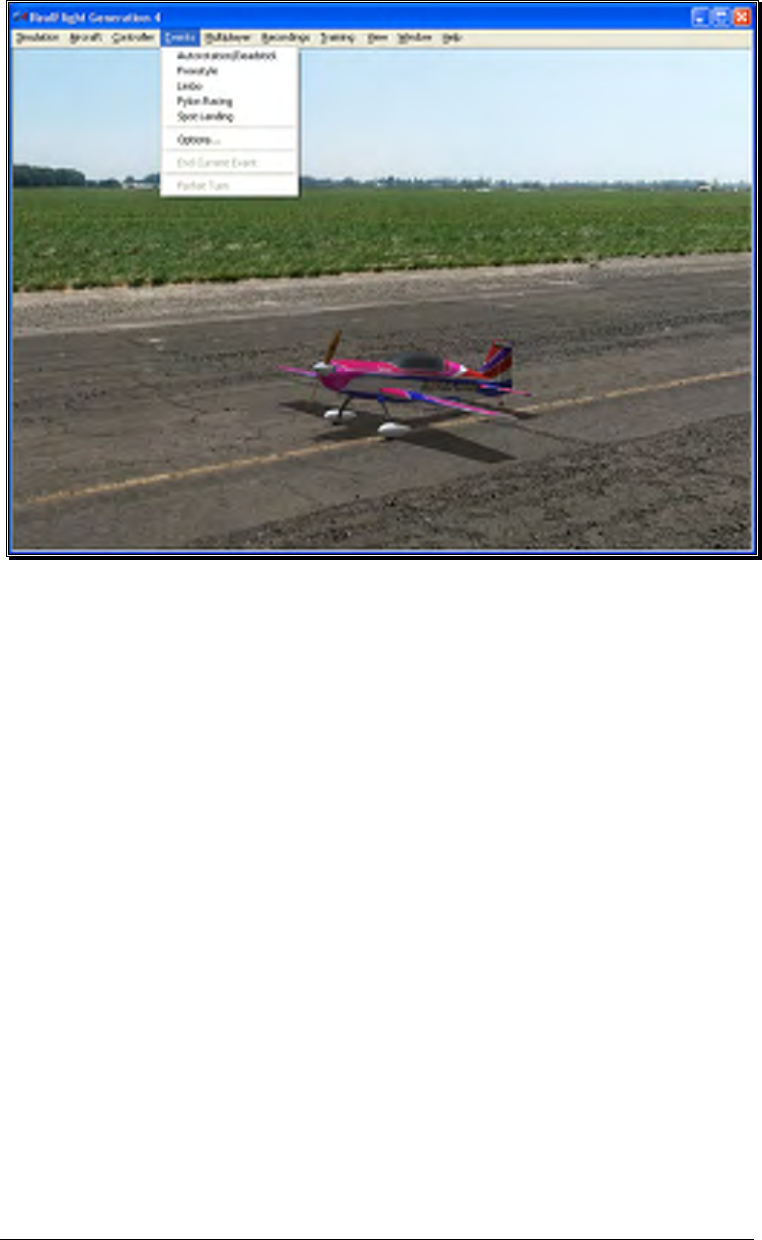
148
• Autorotation/Deadstick
• Freestyle
• Limbo
• Pylon Racing
• Spot Landing
• Options…
• End Current Event
• Forfeit Turn
Some of these items may be grayed out if they do not apply to the current situation.
For example, you cannot end the current event unless an event is already running.
Consequently, the End Current Event menu item will be grayed out.
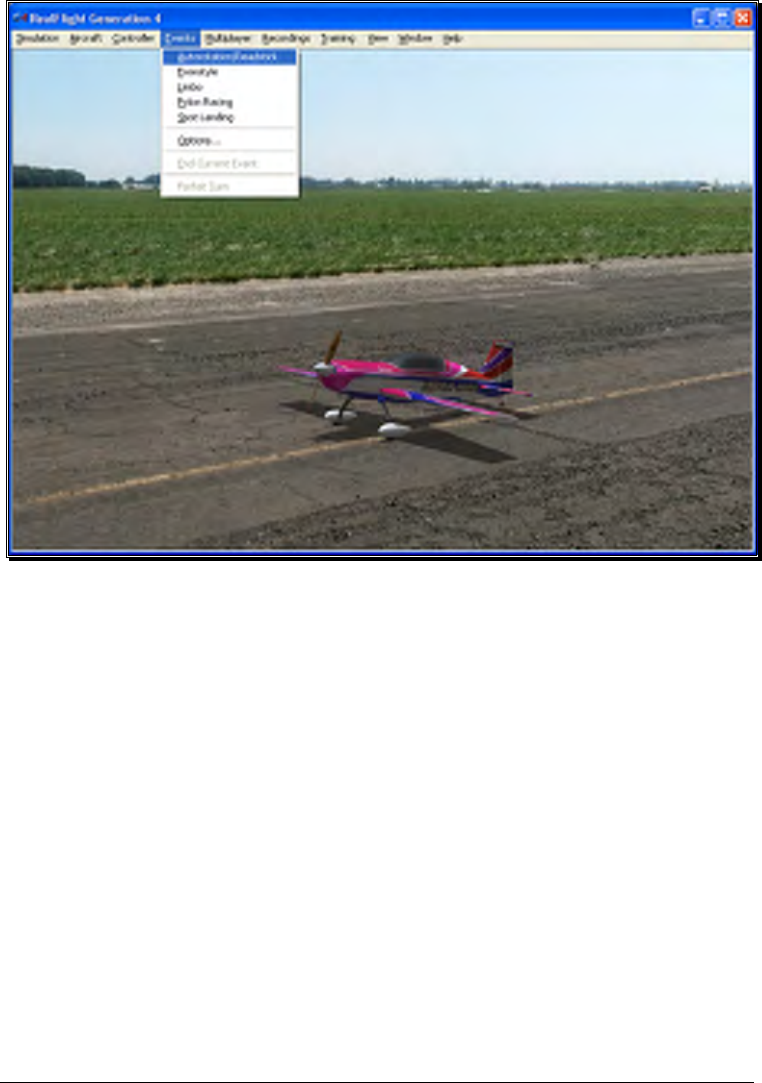
149
Autorotation/Deadstick
The Autorotation/Deadstick event is similar to the Spot Landing event mentioned
below. This event requires that you make a landing with all power off.
The goal of this event is to land the airplane, or autorotate the helicopter, into the
marked zones. The various landing zones have different point values assigned to them.
Generally, the zones that are more difficult to target are awarded higher point values.
If participating in a multiplayer event, the player with the highest points total at the end
wins.
It is possible to enable the software to “kill” the player’s engine when their aircraft
passes a particular altitude.
Selecting Your Name for the Event-
If you have already entered a name in the Settings… menu item, this name will be
utilized for single player and multiplayer events. If you have not entered a name, please
do so in the space provided when you select an event. Click OK when completed.
To select a different name for this event, click on the Simulation menu, followed by
the Settings… menu item. Next, click the Multiplayer name. This brings up the
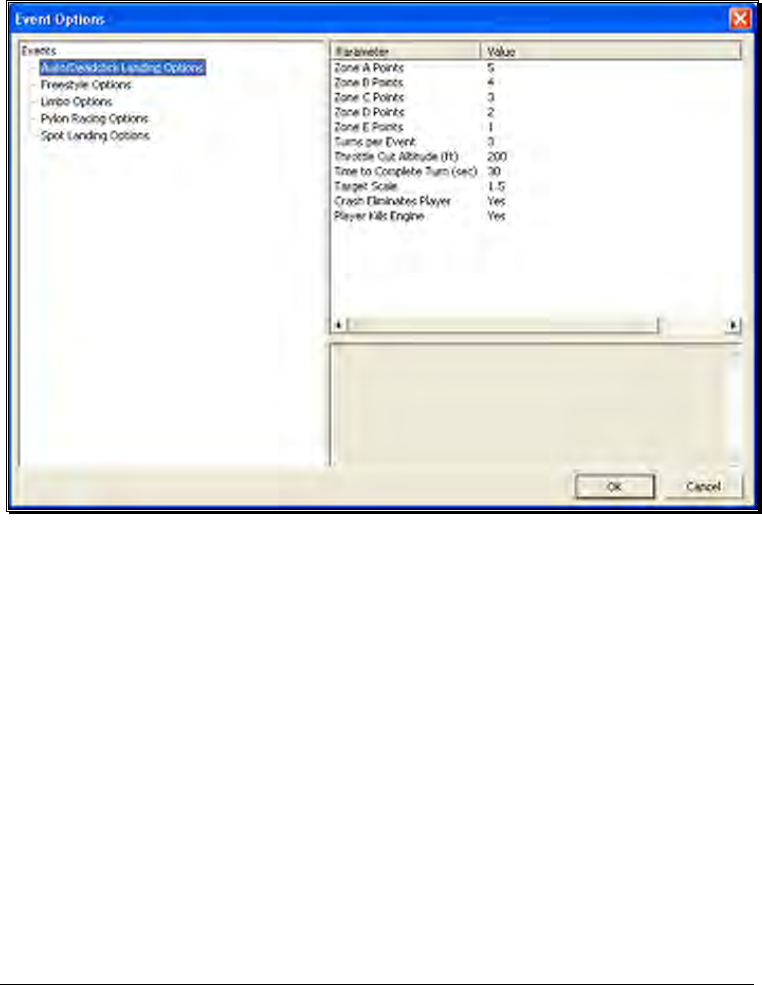
150
multiplayer options. Click the value found next to the Pilot Name item. Use the
keyboard to input the name you wish to utilize for the events.
Options-
The Options… menu item adjusts the parameters and rules for each event. To access
the Options… menu item, click the Events menu followed by the Options… menu
item. Next, from the column on the left side, select the event that you wish to adjust.
The selections that appear will depend upon the event selected. This section examines
the selections available for the Autorotation/Deadstick Landing Options.
Zone Point Values- Zones A through E-
The landing zones are divided into five segments. In the default settings, each
segment has a different point value assigned to it based upon degree of
difficulty. Zone A is the smallest, most difficult target. Therefore, it offers the
highest point value. Zone B, which surrounds the center, offers the second
highest points, followed by Zone C, D and E.
To adjust the values of these points, click on the values in the column to the
right of the respective Zone Points. For example, to adjust the points for
Zone A, click on the corresponding Value in the column next to Zone A.
Enter the desired value directly from the keyboard or via the mouse wheel.
Turns Per Event-
This option determines the number of turns that each player is allotted per
event. When each player has taken the designated number of turns, the event

151
is over. The only exception is if the host activates the Crash Eliminates Player
setting. In this case, the event will end if all of the players crash before they
reach the turn limit.
To adjust the number of turns, click on the corresponding value. Enter the
desired value directly from the keyboard or via the mouse wheel.
Throttle cut altitude-
As mentioned previously, in an Autorotation/Deadstick event, the host can set
the rules so that the throttle is cut manually or automatically. This section
refers to the settings for a manual throttle cut. For information on automatic
throttle cuts, please see the Player Kills Engine section below.
To adjust the altitude at which the throttle is cut, click on the corresponding
value. Enter the desired altitude value directly from the keyboard or via the
mouse wheel.
Time to Complete Turn (sec)-
This is the amount of time allotted for each player to complete his or her turn.
Note: the countdown or timer is initiated at takeoff.
To adjust the amount of time to complete the Event, click on the
corresponding value. Enter the desired value directly from the keyboard or via
the mouse wheel.
Target Scale-
This option determines the size of the landing targets.
To modify the size of the landing area, enter a number in the corresponding
value column. Enter the desired value directly from the keyboard or via the
mouse wheel. The size of the targets will scale proportionally.
Crash Eliminates Player-
This option determines whether a crash eliminates a player from the
competition. If No, the player will be able to continue his/her turn regardless
of whether or not they have crashed. If Yes, the event is over for them as
soon as a crash occurs.
To set Crash Eliminates Player option, click the value in the corresponding
column. From the pull-down list, select either Yes or No.
Player Kills Engine-
This option determines whether you want to cut off the engine manually or
allow RealFlight G4 to do so for you. If enabled, the player must manually kill
the engine above the Throttle Cut Altitude. RealFlight will display the engine
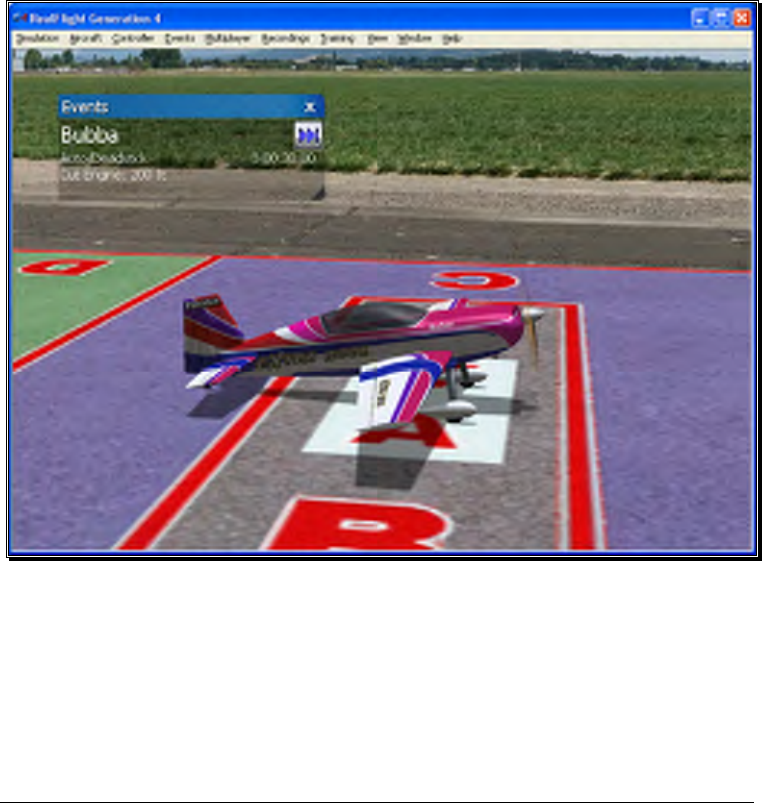
152
cut notification for you on-screen. With automatic throttle cutting, RealFlight
G4 will automatically cut the throttle as soon as the aircraft crosses the
minimum altitude threshold. Again, RealFlight will display the engine cut
notification for you on-screen.
To set Player Kills Engine option, click the value in the corresponding column.
From the drop-down list, select either Yes (manual cut required) or No
(automatic cut at altitude).
Autorotation/Deadstick Instructions
You can run an autorotation competition in either a single player or multiplayer
environment.
The person who starts the event decides upon the applicable rules and parameters. For
example, you can set:
• The time allotment for each player’s turn.
• How many turns each player receives.

153
• Whether a player’s engine is automatically or manually killed during a turn.
• The altitude at which an engine must be killed.
• The physical dimensions of the landing target.
• Whether or not a crash automatically disqualifies a player.
• Point values of the different zones within the landing target.
RealFlight G4 automatically applies the rules you choose, and keeps track of scores.
During the event, the announcer’s voice will guide you through each phase of the
competition.
Rules
The Autorotation/Deadstick course consists of a target:
The object of the Autorotation/Deadstick event is to fly your model over the target,
kill the engine, then touch down as close as possible to the center of the target. Players
take turns making landing attempts. When your turn comes, you will normally takeoff,
gain altitude until you are above the minimum Throttle Cut Altitude, fly towards the
target, and then kill your engine and autorotate or glide to the ground.
If the host so decides, you must kill your engine before dropping below the minimum
altitude to kill engine. Alternatively, the host can decide that your engine will
automatically shut off when you pass below this altitude. The host must also decide on
the minimum Throttle Cut Altitude.
A “touch down” occurs when any part of your airplane or helicopter touches ground.
Each touch down is marked with an ‘X’ on the spot at which the aircraft landed.
Please note: this is not necessarily the point at which the aircraft stopped moving.
An “attempt” means you have passed below the minimum altitude to kill your engine.
Once your engine is disabled, you cannot reactivate it until your turn expires.
Additionally, you must land successfully (without crashing) to receive any points for
your attempt.
Furthermore, you must complete your landing before your turn time expires. If you do
not touch down in time, you will lose your turn.
The points you receive during a turn are dependent upon where you touch down.
Within the target, each colored zone has a different point value. Normally, the closer
to the center you land, the more points you will receive. Your touch down point is the
point on the ground directly below the center of your aircraft, no matter what part of
your aircraft touches first.

154
The event continues until the players complete all of their turns, all of the players are
disqualified (usually by crashing), or everyone has left the event. The player with the
highest point total at the end of the event is the winner.
Events Viewport Display Box-
During the event, a situational screen will appear on your display. This screen serves
several purposes: it indicates the player’s name, tracks the amount of time remaining to
complete the event, and indicates the remaining altitude before the engine is cut.
If you do not wish to view this information, double-click on the title bar of the display
box. This will hide the information. To view it once again, simply double-click the
title bar again.
To reveal the statistics for the event, click the arrow button in the upper right corner of
the box. Click the arrow button one more time to hide this information.
To resize the viewport, position the cursor over the lower right corner of the
viewport’s frame. Using the mouse, drag the frame according to your wishes. If you
drag it downward, the vertical size of the viewport will increase. Dragging the frame to
the right or left will increase/decrease the width of the viewport respectively.
Clicking on the ‘X’ in the title tab of the viewport will close the viewport.
Freestyle
RealFlight G4’s Freestyle event lets you make the rules. When you start a Freestyle
event, RealFlight G4 will allot every player a set of turns. Each player’s turn ends when
that player’s time expires (or if the player crashes). When this occurs, the next player’s
turn begins. What players do during their respective turns is completely up to the
participants. We’ve included some possible freestyle examples below.
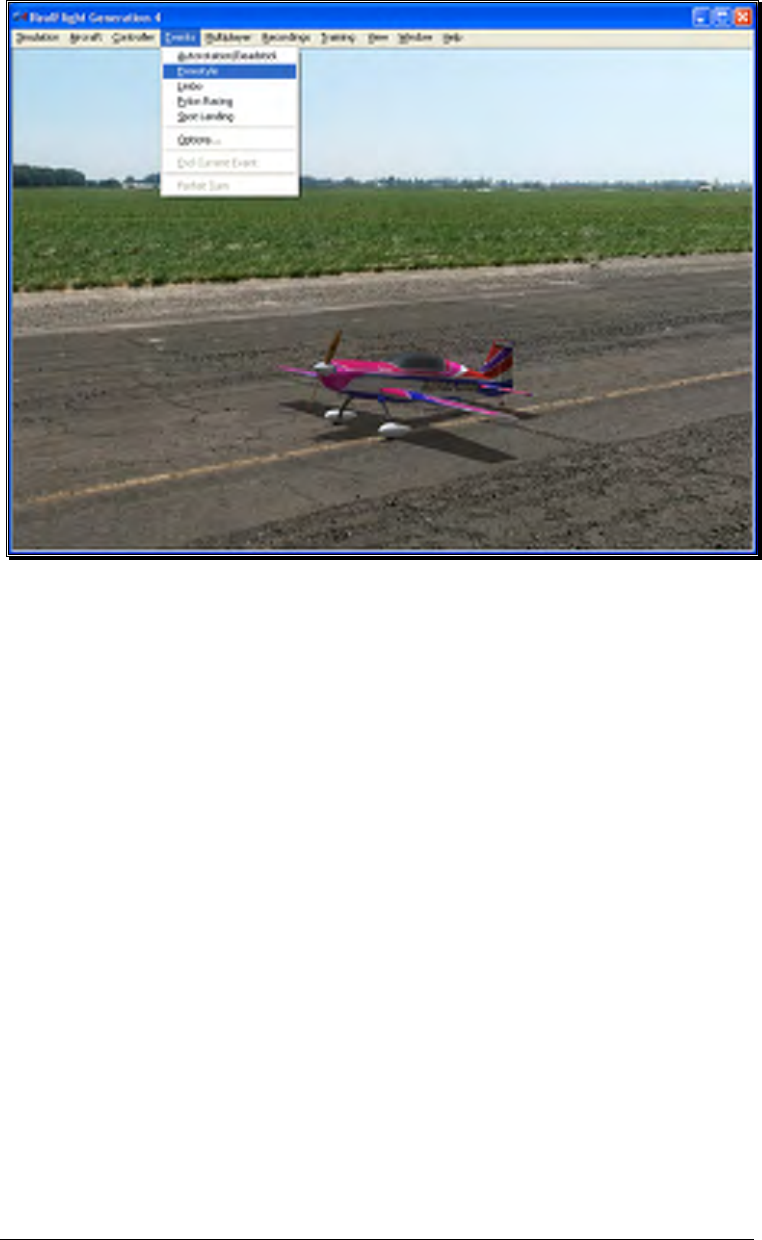
155
Whatever activity you pick, RealFlight will see that each player receives a timed turn.
You can use freestyle with any aircraft (airplanes or helis).
Selecting Your Name For the Event
If you have already entered a name in the Settings… menu item, this name will be
utilized for single player and multiplayer events. If you have not entered a name, please
do so in the space provided when you select an event. Click OK when completed.
To select a different name for this event, click on the Simulation menu, followed by
the Settings… menu item. Next, click the Multiplayer name. This will bring up the
multiplayer options. Click the value found next to the Pilot Name item. Use the
keyboard to input the name you wish to utilize for the events.
Options
As the name suggests, the Options… menu item is used to adjust the parameters and
rules for each of the events. The Autorotation/Deadstick Event section discusses general
notes for this option. This section examines the selections available for the Freestyle
options.
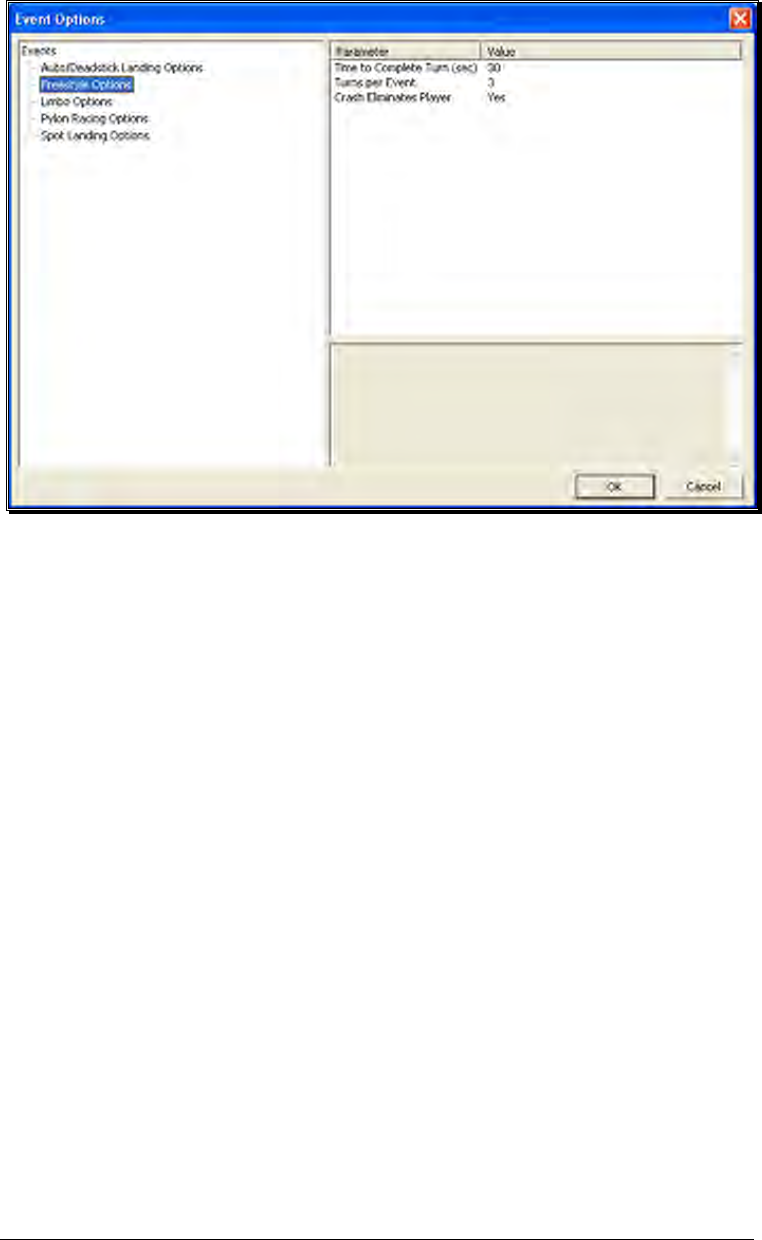
156
Time to Complete Turn (sec)-
This is the amount of time allotted for players to complete their turn.
Please note: the time begins at takeoff.
To adjust the amount of time to complete the event, click on the
corresponding value. Enter the desired value directly from the keyboard or via
the mouse wheel.
Turns Per Event-
This option determines the number of turns that will be allotted to a player for
the event. The event is over when each player has taken this number of turns,
or sooner if the host activates the Crash Eliminates Player option and a crash
occurs.
To adjust the number of turns, click on the corresponding value. Enter the
desired value directly from the keyboard or via the mouse wheel.
Crash Eliminates Player-
This option determines whether a crash eliminates a player from the
competition. If No, the player will be able to continue his/her turn regardless
of whether or not they’ve crashed. If Yes, the event is over for them as soon
as they crash.
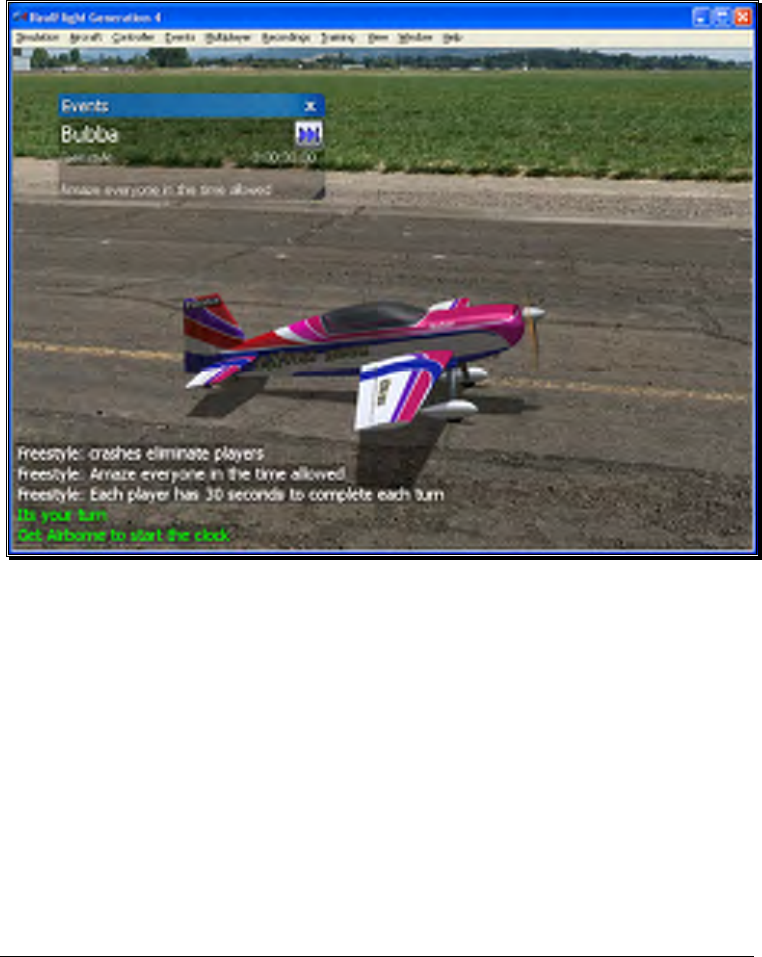
157
To determine whether a crash eliminates a player, click the value in the
corresponding column. From the pull-down list, select either Yes or No.
Freestyle Instructions
You will usually want to use Freestyle in a multiplayer environment, but it works in
single player mode as well.
Before you start this event, you will ordinarily decide what the participants must do.
You may just want to use the event to give everyone an equal chance to showcase his
or her aerobatic skills. This will prevent you from worrying about your scoring. If you
want to have a competition, we suggest that before you begin the event:
• Everyone should agree on the rules.
• The host may need to edit the airport to add any equipment (pylons, runways,
fences, obstacle rings, limbo poles, etc.) that you will need for the event.
• Everyone should agree how the event will be judged. You could appoint one
player to decide on a score for every other player, or have everyone in your session
vote on the best maneuver, etc.

158
The person who starts the Event (multiplayer session host) can pick:
• How much time each player is allotted per turn
• How many turns each player receives, and
• Whether a player who crashes is automatically disqualified
We emphasize, the only limit on the freestyle event is your imagination. A few examples of what
you might wish to do:
• Touch and Go. Appoint one partner to count runway touches, the contestant with
the most touches in a turn wins.
• Aerobatics. Players use their turns to perform any stunt they want. At the end,
everyone votes on the best stunt.
• Obstacle course. Set up a long obstacle (table, etc.) close to the ground and take
turns flying under it; land or takeoff from ramps, circle around pylons, etc.
It does not have to be a contest. You might all just want to take an equal turn at using
the runway (takeoff, land on alternate turns).
Events Viewport Display Box-
During the event, a situational screen will appear on your display. General notes on
this display were discussed in the Autorotation/Deadstick event section.
Limbo
A limbo event is a contest of piloting skill and courage. Players attempt to maneuver
their aircraft under a horizontal bar suspended across two vertical bars. After each
successive pass, the bar is lowered. The event continues until only one pilot remains.
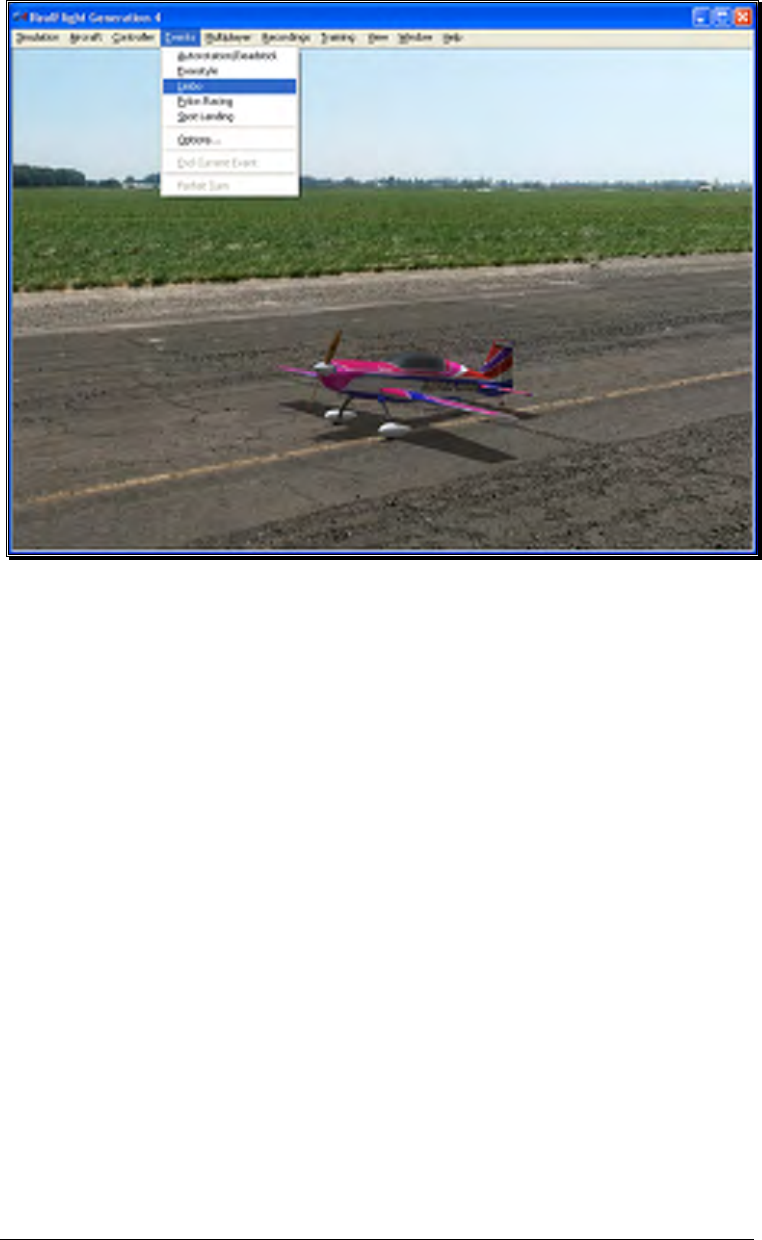
159
Selecting Your Name For the Event-
If you have already entered a name in the Settings… menu item, this name will be
utilized for single player and multiplayer events. If you have not entered a name, please
do so in the space provided when you select an event. Click OK when completed.
To select a different name for this event, click on the Simulation menu, followed by
the Settings… menu item. Next, click the Multiplayer name. This will bring up the
multiplayer options. Click the value found next to the Pilot Name item. Use the
keyboard to input the name you wish to utilize for the events.
Options-
The Options… menu item is used to adjust the parameters and rules for each of the
Events. See the Autorotation/Deadstick section for general notes about this screen. This
section examines the specific selections available for the Limbo options.
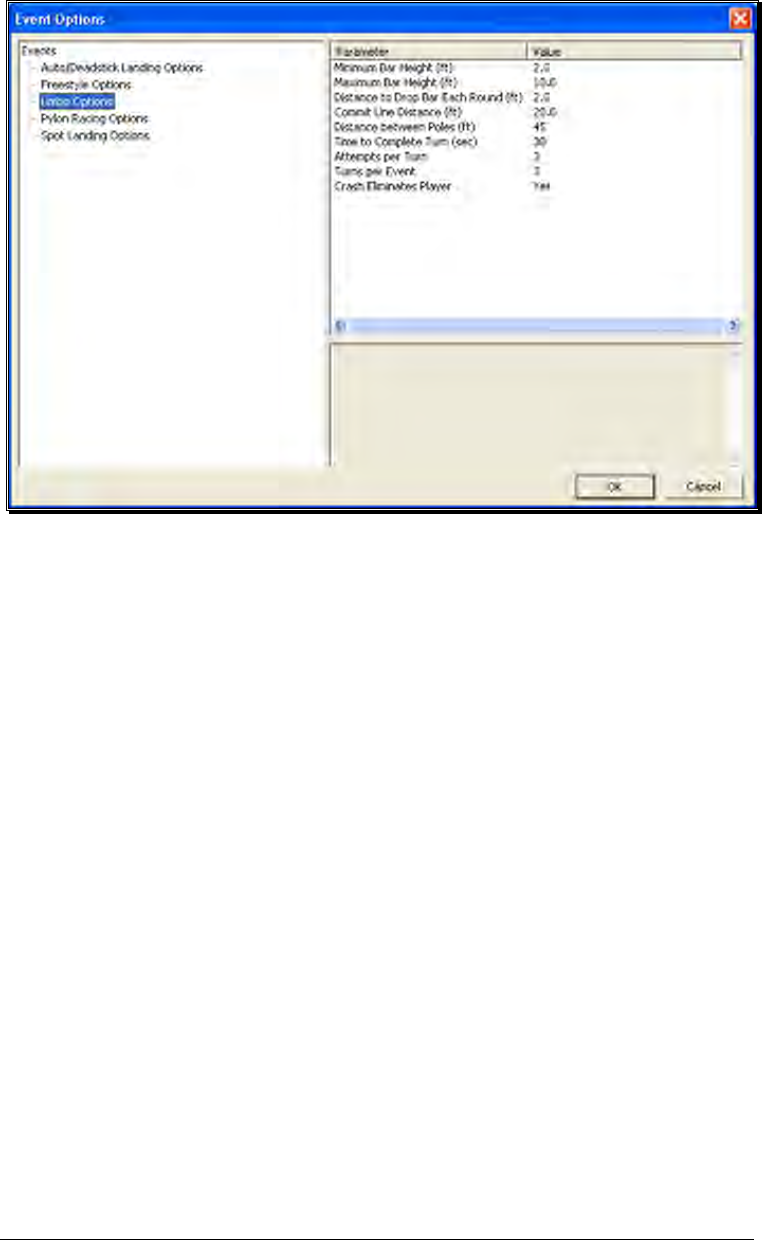
160
Minimum Bar Height-
This setting determines the lowest height that the bar will reach during the
Event.
To adjust the Minimum Bar Height, click on the corresponding value. Enter
the desired value directly from the keyboard or via the mouse wheel.
Maximum Bar Height-
This setting determines the highest setting (starting value) that the bar will
reach during the event.
To adjust the Maximum Bar Height, click on the corresponding value. Enter
the desired value directly from the keyboard or via the mouse wheel.
Distance to Drop Bar each Round-
After a participant successfully passes under the limbo bar, on their next
attempt the bar will lower by the amount indicated in this setting.
To adjust the distance by which the bar will be lowered each round, click on
the corresponding value. Enter the desired value directly from the keyboard or
via the mouse wheel.
Commit Line Distance-
This indicates the distance between the commitment lines and the limbo bar.
There is a commitment line on either side of the limbo bar and participants

161
may approach from either side. These lines detect an attempted pass at the
limbo bar.
To adjust the distance, click on the corresponding value. Enter the desired
value directly from the keyboard or via the mouse wheel.
Distance Between Poles-
The value entered here indicates the distance between the two vertical poles
that support the limbo bar. The wider the space between the poles, the easier
it is to pass through the gate, so to speak.
To adjust the distance, click on the corresponding value. Enter the desired
value directly from the keyboard or via the mouse wheel.
Time to Complete Turn (sec)-
This is the amount of time allotted for each player to complete his or her turn.
Please note: the countdown or timer is initiated at takeoff.
To adjust the amount of time to complete the Event, click on the
corresponding value. Enter the desired value directly from the keyboard or via
the mouse wheel.
Attempts Per Turn-
This value indicates the number of attempts that each pilot is allotted at any
given height of the limbo bar before being eliminated for that turn.
To adjust the number of attempts, click on the corresponding value. Enter the
desired value directly from the keyboard or via the mouse wheel.
Turns Per Event-
This option determines the number of turns per player for this event. When
this number is reached, the event is over. If the host activates the Crash
Eliminates Player option, however, the event may end sooner.
To adjust the number of turns, click on the corresponding value. Enter the
desired value directly from the keyboard or via the mouse wheel.
Crash Eliminates Player-
This option is used to determine whether a crash eliminates the player from
the competition. If No, the player will be able to continue his/her turn
regardless of whether or not they have crashed. If Yes, the event is over for
them as soon as a crash occurs.
To determine whether or not a crash eliminates a player, click the value in the
corresponding column. From the drop-down list, select either Yes or No.
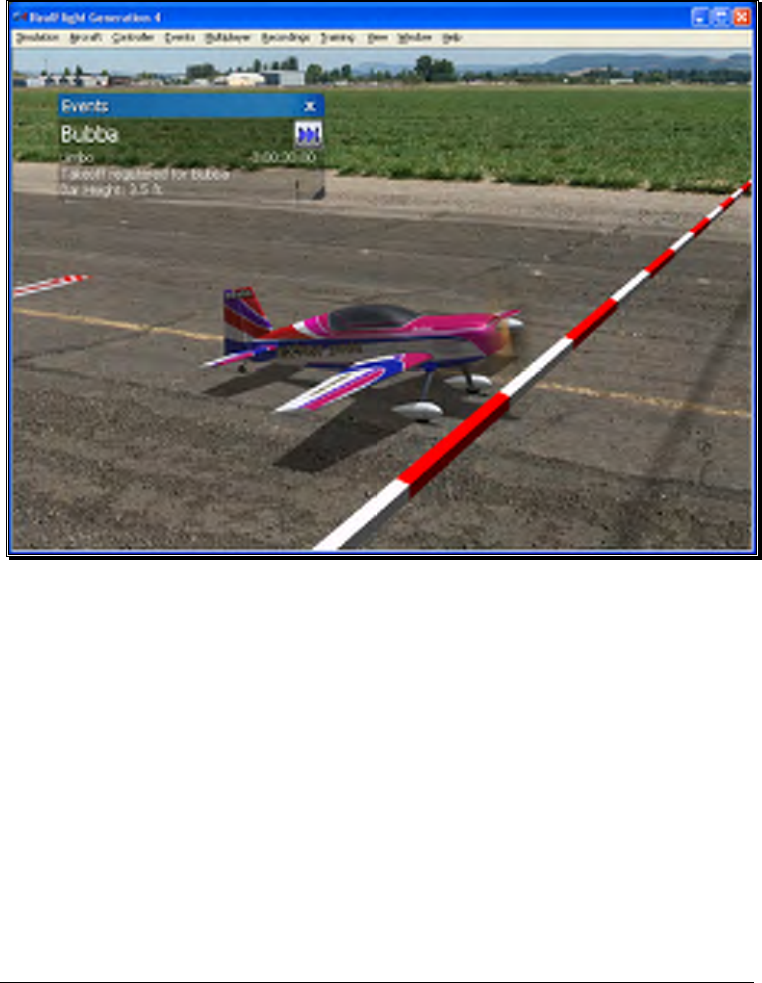
162
Limbo Instructions
A limbo competition can be run in either a single player or multiplayer environment.
The limbo course consists of a limbo pole, and two attempt lines (also called
commitment lines), one on each side of the limbo pole.
The object of limbo is to fly an aircraft past the attempt line, then under the limbo bar,
in the time allowed. Players take turns attempting to fly under the bar. When your
turn comes, you will normally takeoff, circle back towards the limbo pole, then pass
across the attempt line and under the bar, then land. If you successfully fly under the
bar, the bar height will be lowered prior to your next turn.
An “attempt” means you have crossed the attempt line, approaching the limbo bar.
You can make multiple attempts, if necessary, during a turn.
You have anywhere from 10 seconds to five minutes between the moment you first lift
off and the moment you successfully pass under the bar. If you fail to make it under
the bar in time, you lose your turn. (Before the event begins, the host decides the exact
time limit.)

163
You can approach the limbo bar from either direction (i.e., you can cross either
attempt line). For an attempt to count, you must be approaching the limbo bar when
you cross an attempt line. Your aircraft must be airborne when it crosses the attempt
line and when it passes under the bar (i.e., if you taxi, your attempt will not count).
The event continues until each player has made it under the lowest bar height, or has
been disqualified (usually by crashing), or has left the event.
The player with the highest score wins. Your score for each successful turn is:
(time between first liftoff and successful pass) X (height cleared) / 100
Notice that you will achieve or earn the highest score by passing under the bar as soon
as possible after takeoff.
If you did not make it under the bar, your score for that turn is zero.
Events Viewport Display Box-
During the event, a situational screen will appear on your display. This screen serves
several purposes. General notes on the functionality for this window were discussed in
the Autorotation/Deadstick event section.
Pylon Racing
In pylon racing, pilots race their planes around a closed course. Pylon Racing
challenges the pilots’ nerves and skills as they attempt to round the pylons, avoid mid-
air collisions, and finish first, without cutting any pylons.
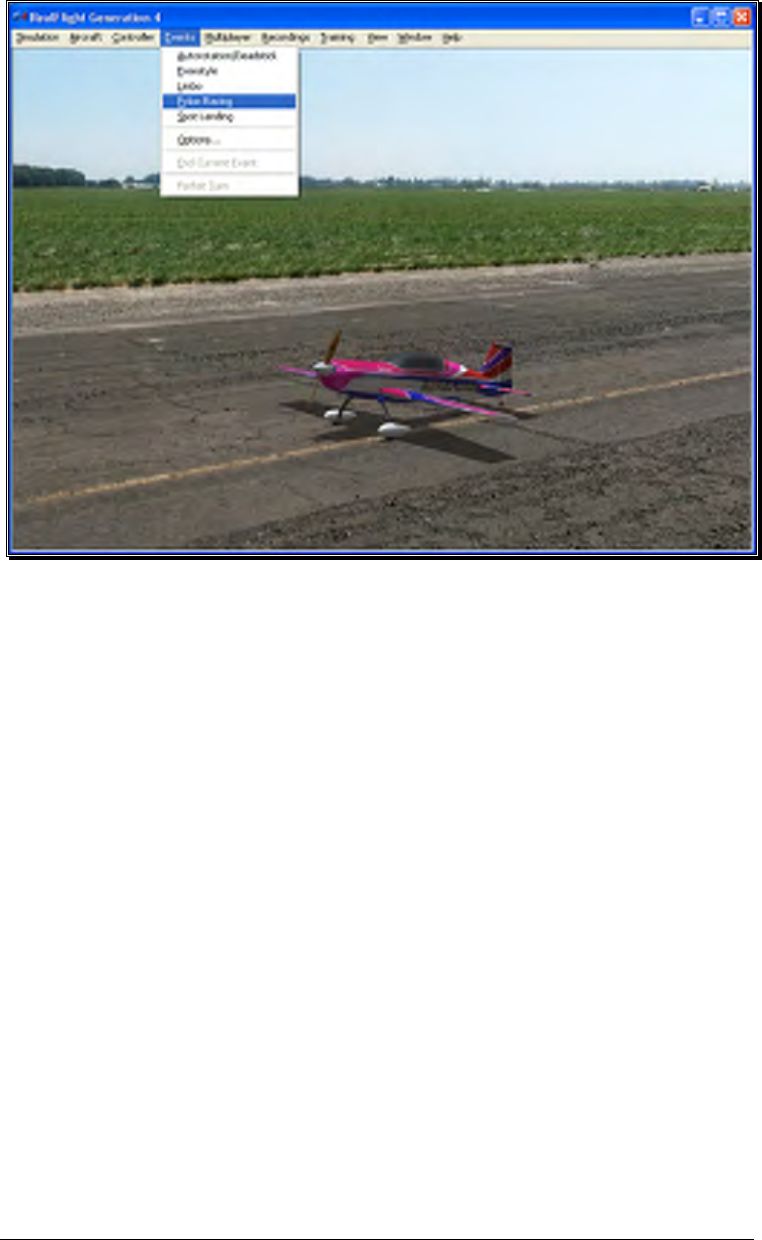
164
Selecting Your Name For the Event-
If you have already entered a name in the Settings… menu item, this name will be
utilized for single player and multiplayer events. If you have not entered a name, please
do so in the space provided when you select an event. Click OK when completed.
To select a different name for this event, click on the Simulation menu, followed by
the Settings… menu item. Next, click the Multiplayer name. This will bring up the
multiplayer options. Click the value found next to the Pilot Name item. Use the
keyboard to input the name you wish to utilize for the events.
Options
As the name suggests, the Options… menu item is used to adjust the parameters and
rules for each of the Events. To access the Options… menu item, click the Events
menu followed by the Options… menu item. Next, from the left hand column, click
on the event for which you wish to adjust the Options…. The selections that appear
will be dependent upon the event selected. This section examines the selections
available for the Pylon Racing Options.
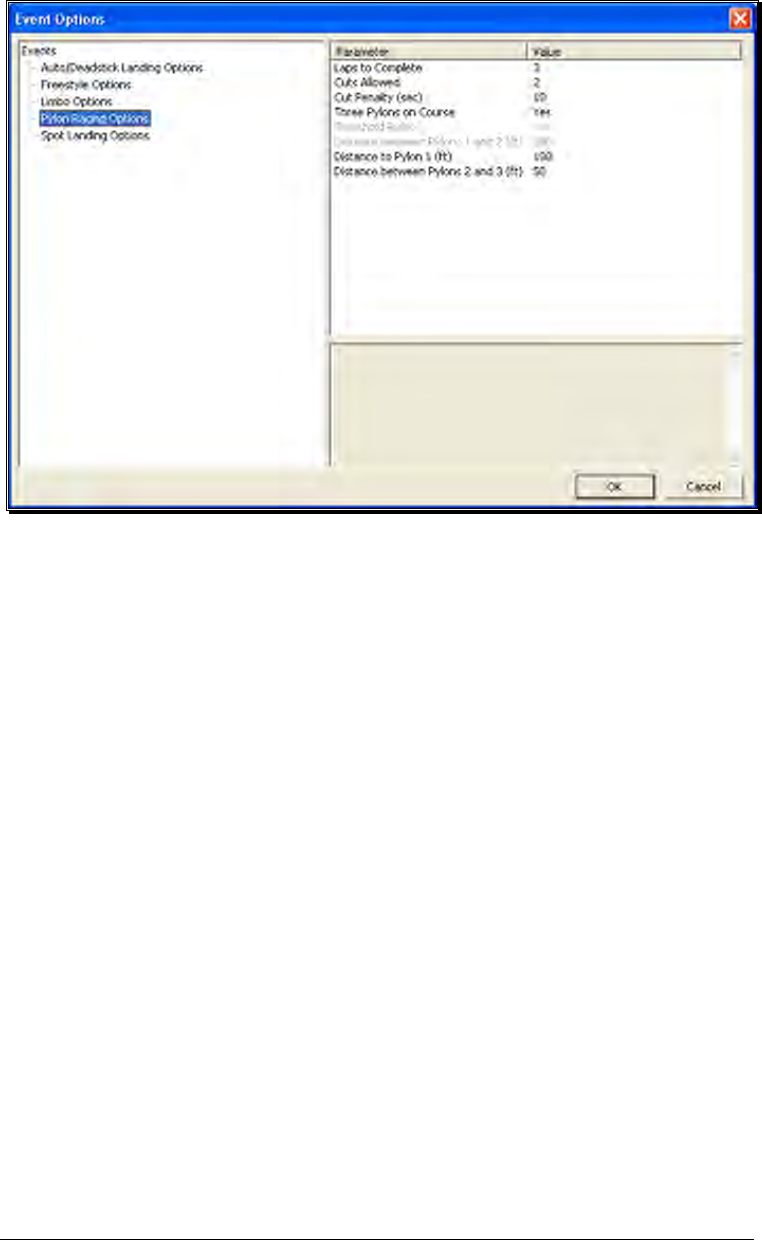
165
Laps to complete-
This value determines the number of laps that each participant must complete
in the event. The person who completes the laps in the shortest amount of
time (after penalties) is the winner.
To adjust the number of laps, click on the corresponding value. Enter the
desired value directly from the keyboard or via the mouse wheel.
Cuts Allowed-
This setting dictates the number of cuts (passes inside a pylon) that a racer is
allowed before being eliminated from the event.
To adjust the number of allowable cuts, click on the corresponding value.
Enter the desired value directly from the keyboard or via the mouse wheel.
Cut Penalty (sec)-
This option determines the time penalty that a player receives for each cut they
make during a race. If the player exceeds the number of allowable cuts, they
are eliminated from the race.
To adjust the penalty seconds per cut, click on the corresponding value. Enter
the desired value directly from the keyboard or via the mouse wheel.

166
Three Pylons on Course-
This setting determines whether the course is a three-pylon course or a two-
pylon course. If Yes is selected, the course is a three-pylon course. If No, the
course is a two-pylon course.
To set this option, click the value in the corresponding column. From the
pull-down list, select either Yes (three pylon course) or No (two pylon course).
Threshold Rules-
In threshold racing, the planes do not actually have to go around the pylon.
Rather, they only have to break the plane of the pylon. This option is only
enabled for two pylon courses. It is grayed out (not applicable) on three pylon
courses.
To determine whether the Threshold Rules will be utilized, click the value in
the corresponding column. From the pull-down list, select either Yes or No.
Distance between pylons 1 and 2-
If you have selected a two-pylon course, this option indicates the distance
between the two pylons. Increasing the value places the pylons farther apart.
To adjust the distance, click on the corresponding value. Enter the desired
value directly from the keyboard or via the mouse wheel.
Distance to pylon 1-
This is the distance from the starting point to pylon number 1. This option is
only applicable to three-pylon courses.
To adjust the distance, click on the corresponding value. Enter the desired
value directly from the keyboard or via the mouse wheel.
Distance between pylons 2 and 3-
If you have selected a three-pylon course, this option indicates the distance
between the pylons two and three. Increasing the value places the pylons
farther apart.
To adjust the distance, click on the corresponding value. Enter the desired
value directly from the keyboard or via the mouse wheel.
Pylon Racing Instructions
You can run a pylon race in either a single player or multiplayer environment.
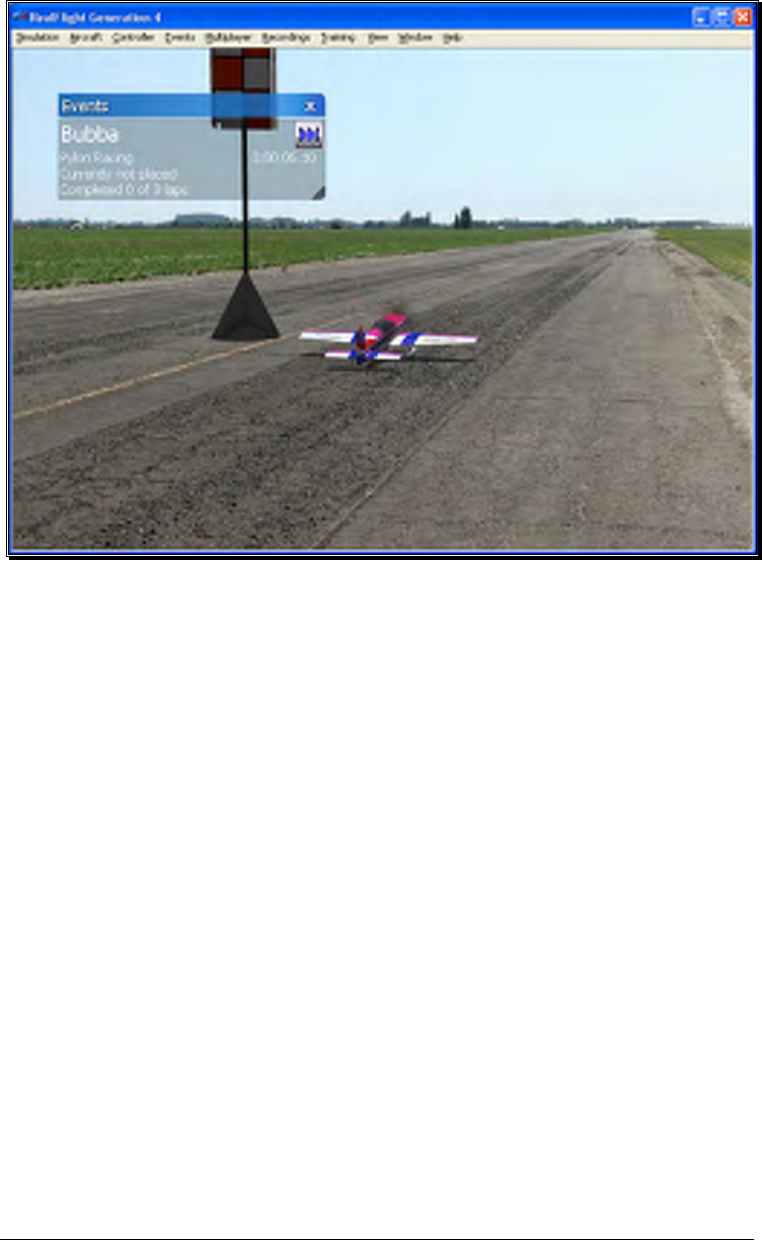
167
The person who starts the event (the host) decides upon the applicable rules and
parameters. For example, the host can set:
• How many pylons mark the course (two or three).
• Regular or threshold-style racing (two-pylon races only).
• The number of laps in the race.
• The distances between pylons.
RealFlight G4 automatically applies the rules you choose, and keeps track of scores.
During the event, an announcer’s voice will guide you through each phase of the
competition.
Pylon Racing Rules-
A pylon-racing course consists of two or three pylons. Here is an example of a three-
pylon course:
For both two-pylon and three-pylon races, the object is to takeoff and circle the pylons
(without “cutting”) in the shortest amount of time. A pylon race usually has two or
more laps. All racers start simultaneously. The race continues until each player is
either finished or disqualified (usually by cutting or crashing).

168
All players start at the same point on the runway. When you hear the horn sound,
takeoff and start the race.
In pylon racing, you always circle the pylons counterclockwise viewed from above—
that is, when you come to a pylon you always turn left. As you approach each pylon,
you will hear a voice telling you when to start your turn. When you have made a
successful turn, you will hear a brief tone.
“Cutting” is illegal. The first time you cut during a race, you are penalized one lap.
The second time you cut, you are disqualified. To avoid being called for a cut, your
entire aircraft must normally go completely around each pylon.
Exception: in a two-pylon style course, you can choose to use threshold-racing rules.
In threshold racing, your aircraft only has to “break the plane” of the pylon to get
credit for a legal turn. This allows pilots to find independent race lines, which may
reduce collisions during a race. Before the race begins, the host chooses whether the
race will follow regular or threshold rules.
The pilot who finishes the required number of laps in the shortest amount of time wins
the race.
Events Viewport Display Box
During the Event, a situational screen will appear on your display. This screen serves
several purposes. General notes on this screen were discussed in the
Autorotation/Deadstick event section.
Spot Landing
In a Spot Landing event, pilots take turns trying to touch their aircraft down within
marked zones. Generally, the zones that are more difficult to target have higher point
values. In a multiplayer event, the player with the highest points total wins.
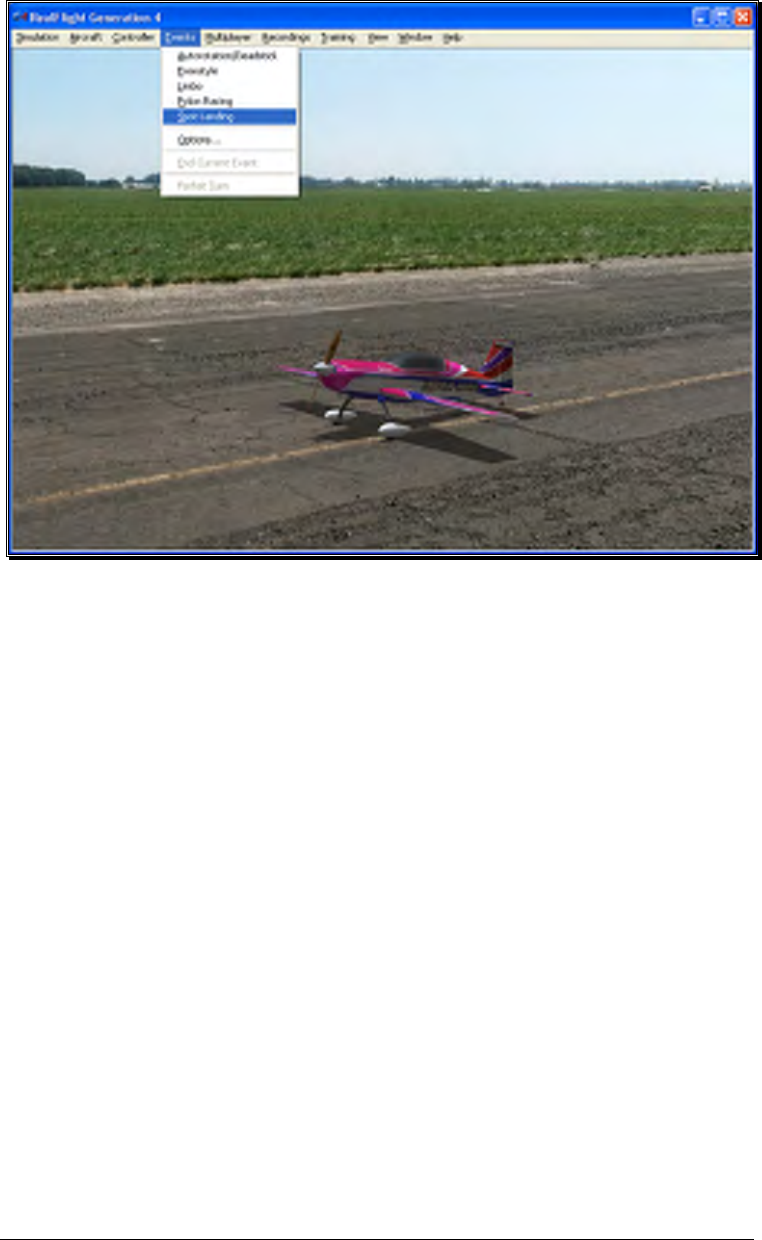
169
Selecting Your Name For the Event-
To select a different name for this event, click on the Simulation menu, followed by
the Settings… menu item. Next, click the Multiplayer name. This will bring up the
multiplayer options. Click the value found next to the Pilot Name item. Use the
keyboard to input the name you wish to utilize for the events.
Options-
As the name suggests, the Options… menu item adjusts the parameters and rules for
each of the Events. To access the Options… menu item, click the Events menu
followed by the Options… menu item. Click on the event, located in the left column
that you wish to adjust. The options that appear are dependent upon the event
selected. This section discusses the selections available for the Spot Landing options.
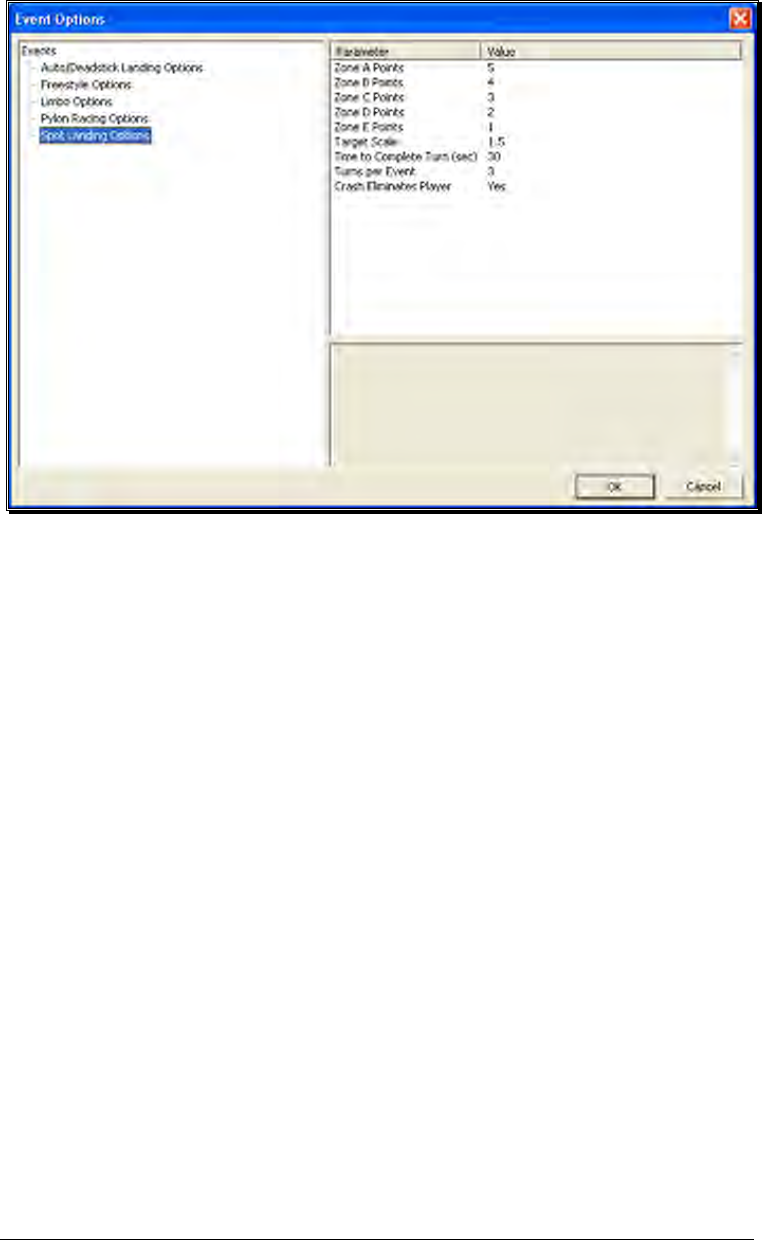
170
Zone Point Values- Zones A through E
The landing zones are divided into five segments. In the default settings, each
segment has a different point value assigned to it based upon degree of
difficulty. Zone A is the most difficult to hit. Therefore, it offers the highest
point value. Zone B, which surrounds the center, offers the second highest
points, followed by Zone C, D and E.
To adjust the point values of the different zones, click on the values in the
column to the right of the respective Zone Points. For example, to adjust the
points for Zone A, click on the corresponding value in the column next to
Zone A. Enter the desired value directly from the keyboard or via the mouse
wheel.
Target Scale-
This option determines the size of the landing targets. To increase the size of
the landing area, enter a larger number in the corresponding value column.
The target size will scale proportionally.
Time to Complete Turn (sec)-
This is the amount of time allotted for players to complete their turn.
Please note: this time begins at takeoff.

171
To adjust the amount of time to complete the event, click on the
corresponding value. Enter the desired value directly from the keyboard or via
the mouse wheel.
Turns Per Event-
This option determines the number of turns allotted to the player for the
Event. The event is over when each player has completed the number of turns
specified. If the Crash Eliminates Players option is enabled, the event can also
end when all of the players have been eliminated due to crashing.
To adjust the number of turns, click on the corresponding value. Enter the
desired value directly from the keyboard or via the mouse wheel.
Crash Eliminates Players-
This option determines whether a crash eliminates a player from the
competition. If No, players will be able to continue their turns regardless of
whether or not they crash. If Yes, the event is over for them as soon as they
crash.
To determine whether a crash eliminates the player, click the value in the
corresponding column. From the pull-down list, select either Yes or No.
Spot Landing Instructions
A spot landing competition can take place in either a single player or multiplayer
environment.
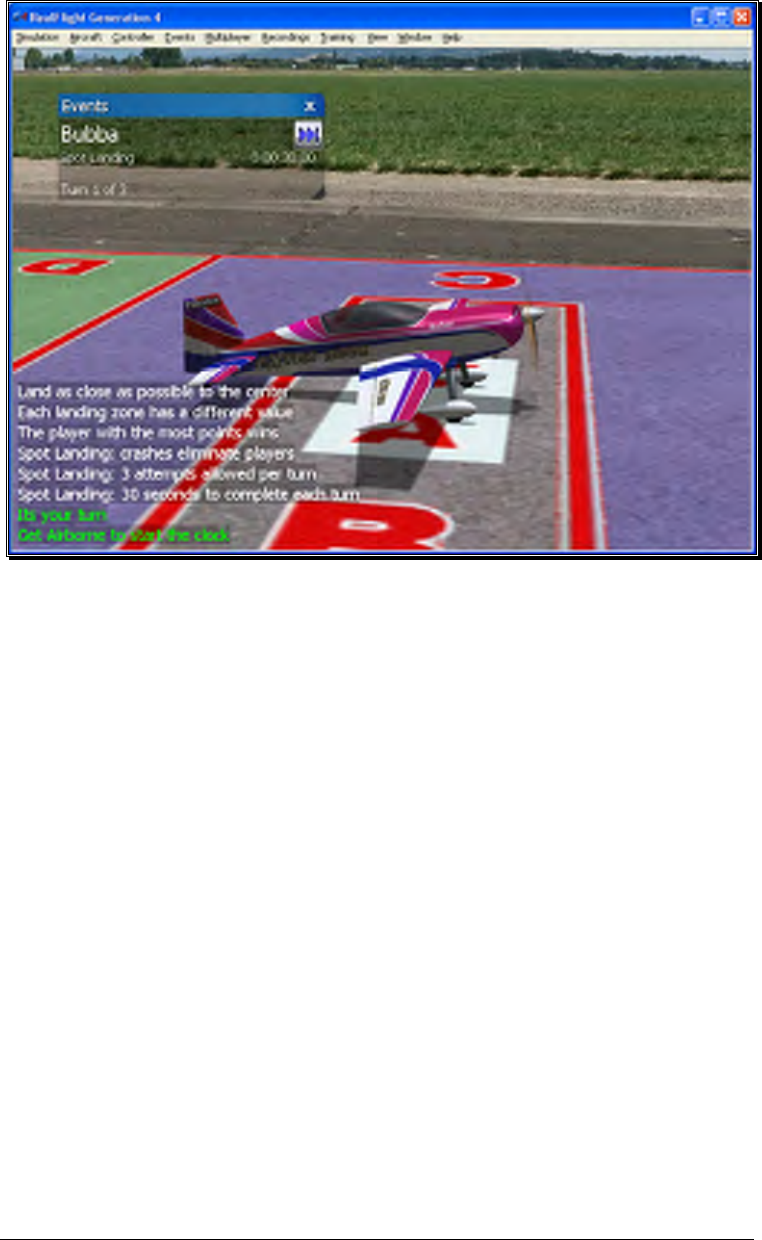
172
The person who starts the event (the host) is responsible for selecting the rules. For
example, you can set:
• How much time each player receives per turn.
• How many turns allowed per player.
• The physical dimensions of the landing target.
• Whether a crash automatically disqualifies the player.
• Point values of the different zones within the landing target.
RealFlight G4 automatically applies the rules you choose, and keeps track of scores.
During the event, the announcer’s voice will guide you through each phase of the
competition.
Rules-
The object is to touch down as close as possible to the center of the target. Players
take turns making landing attempts. When your turn comes, you will normally takeoff,
gain altitude and then fly towards the target on a landing approach.

173
A “touch down” occurs when any part of your airplane or helicopter touches the
ground. A large, visible ‘X’ marks each touch down on the spot where the aircraft
landed.
Please note: this is not necessarily the point at which the aircraft stopped moving.
Furthermore, you must complete your landing before time expires, thus ending your
turn. If you do not touch down in time, you lose your turn.
The points you receive during a turn are dependent upon where you touch down.
Within the target, each colored zone has a different point value. Normally, the closer
to the center you land, the more points you receive. Your touch down point is the
point on the ground directly below the center of your aircraft, no matter what part of
your aircraft touches first.
The event continues until each player has completed all of his or her turns, or has been
disqualified (usually by crashing), or has left the event. The player with the highest
point total is the winner.
You also have a limit on how many landing attempts you can make during your turn.
The host sets this limit at the start of the event.
You can approach the target from either direction (i.e., you can cross either attempt
line). For an attempt to count, you must be approaching the target when you cross an
attempt line. The aircraft must be airborne when it crosses the attempt line (i.e., if you
taxi, the attempt will not count).
You can only touch down once per turn, so if it looks like you may miss the target, pull
up, circle around, and try again.
The event continues until the players have completed all of their turns, all of the players
have been disqualified (usually by crashing), or everyone has left the event.
The player with the highest total score wins.
Events Viewport Display Box-
During the event, a situational screen will appear on your display. The
Autorotation/Deadstick event section provides general notes on this display box.
Options
The Options… menu item allows you to determine the various settings and parameters
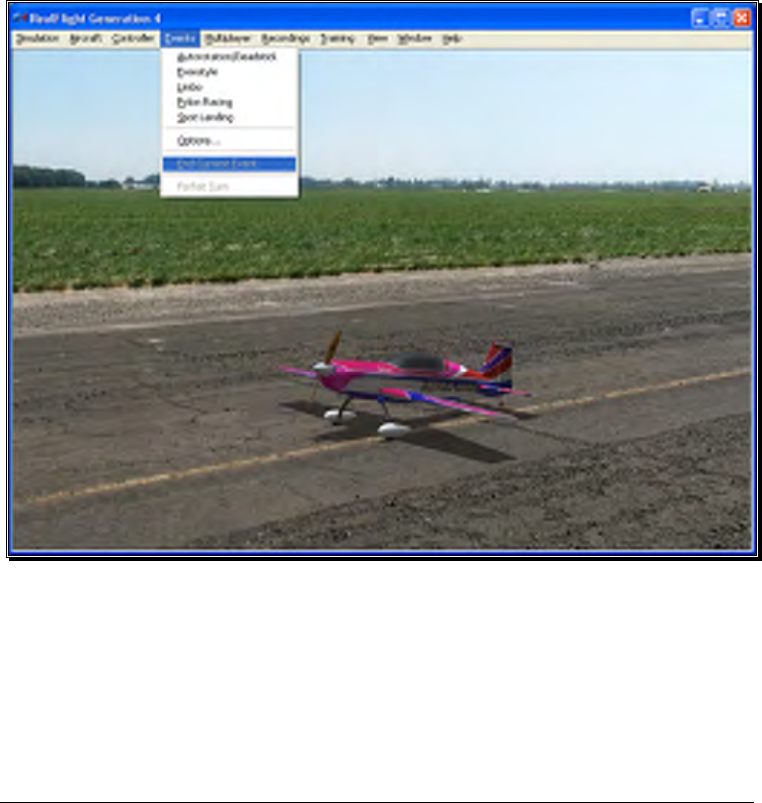
174
for the respective events. The options available to you are dependent upon the Event
selected.
To access the Options… menu item, click on the Events menu followed by the
Options… menu item. Next, select the Event for which you would like to view the
Options…. For further information as to the Options… available for each event, see
the applicable event as discussed previously.
End Current Event
This menu item immediately ends the current event. If there are no events in progress,
this menu item is grayed out. If you are in a multiplayer session and are not the person
hosting this session, the option is also grayed out.
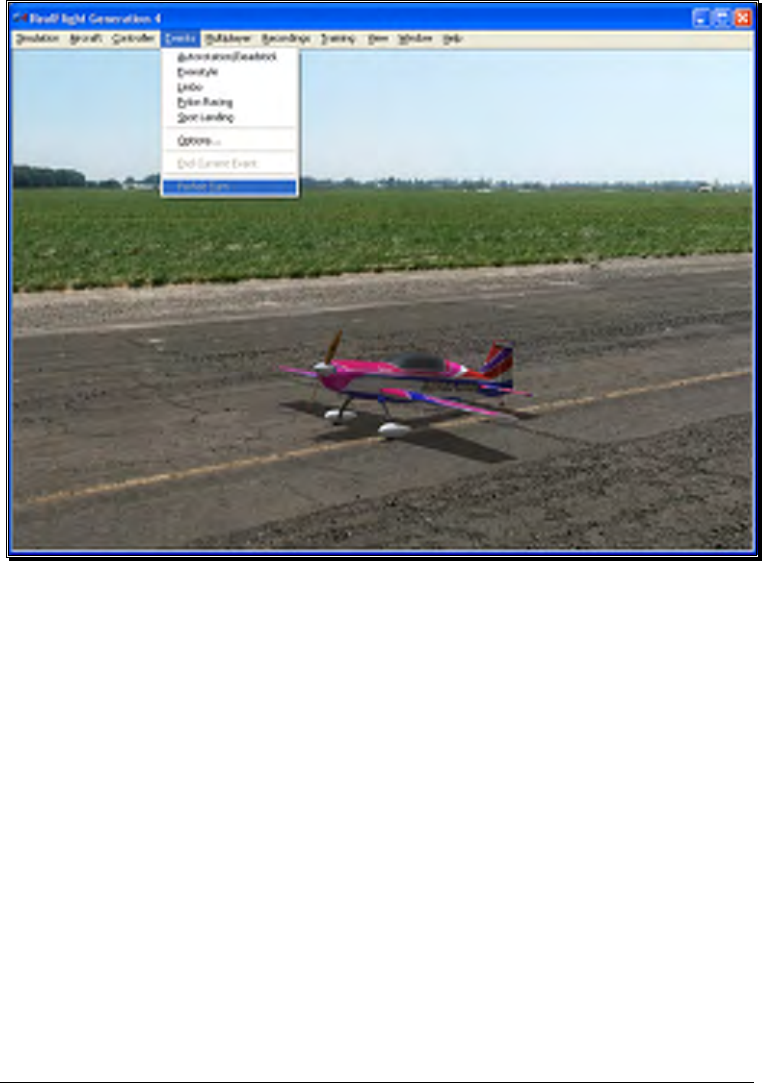
175
Forfeit Turn
This item allows you to forfeit one turn. If you are a multiplayer participant, all other
pilots will take their turns before you can participate again.
This item is grayed out if you are playing an event where players do not take turns (e.g.
Pylon Racing).

177
Multiplayer Menu
Fly with friends, at the same computer, or over the internet.
he Multiplayer option allows you to fly with others. In fact, you are able to
share the skies with up to seven additional pilots. These other pilots can be
across the street, around the block, or around the world!
There are two ways to link up with the additional pilots; via a LAN (Local Area
Network), or over the internet. In order to do so, you will need a TCP/IP connection,
either through your LAN or an ISP (Internet Service Provider).
Every session requires someone to serve as host. The host initiates the multiplayer
session. When the Host starts a session, other participants may join in.
The Multiplayer menu allows you to access a variety of multiplayer-related features,
functions and options. Clicking the Multiplayer menu brings forth a pull-down menu,
which will look similar to the following screen shot:
Chapte
r
9
T
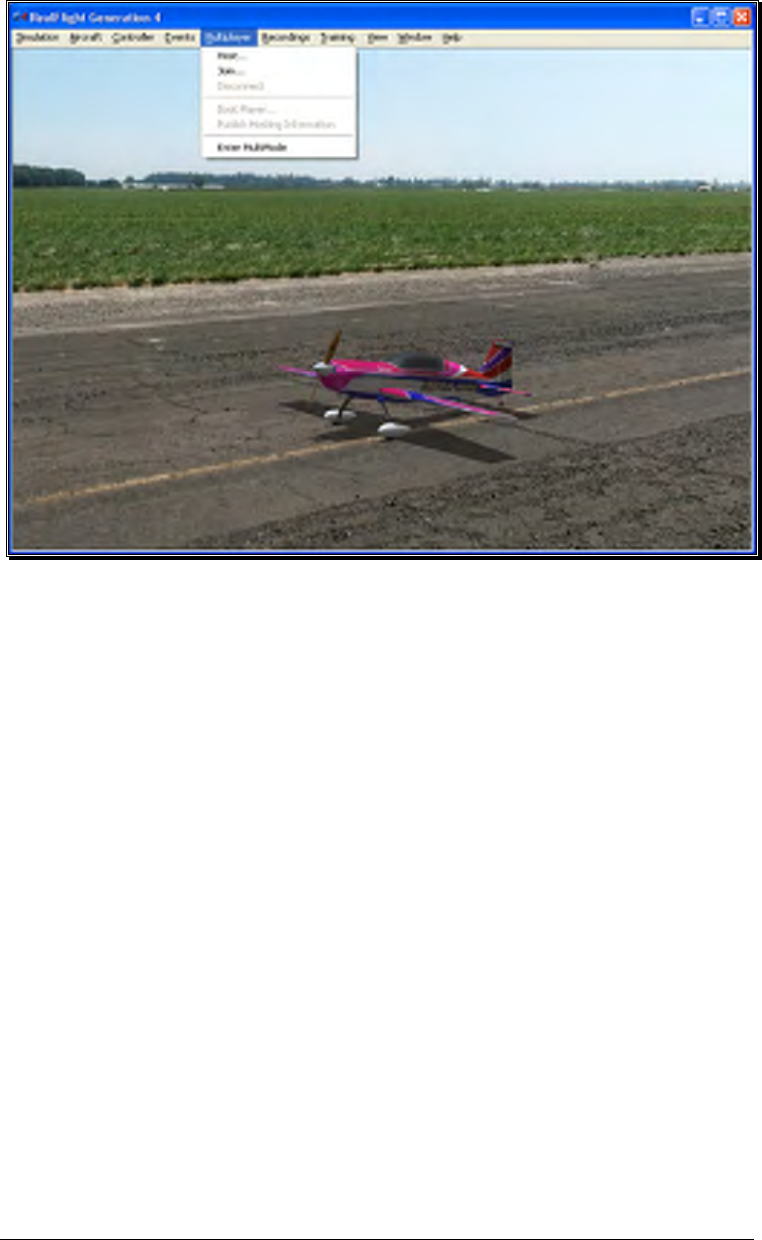
178
• Host…
• Join…
• Disconnect
• Boot Player…
• Publish Hosting Information
• Enter MultiMode
Some of these items will be grayed out if they do not apply to the current situation.
For example, you cannot disconnect unless you are currently connected. As such, the
Disconnect menu item is grayed out unless you are in a multiplayer session.
When you participate in multiplayer sessions, the menu commands you will access
depend on whether you are the host or whether you opt to join someone else’s session.
These commands also depend upon whether you already have a specific session you
want to join.
Depending on what options the participants utilize, it is possible to have a private
session that is only open to players who know the host’s IP address.

179
Please note: a computer’s IP address is its internet “postal code”. It tells other
computers on the internet how to contact that computer. The following sections will
explain more about IP addresses as necessary.
It is also possible to participate in a public session using our list server. The list server
is a publicly available list of open RealFlight G4 sessions. Currently we provide the list
server to all RealFlight G4 owners, free of charge. The list server allows you to
participate in multiplayer sessions with other RealFlight G4 users anywhere in the
world.
IMPORTANT INFORMATION ABOUT THE LIST SERVER
: At the time
of this writing we are providing the list server service on a trial basis. This
service may be modified, interrupted or cancelled at any time without notice.
In particular, we make no guarantee about the reliability of this service. To use
this service you must register your product and may need to obtain product
updates. Inclusion of this manual on your RealFlight CD-ROM does not imply
that this service will be available at the time you purchase this product.
Moreover, we reserve the right to bar any individual user, or all users at
individual IP addresses or domains, from using the list server at our discretion.
Abusive behavior, for example, will not be tolerated.
Chatting
During Multiplayer sessions, you may want to chat with other participants. Doing so is
as simple as typing a message much like popular instant messenger programs.
To send a chat message, press the Enter key to bring up the Chat field at the bottom
of the screen. Next, using the keyboard, type the message you wish to send. Press the
Enter key again on the keyboard to send the message.
Please note: all messages are viewable by all participants. RealFlight G4 does not offer
private chat.
Any messages received from other participants will appear at the bottom of the screen.
Host
Every multiplayer session requires one participant to function as the host. If you are
the host, you will be the one who starts the session. When you leave the session one of
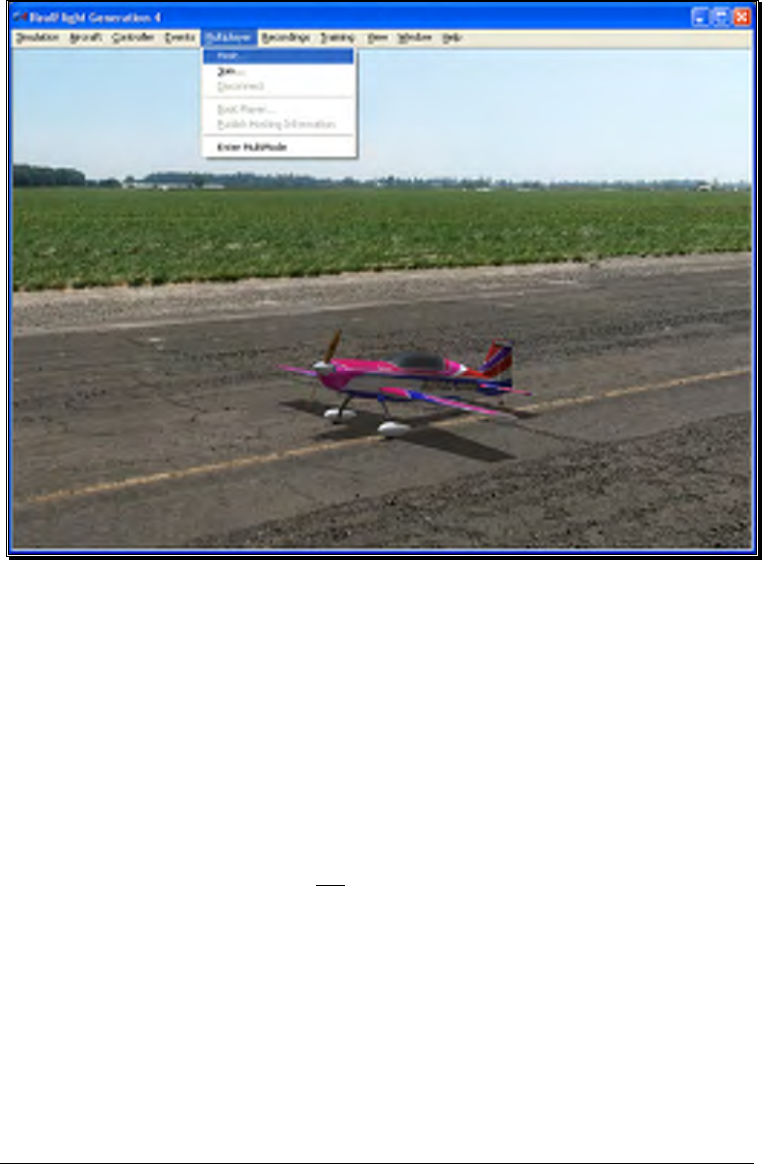
180
the remaining participants automatically assumes the role of Host. The host is also the
one who starts and ends the events (Limbo, Pylon Racing, etc.).
Once you have started the session, other players may join in as they wish.
If you opt to broadcast the session to the list server, the session is known as a public
session. The session will be open to all G4 owners searching for multiplayer events.
If you wish to keep the session private, only those participants to whom you have
provided your IP address will be able to join.
The procedures for starting public and private sessions are very similar. In order to
join your session, the participants will usually need to know the IP (Internet Protocol)
address of your computer. The exception is if you are holding the session over a LAN,
in which case the other players do not need to know your IP address. For a public
session, your partners can retrieve your IP from the list server. For a private session,
you must provide the IP address directly to the desired participants. When the session
starts, RealFlight G4 will display your IP in the lower left corner of the main display.
To access the Host… menu item, click on the Multiplayer menu followed by the
Host… menu item.
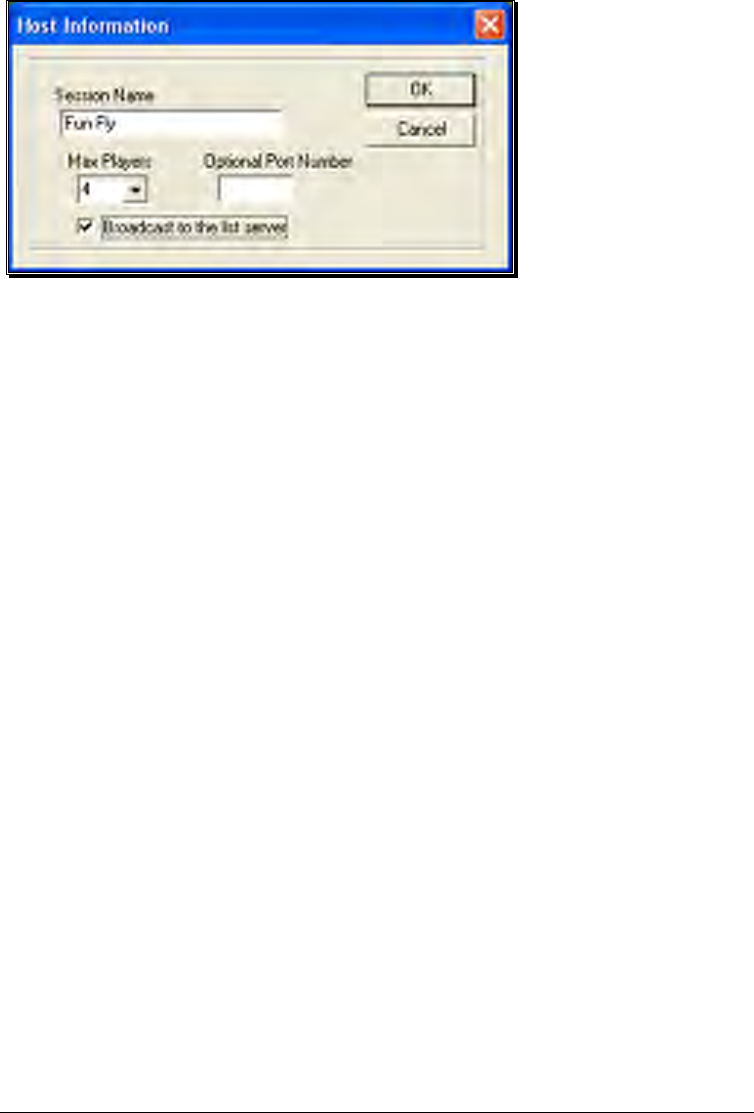
181
Host Information-
The Host Information allows you the ability to name your multiplayer session. You
can also choose the maximum number of pilots and whether or not you wish to make
your multiplayer session public or private.
Session Name-
Using the keyboard, enter the name of the session that you will be hosting.
Please note: this is the name of your session, not necessarily your personal
name. In fact, you might find it useful to use a descriptive name such as “3D
Fun Fly.” This is particularly useful when other participants are searching for a
likely session to join.
Max Players-
To adjust the maximum number of players allowed in your session, click the
down arrow. Enter the number directly from your keyboard or use the mouse
wheel.
Currently, a multiplayer session may not have more than eight members. If the
host computer is somewhat slow or has a poor internet connection, you may
want to limit the number of participants.
Optional Port Number-
For users that are behind firewalls, you may want to use a port other than the
default port (which is 2302). Most users should leave this field blank.
Broadcast to the List Server-
Clicking this option allows your session to be posted on the list server. This
allows other RealFlight G4 users to join your session. This is a good option if
you are looking for new (or additional) partners to fly with. If you check this
box, you will be prompted for session information (see next section).
If you leave this box unchecked, your session will not be posted on our list
server and you will have a private session. You will have to directly provide
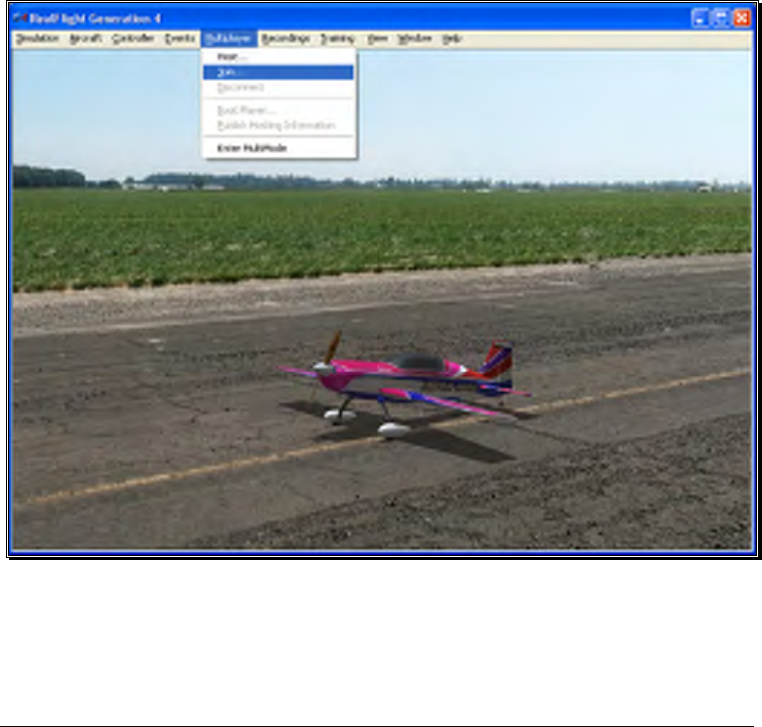
182
your IP address to your multiplayer partners (through phone, email, chat room,
or whatever means you wish). This is a good option if you want to limit your
session to a private group of friends.
If you do not want to broadcast your session information now, you can do so
after the start of the session (see section pertaining to Publish Hosting
Information on page 186).
Finally, please remember that at the time of this writing, we are providing the
list server on a trial basis only. This service may be modified, interrupted or
discontinued at any time without notice.
Join
This option allows you to participate in a Multiplayer session without being the Host of
the session yourself.
To access the Join… menu item, click on the Multiplayer menu followed by the
Join… menu item.
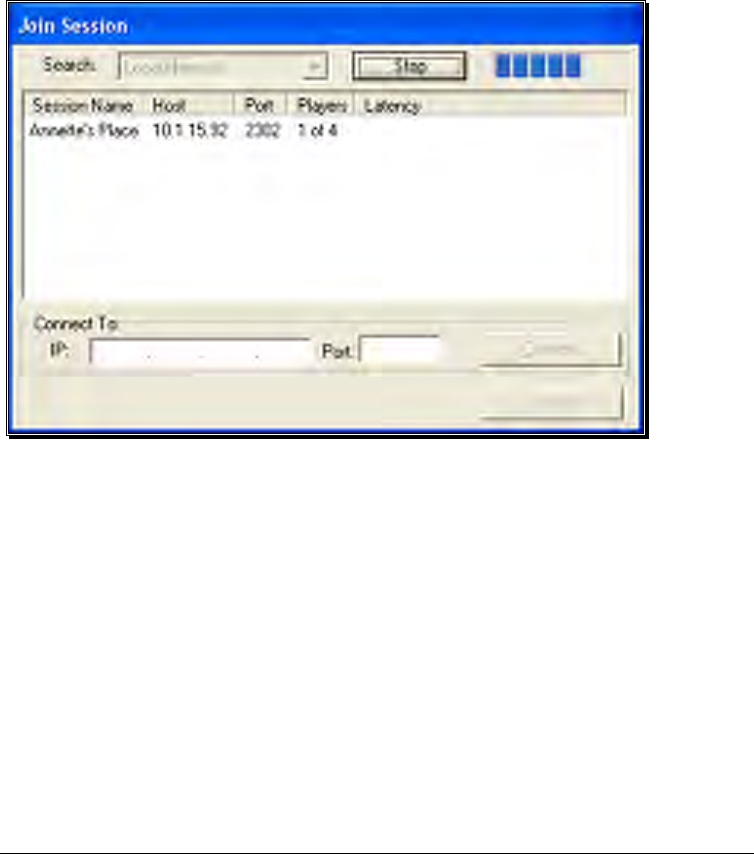
183
Before you can join a session, you will need two things:
• A network connection and
• The IP address of the session Host (unless the session is taking place over a LAN
[Local Area Network]).
You can get the IP address directly from the Host (in the case of a private session), or
from our list server (in the case of a public session).
Join Session-
This dialog allows you to select the multiplayer session that you wish to join. It also
provides you with a variety of information pertaining to the various sessions available
to you.
Search Function-
The Search function checks two distinct areas for multiplayer sessions.
RealFlight G4 (at your discretion) will search the list server and the Local
Network for multiplayer sessions.
To determine the Search area, click the down arrow next to the Start button.
This activates the pull-down selections. Click on the location that you wish to
search.
After making your selection, click the Start button to begin the search. When
the search completes, the respective sessions and information appear in the
dialog above. To select one of these sessions, click on the respective session

184
and then click OK. Alternatively, you may double-click on the Session Name
to join.
Note: if you are using an updated version of Windows XP (Service Pack 2 or
later), you may have Windows Firewall installed and running. If this is the case,
Windows Firewall will pop up a warning dialog (similar to that shown below)
the first time you use the Search function. You must select the Unblock
option in order to allow RealFlight G4 to continue searching.
Session Name-
The Session Name column displays the name of all available sessions. If you
have not searched (and found) a session, or entered an IP address, the Session
Name will remain blank.
Host-
This column shows the IP address of the host computer. If you have accessed
the address via the Search function, this information is automatically filled in
for you when you select the session. If you participate in a multiplayer session
via a LAN, you do not need to fill in the IP address. If you participate in a
private session, fill in the IP address here. When completed, click OK to
proceed.
Port-
This information is important if you are attempting to participate in a
multiplayer session and the computer is located behind a firewall or NAT. The
Port Number will route your computer’s data through the firewall. It is
imperative that this port number matches the port number of the host.
Players-
This column shows the users how many players are participating in a given
multiplayer session. The host determines the number of allowable participants.
Latency-
Latency is the amount of time it takes a packet of information to travel from its
source to the destination. The larger the number, the slower the information
travels. High latency can result in sluggishness and “lag” while running the
simulation. As such, you will want to avoid sessions where the latency number
is high.
Disconnect…
This menu item is used to disconnect from, or exit, the multiplayer session.
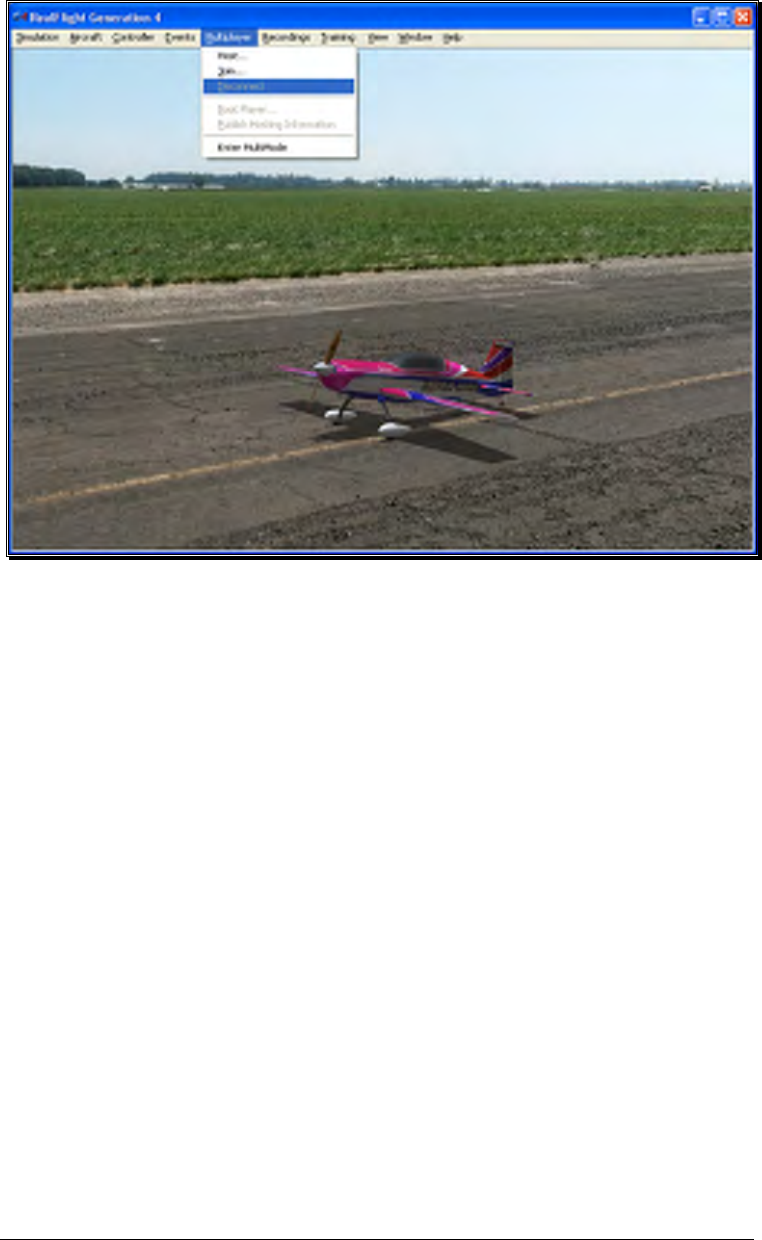
185
To access the Disconnect… menu item, click on the Multiplayer menu followed by
the Disconnect… menu item.
Please note: if you are not currently participating in a multiplayer session, this item will
be grayed out and will not be accessible.
Boot Player…
This menu item is used to drop a participant from a multiplayer session. It is only
available if you are the Host of the session. Otherwise, this item is grayed out and
inaccessible.
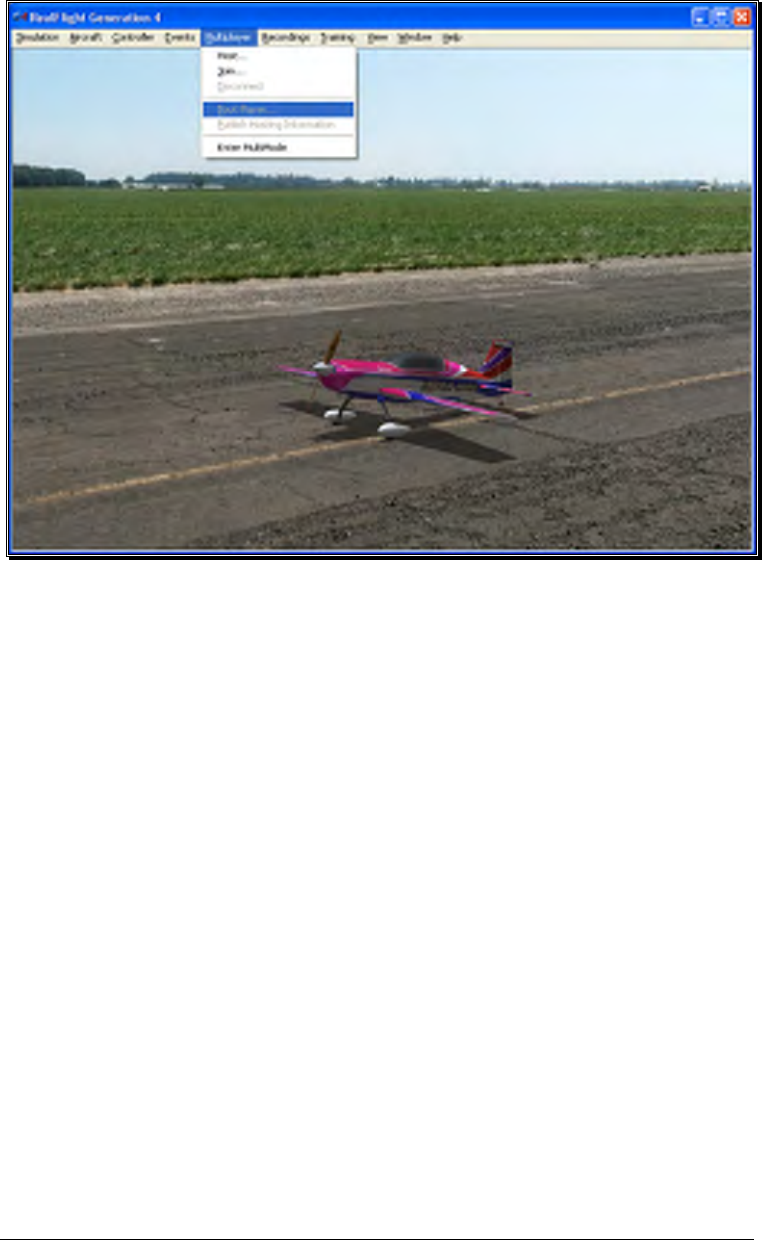
186
To access the Boot Player… menu item, click on the Multiplayer menu followed by
the Boot Player… menu item.
The booted player will receive an on-screen message advising him/her that the host
has booted (removed) them from the session.
Publish Hosting Information
You can make your session public (placed on the list server) when you first start the
session. Alternatively, you can do this while the session is in progress by selecting this
menu item. When you click OK, RealFlight G4 publishes your session information to
the list server, where everyone can see it.
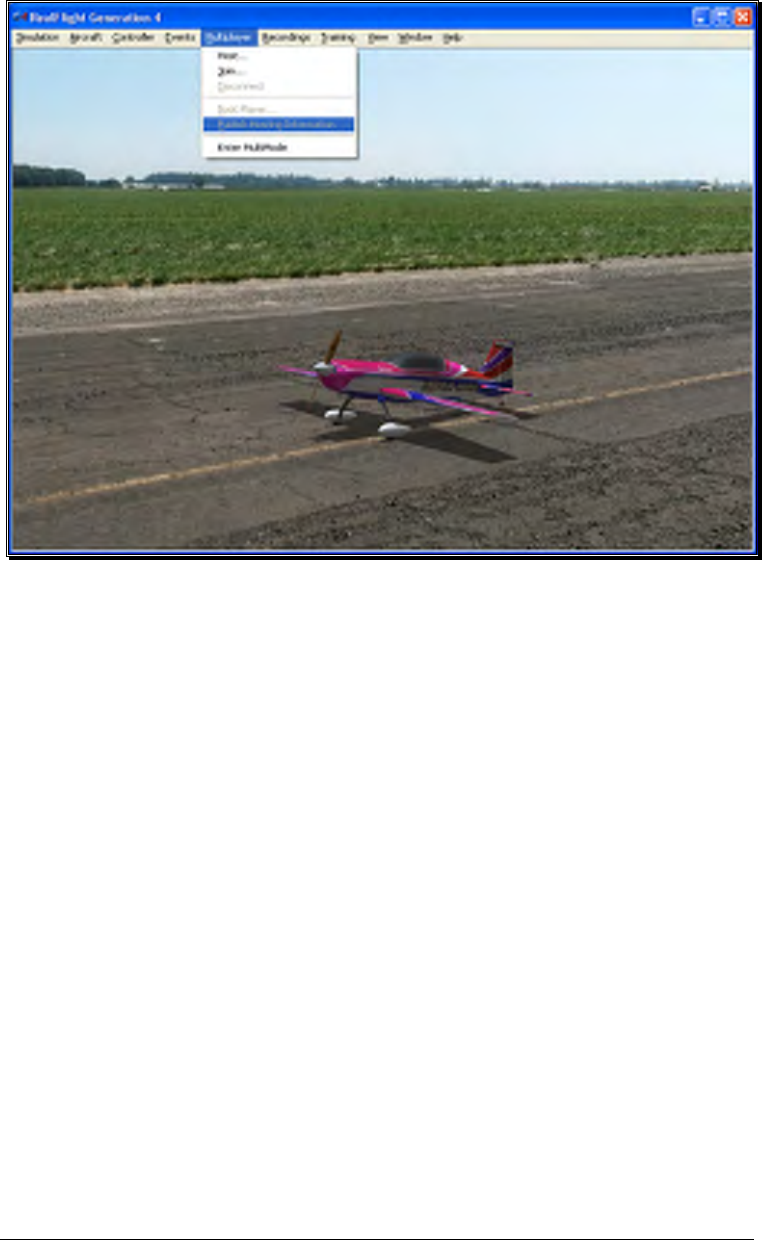
187
Please note: at the time of this writing, we are providing the list server on a trial basis
only. This service may be modified, interrupted or discontinued at any time without
notice.
Enter MultiMode
MultiMode allows you to fly with another pilot on the same PC, with each pilot
controlling his or her own aircraft. This feature is ideal for offering personal flight
instruction, practicing formation flights, or simply for chasing one another across the
skies.
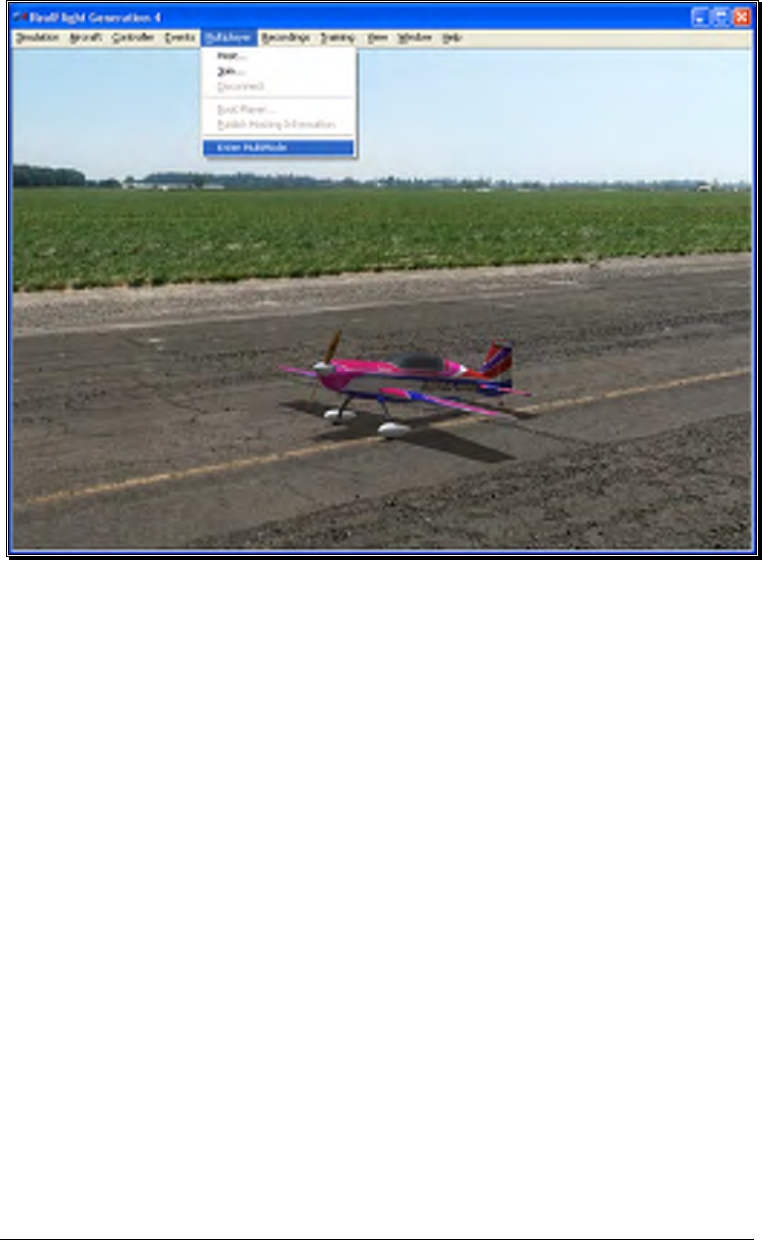
188
To access the MultiMode menu item, click on the Multiplayer menu followed by the
MultiMode menu item.
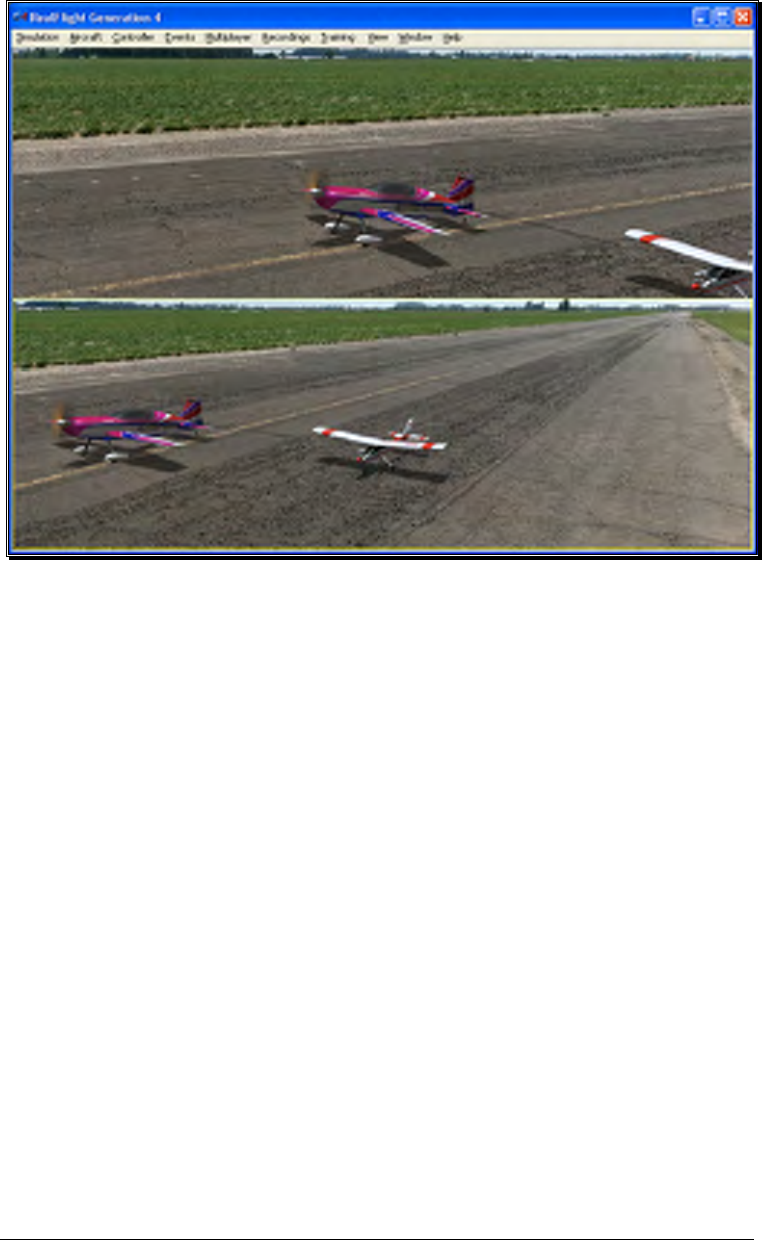
189
MultiMode will split the screen either horizontally (default) or vertically. You can
change this options in the Settings window. Simply click the Simulation menu,
followed by Settings. On the left side of the Settings screen that appears, choose
Multiplayer. On the right, you can adjust the Multimode Screen Layout to
Horizontal or Vertical.
All options available in RealFlight are also available in MultiMode. The difference is
most will function on the half of the screen that currently is active. To determine
which half has the focus or is active, look for the yellow outline. To change focus, click
the half that doesn’t have the yellow outline. You’ll notice the focus change when you
do so.
For example, if you are flying in MultiMode with a horizontally split screen, you might
notice that the yellow outline is around the type half. If you want to change the aircraft
for the person flying on the bottom half of the screen, first click that half of the
window so it has the focus or is the active screen. Select an aircraft following the
normal procedure.
To exit MultiMode, select Exit MultiMode menu item under the Multiplayer main
menu.
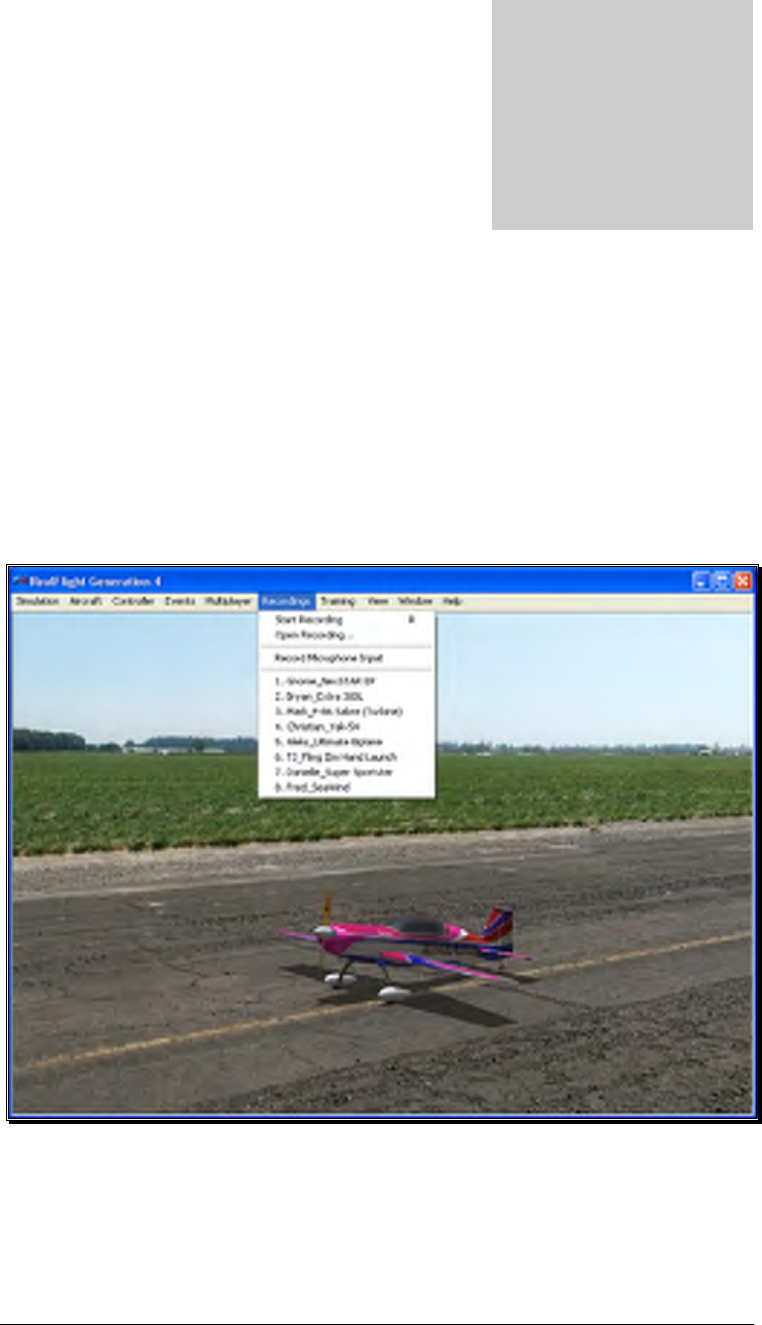
191
Recordings Menu
Save and playback RealFlight memories.
he Recordings menu is used to start and stop recordings to assist you in your
R/C ventures. RealFlight G4 also allows you to record your flights for later
playback -- complete with audio voiceovers. You can even share your flights
with friends and fellow pilots.
Menu options that are available for Recordings are:
• Start/Stop Recording
Chapte
r
10
T
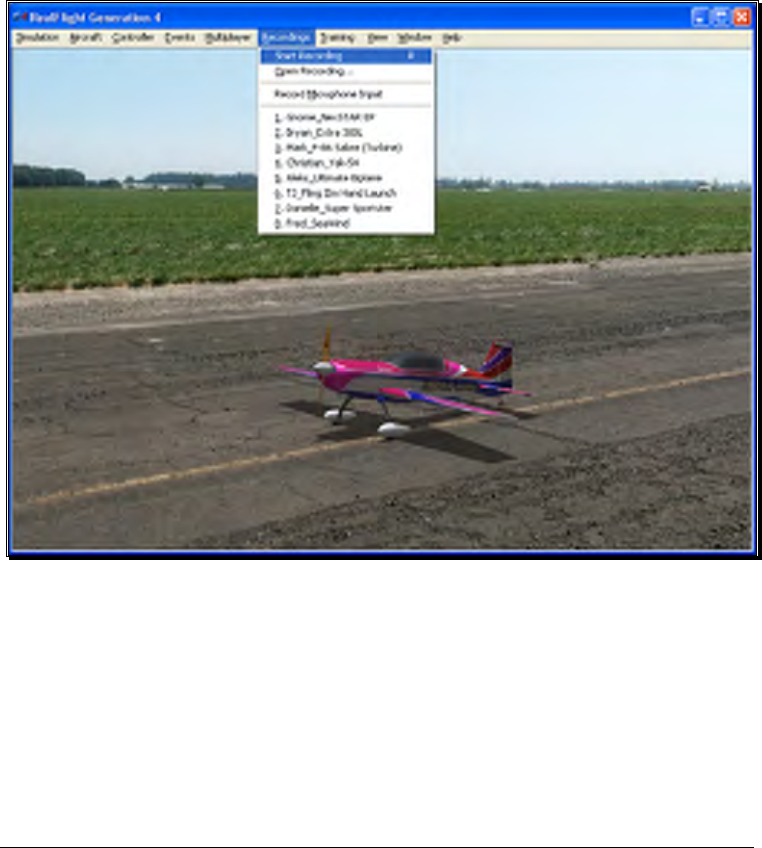
192
• Open Recording
• Record Microphone Input
• Recordings MRU
Start Recording
Click on the Recording menu followed by the Start Recording menu item.
RealFlight G4 will start recording your flight immediately. An on-screen message will
confirm that the recording has started.
Alternatively, you may also press the keyboard’s ‘R’ key to start a recording.
RealFlight will continue recording your flight until you select the Stop Recording
menu item or press ‘R’ again to stop recording.

193
Stop Recording
The Stop Recording menu item is not visible until the Start Recording menu item
activates. To stop the recording of your flight at any time, click the Recording menu
title, followed by the Stop Recording option. RealFlight G4 will stop recording at this
time. RealFlight G4 automatically saves all recordings for playback later. For
information on how to delete a recording, please see the Open Recording… section
which follows.
Alternatively, you may also press the keyboard’s ‘R’ key to stop recording.
When RealFlight G4 stops recording, an on-screen message appears which indicates
the default name of the recording that has just been completed. For information on
how to change the name of a recording, please see the Open Recording… section
which follows.
Open Recording…
This menu item allows you to access the recording files. It also allows you to perform
a variety of modifications to the files such as renaming them or deleting them. To
access the recordings, click the Recording menu title, followed by the Open
Recording… menu item.
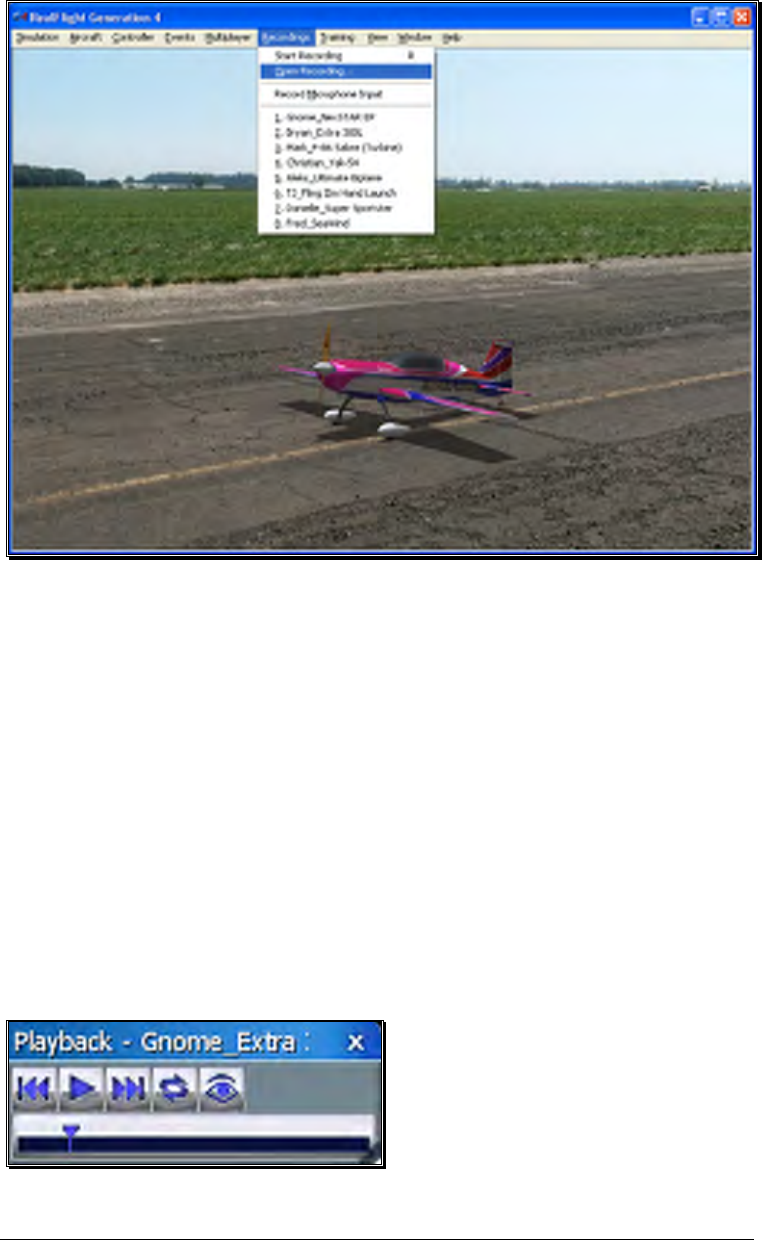
194
To open a recording, click on the file name. Next, click on the Open button.
Alternatively, you may double-click on the file. Regardless of which method you utilize,
this will start RealFlight’s Playback Gadget. For more information on the Playback
Gadget, please refer to the information below.
If you wish to rename the recording, simply right click on the respective Recording,
select rename from the drop-down menu and rename the file.
To delete a recording, right click on the Recording file and select Delete from the pull-
down list.
Playback Gadget-
When you open a recording, RealFlight G4’s playback gadget appears on the screen.
This gadget allows you to control the playback of the recordings using simple mouse
commands. It features DVD-like controls that start, stop, or pause the playback. It is
also possible to modify the playback gadget.
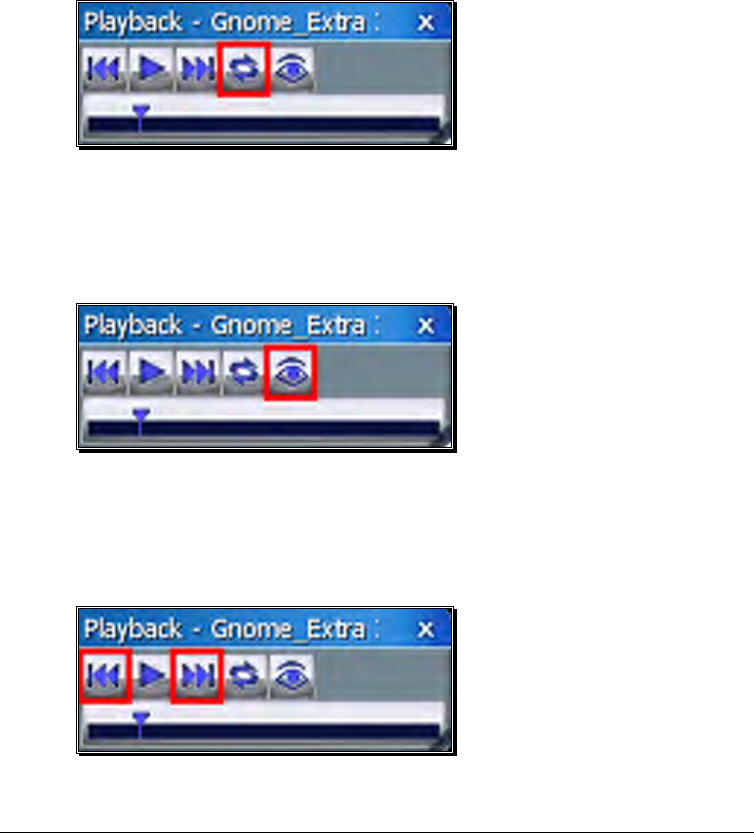
195
If you do not wish to view the playback information, double-click the title bar of the
display box. This will hide the information. To view it once again, simply double-click
the title bar again.
To resize the playback gadget display, position the cursor over the lower right corner of
the frame. Using the mouse drag the frame according to your wishes. Dragging the
frame to the right or left increases or decreases the width of the viewport, respectively.
Clicking on the ‘X’ in the viewport’s title tab removes it from the screen and exits the
playback.
Loop Play-
The arrows that forms a circle causes the recording to loop (i.e., play
continuously). The continuous loop is activated when the arrows are
illuminated. To stop the looping, click on the loop button again.
Look at Recording-
Click on the ‘eye’ to look at the respective Recording. This causes the camera
to treat the recording as its target object, rather than your aircraft. If you have
multiple recordings playing, choose the ‘eye’ of the Recording you wish to view.
Left/Right Arrows-
The left and right arrows rewind (left) or fast forward (right) the recording.
Alternatively, you may click on the position indicator, hold the mouse button
and drag the indicator to the desired position.
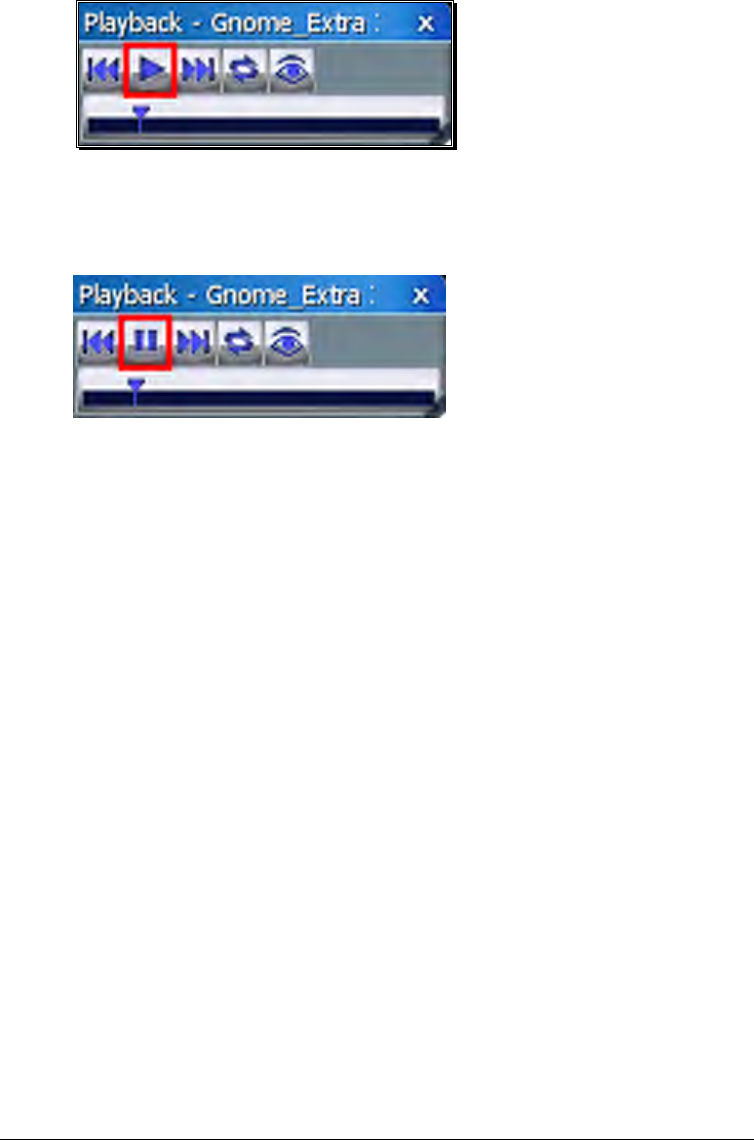
196
Playback/Pause-
If the recording is paused, the playback button will be the single arrow pointing
to the right. To resume playback of the recording, click this arrow.
If the recording is playing, the playback button will switch to a pause button.
To pause playback, press this button. You may continue at any time by
pressing the playback button once again.
Position of Recording-
The slider bar and position indicator are used to track the progress of the
recording playback.
It is also possible to use the position indicator to select the point at which you
wish the recording to begin playing. Using the mouse drag, position the slider
bar to the position desired.
Record Microphone Input
RealFlight G4 also allows you to add your voice or other audio to the recordings. If
selected, the Record Microphone Input menu item activates and allows you to record
audio input to accompany your recording.
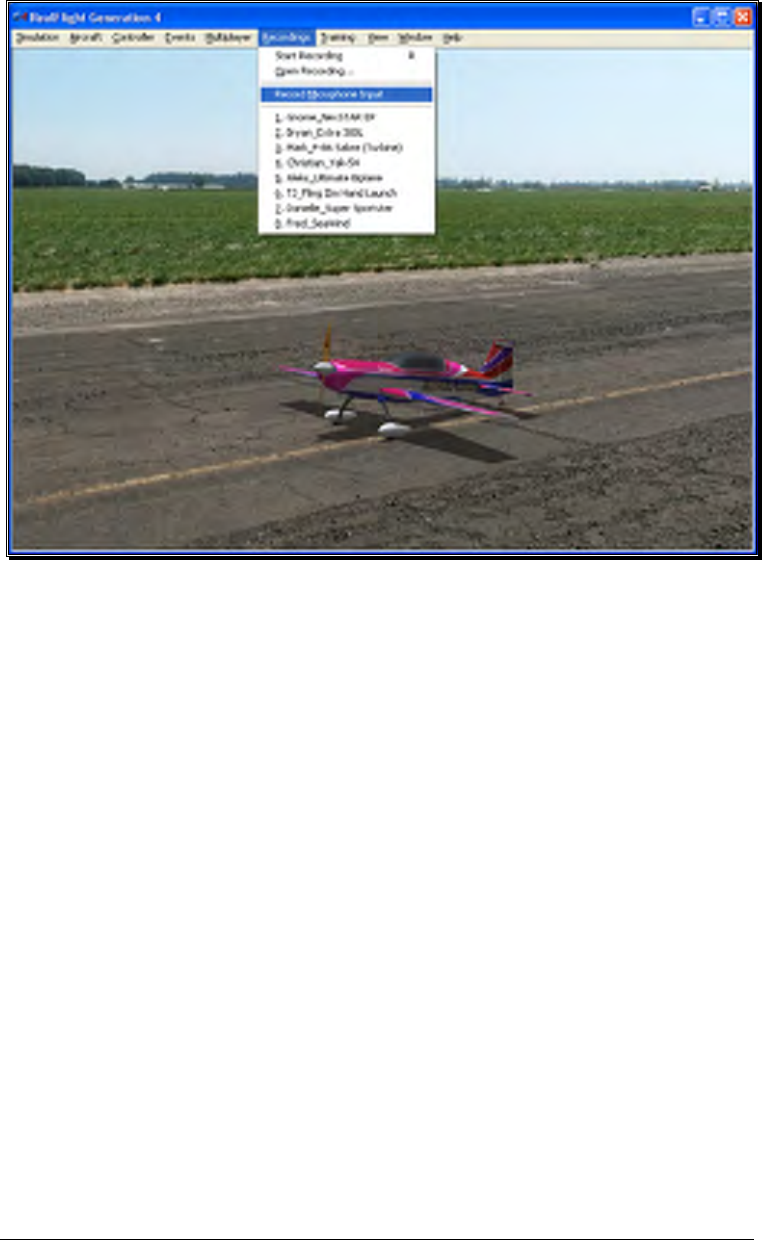
197
Adding your voiceover to the recordings is a fantastic way to create personalized
training lessons. This feature presents you with the ability to create your own Virtual
Flight Instructions that you can share with other RealFlight G4 owners around the
world!
Recordings MRU
If you have previously selected a recording, you will note that it appears on a list in the
Recordings menu title. Lists such as this are commonly referred to as Most Recently
Used, or MRU lists. The MRU list is limited to the eight most recently selected
recordings. If you wish to view one of these recordings simply click on the name of
the recording and it will begin.
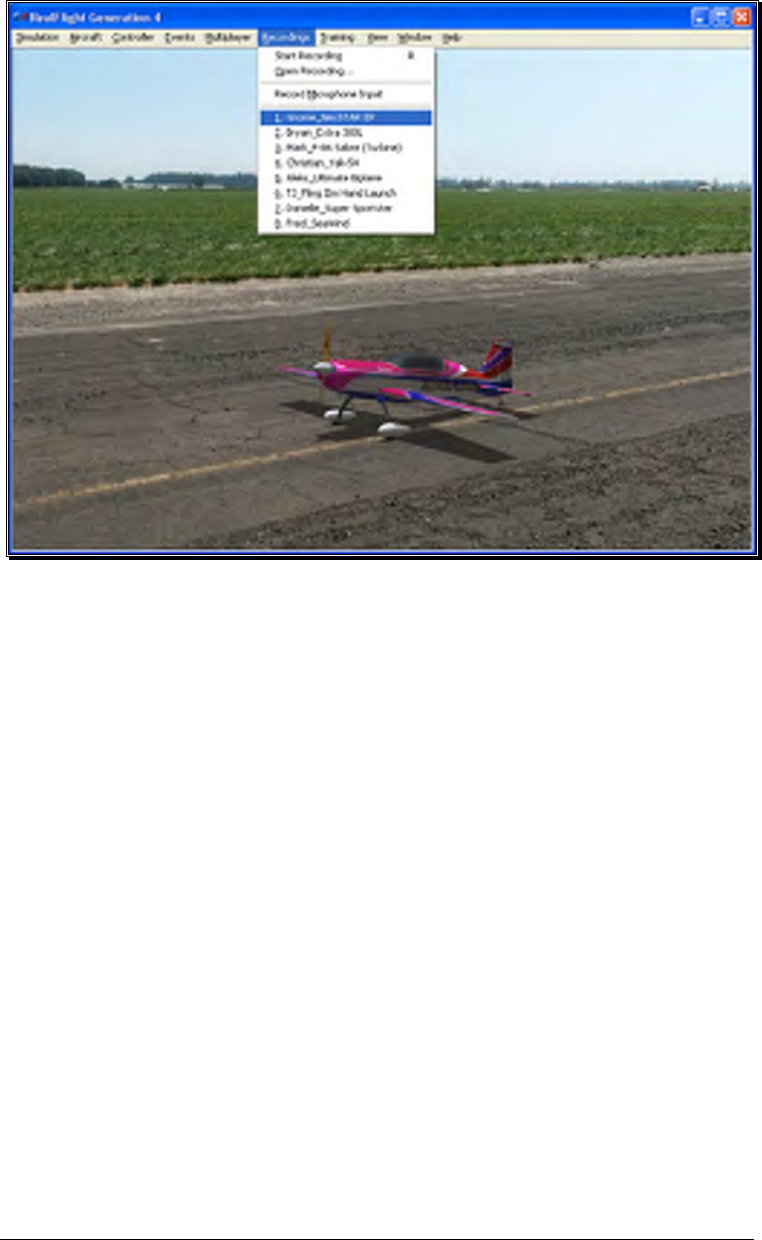
198

199
Training Menu
Practice makes perfect. RealFlight’s Training Aids make practicing a little more
enjoyable.
ealFlight G4 offers a number of training aids. These training aids are designed
for modelers of all skill levels.
Helicopter pilots will benefit from the Heli Hover Trainer, Heli Orientation
Trainer and the helicopter Virtual Flight Instructions. The Heli Hover Trainer and
Heli Orientation Trainer offer modelers the chance to practice their stick control and
helicopter attitude recognition. With Virtual Flight Instructions, R/C professionals
offer audio and visual instruction on how to perform basic, intermediate and advanced
maneuvers.
Airplane modelers will also benefit from the Takeoff Trainer, Landing Trainer,
Airplane Hover Trainer and Virtual Flight Instructions.
Chapte
r
11
R
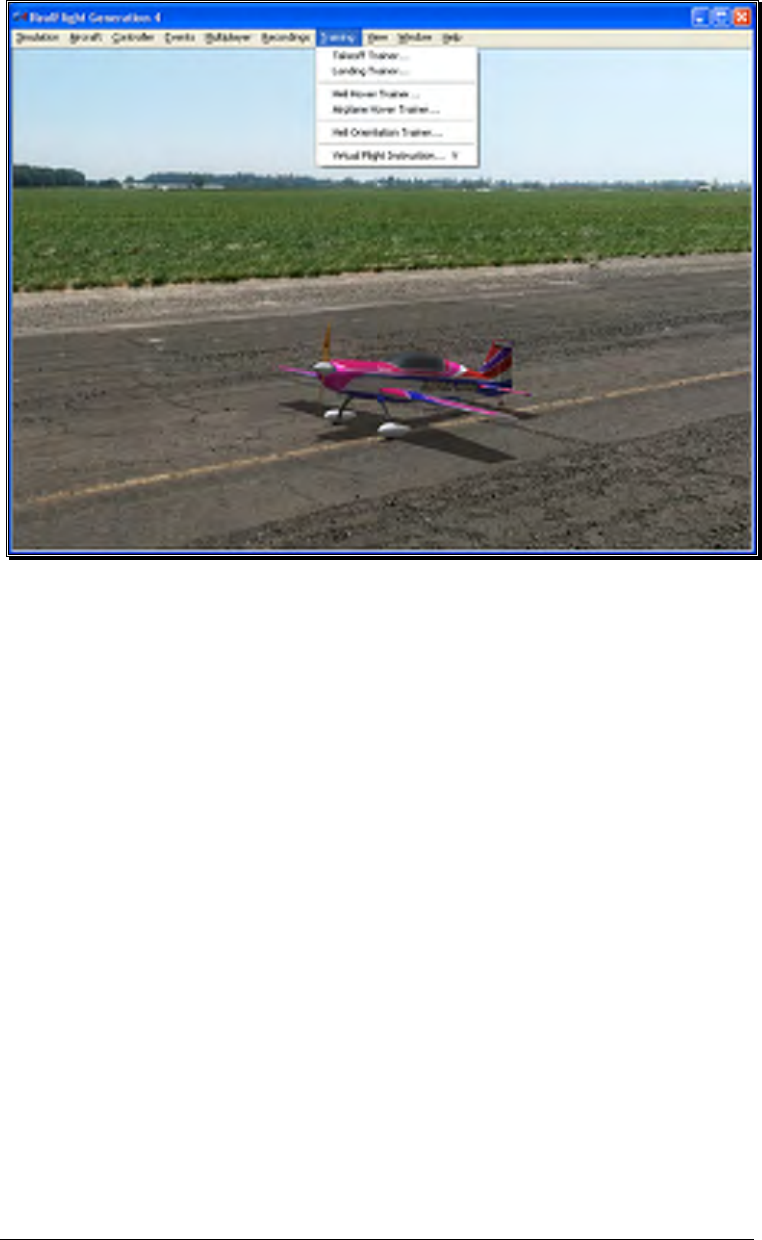
200
Once you click on the Training menu, the following menu options appear:
• Takeoff Trainer…
• Landing Trainer…
• Heli Hover Trainer…
• Airplane Hover Trainer…
• Heli Orientation Trainer…
• Virtual Flight Instruction…
Takeoff Trainer
The Takeoff Trainer offers a great way for first time pilots to learn the basics of taking
off an airplane. With this trainer, you have the ability to adjust wind settings, takeoff
direction, and overall difficult to stay on the runway.
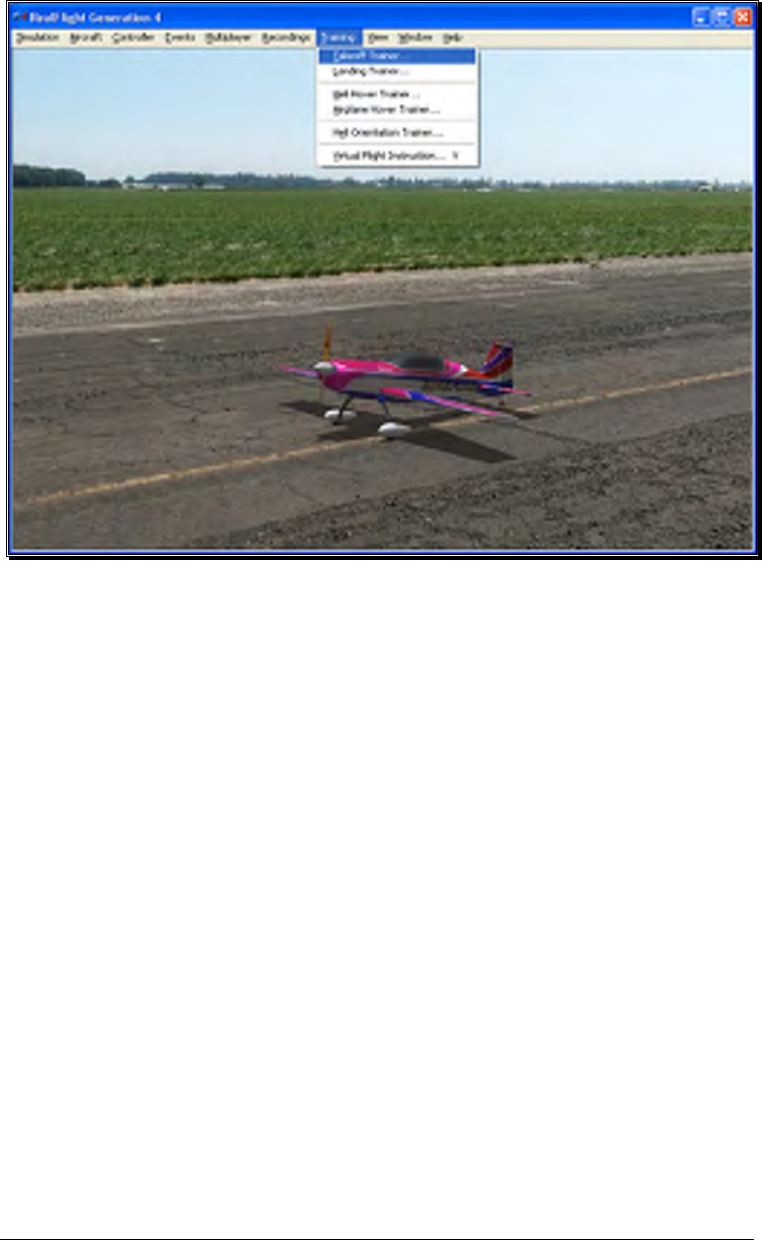
201
To start the trainer, click Takeoff Trainer… menu item from the Training menu.
The trainer will start automatically.
The Takeoff Trainer feature is based on RealFlight’s Flight School flying site. As such,
you’ll notice that RealFlight automatically uses the Flight School airport. You’ll see that
the NexSTAR trainer sitting at the end of the runway, waiting for your inputs. The
goal is to takeoff as straight as possible down the runway, pulling back gently on the
elevator. As you takeoff, you’ll notice a number of arrows in the sky. These arrows
indicate the path that you should follow. The arrows will appear red in color if you are
on the correct path, blue if you are not.
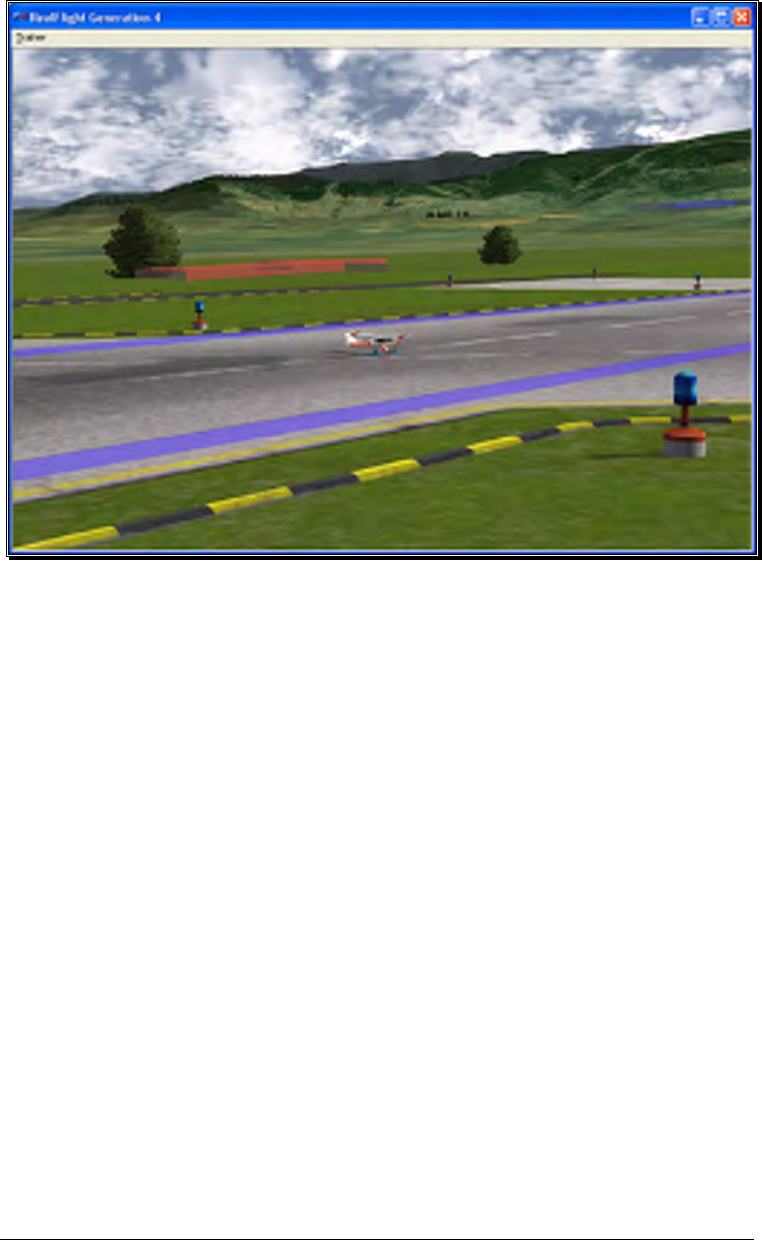
202
You’ll also notice the menus have changed, which we’ll discuss here.
Trainer Menu-
The Trainer Menu contains the following menu items:
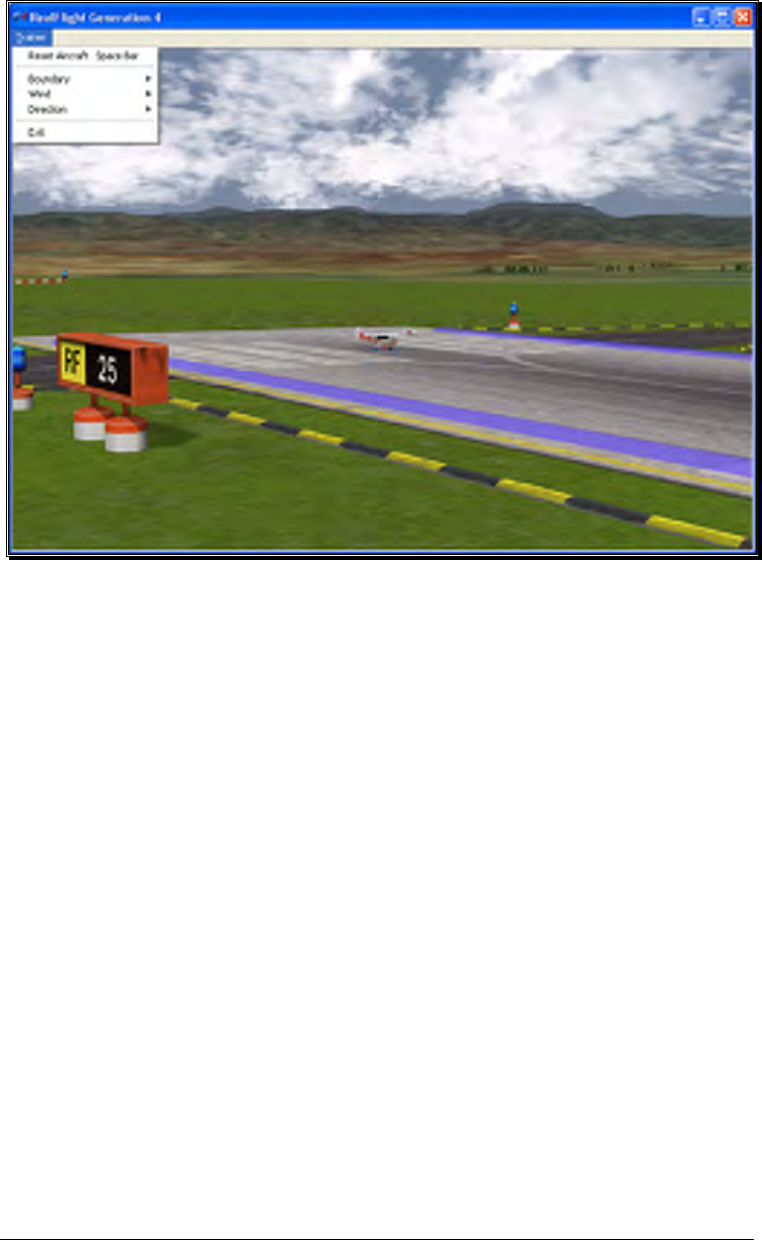
203
• Reset Aircraft
• Boundary
• Wind
• Direction
• Exit
Reset Aircraft-
If you crash or fly too far out of the boundary area, there are three ways to
reset the aircraft:
1. Press the Reset button on the InterLink Elite controller. This is
probably the fastest and simplest method.
2. Press the keyboard’s space bar.
3. Click the Reset Aircraft menu item

204
Boundary-
The Boundary menu item allows you the change the size of the runway path
for which you must stay inside while taking off. To change the size or the
boundary, select the Boundary menu item from the Trainer menu. A sub-
menu will appear with the following options.
• None – Eliminates the boundary all together.
• Small – Creates a tighter boundary which is excellent training for practicing
precise takeoffs.
• Medium – Creates a medium path boundary.
• Large – Creates a large boundary.
Once you select a boundary size, you’ll notice one blue line on either side of
the runway. During takeoff, you must try to stay inside these lines. If you get
too close, they will turn red. Correct the flight path of your airplane so that you
are more centered on the runway.
Wind-
Not everyday can be an ideal day to fly. Every pilot must learn how to takeoff
with different wind conditions. The Wind menu will allow you to adjust the
direction of the wind. When you select the Wind menu item, the following
options will appear.
• None – Turns the wind off to simulate a calm day.
• Crosswind Left – This will set the wind to blow from the left of the
aircraft.
• Crosswind Right – This will set the wind to blow from the right of the
aircraft.
• Upwind (Normal) – Upwind will set the wind to blow towards the nose of
the aircraft.
• Downwind (Dangerous) – This will create a tail wind, making it more
difficult to takeoff due to the decrease in airspeed.
Direction-
The Direction menu will allow you to change the direction in which you
takeoff. For an R/C pilot, you don’t have the luxury of sitting in the airplane,
so you must learn how to control the airplane from any direction. Selecting
the Direction menu will show the following options.
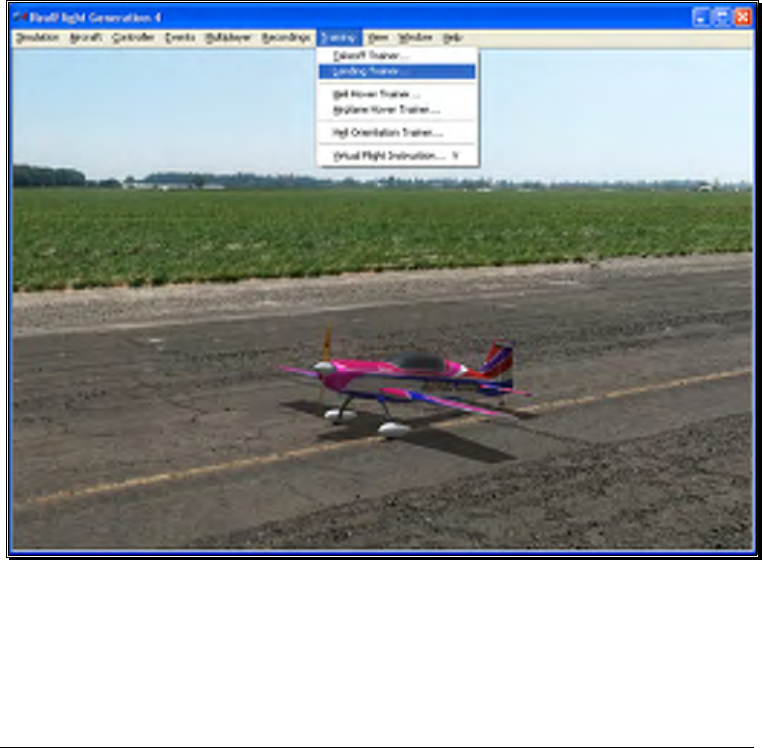
205
• Left to Right – Take off from the left side of the runway, heading to the
right.
• Right to Left – Take off from the right end of the runway, heading to the
left.
Exit-
If you wish to leave the Takeoff Trainer and return to the simulation, select the
Exit menu item.
Landing Trainer
The old saying goes, “Take offs are easy, landings are the hard part.” Once you master
the Takeoff Trainer, the next step is to learn how to land, which is what the Landing
Trainer is designed to do.
To start the Landing Trainer, click the Training menu, followed by the Landing
Trainer… menu item.
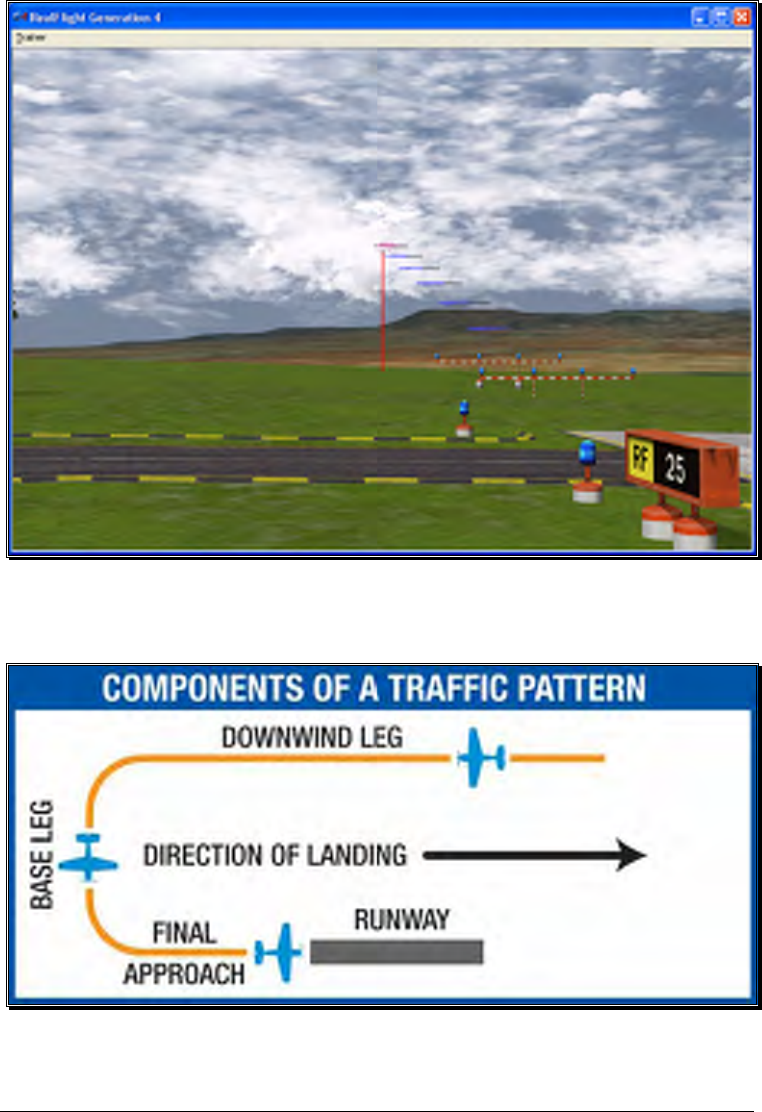
206
You’ll notice that RealFlight switched airports to Flight School, if you were not there
already. For this training session, you’ll be piloting Hobbico’s NexSTAR. You’ll also
have options, should you wish, to adjust where to start the landing, wind direction, and
how difficult it should be to hit the runway.
For landings, it’s important to understand the different legs during the approach to the
runway.
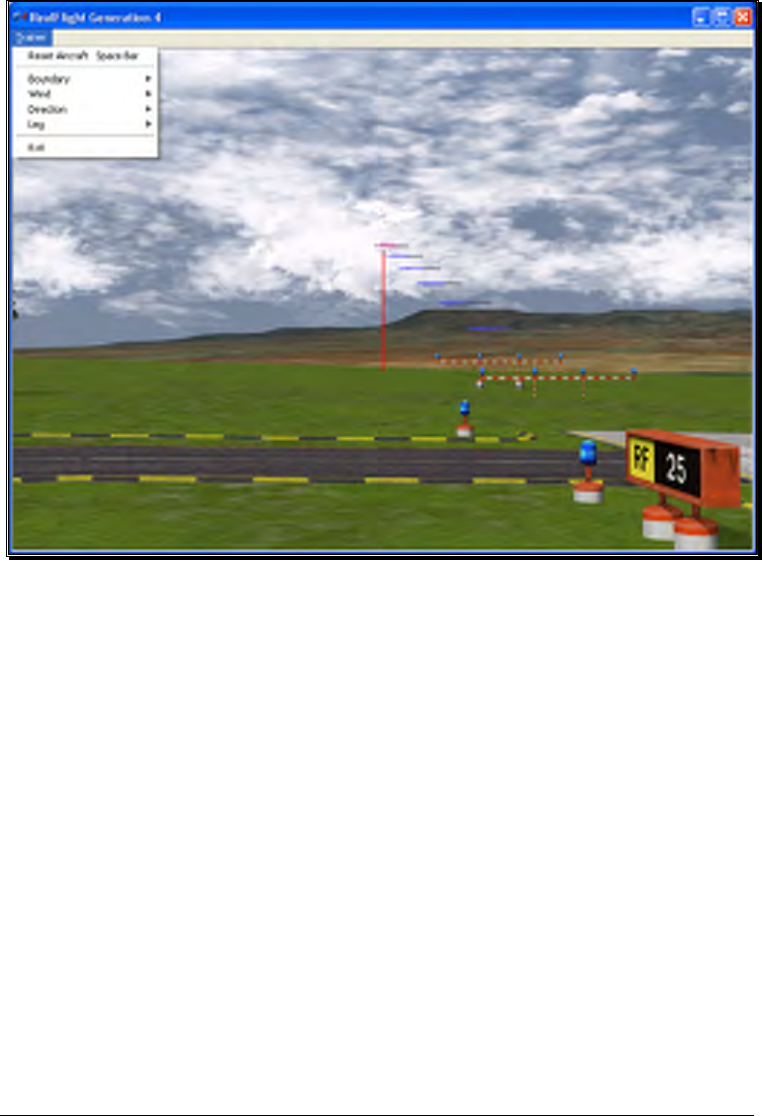
207
When you start the Landing Trainer, you’ll notice a new menu has appeared.
Trainer Menu-
The Trainer Menu contains the following menu items:
• Reset Aircraft
• Boundary
• Wind
• Direction
• Leg
• Exit
Reset Aircraft-
If you crash or fly outside the boundary, there are three ways to reset the
aircraft:
1. Press the Reset button on the InterLink Elite controller. This is
probably the fastest and simplest method.

208
2. Press the keyboard’s space bar.
3. Click the Reset Aircraft menu item.
Boundary-
The Boundary menu item allows you the change the size of the runway path in
which you must land between. To change the size or the boundary, select the
Boundary menu item from the Trainer menu. A sub-menu will appear with
the following options.
• None – Eliminates the boundary all together.
• Small – Creates a tighter boundary which is excellent training for precise
landings.
• Medium – Creates a medium path boundary.
• Large – Creates a large boundary.
Once you select a boundary size, you’ll notice one blue line on either side of
the runway. During your landing, you must try to stay between these lines. If
you get too close, they will turn red. Correct the flight path of your airplane so
that you are more centered on the runway.
Wind-
Every pilot must learn how to land with different wind conditions. In some
respects, this can be more difficult than takeoffs, since you must learn how to
deal with different wind conditions for each leg of the approach. The Wind
menu will allow you to adjust the direction of the wind. When you select the
Wind menu item, the following options will appear.
• None – Turns the wind off to simulate a calm day.
• Crosswind Left – This will set the wind to blow left across the runway.
• Crosswind Right – This will set the wind to blow from the right across the
runway.
• Upwind (Normal) – Upwind will set the wind to blow towards the nose of
the aircraft as you are on your final leg.
• Downwind (Dangerous) – This will create a tail wind during the final leg,
making it more difficult to land due to the decrease in airspeed.

209
Direction-
It’s important to learn how to land from any direction. This menu item will
change the approach direction to learn the controls from a different aspect.
The choices that appear when you select the Direction menu item are as
follows.
• Left to Right – This will set you up to land on the runway from the left
end flying towards the right.
• Right to Left - This will set you up to land on the runway from the right
end flying towards the left.
Leg-
The Leg menu item allows you to practice each leg of the approach. The
options are as follows.
• Downwind – This sets the aircraft up on the downwind side, or parallel to
the runway. From here, you must fly the Downwind, turn to Base, and
then the Final for the landing.
• Base – This sets the aircraft up for the Base leg of the approach. You
must complete the Base leg and then turn to the Final leg prior to landing.
• Final – The Final leg will set you up for the landing.
When the training lesson begins, the NexSTAR will be placed at the beginning
of the Leg you choose. Simply hit the Reset button on the InterLink Elite to
begin flying.
Exit-
If you wish to leave the Landing Trainer and return to the simulation, select
the Exit menu item.
Heli Hover Trainer
The Heli Hover Trainer offers you a great way to learn how to precisely control a
helicopter in a hover. With the Heli Hover Trainer, you pick which channels you wish
to control and RealFlight will take care of the rest for you.
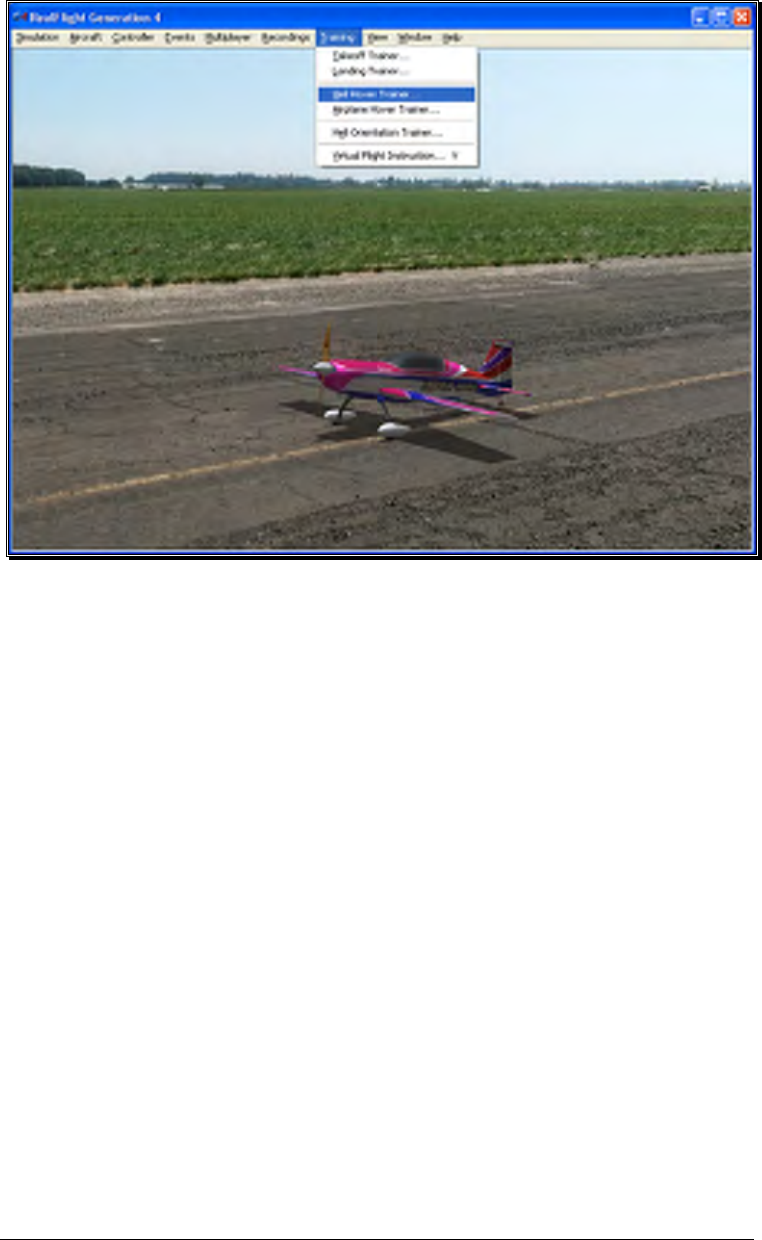
210
To start the trainer, click Heli Hover Trainer… menu item from the Training menu.
The trainer will start automatically.
You’ll notice a circle on the ground. This circle represents the training boundary. If
your helicopter ventures beyond this boundary, it will break apart and the session will
begin once again. You’ll also note two ‘X’ marks within the boundary. The circle
represents the true center of the boundary, the ‘X’ represents the current location of
your helicopter. The goal is to control the helicopter in a stable hover, keeping it as
close to the center of the circle as possible.
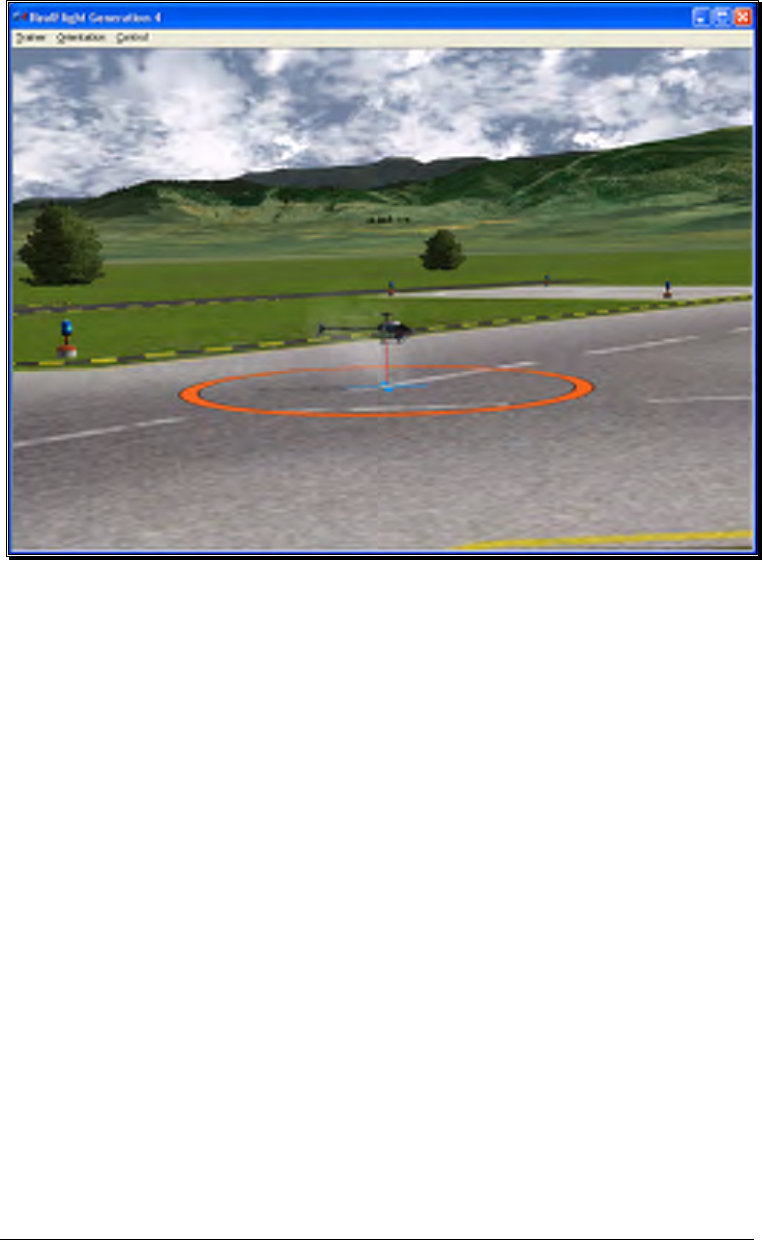
211
You’ll also notice that the menu options have changed.
Trainer Menu-
The Trainer Menu contains the following menu items:
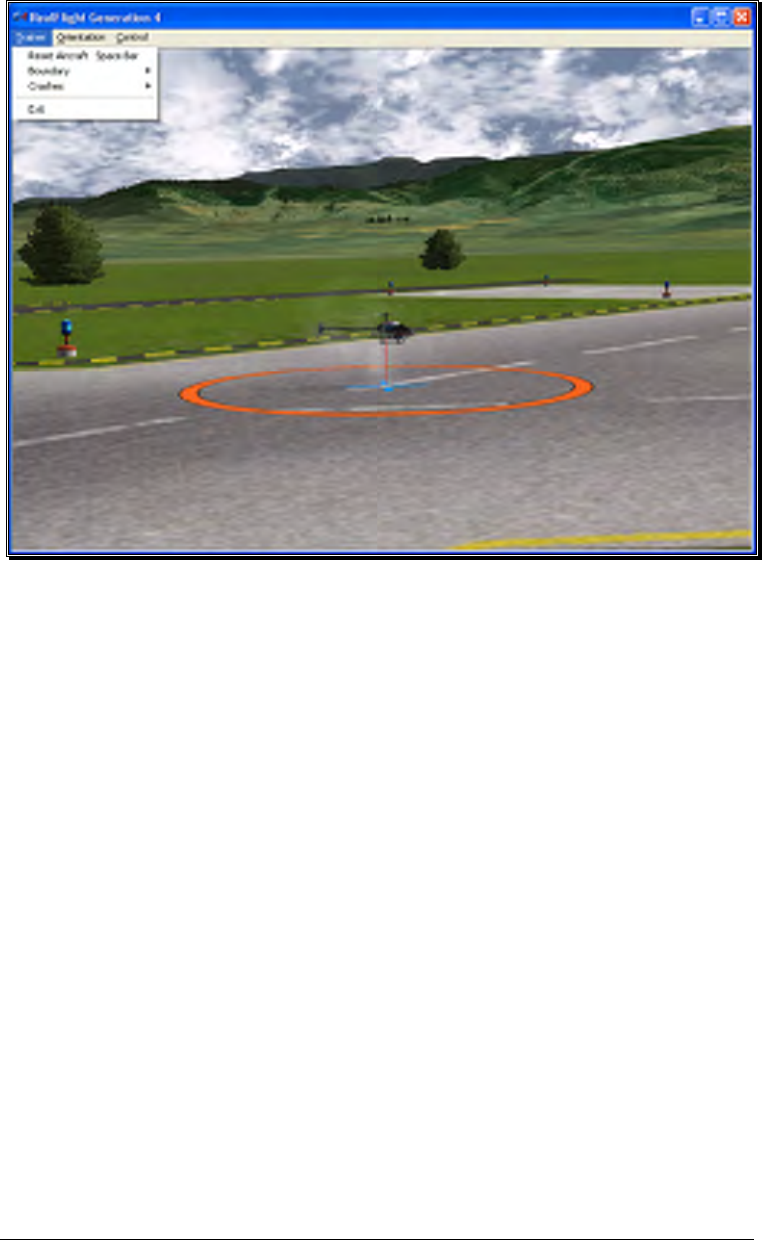
212
• Reset Aircraft
• Boundary
• Crashes
• Exit
Reset Aircraft-
If you crash or fly outside the circle, there are three ways to reset the aircraft:
1. Press the Reset button on the InterLink Elite controller. This is
probably the fastest and simplest method.
2. Press the keyboard’s space bar.
3. Click the Reset Aircraft menu item.
Boundary-
The Boundary menu item allows you to change the size of the circle, or
eliminate it altogether. To change the size of the boundary, select the
Boundary menu item from the Trainer menu. A drop down menu will
appear with the following options.

213
• None – Eliminate the boundary circle.
• Small – Creates a small circle.
• Medium – Creates a medium sized circle.
• Large – Creates a large circle.
Crashes-
After a crash, RealFlight may automatically reset your helicopter for you, if so
desired. This option is on by default. If you would prefer to turn this option
off, select the Crashes menu item, then select the Automatically Reset
Aircraft. If a checkmark appears next to this menu item, then this feature is
activated. If the checkmark does not appear, it is not active.
If Automatically Reset Aircraft is enabled, you may adjust how quickly the
reset happens. To adjust this delay, select the Crashes menu item followed by
the Reset Delay menu item. Four options will be available to you:
• None – No delay will be set. The aircraft will reset immediately.
• Short – The aircraft will reset approximately one second after it crashes.
• Medium – The aircraft will reset approximately three seconds after it
crashes.
• Long – The aircraft will reset approximately six seconds after it crashes.
Exit-
If you wish to leave the Heli Hover Trainer and return to the simulator, select
the Exit menu item.
Orientation Menu-
The Orientation menu allows you the option to select the position and attitude of the
heli when the session begins or the helicopter is reset.
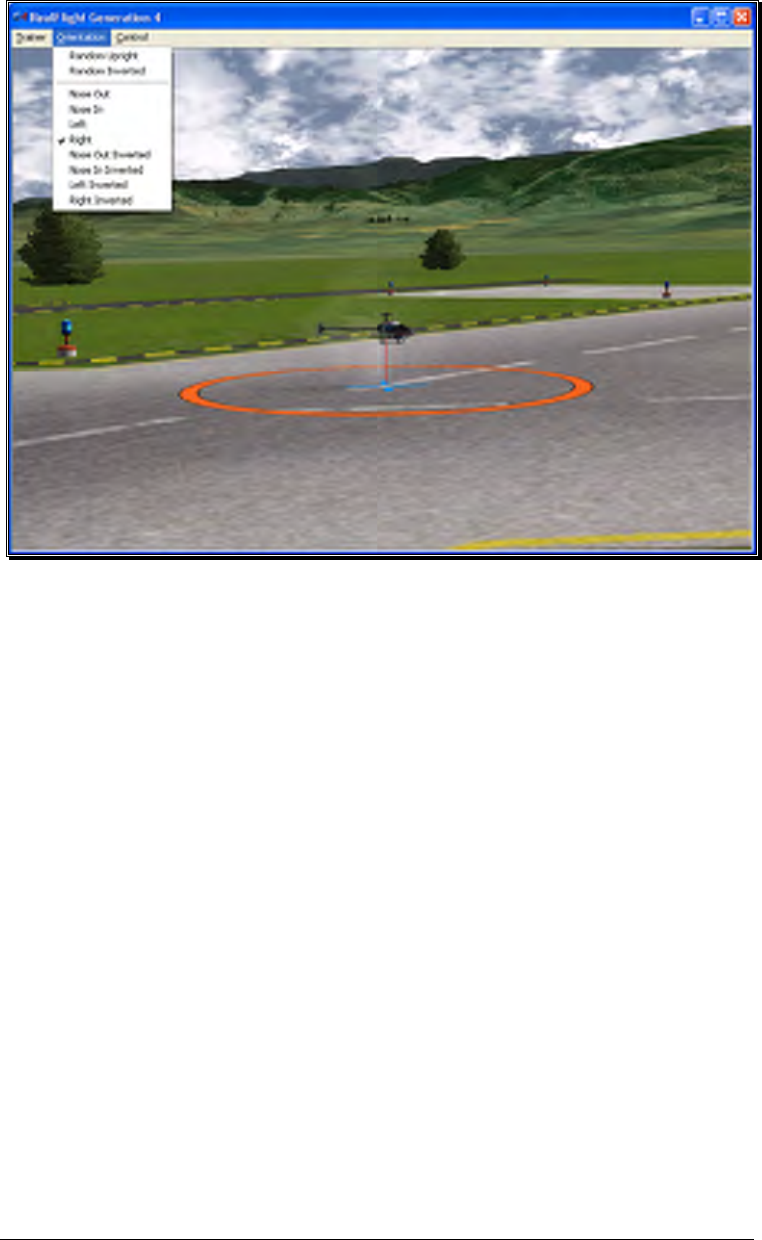
214
A checkmark will appear next to the currently selected orientation. The options
available are:
• Random Upright – The heli will start in the upright position, but it will randomly
face either to the right, left, nose out, or nose in.
• Random Inverted – The heli will start in the inverted position, but it will randomly
face either to the right, left, nose out, or nose in.
• Nose Out – The heli will start upright, facing nose out. This option is the best
selection for beginning heli pilots.
• Nose In – The heli will start upright, facing nose in.
• Left – The heli will start upright, facing to the left.
• Right – The heli will start upright, facing to the right.
• Nose Out Inverted – The heli will start inverted, facing nose out.
• Nose In Inverted – The heli will start inverted, facing nose in.
• Left Inverted – The heli will start inverted, facing to the left.
• Right Inverted – The heli will start inverted, facing to the right.
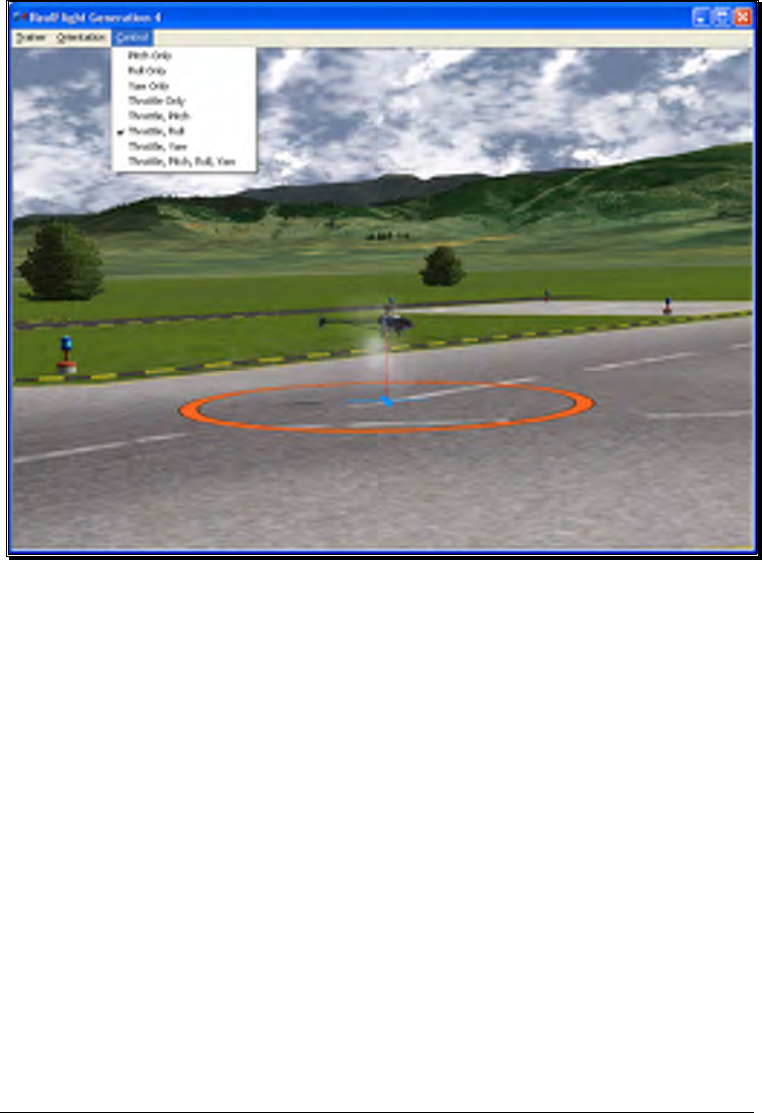
215
Control Menu-
The Control menu allows you to select which channel or channels to control. All other
channels are controlled by RealFlight, allowing you to learn just the controls you wish,
and adding more as you become more comfortable and confident.
A checkmark will appear in the menu next to the currently selected item. Your options
are:
• Pitch Only – You control only the pitch of the heli, RealFlight will control the roll,
yaw, and throttle.
• Roll Only – You control only the roll of the heli, RealFlight will control the pitch,
yaw, and throttle.
• Yaw Only – You control only the yaw of the heli, RealFlight will control the roll,
pitch, and throttle.
• Throttle Only – You control only the throttle of the heli, RealFlight will control the
roll, yaw, and pitch.
• Throttle, Pitch – You control both the throttle and pitch of the heli, RealFlight will
control the roll, and yaw.
• Throttle, Roll – You control both the throttle and roll of the heli, RealFlight will
control the pitch, and yaw.
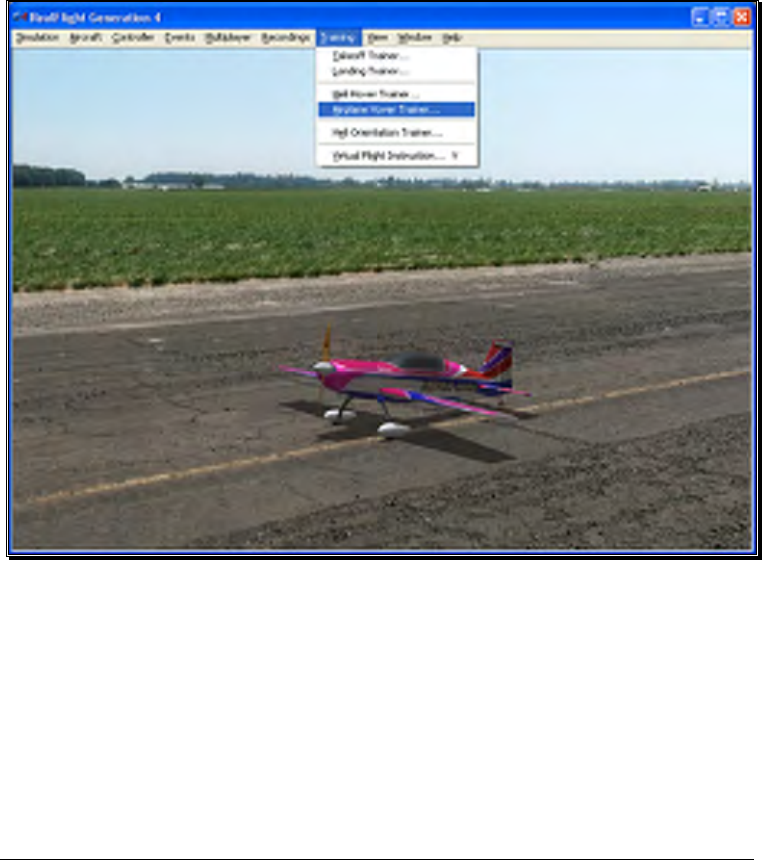
216
• Throttle, Yaw – You control both the throttle and yaw of the heli, RealFlight will
control the roll, and pitch.
• Throttle, Pitch, Roll, Yaw – You control all channels for the heli.
Airplane Hover Trainer
The Airplane Hover Trainer offers you a great way to learn how to control an
aerobatic airplane in a torque roll. With the Airplane Hover Trainer, you pick which
channels you wish to control. RealFlight automatically controls the rest.
To start the trainer, click Airplane Hover Trainer… menu item from the Training
menu. The trainer will start automatically.
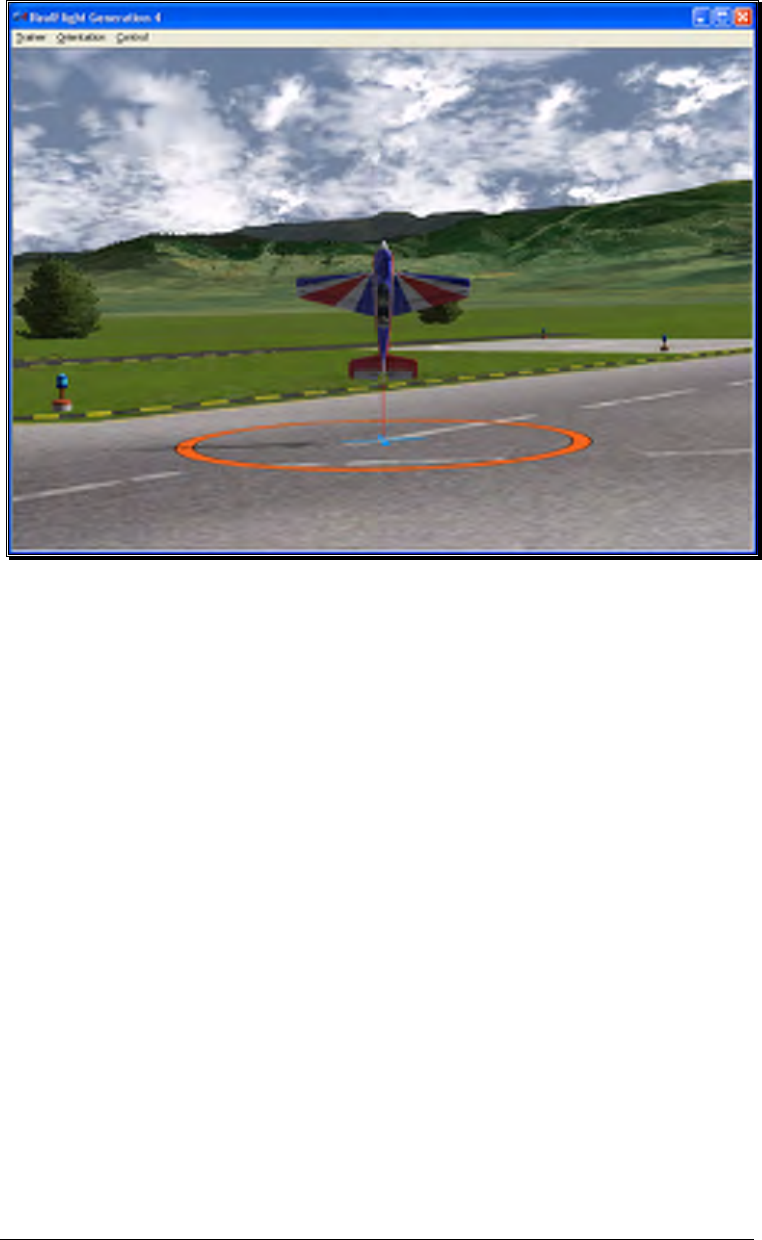
217
You’ll notice a circle on the ground. This circle represents the training boundary. If
your airplane ventures beyond this boundary, it will break apart and the session will
begin once again. You’ll also not two ‘X’ marks within the boundary. One represents
the true center of the boundary; the second is your airplane location. The goal is to
control the airplane in a stable hover, keeping it as close to the center of the circle as
possible.
You’ll also notice the menus have changed, which we’ll explain here.
Trainer Menu-
The Trainer Menu contains the following menu items:
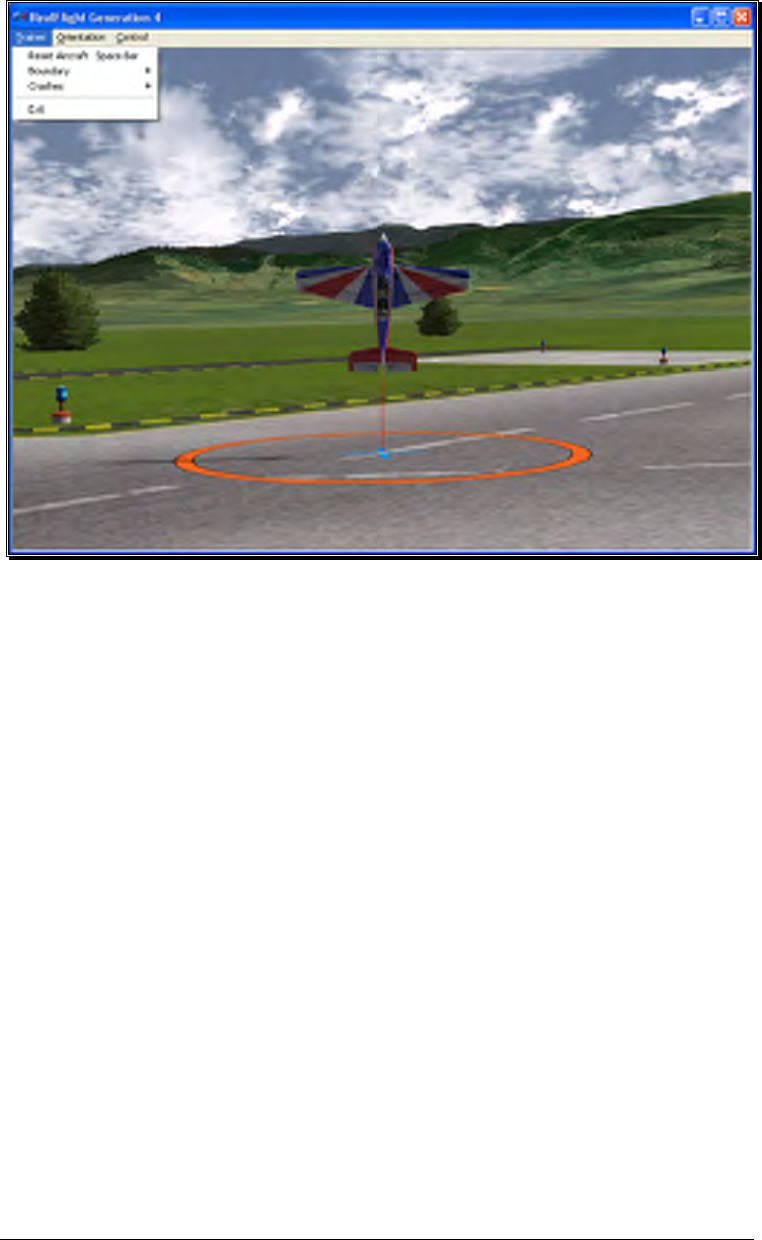
218
• Reset Aircraft
• Boundary
• Crashes
• Exit
Reset Aircraft-
If you crash or fly outside the circle, there are three ways to reset the aircraft:
1. Press the Reset button on the InterLink Elite controller. This is
probably the fastest and simplest method.
2. Press the keyboard’s space bar.
3. Click the Reset Aircraft menu item.
Boundary-
The Boundary menu item allows you the change the size of the circle, or
eliminate altogether. To change the size or the boundary, select the Boundary
menu item from the Trainer menu. A drop down menu will appear with the
following options.

219
• None – Eliminates the boundary circle.
• Small – Creates a small circle.
• Medium – Creates a medium-sized circle.
• Large – Creates a large circle.
Crashes-
After a crash, RealFlight may automatically reset your aircraft for you, if so
desired. This option is on by default. If you would prefer to turn this option
off, select the Crashes menu item, then select the Automatically Reset
Aircraft. If a checkmark appears next to this menu item, then this feature is
activated. If the checkmark does not appear, it is not active.
If Automatically Reset Aircraft is enabled, you can adjust how quickly the reset
happens. To adjust this delay, select the Crashes menu item followed by the
Reset Delay menu item. Four options will be available to you:
• None – No delay will be set. The aircraft will reset instantaneously.
• Short – The aircraft will reset approximately one second after it crashes.
• Medium – The aircraft will reset approximately three seconds after it
crashes.
• Long – The aircraft will reset approximately six seconds after it crashes.
Exit-
If you wish to leave the Airplane Hover Trainer and return to the simulator,
select the Exit menu item.
Orientation Menu-
The Orientation menu allows you the option to select the position and attitude of the
helicopter when the session begins or the airplane is reset.
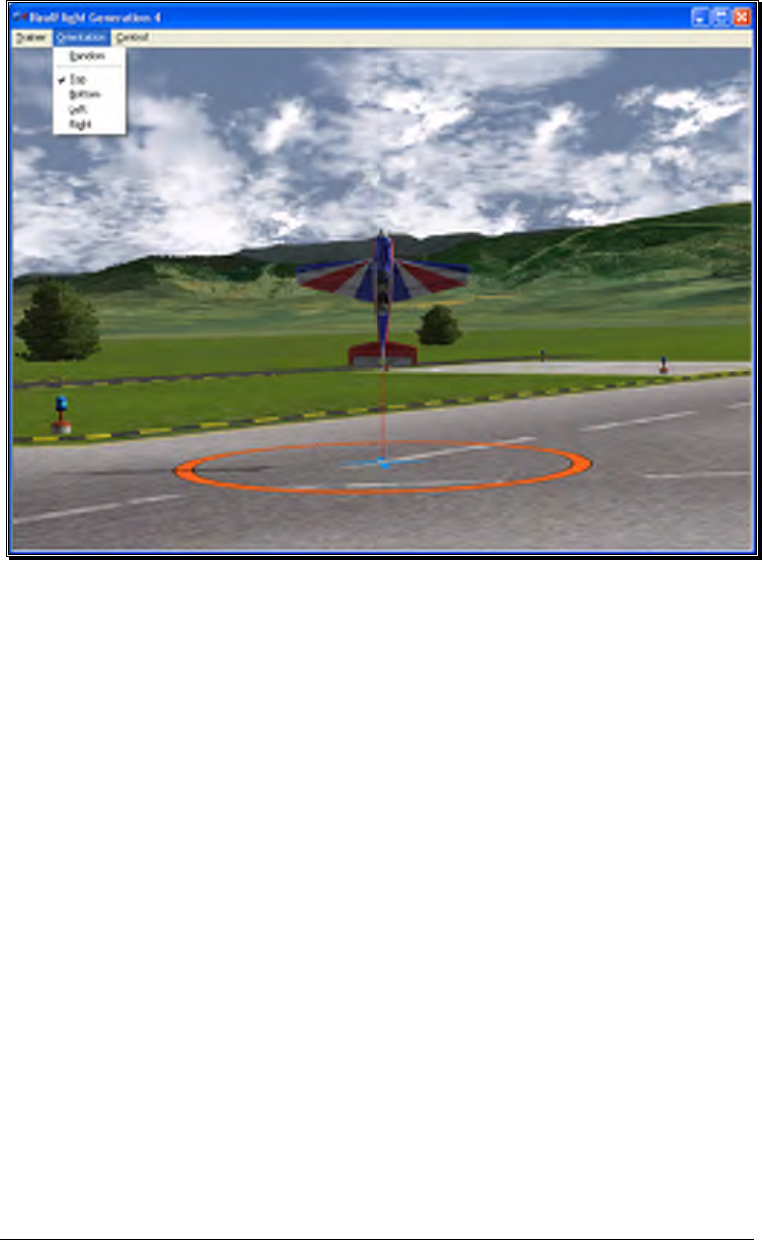
220
A checkmark will appear next to the currently selected orientation. The options
available are:
• Random – The airplane will start in a random position, with either the top, bottom,
left side or right side facing you.
• Top – The airplane will start with the top of the aircraft facing you.
• Bottom – The airplane will start with the bottom of the aircraft facing you.
• Left – The airplane will start with the left side of the aircraft facing you.
• Right – The airplane will start with the right side of the aircraft facing you.
Control Menu-
The Control menu allows you to select which channel or channels to control. The
remaining channels are controlled by RealFlight, allowing you to learn just the controls
you wish, and adding more as you become more comfortable and confident.
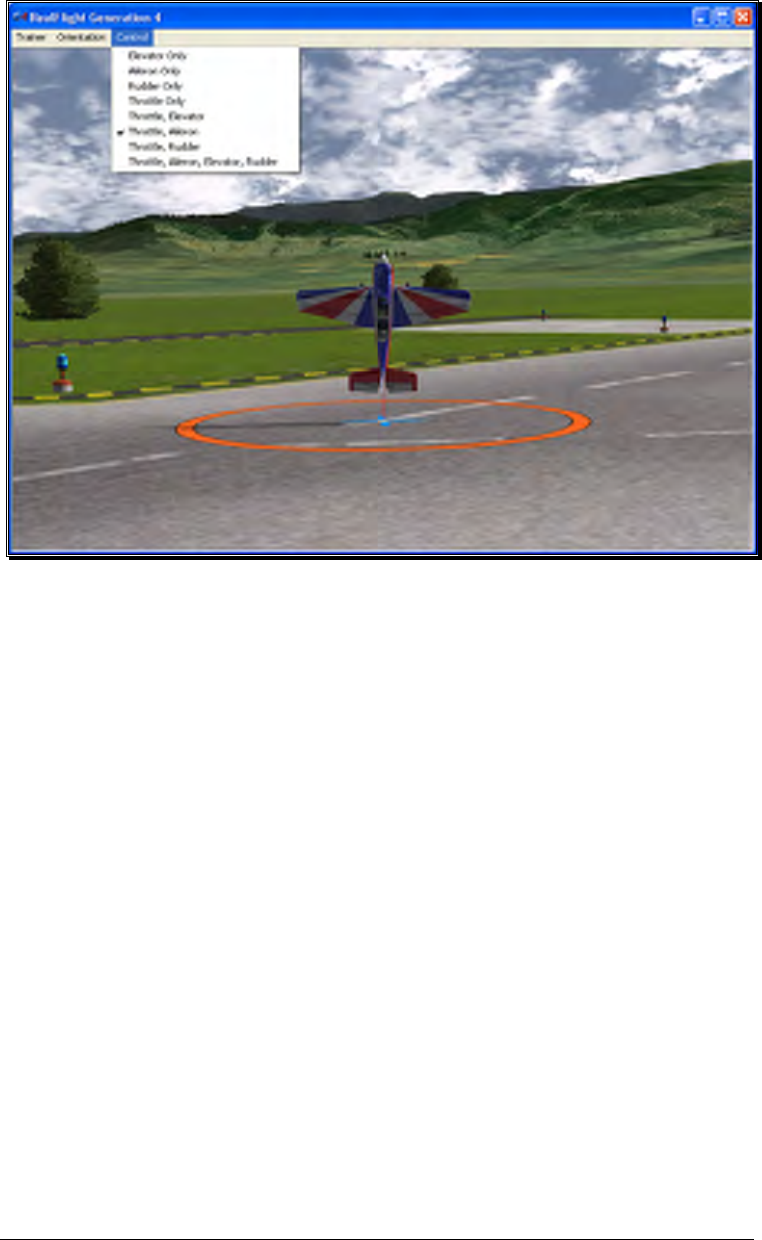
221
A checkmark will appear in the menu next to the currently selected item. Your options
are:
• Elevator Only – Check this to control only the elevator of the aircraft. RealFlight
will control the throttle, ailerons, and rudder for you.
• Aileron Only – Check this to control only the ailerons of the aircraft. RealFlight
will control the throttle, elevator, and rudder for you.
• Rudder Only – Check this to control only the rudder of the aircraft. RealFlight will
control the throttle, ailerons, and elevator for you.
• Throttle Only – Check this to control only the throttle of the aircraft. RealFlight
will control the elevator, ailerons, and rudder for you.
• Throttle, Elevator – Check this to control the throttle and elevator of the aircraft.
RealFlight will control the ailerons and rudder for you.
• Throttle, Aileron – Check this to control the throttle and ailerons of the aircraft.
RealFlight will control the elevator and rudder for you.
• Throttle, Rudder – Check this to control the throttle and rudder of the aircraft.
RealFlight will control the elevator and ailerons for you.
• Throttle, Aileron, Elevator, Rudder – Check this to control all four channels. You
will not receive any assistance from RealFlight.
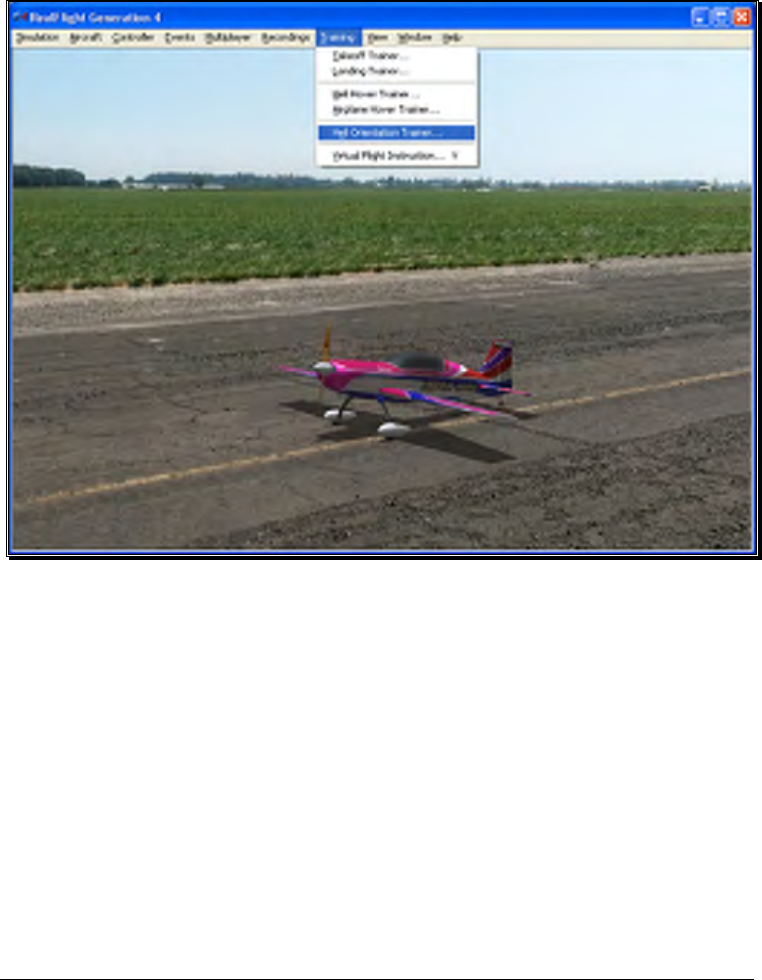
222
Heli Orientation Trainer
As you become more proficient with hovering a helicopter, you can test your skills
with the Heli Orientation Trainer. The Heli Orientation Trainer challenges you to
keep your helicopter in the same location as the trainer helicopter. As you succeed in
doing so, the trainer helicopter will move, and the level of difficulty will increase.
To start the trainer, select Heli Orientation Trainer menu item from the Training
menu.
The Heli Orientation Trainer has a number of different levels, each with an increasing
level of difficulty than the previous. To pass a level you must hover your helicopter in
close proximity to the trainer helicopter. As you do so, the trainer helicopter will turn
from blue to red, and the progress bar at the top of the screen will increase, indicating
that your task is nearly complete.
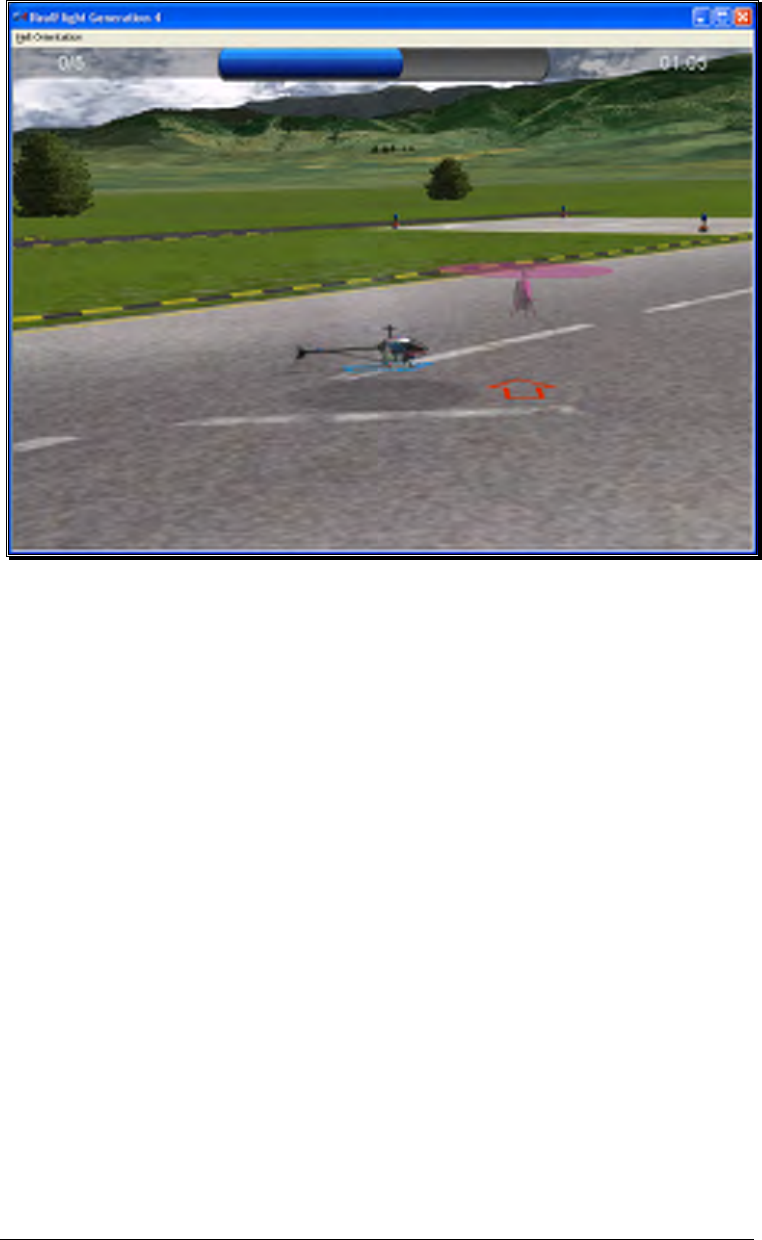
223
In the upper right corner, a countdown timer is visible. This is the amount of time you
have to fill the progress bar and complete the task. If you fail to do so, both the timer,
and the progress bar will reset to zero. You must begin once again.
The number displayed in the upper left corner indicates the number of locations the
trainer helicopter will stop for the current level. It will also indicate how many of these
locations you have completed. For example, if it displays 1/3, you have successfully
completed one spot out of three for the current level.
As you advance to the next level, you may be responsible for controlling more
channels, the allotted time might also decrease and the trainer heli will stop in more
locations. Additionally, you might experience any combination of these circumstances
to increase the difficulty.
Heli Orientation Menu-
The Heli Orientation menu is the only menu accessible while the trainer is running.
Two options are available in the Heli Orientation menu:
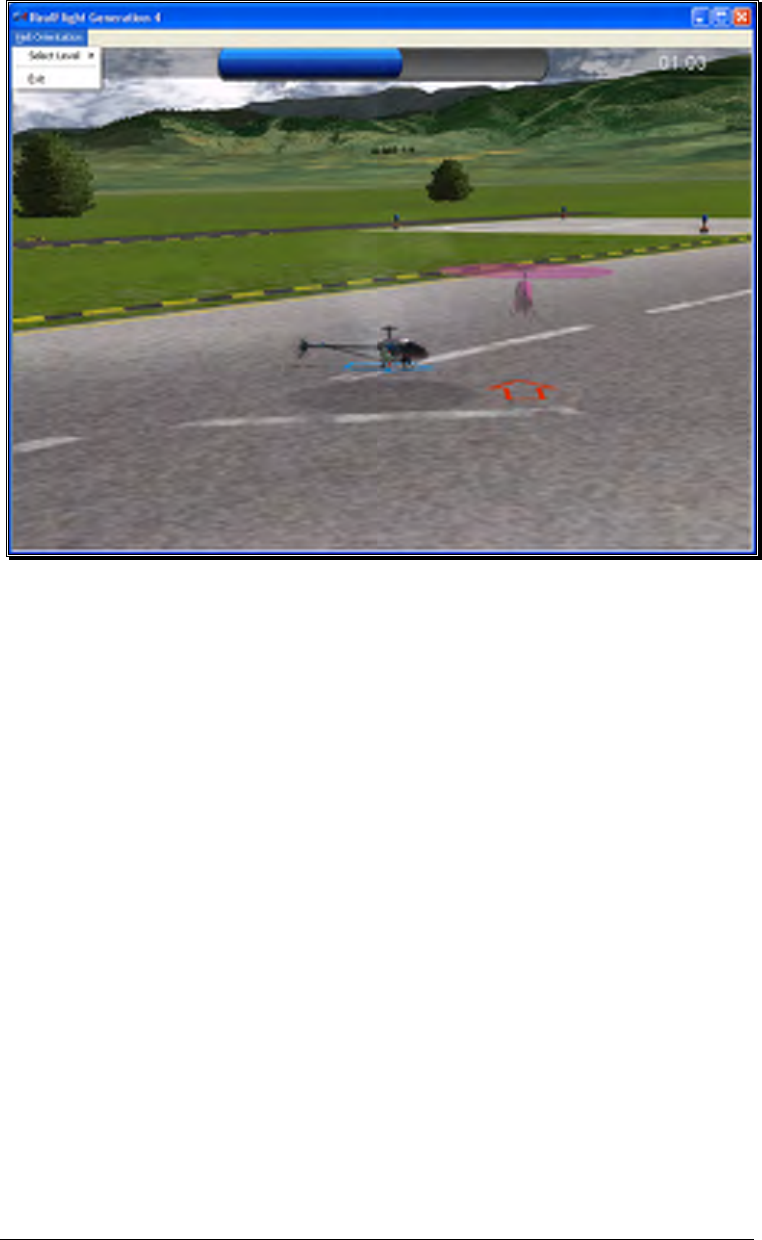
224
Select Level-
A drop-down menu will display the levels available to you. For example, if you
have only progressed to Level 2, you will not be able to access Level 3 or
higher in this menu.
A checkmark will appear next to the level you are currently flying.
Exit-
To return to the simulator, select Exit to leave the Heli Orientation Trainer.
Virtual Flight Instruction
RealFlight Generation 4 includes on-screen flight training from some of R/C’s best
pilots. John Glezellis, Frank Noll Jr., Jason Shulman, Pete Niotis, Todd Bennett, Brian
Bremer and Jim Bourke are your instructors taking you through a variety of skill levels
of R/C. There are basics for beginners as well as more advanced maneuvers for
intermediate pilots. G4 also includes instructions on how to perform some of today’s
hottest 3D flight maneuvers! G4 includes voice instruction as well as an on-screen
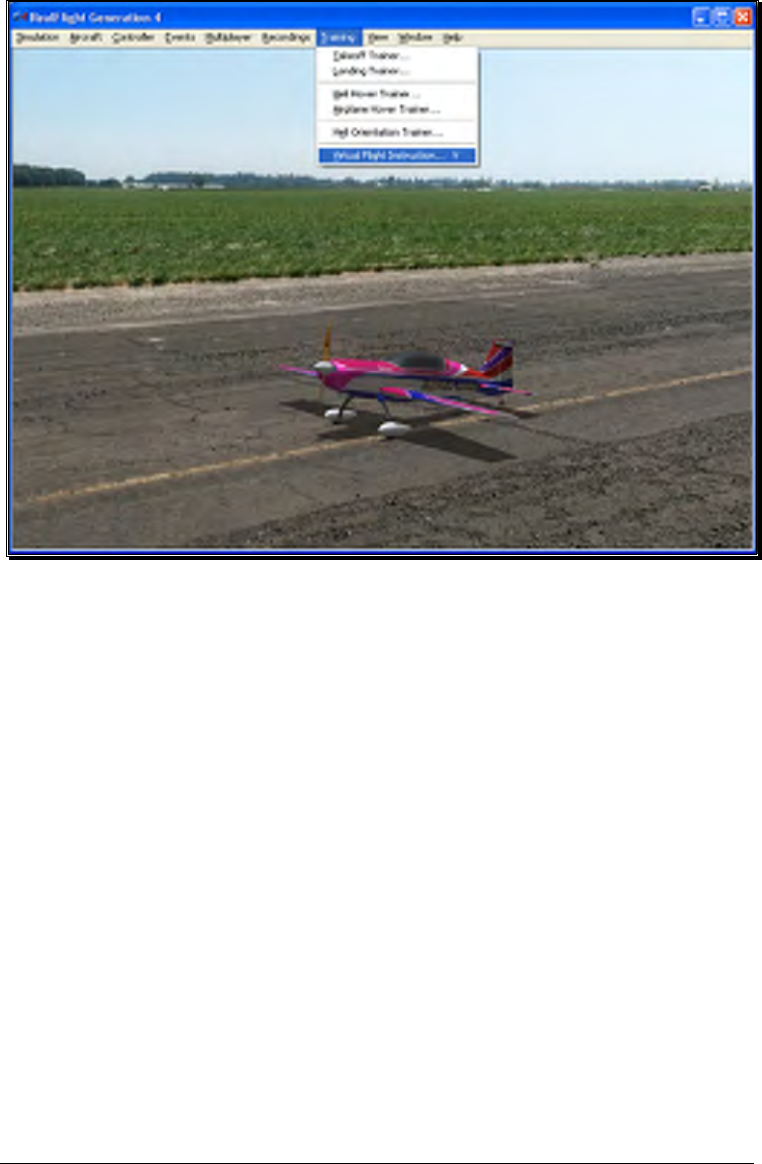
225
radio that shows the exact movements that the instructor is using. VFI is the perfect
training tool for pilots of all skill levels.
To access the VFI menu item, click the Training menu followed by the Virtual
Flight Instruction… menu item. Alternatively, you may also access the VFI by
pressing the ‘V’ key on the keyboard. Determine whether you wish to participate in a
helicopter or airplane training session. Open the respective genre by clicking the [+]
(plus) or double-clicking the listing. Next, select the pilot you wish to view. To select
and begin your training, either double-click the respective maneuver or highlight the
maneuver and click OK.
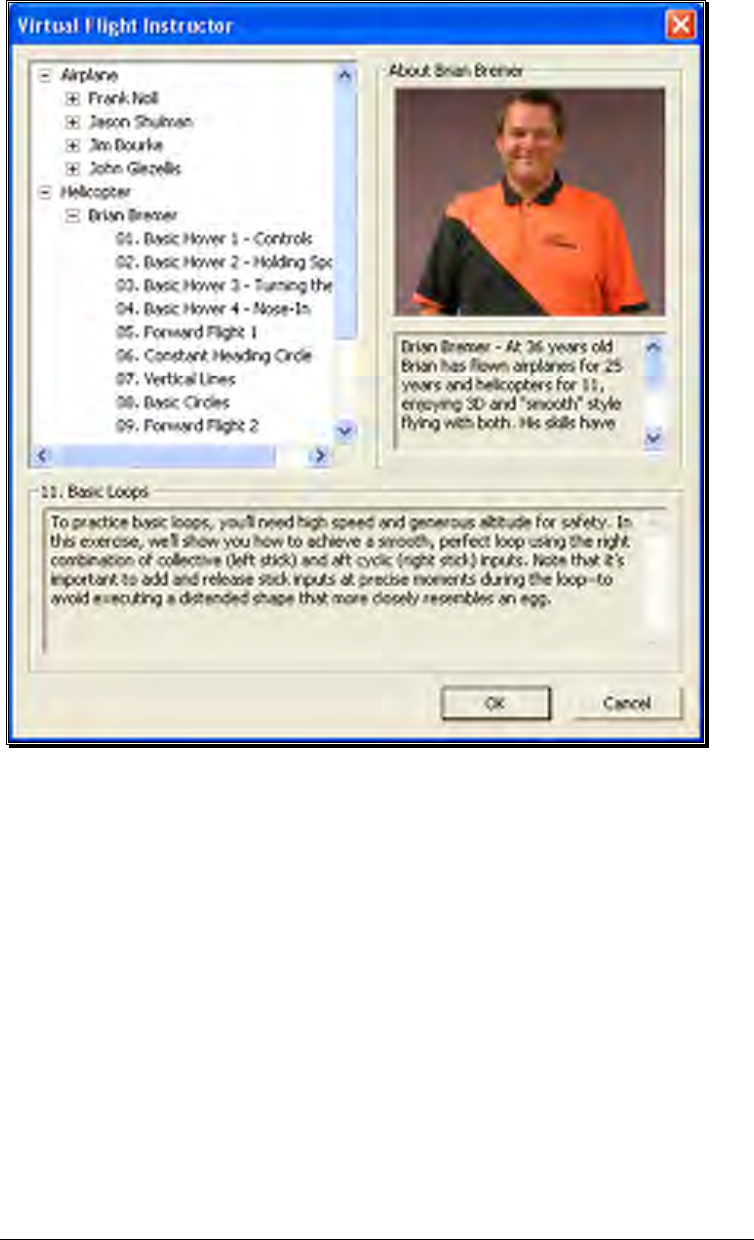
226
By default, G4’s radio gadget appears on-screen. This digital transmitter is a visual
guide to display the stick inputs, in real-time, utilized for the recordings. For additional
information, please refer to the Radio- section on page 245.
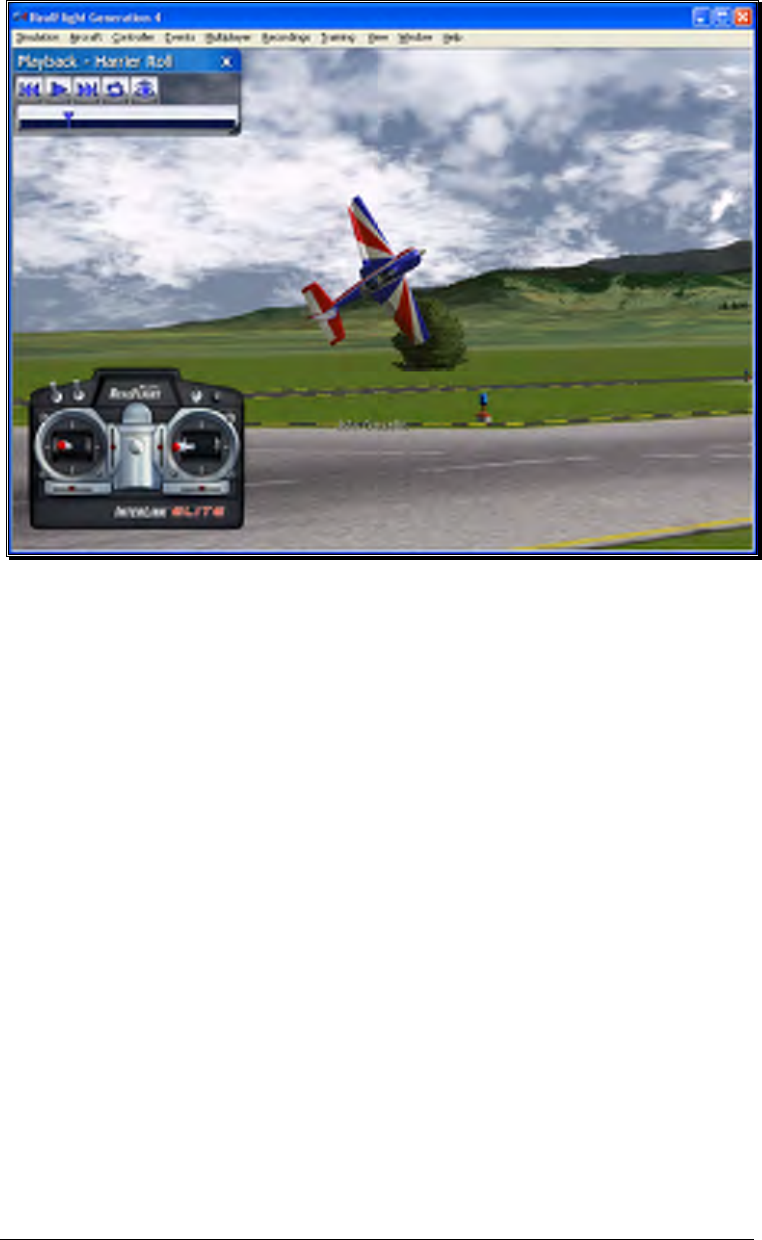
227
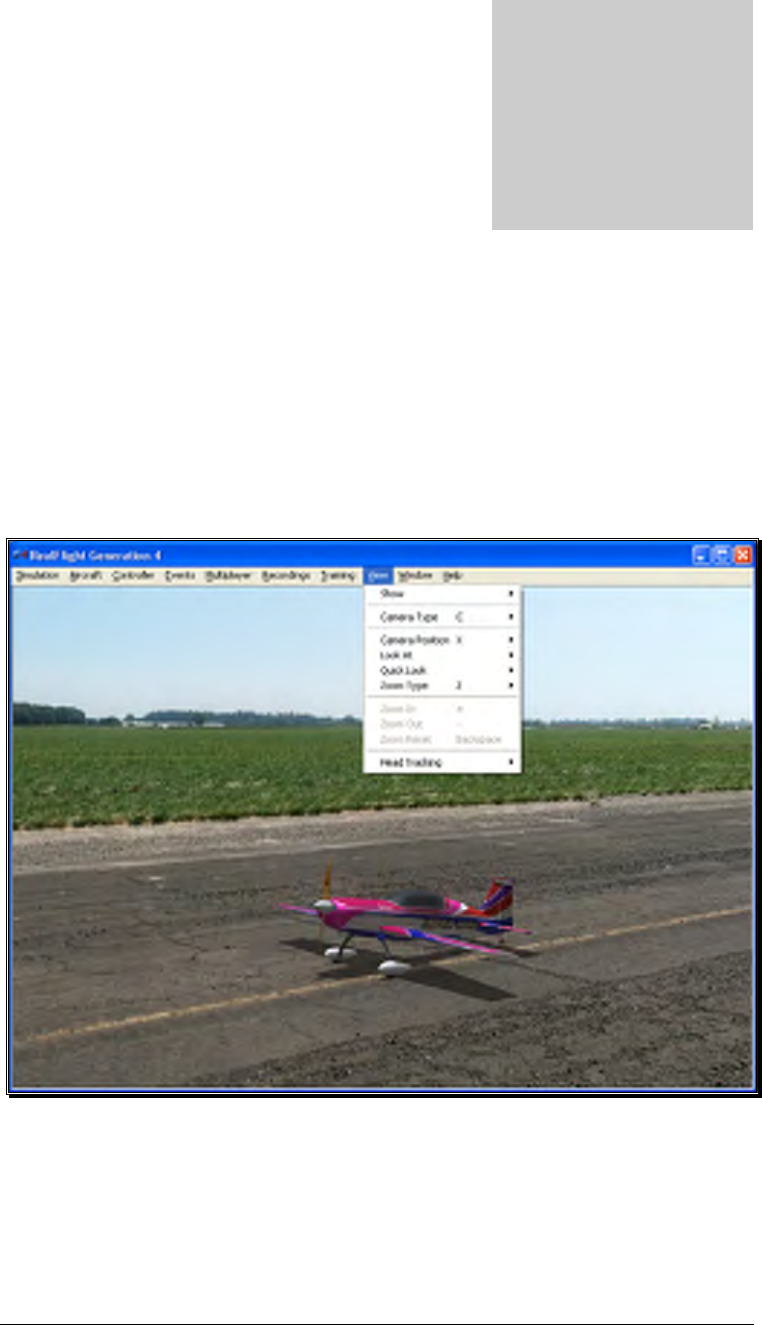
229
View Menu
Adjust your vantage point, change your perspective and more.
his menu allows you to adjust the various view-related features and functions
for the simulation. The View menu adjusts what you are looking at as well as
where you are looking from.
• Show
• Camera Type
• Camera Position
Chapte
r
12
T
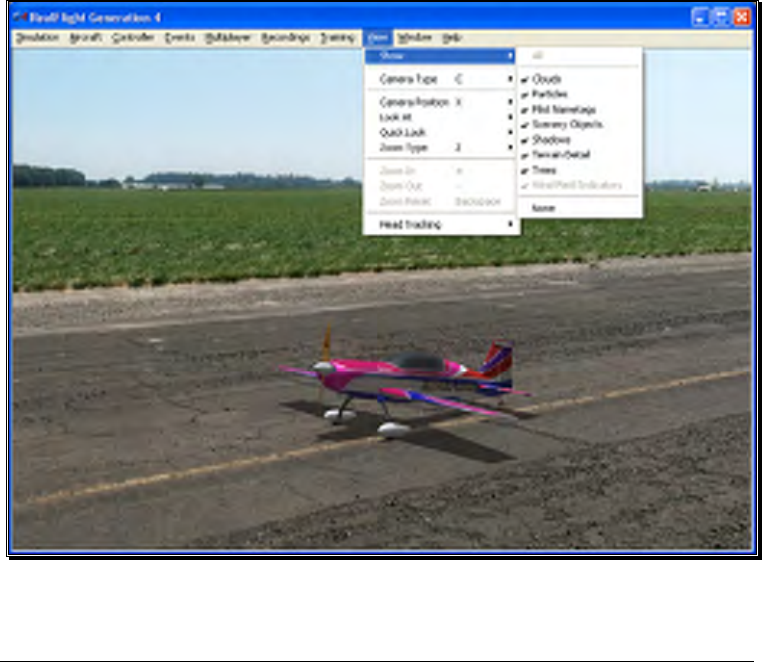
230
• Look at
• Quick Look
• Zoom Type
• Zoom In
• Zoom Out
• Zoom Reset
• Head Tracking
Show
The Show menu item is used to determine whether to show or hide scenery objects in
the airport.
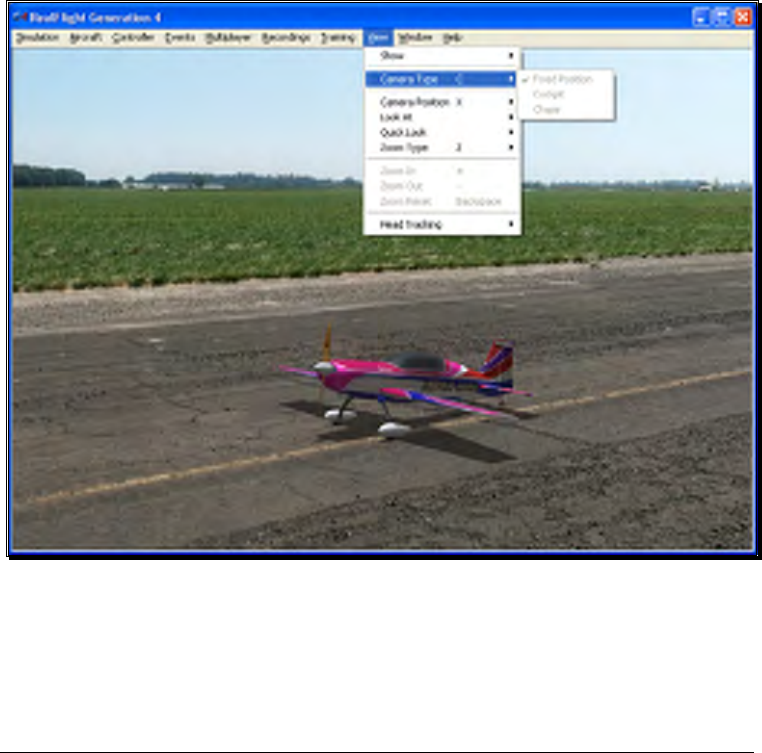
231
Selecting this item brings forth a pull-down menu with a list of items you can show
(make visible within the simulation) or hide (remove from visibility). To show items,
check them in the drop-down menu. To hide items, click on them to remove their
respective checkmark.
If the frame rate slows dramatically, try eliminating some of the items listed in the
Show menu title. This will improve the frame rate.
To access this menu item, click on the View menu followed by the Show menu item.
Camera Type
The Camera Type menu item determines the Camera Type for the active viewport.
Each viewport is independently adjustable. Select from a Fixed Position, Cockpit or a
Chase view.
If more than one viewport is open, click on the viewport that you wish to modify.
This becomes the active view in the simulation. To access the Camera Type
adjustments, click on the View menu followed by the Camera Type menu item.
Select your preferred view from the pull-down list.

232
Alternatively, you may press the keyboard’s ‘C’ key to toggle through the available
Camera Type options.
Please note: some airports do not allow Camera Type adjustments.
Fixed Position-
In this mode, the camera remains in a fixed, stationary position. The position is
determined by the Camera Position setting.
Cockpit-
The Cockpit selection places the camera inside the aircraft as if you were a full-scale
pilot.
To magnify the view or zoom in on the selected item, press the [+] (plus) key on the
keyboard. Each time you press the [+] (plus) key or select the Zoom In menu item,
the zoom level increases incrementally. Alternatively, you may select the Zoom In
option from the View menu.
To decrease the magnification, or zoom away from the selected item, press the [-]
(minus) key on the keyboard. Each time you press the [-] (minus) key or select the
Zoom Out menu item, the zoom level decreases incrementally. Alternatively, you may
select the Zoom Out option from the View menu.
Chase-
The Chase mode positions the camera behind the aircraft. The camera will follow the
aircraft as it moves.
To magnify the view or zoom in on the selected item, press the [+] (plus) key on the
keyboard. Each time you press the [+] (plus) key or select the Zoom In menu item,
the zoom level increases incrementally. Alternatively, you may select the Zoom In
option from the View menu.
To decrease the magnification, or zoom away from the selected item, press the [-]
(minus) key on the keyboard. Each time you press the [-] (minus) key or select the
Zoom Out menu item, the zoom level decreases incrementally. Alternatively, you may
select the Zoom Out option from the View menu.
Camera Position
This menu item determines where the camera will be situated. Depending upon the
airport selected, there may be one or more Pilot Spawn locations to use as camera
positions.
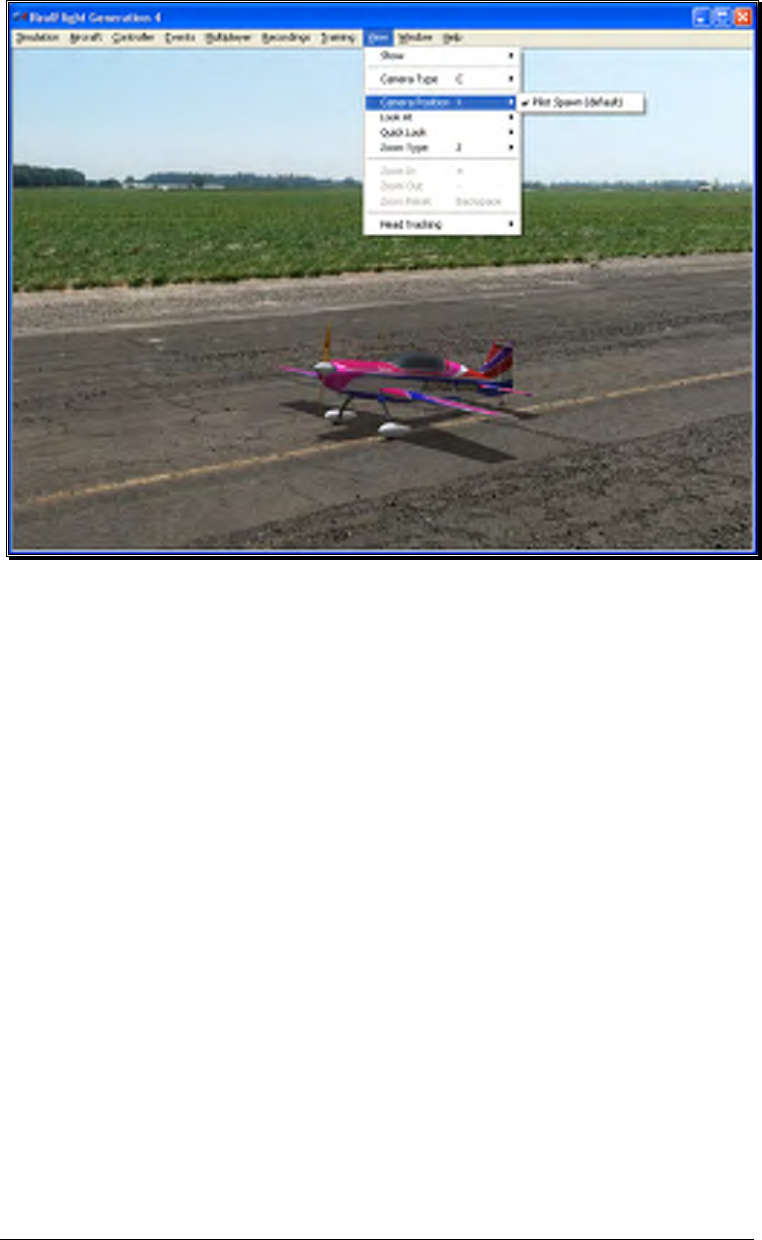
233
RealFlight G4 automatically picks the Pilot Spawn location that is closest to where the
aircraft lands (or crashes, as the case may be).
To change the setting, click on the viewport to you wish to modify. This becomes the
active view in the simulation. To access the Camera Position adjustments, click on the
View menu followed by the Camera Position menu item. Select your preferred view
from the drop-down list.
You may also press the keyboard’s ‘X’ key to toggle through the available Camera
Position options. If the airport has two pilot spawn locations, for example, pressing
the ‘X’ key will toggle back and forth between these two locations.
Look At
This menu item changes what the camera looks at. Usually you will want the camera to
remain focused on your aircraft.
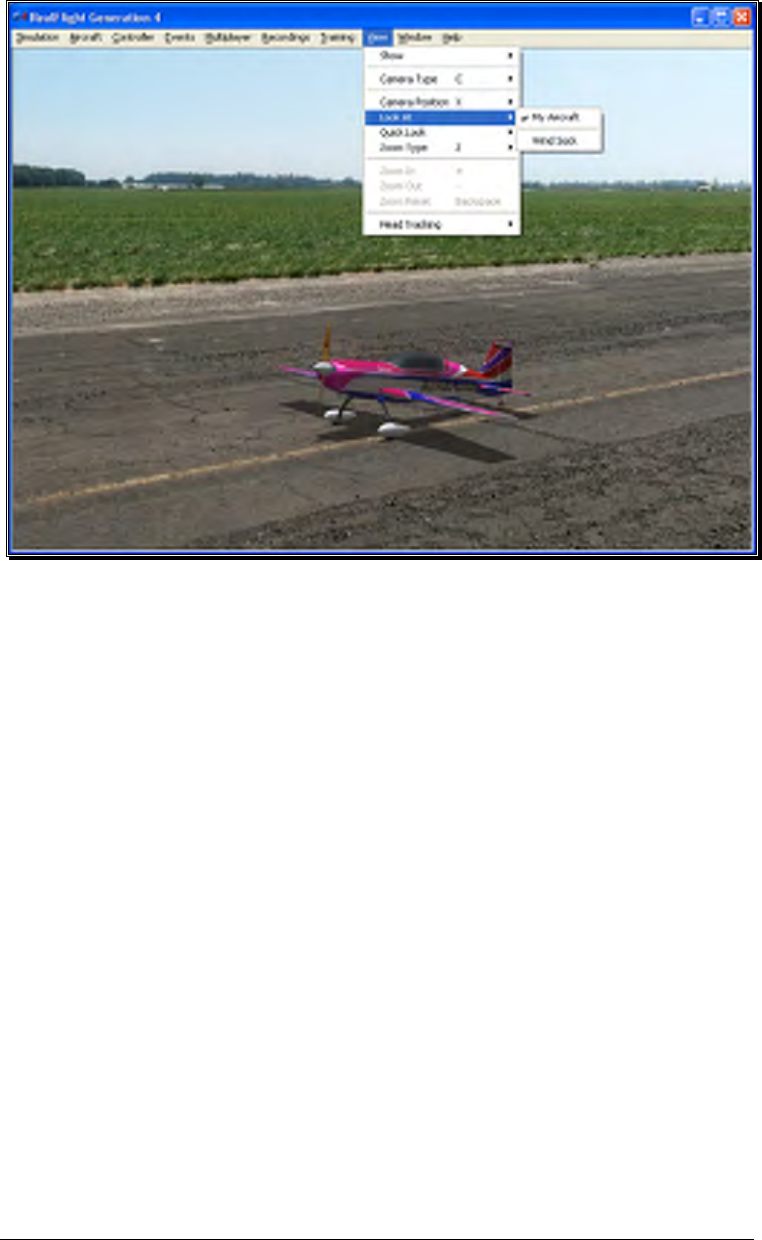
234
Click on the viewport that you wish to modify. This becomes the active view in the
simulation. To access the list of things to look at, click on the View menu followed by
the Look At menu item. Then select an item to look at. For example, if you are in a
multiplayer or MultiMode session, the other players in the session will be listed in the
popup menu. Select a player to look at his/her aircraft.
Quick Look
This feature allows you to quickly glance at an object. When you activate this option,
the camera briefly looks at the selected item and then returns to the previous vantage
point for the active viewport.
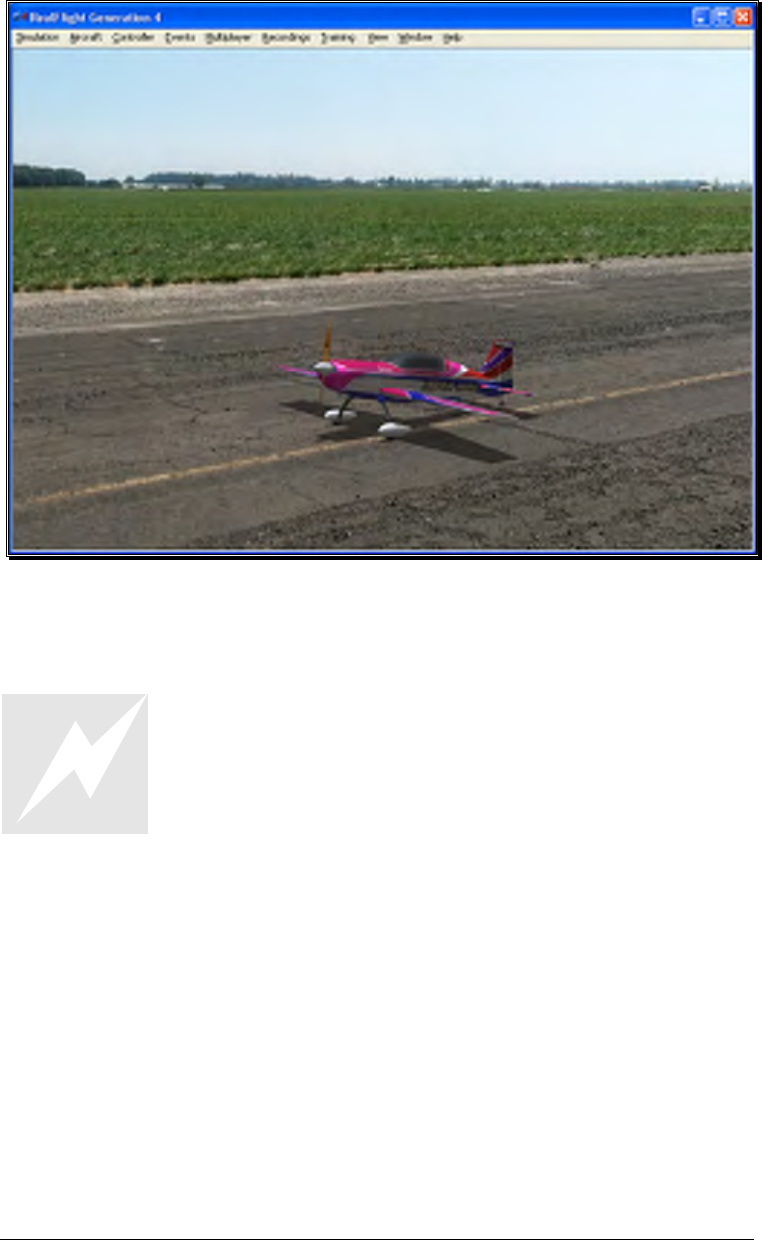
235
Click on the viewport that you wish to modify. This becomes the active view in the
simulation. To access the Quick Look menu item, click on the View menu followed
by the Quick Look menu item.
Using the InterLink Elite controller, you can also active the Quick
Look options with the QuickSelect buttons. By pressing up on the
Data Lever, RealFlight will briefly change the camera to look at the
Wind Sock. Pressing down will briefly bring the Ground into view.
Alternatively, after you have activated the correct viewport, you can press a key on your
keyboard to activate the Quick Look feature. The up arrow will look at the windsock,
and the down arrow will look at the ground.
Zoom Type
The Zoom Type menu item allows you to change the type of zoom used in the
simulation.
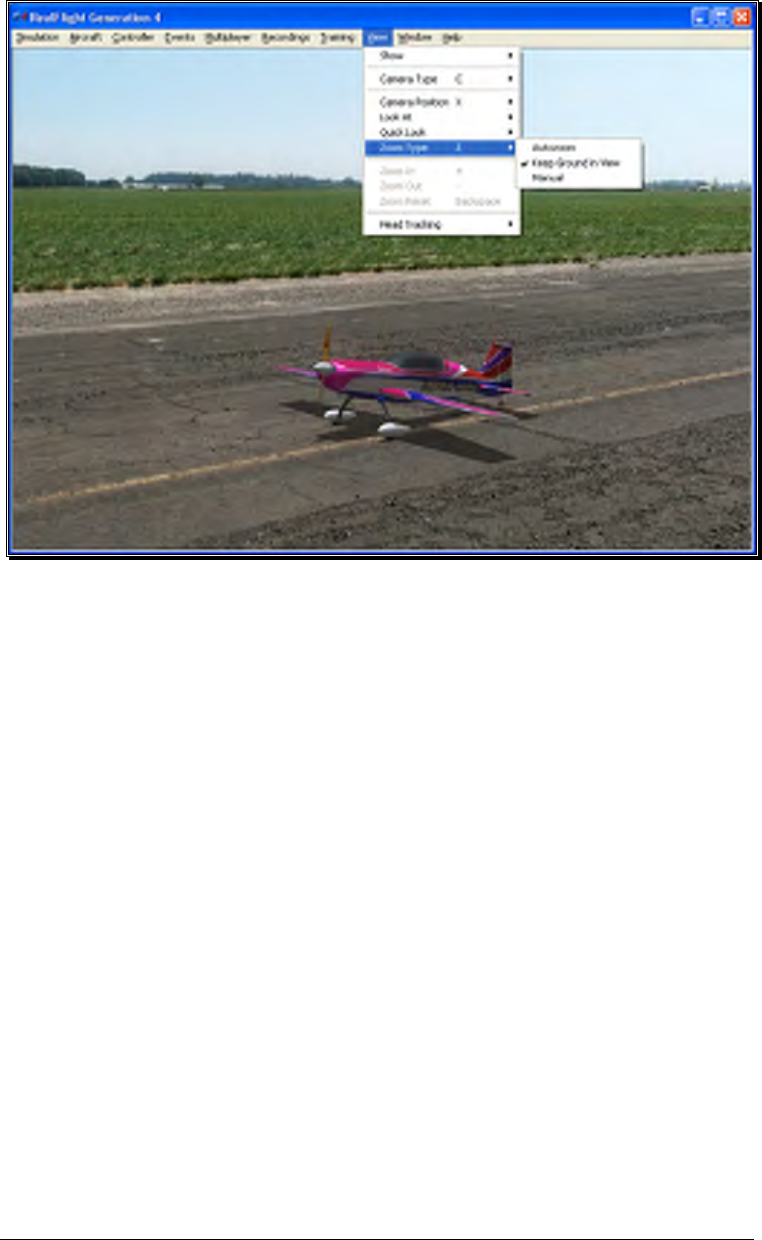
236
Click on the viewport that you wish to modify. This becomes the active view in the
simulation. To access the Zoom Type menu item, click on the View menu followed
by the Zoom Type menu item. Select the Zoom Type option that accomplishes your
goal. You may choose between Manual, Autozoom, and Keep Ground in View.
Alternatively, after you have activated the correct viewport, press the keyboard’s ‘Z’ key.
Each time you press the ‘Z’ key you will toggle to the next Zoom Type.
Autozoom-
This zoom type adjusts the zoom range based on the distance of the aircraft from the
pilot. The camera automatically zooms in as the aircraft gets further from the pilot and
then automatically zooms out as the aircraft gets closer to the pilot.
Keep Ground in View-
This zoom type adjusts the camera so that the aircraft and the ground are always in
view. This is the only zoom type that disallows zooming in and out.
Manual-
This enables the standard view with zoom capabilities. See the Zoom In and Zoom Out
sections below for more information.
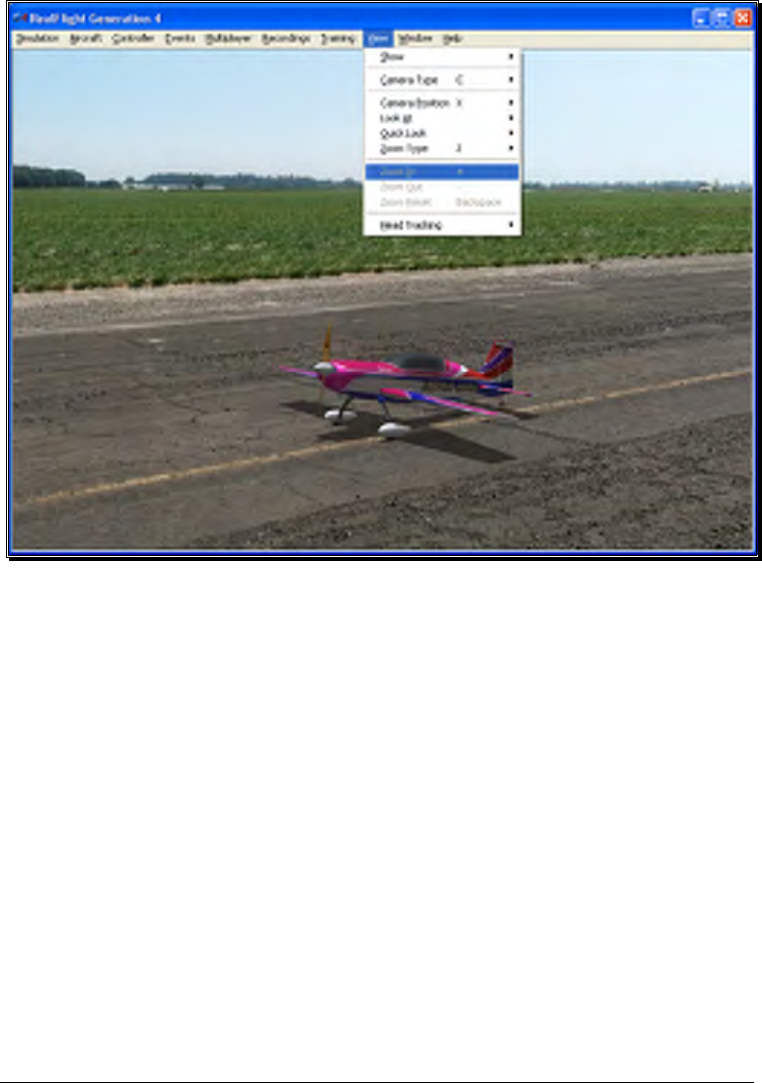
237
Zoom In
Once you have selected the type of zoom that you desire, RealFlight allows you to
customize it further by zooming in.
Click on the viewport that you wish to modify. This becomes the active view in the
simulation. To access the Zoom In menu item, click on the View menu followed by
the Zoom In menu item.
Alternatively, after you have activated the correct viewport, press the [+] (plus) key on
your keyboard. Each time you press the [+] (plus) key you will zoom in incrementally.
Zoom Out
Once you have selected the type of zoom that you want you can customize it further
by zooming out. Zooming Out decreases the magnification.
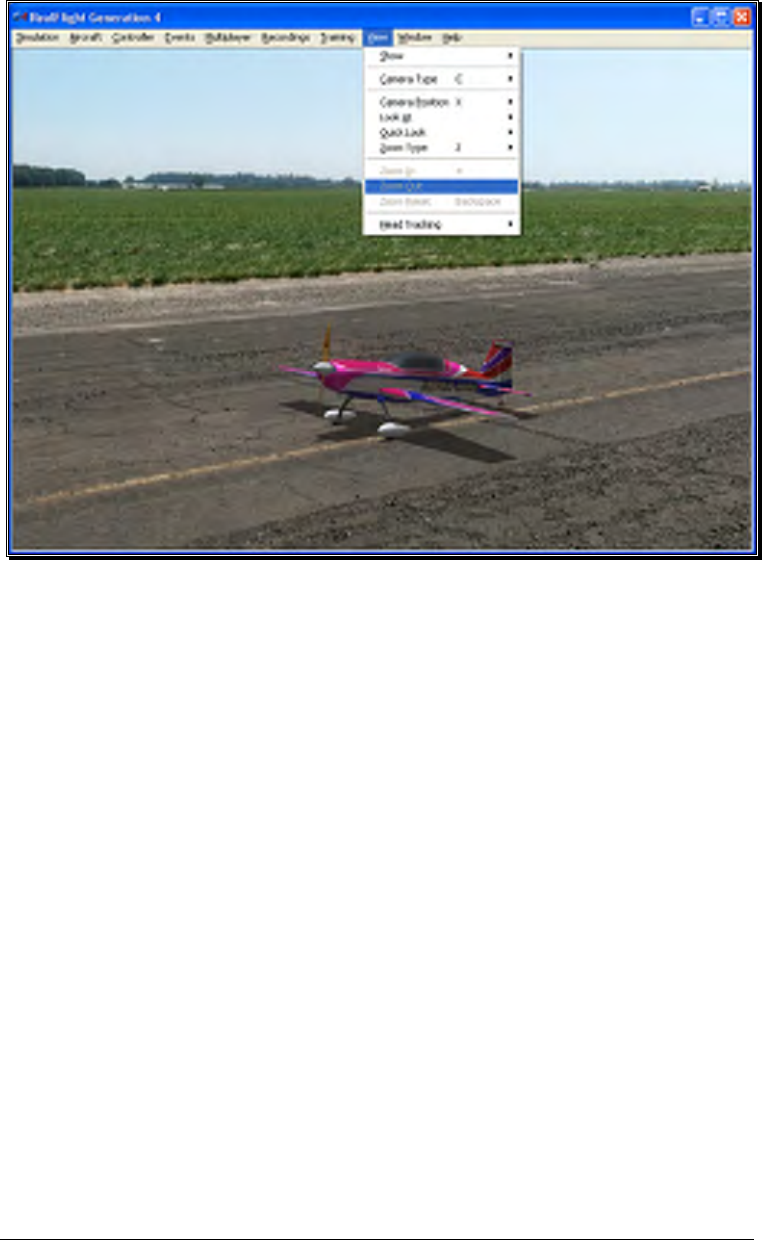
238
Click on the viewport that you wish to modify. This becomes the active view in the
simulation. To access the Zoom Out menu item, click on the View menu followed by
the Zoom Out menu item.
After you have activated the correct viewport, you may also press the [-] (minus) key
on your keyboard. Each time you press the [-] (minus) key you will zoom out
incrementally.
Zoom Reset
This selection resets the zoom magnification level to its default value. This is useful if
you are zoomed way in or way out and want to return quickly to the default level of
magnification.
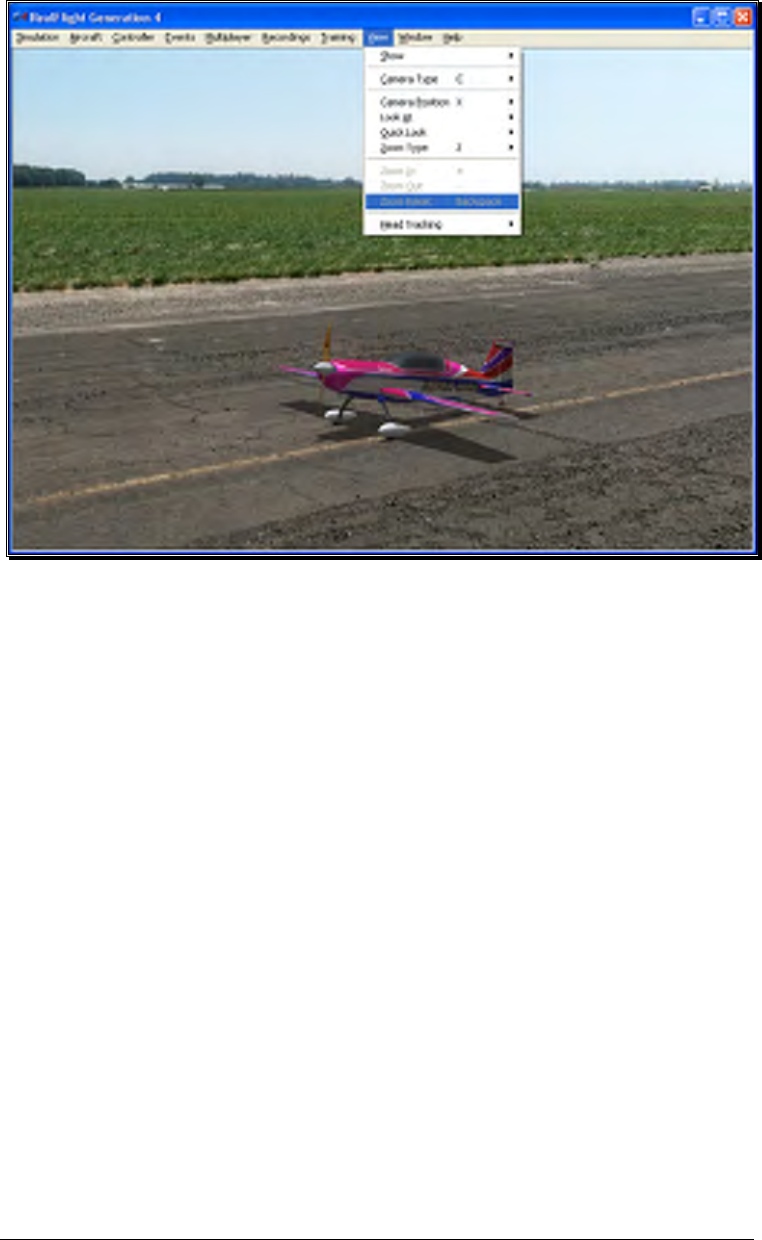
239
Click on the viewport that you wish to modify. This becomes the active view in the
simulation. To access the Zoom Reset menu item, click on the View menu followed
by the Zoom Reset menu item.
Once you have activated the correct viewport, you may also press the Backspace key
on your keyboard to reset the zoom level.
Head Tracking
RealFlight G4 is compatible with TrackIR from NaturalPoint. With a TrackIR plugged
into your computer, you can control the camera with the movement of your head as if
you are at the field looking around.
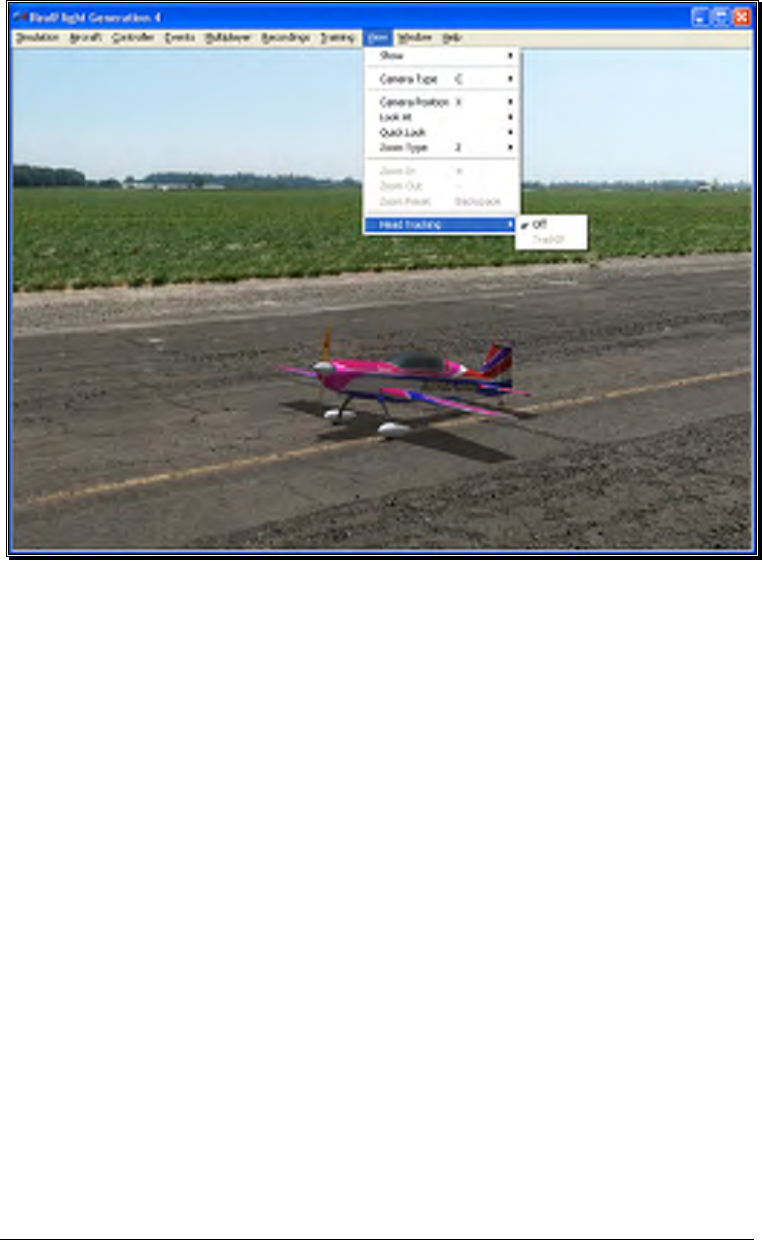
240
For example, if you are flying at a high altitude and wish to line up with the runway, at
a flying field you would look down briefly. With the TrackIR, you would do the same
at your computer. With a small movement of your head, you can look down at the
runway and back up to your aircraft.
For more information about TrackIR, and where to purchase one, visit NaturalPoint’s
website at:
http://www.naturalpoint.com/trackir/
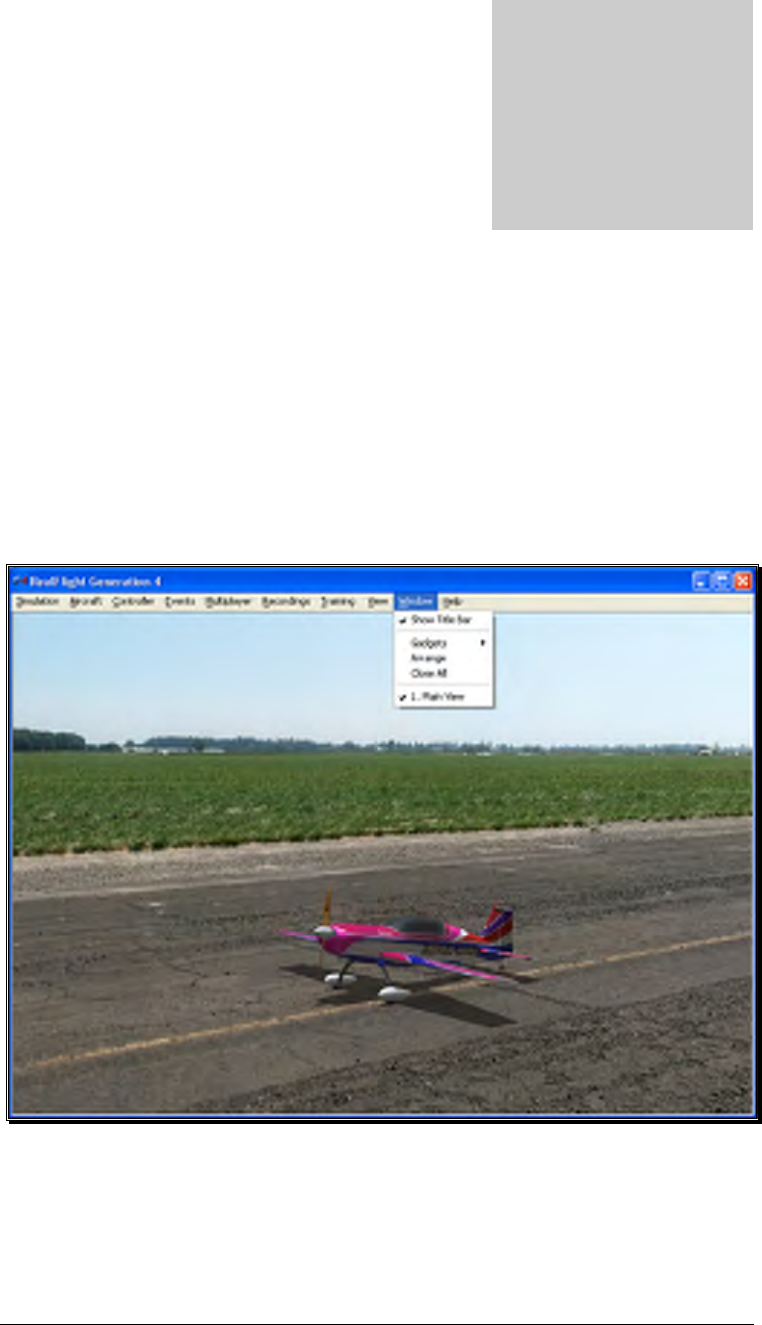
241
Window Menu
Tools to add more excitement to your RealFlight enjoyment.
he Window menu allows you to manage the existing windows or viewports, to
create new ones, and to select from recently used Windows. The Window
menu also gives you access to a variety of on-screen gadgets that offer real-
time information about your current flight.
The Window menu offers the following options:
• Show Title Bar
Chapte
r
13
T
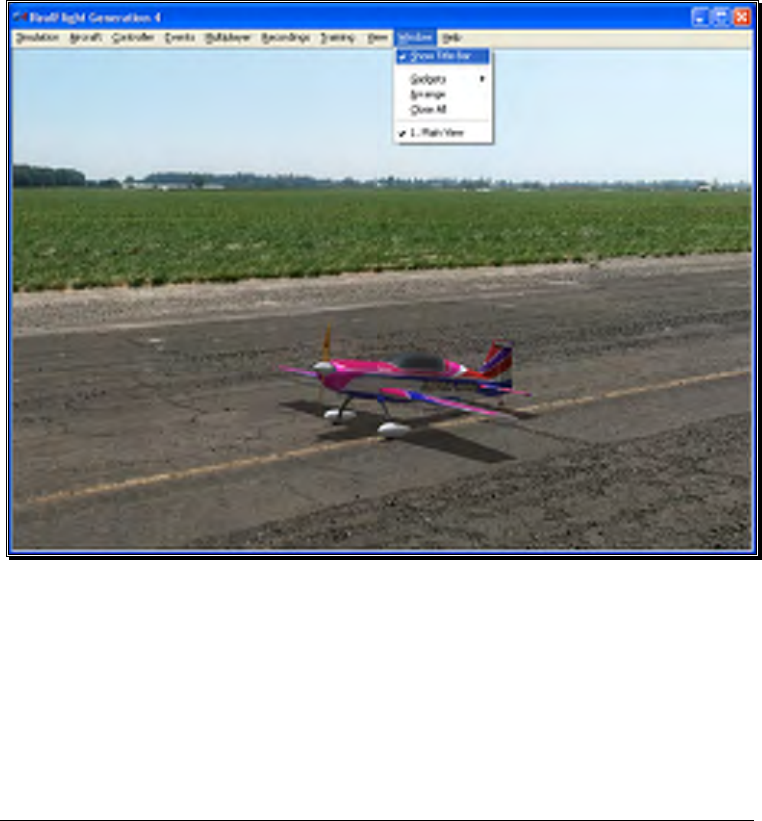
242
• Gadgets
• Arrange
• Close All
• Window list
Show Title Bar
This menu item determines whether or not the G4 title bar is displayed on the screen.
By default, the title bar is enabled.
To access this menu item, click on the Window menu followed by the Show Title
Bar. This will remove the RealFlight Generation 4 title bar from the screen. Please
note: removing the title bar also eliminates the ability to minimize or maximize the
screen.
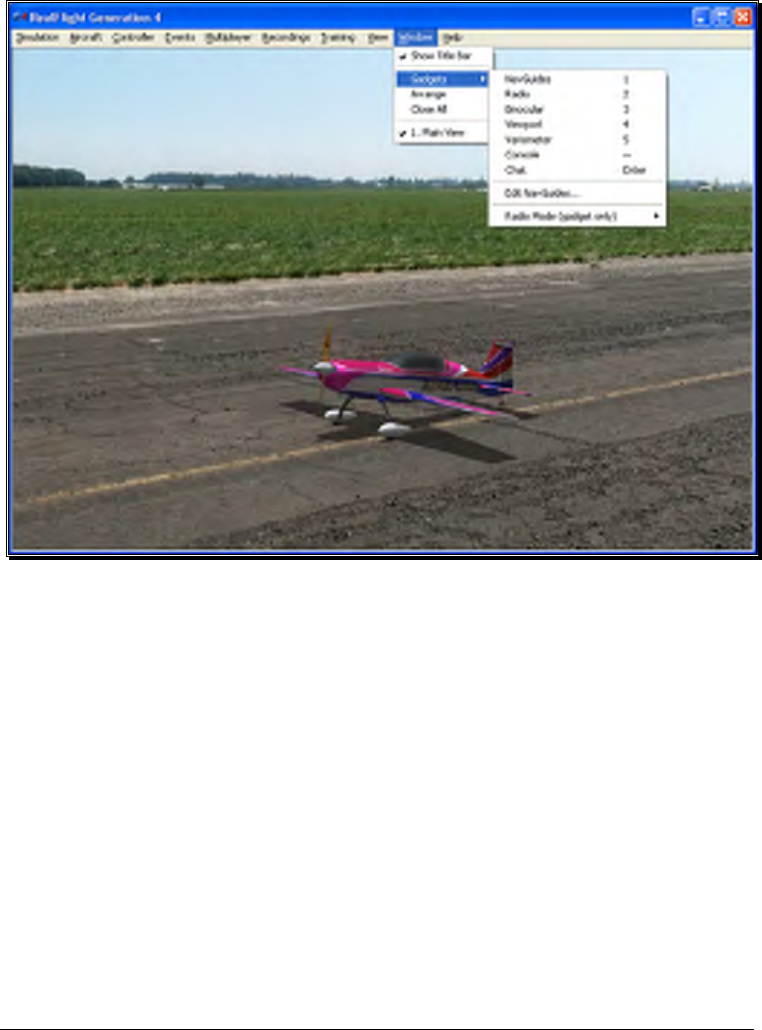
243
Gadgets
A Gadget is an on-screen display that provides you with information pertaining to a
certain item in your simulation. To access the Gadgets menu item, click the Window
menu followed by the Gadgets menu item. This will open the list of gadgets for the
simulation.
Selecting this menu item will bring up the Gadgets list as follows:
• NavGuides
• Radio
• Binocular
• Viewport
• Variometer
• Console
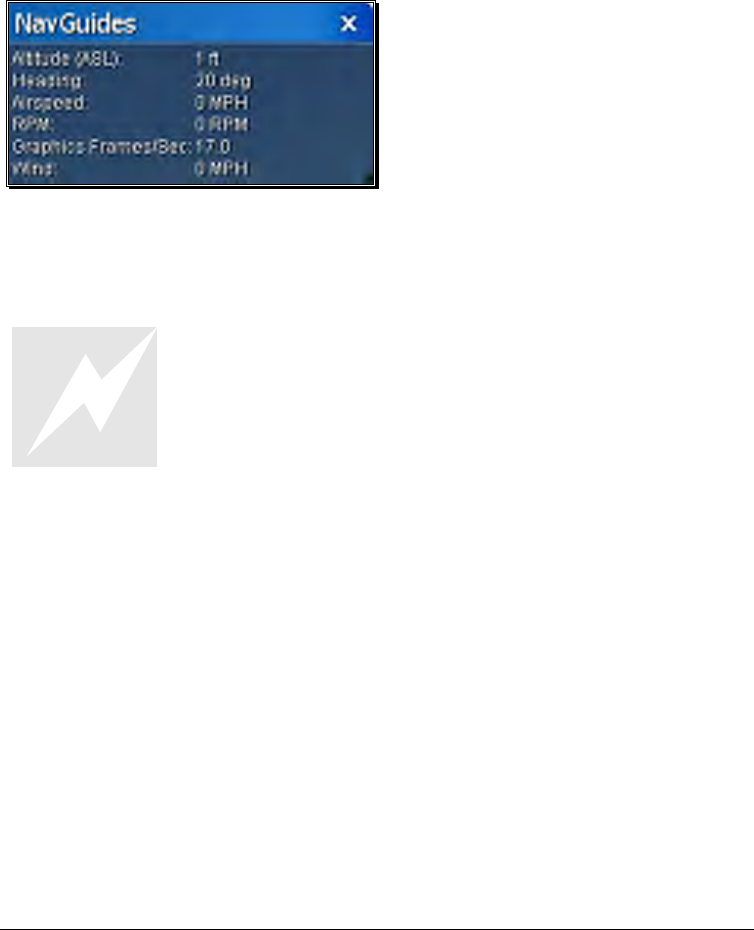
244
• Chat
• Edit NavGuides
• Radio Mode (gadget only)
NavGuides-
A NavGuide is an on-screen display that allows you to view some basic information
pertaining to your aircraft. If you wish to alter the contents of the NavGuide, please
refer to the Edit NavGuides… section later in this chapter.
To access the NavGuides, click the Window menu title, followed by the Gadgets
menu item. Next, click the NavGuides menu item. You may also bring up the
NavGuides by pressing the keyboard’s ‘1’ key.
You may also load the NavGuides using the InterLink Elite with
the QuickSelect buttons. Press the Menu/Select button. Then
press down twice on the Data Lever until the NavGuides tab is
highlighted. It looks like an aircraft gauge. Press the Menu/Select
button again to activate the NavGuides. Repeat these steps to
remove the NavGuides from the screen.
When the NavGuides are active, an overlay screen will appear on your display. This
screen displays the NavGuides information to you.
If you do not wish to view this information, double-click on the title bar of the display
box. This hides the information. To view it once again, simply double-click the title
bar.
To resize the overlay, position the cursor over the arrow indication found in the lower
right corner of the frame. Click and hold on the arrow. Using the mouse, drag the
frame according to your wishes. If you drag it downward, the vertical size of the
viewport will increase. Dragging the frame to the right or left increases or decreases
the width of the viewport respectively.
Clicking on the ‘X’ in the title tab of the frame will remove it from the screen, entirely.

245
Items included by default in the NavGuides are the following:
Altitude (ASL)-
This option displays the altitude for the respective aircraft above sea level.
Even though the aircraft may be taxiing on the runway, the altitude may reflect
hundreds or thousands of feet, if applicable.
Heading-
This option displays the heading of the aircraft. The heading is displayed in
degrees, as they would appear on a compass. “0” degrees is North, “90”
degrees is East, “180” degrees is South and “270” degrees is West.
Airspeed-
This option displays the airspeed for the aircraft.
RPM-
This option indicates the current revolutions per minute, or RPM’s, for the
engine.
Graphics Frames/Sec-
This is an abbreviated version of Frames per Second, or FPS. While the data
displayed is not relevant to your aircraft, it is used to provide you with
feedback on how your computer is performing at any given time. The higher
the frames per second, the smoother the simulation will appear.
Wind-
This option displays the current wind speed at the flying site.
Radio-
The on-screen radio display is useful for many facets of flight. For example, when
used in conjunction with Virtual Flight Instruction, this allows you to see real-time
control input from the professionals. Observing the link between controller
movements and aircraft performance will advance your knowledge and understanding
of a maneuver.

246
To access the Radio, click the Window menu title, followed by the Gadgets menu
item. Next, click the Radio menu item.
You may also bring up the Radio by pressing the keyboard’s ‘2’ key.
You may also load the Radio using the InterLink Elite with the
QuickSelect buttons. Press the Menu/Select button. Then press
down three times on the Data Lever until the Radio tab is
highlighted. Press the Menu/Select button again to activate the
on-screen Radio. Repeat these steps to remove the Radio from the
screen.
If you click the on-screen radio, the entire viewport is displayed, including the title bar.
To resize the viewport, position the cursor over the lower right corner of the
viewport’s frame. Using the mouse, drag the frame according to your wishes. If you
drag it downward, the vertical size of the viewport will increase. Dragging the frame to
the right or left increases or decreases the width of the viewport respectively.
Clicking on the ‘X’ in the title tab of the frame removes it from the screen.
Binocular-
The Binocular option will show a perfectly zoomed aircraft, as if you were looking
through a pair of binoculars. The background of the viewport box becomes
transparent. This provides a visual indicator alerting you that you are using “binocular
vision.”
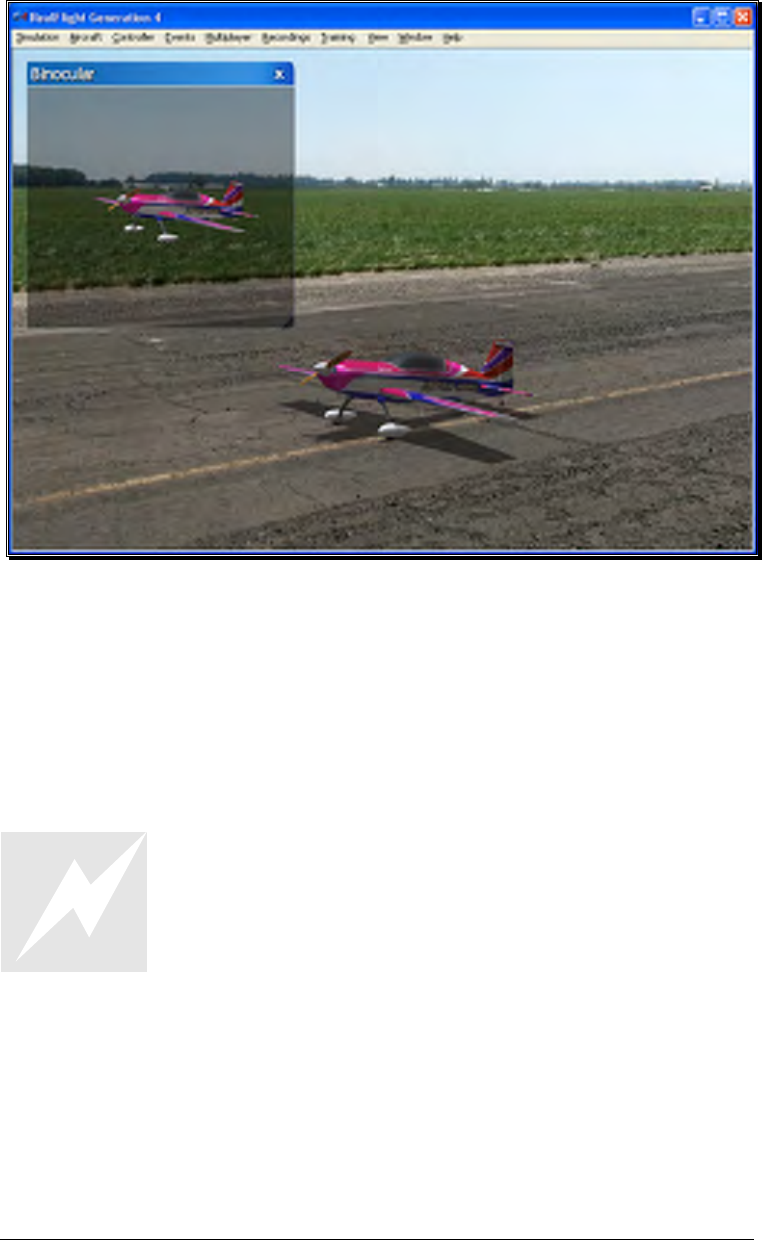
247
The Binocular option is a great way to see the control surfaces on an aircraft that is too
far away to see in the Main View. Although not realistic, it does help to see the control
input.
To access the Binocular menu item, click the Window menu title, followed by the
Gadgets menu item. Next, click Binocular.
You may also bring up the Binocular option by pressing the keyboard’s ‘3’ key.
You may also load the Binocular viewport using the InterLink Elite
with the QuickSelect buttons. Press the Menu/Select button.
Then press down four times on the Data Lever until the Binocular
tab is highlighted. Press the Menu/Select button again to activate
the Binocular viewport. Repeat these steps to remove the Binocular
viewport from the screen.
Clicking the Binocular viewport will display the title bar and frame. To resize the
viewport, position the cursor over the arrow indication found in the lower right corner
of the viewport’s frame. Click and hold on the arrow. Using the mouse, drag the
frame according to your wishes. If you drag it downward, the vertical size of the
viewport will increase. Dragging the frame to the right or left increases or decreases
the width of the viewport, as appropriate.
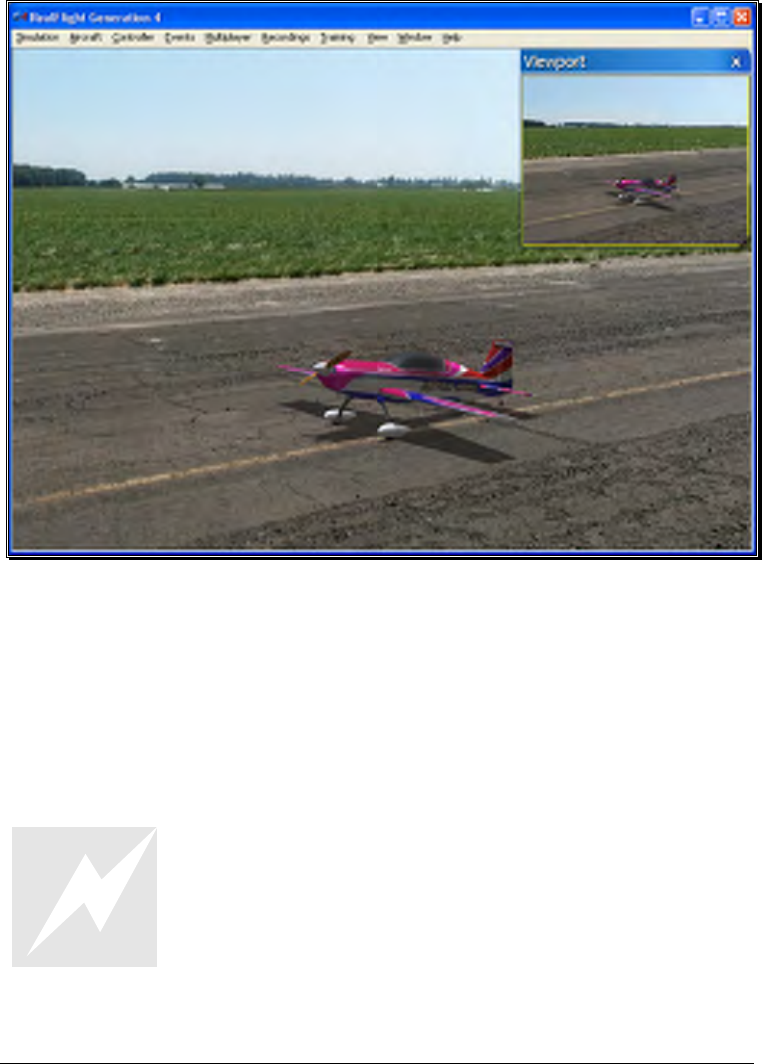
248
Clicking on the ‘X’ in the title tab of the frame removes the frame from the screen.
Viewport-
The Viewport menu item allows you to open up a smaller window to you can adjust
independently from the main simulator screen. This works much like a picture-in-
picture features found on many TVs.
Once you create a new viewport, you can resize or reposition it by dragging with your
mouse. You can also fully adjust all the viewport’s properties (zoom level, vantage
point options, etc.), independent of any properties of the main window.
To access the Viewport menu item, click on the Window menu followed by the
Gadgets menu item. Then select Viewport.
You may also bring up the Viewport by pressing the keyboard’s ‘4’ key.
You may also load the Viewport using the InterLink Elite with the
QuickSelect buttons. Press the Menu/Select button. Then press
down five times on the Data Lever until the Viewport tab,
pictured with a video camera, is highlighted. Press the
Menu/Select button again to activate the Viewport. Repeat these
steps to remove the Viewport from the screen.
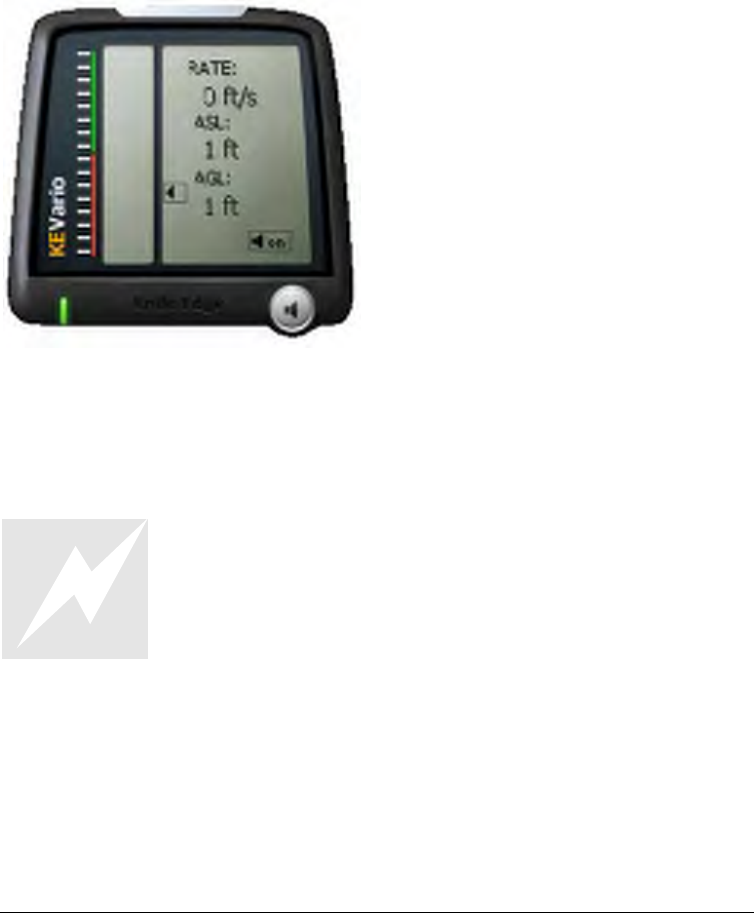
249
To change the vantage point options and features, use the commands found in the
View menu. Ensure that the viewport you wish to modify is the active viewport, or the
modifications will not take effect.
Clicking on the ‘X’ in the viewport’s title tab removes it from the screen.
Variometer-
A variometer is an instrument designed to indicate the rate of climb or descent of an
aircraft. The variometer is useful to pilots flying powered aircraft so they can ascertain
that level flight is maintained. This is useful during turning maneuvers. Glider pilots
typically make the most use of a variometer, to help determine the areas of rising or
sinking air currents.
To access the Variometer, click the Window menu title, followed by the Gadgets
menu item. Next, click the Variometer menu item.
You may also bring up the Variometer by pressing the keyboard’s ‘5’ key.
You may also load the Variometer using the InterLink Elite with the
QuickSelect buttons. Press the Menu/Select button. Then press
down six times on the Data Lever until the Variometer tab,
pictured with a sailplane, is highlighted. Press the Menu/Select
button again to activate the Viewport. Repeat these steps to remove
the Variometer from the screen.
The variometer available in RealFlight also offers an audio indicator, much like the real
instrument. As the rate of climb increases, the pitch in the audio tone will increase, as
well. The opposite holds true, as the descent of the aircraft increases, the pitch in the
audio tone decreases accordingly.

250
If you wish to turn off the audio ques, click the button with the speaker symbol in the
lower right corner on the variometer. To turn the audio back on, click the button once
again.
The variometer in RealFlight G4 is split into two parts. The left side of the variometer
includes a status meter which indicates whether the aircraft is ascending, descending or
maintaining level flight. If the bar is in the green, the aircraft is rising. If it is in the red,
then the aircraft is descending. If it remains stationary in the middle, the aircraft is
maintaining its altitude. The farther the bar moves from the center, the faster the
change in altitude. On the right, there are three readouts that offer the following.
• Rate – This indicates the rate of change in altitude.
• ASL – This shows the altitude above sea level.
• AGL – This indicates the altitude above ground level.
Clicking the Variometer viewport will display the title bar and frame. Clicking on the
‘X’ in the title tab of the frame removes the frame from the screen.
Console-
The Console, and its related commands, will generally be used only by RealFlight’s
power users or those with advanced knowledge of gaming systems, etc. As such, we
will simply scratch the surface of the Console in this manual. For additional
information and assistance, we encourage users to visit the RealFlight forums at::
http://www.knifeedge.com/forums/
To access the Console, press the ‘~’ key. A complete list of commands is available by
typing ‘help’ in the command line and pressing Enter.
Chat-
Chatting offers the ability to communicate with other RealFlight players during a
multiplayer session. Select this menu item to bring up the chat field at the bottom of
the simulator screen. To send a message, type your message in the field and press
Enter on the keyboard.
Alternatively, press the Enter key first to bring up the Chat field at the bottom of the
screen. Next, using the keyboard, type the message you wish to send. Press the Enter
key again on the keyboard to send the message.
Please note: all messages are viewable by all participants. RealFlight G4 does not offer
private chat.
Any messages received from other participants will appear at the bottom of the screen.
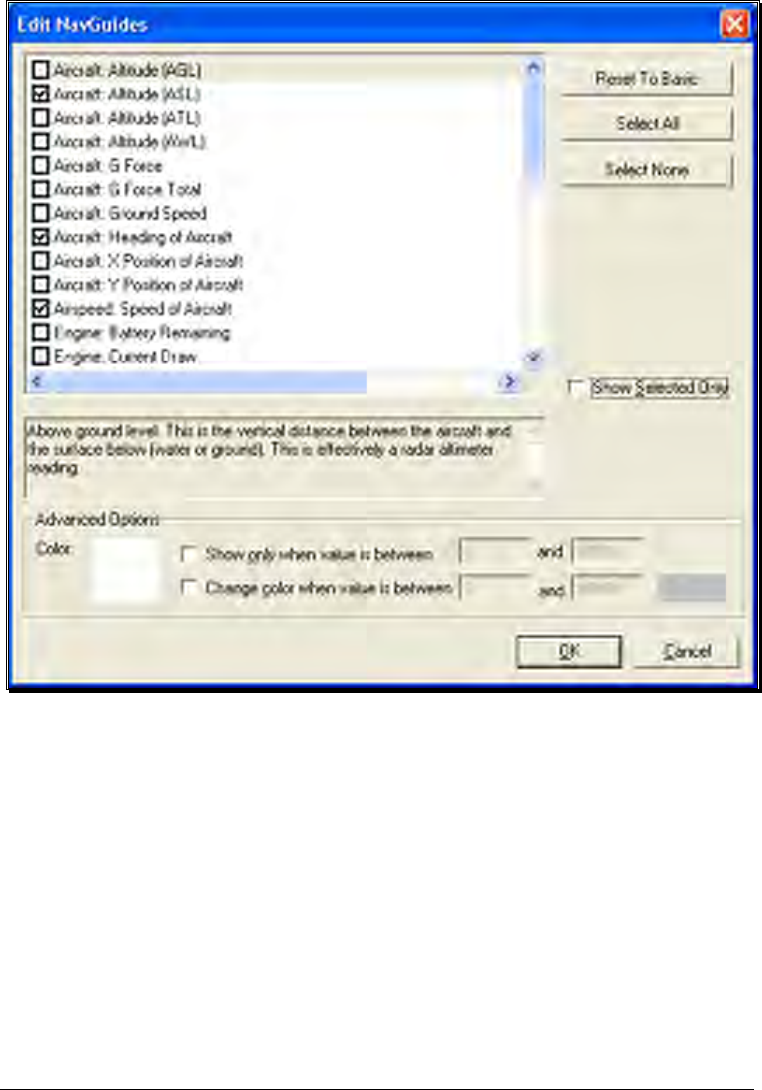
251
Edit NavGuides…-
This menu item allows you to modify the data displayed in the NavGuides box.
To access the Edit NavGuides feature, click the View menu title, followed by the
Gadgets menu item. Next, click the Edit NavGuides… menu item.
Modifying the NavGuides-
To add any of the options from the left column to the NavGuides display,
click in the box next to the respective item.
The pane below the list of the Edit NavGuides dialog box contains a
description of the respective item.
The Reset To Basic button returns all NavGuides to their default values and
options. If you wish to choose all items in the NavGuides list, click the Select
All button. All NavGuides items will then be shown in the on-screen display.
To remove all items from the list, click the Select None button.
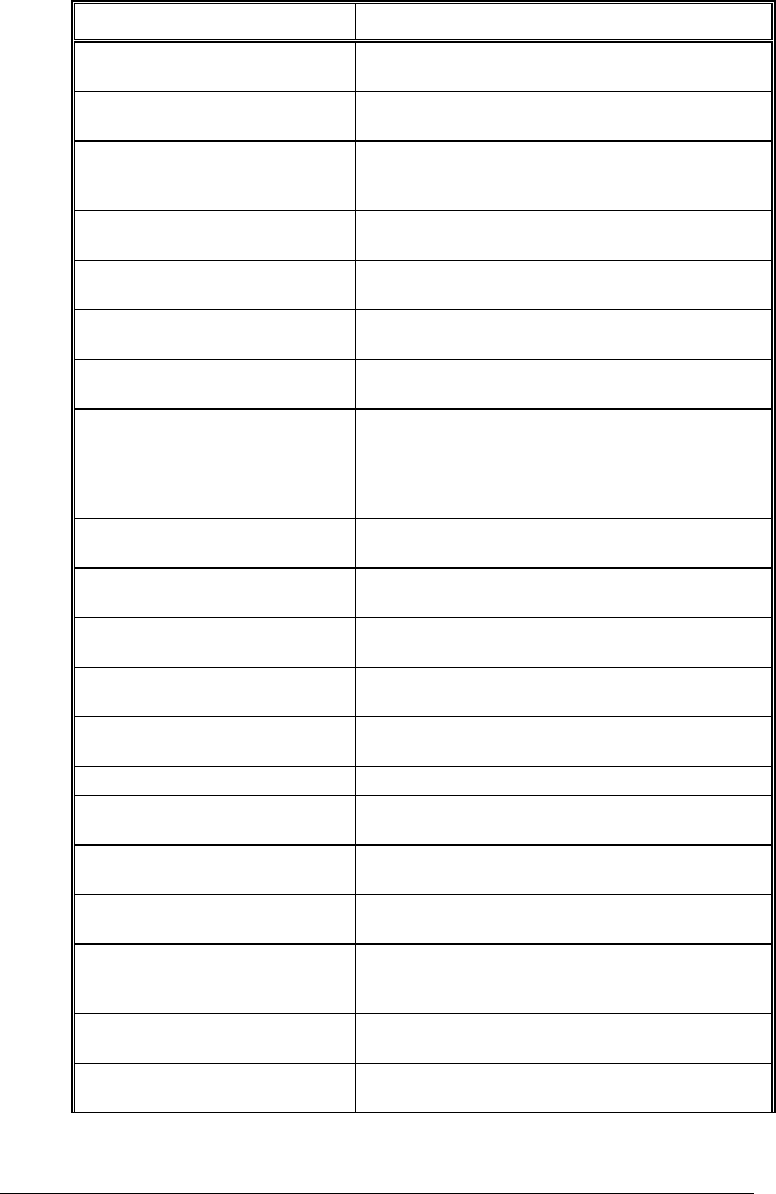
252
The NavGuides available are listed in the following table:
Option Description
Aircraft: Altitude (AGL) Check this item to display the current altitude of the
aircraft above ground level.
Aircraft: Altitude (ASL) Check this item to display the current altitude of the
aircraft above sea level.
Aircraft: Altitude (ATL) Check this item to display the current altitude of the
aircraft compared to the terrain below. This option does
not account for water.
Aircraft: Altitude (AWL) Check this item to display the current altitude of the
aircraft above the body of water at the airport.
Aircraft: G Force Check this item to display the gravitational load of the
aircraft is experiencing as felt by the pilot.
Aircraft: G Force Total Check this item to display the gravitational load of the
aircraft is experiencing in any direction.
Aircraft: Ground Speed Check this item to display the current ground speed of
the aircraft.
Aircraft: Heading of Aircraft Check this item to display the current heading of the
aircraft. This heading is displayed in degrees, as they
would appear on a compass. “0” degrees is North, “90”
degrees is East, “180” degrees is South and “270”
degrees is West.
Aircraft: X Position of Aircraft Check this item to display the current X position of the
aircraft.
Aircraft: Y Position of Aircraft Check this item to display the current Y position of the
aircraft.
Airspeed: Speed of Aircraft Check this item to display the current airspeed of the
aircraft.
Engine: Battery Remaining Check this item to display the remaining capacity in the
battery pack.
Engine: Current Draw Check this item to display the amount of current that the
motor is draining from the battery pack.
Engine: Fuel Remaining Check this item to display the amount of fuel remaining.
Engine: Motor Efficiency Check this item to display the efficiency of the electric
motor.
Engine: Power In Check this item to display the amount of power being
transferred to the electric motor.
Engine: Power Out Check this item to display the amount of power being
generated by the engine.
Engine: RPM Check this item to display the RPM’s of the engine.
Note: this measurement does not take into account any
gear reduction which might be utilized.
Engine: Voltage Check this item to determine the voltage across the
electric motor.
Helicopter: Main Rotor RPM Check this item to display the current main rotor RPM of
the helicopter.
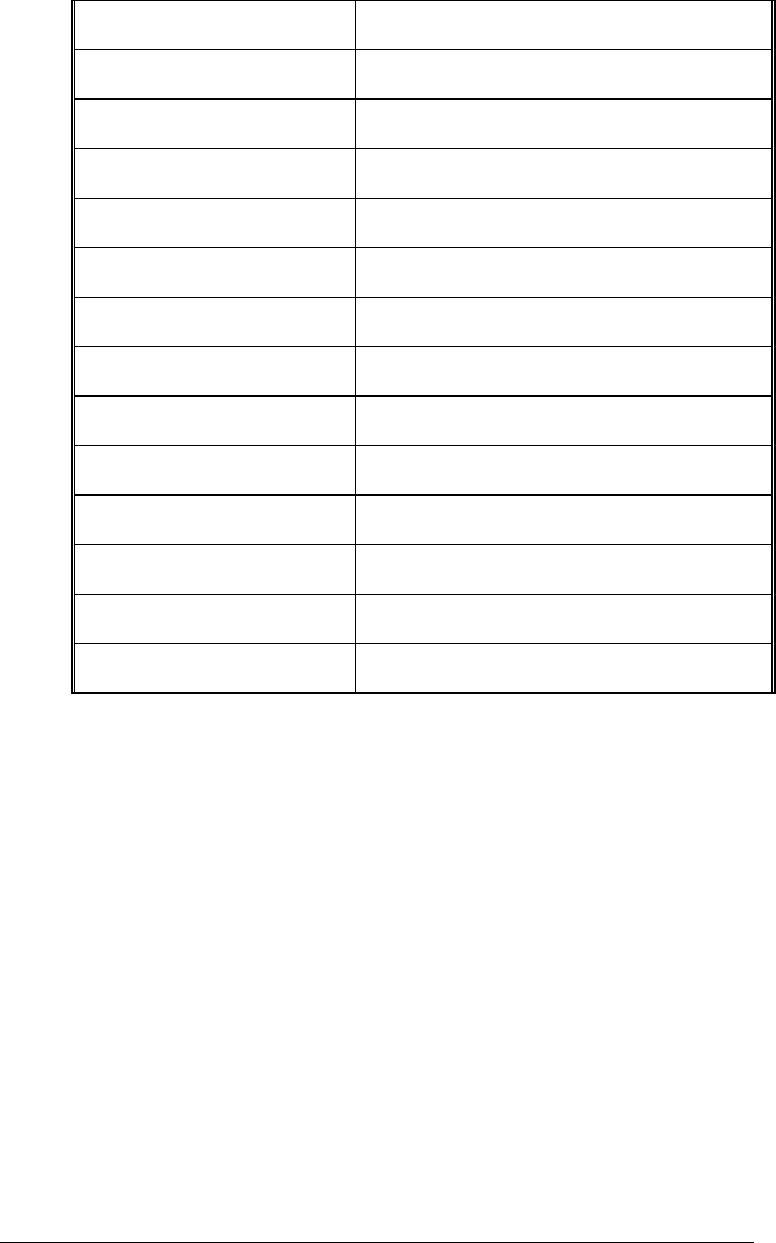
253
Helicopter: Tail Rotor RPM Check this item to display the tail rotor RPM of the
helicopter.
Pilot: Distance to Aircraft Check this item to display the current distance from the
pilot to the aircraft.
Pilot: Field Of View Check this item to display the field of view angle for the
main window.
Pilot: Height (AGL) Check this item to display the height of the pilot above
the surface below, water or ground.
Pilot: Height (ASL) Check this item to display the height of the pilot above
sea level.
Pilot: Height (ATL) Check this item to display the height of the pilot above
the terrain, not including any body of water.
Pilot: Height (AWL) Check this item to display the height of the pilot above
the body of water at the airport.
Pilot: Look Direction Check this item to display the compass direction in
which the pilot is looking.
Pilot: Zoom Magnification Check this item to display the amount of zoom being
utilized; 1 is equivalent to normal eyesight.
System: Graphics Frame Rate Check this item to display the number of times the
screen updates per second.
System: Physics Frame Rate Check this item to display the number of times the
physics system updates per second.
Wind Direction Check this item to display the direction that the wind is
blowing.
Wind Speed Check this item to display the velocity of the wind at the
current time.
Wind Updraft Check this item to display the velocity of the wind in the
upward direction.
Color-
This setting adjusts the Color for the selected item. To select an alternate
Color, click on the color swatch. This will open the color palette dialog and
you may choose an alternate color for the item.
Show only when value is between-
Click on the box to activate the option for Show only when value is
between. If the aircraft parameter falls within the specified range, the selected
item will appear in the NavGuides. If the parameter is not within the specified
range, the item will not be shown.
To adjust the range, click on the respective value box and input the value via
your keyboard.
Change color when value is between-
Click on the box to activate the option for Change color when value is
between. If the aircraft parameter falls within the desired range, the selected
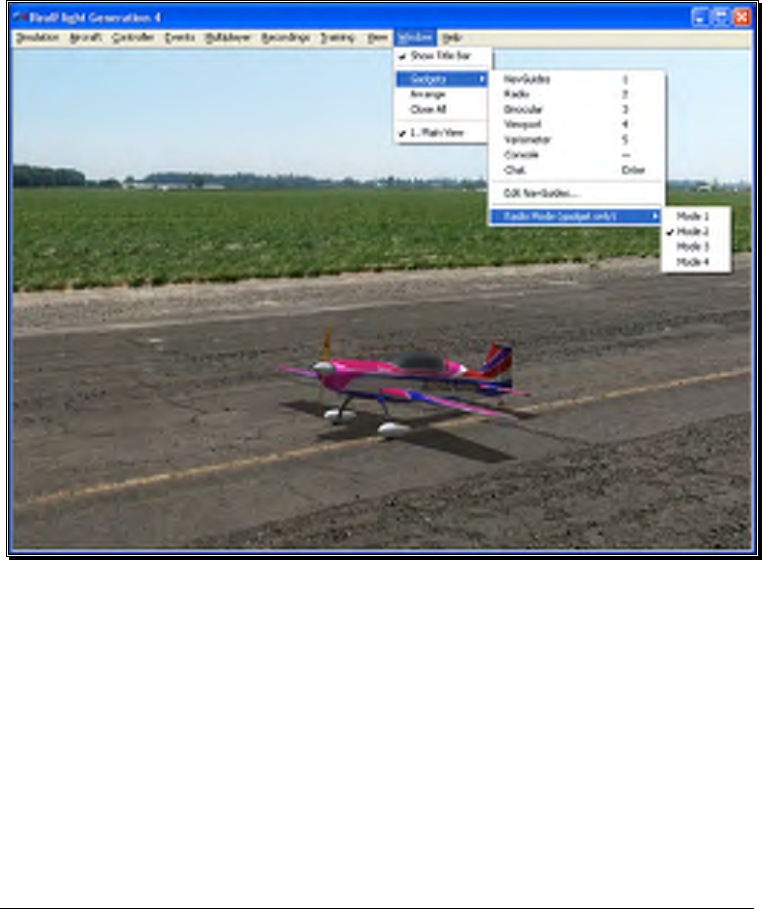
254
item will appear in the NavGuides in the alternate color. If the parameter is
outside of the specified range, the item will be shown in the primary color.
To adjust the range, click on the respective value box and input the value via
your keyboard.
Radio Mode (gadget only)-
This option allows you to change the Mode in which the on-screen radio is displayed.
For example, if you prefer to fly with the throttle and rudder on the left stick, and
ailerons and elevator on the right stick, then you fly Mode 2. Some modelers prefer
Mode 1. In this mode, the left stick controls the rudder and elevator; the right stick
controls the throttle and ailerons.
Whichever mode you fly, you will want the on-screen radio to match. Select Radio
Mode (gadget only) to show the list of available radio modes. Click the mode that is
appropriate for you.
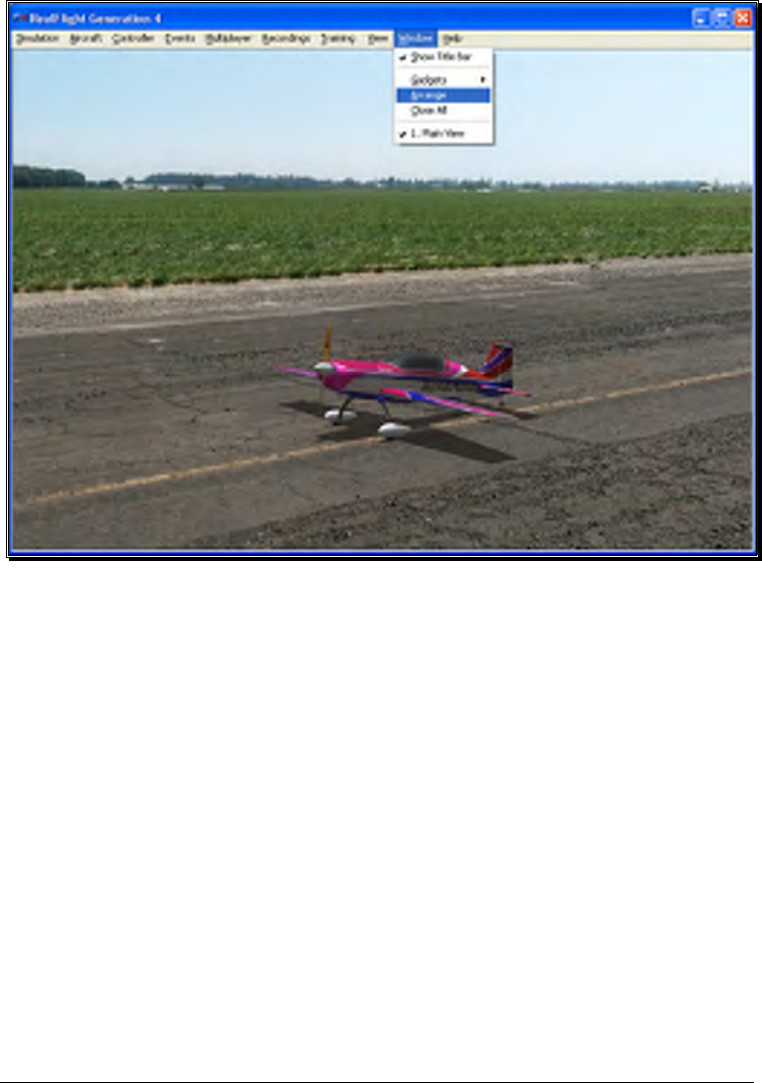
255
Arrange
This menu item allows you to organize the on-screen viewports. This is especially
helpful when there are multiple windows open that overlap one another.
Click on the Window menu followed by the Arrange menu item to activate this
option.
Close All
This menu item closes all open Windows with the exception of the main Window. It
offers the user an easy method to clean up the screen without having to close each
window separately.
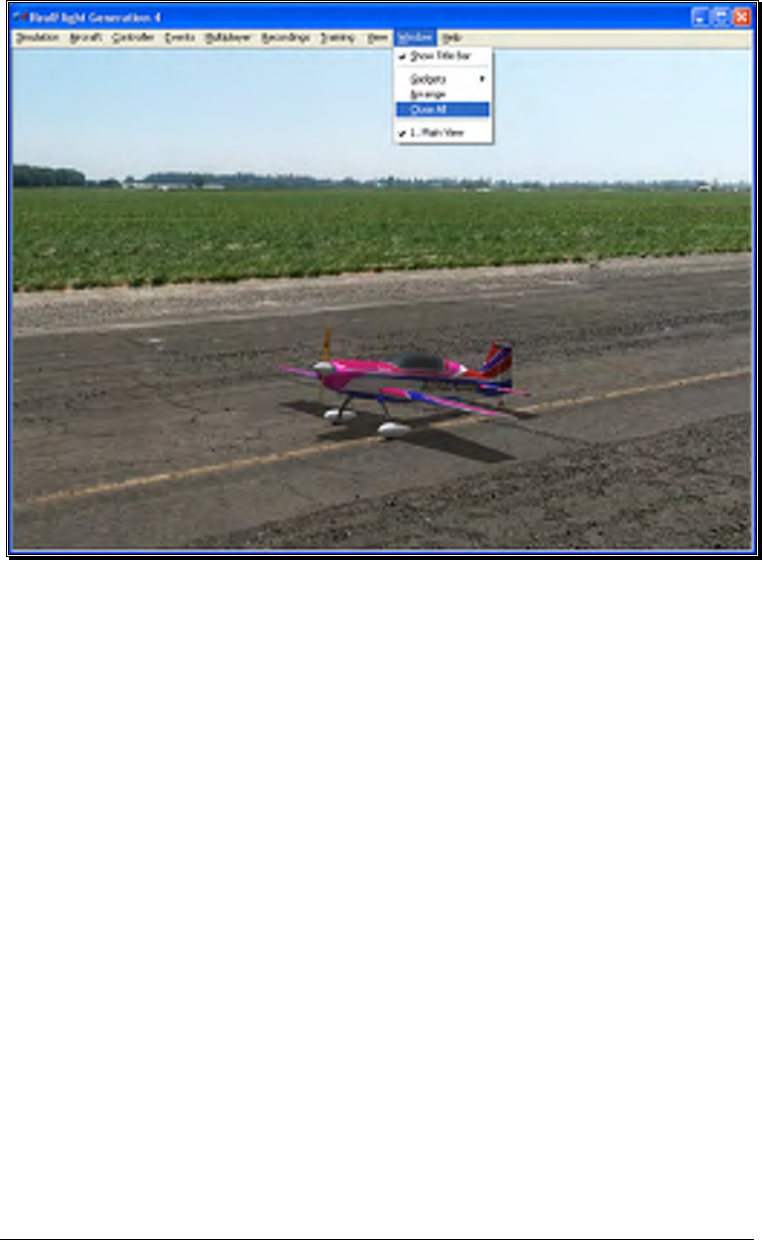
256
To access the Close All menu item, click on the Window menu followed by the Close
All menu item.
Viewport List
As you add more viewports to the screen, note that they appear on a list in the
Window menu title. If you wish to change the active view to one of these viewports,
simply click on the viewport name in the list.
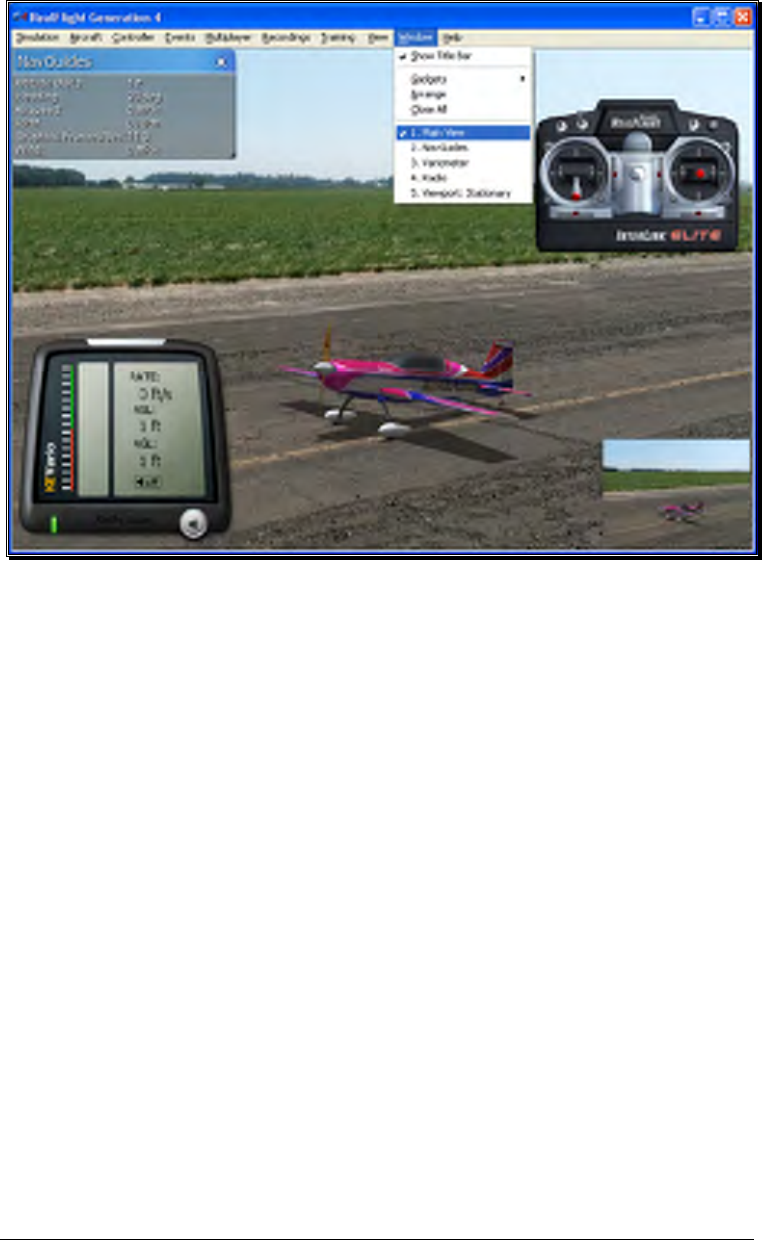
257
To determine the active window, simply search for the yellow outline that surrounds
the active window. In the example above, the active window is Binocular.
To change the active window, click on, or in, the window that you wish to become
active.
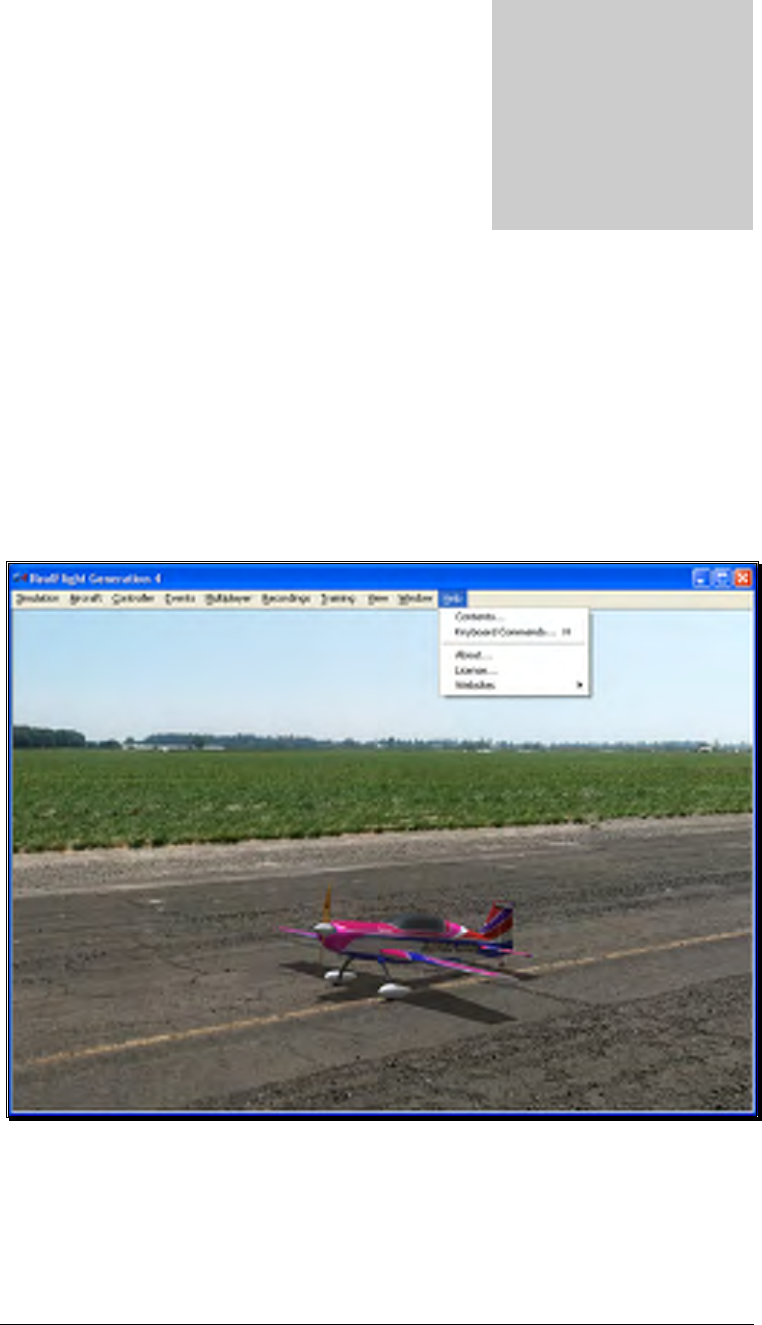
259
Help Menu
When all else fails, ask for help.
his menu provides you with miscellaneous assistance and guidance with a
variety of simulator-related issues.
To access the Help files, click on the Help menu title.
The menu items available under the Help menu are:
• Contents…
Chapte
r
14
T
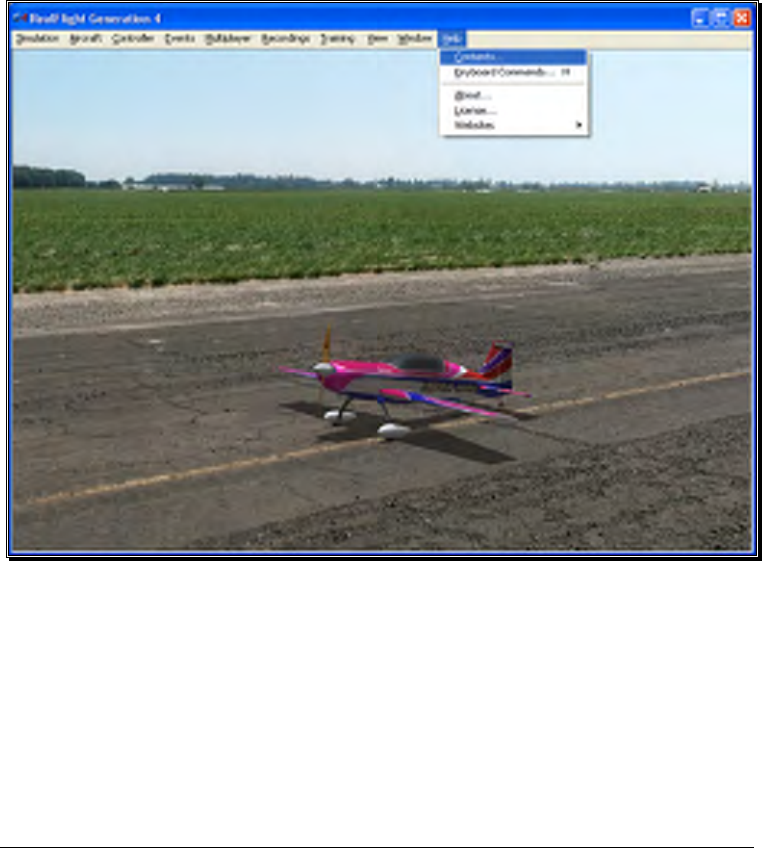
260
• Keyboard Commands…
• About…
• License…
• Websites
Contents
This menu item accesses RealFlight G4’s manual which you are reading now.
To access the Contents… files, click on the Help menu title.
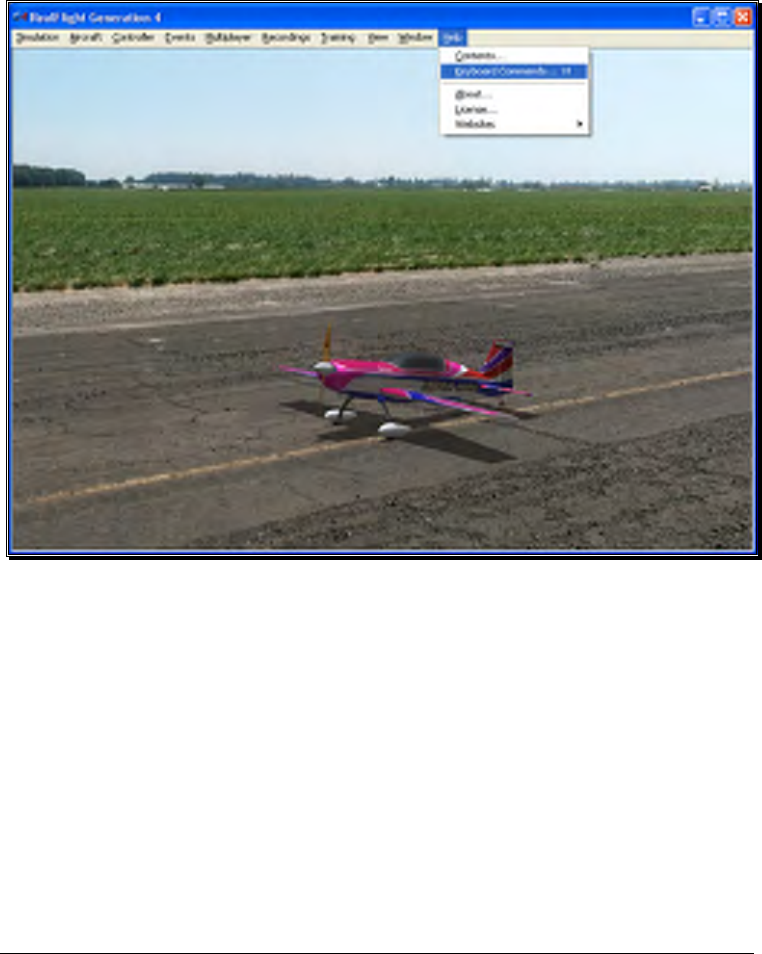
261
Keyboard Commands
RealFlight allows you to access menu and other commands from your computer’s
keyboard. A key that directly invokes a command is called a “quick key” or “hot key”.
For example, pressing the [+] (plus) key on the keyboard’s number pad incrementally
zooms your view towards the aircraft. This is exactly the same result that arises if you
select Zoom In from G4’s View menu item. Consequently, we say that the [+] (plus) is
a hot key for the Zoom In command.
To access the Keyboard Commands, click the Help menu title, followed by the
Keyboard Commands menu item.
Alternatively, you may also bring up the Keyboard Commands by pressing the
keyboard’s ‘H’ key.
The following overlay will appear:
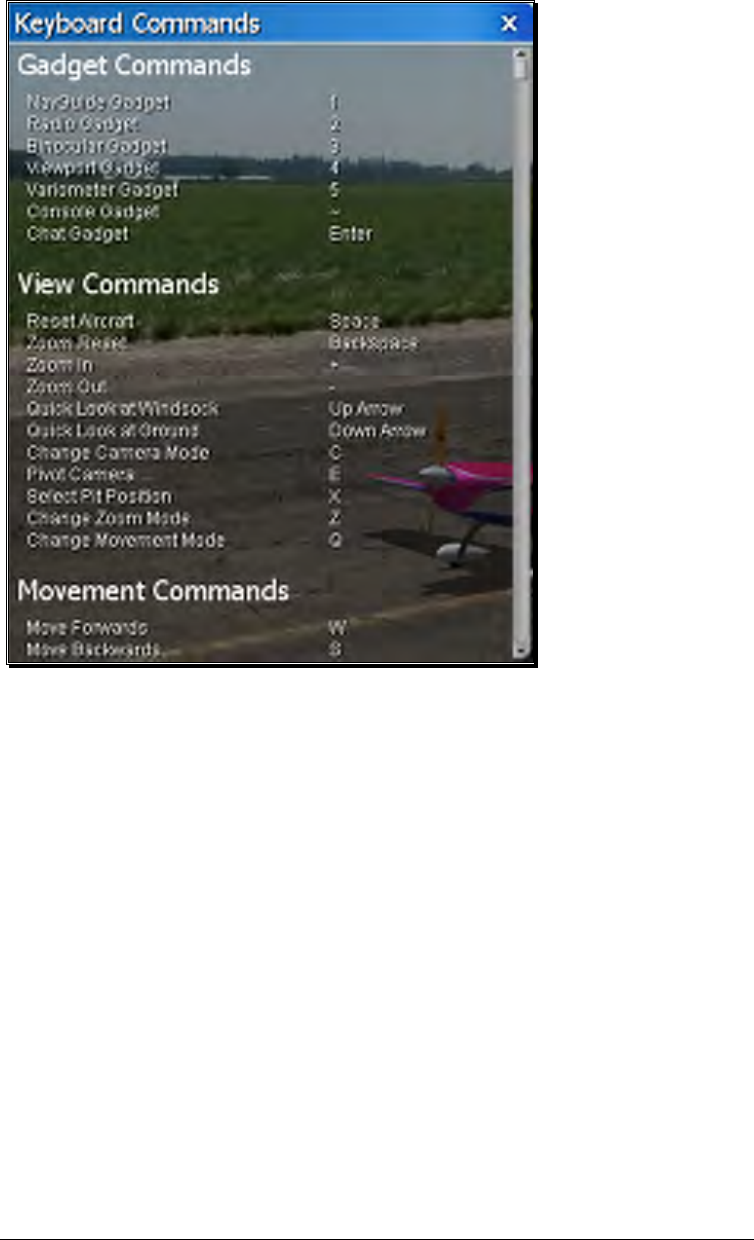
262
The Keyboard Commands screen contains all of the information pertaining to the hot
keys. To view the entire list, drag the scroll bar on the right side of the Keyboard
Commands screen down. Alternatively, this list is also contained in the inside rear
cover of the Installation Guide which accompanied this software.
If you do not wish to view this information, double-click on the title bar of the display
box. This will hide the information. To view it once again, simply double-click the
title bar.
Clicking on the ‘X’ in the title tab of the frame will remove it from the screen.
About
The About… menu item contains miscellaneous information pertaining to your
software. The About… menu contains your RealFlight serial number, InterLink Elite
serial number and the version number of the software that you are currently operating.
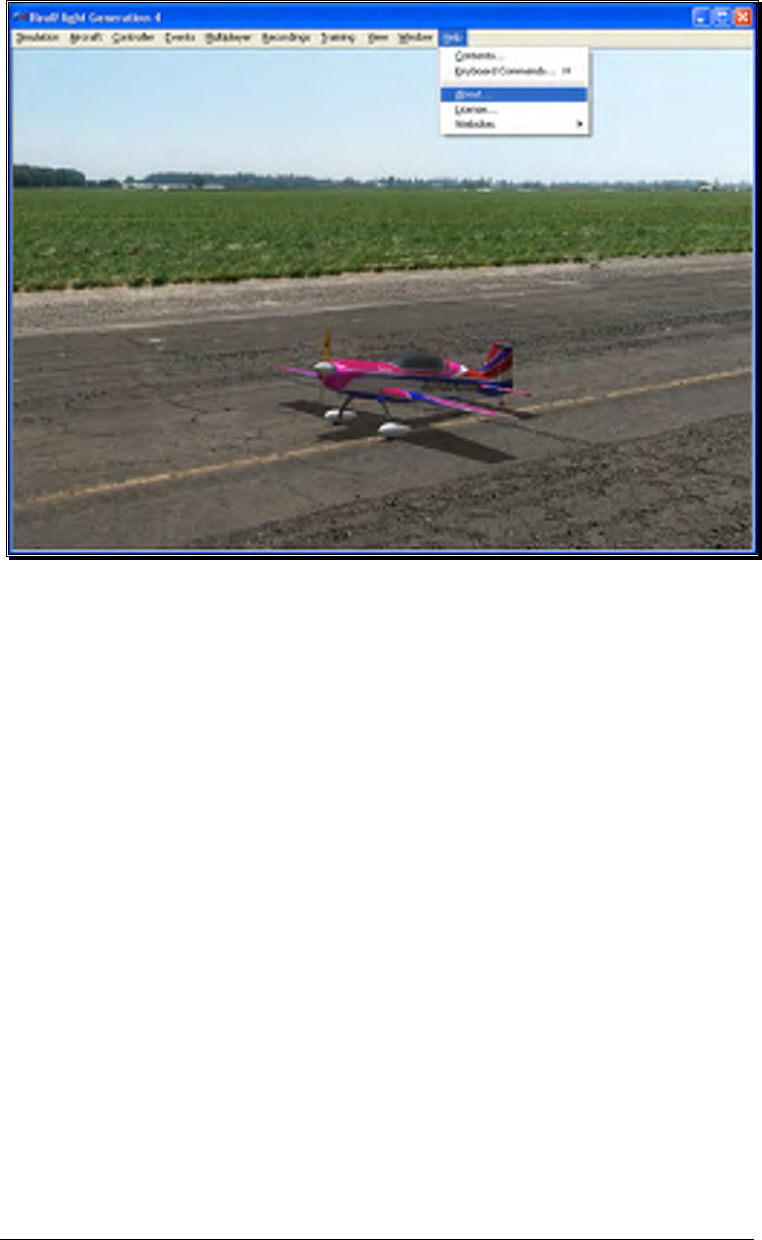
263
Also seen in the About screen are the credits and names of the people that have
worked together to bring you the world’s most realistic R/C simulator, RealFlight
Generation 4.
Clicking on the ‘X’ in the title tab of the frame or clicking anywhere on the main
simulator screen will remove the About window.
License
This menu item contains the End Users License Agreement (EULA) for the RealFlight
R/C Flight Simulator. Please read it carefully.
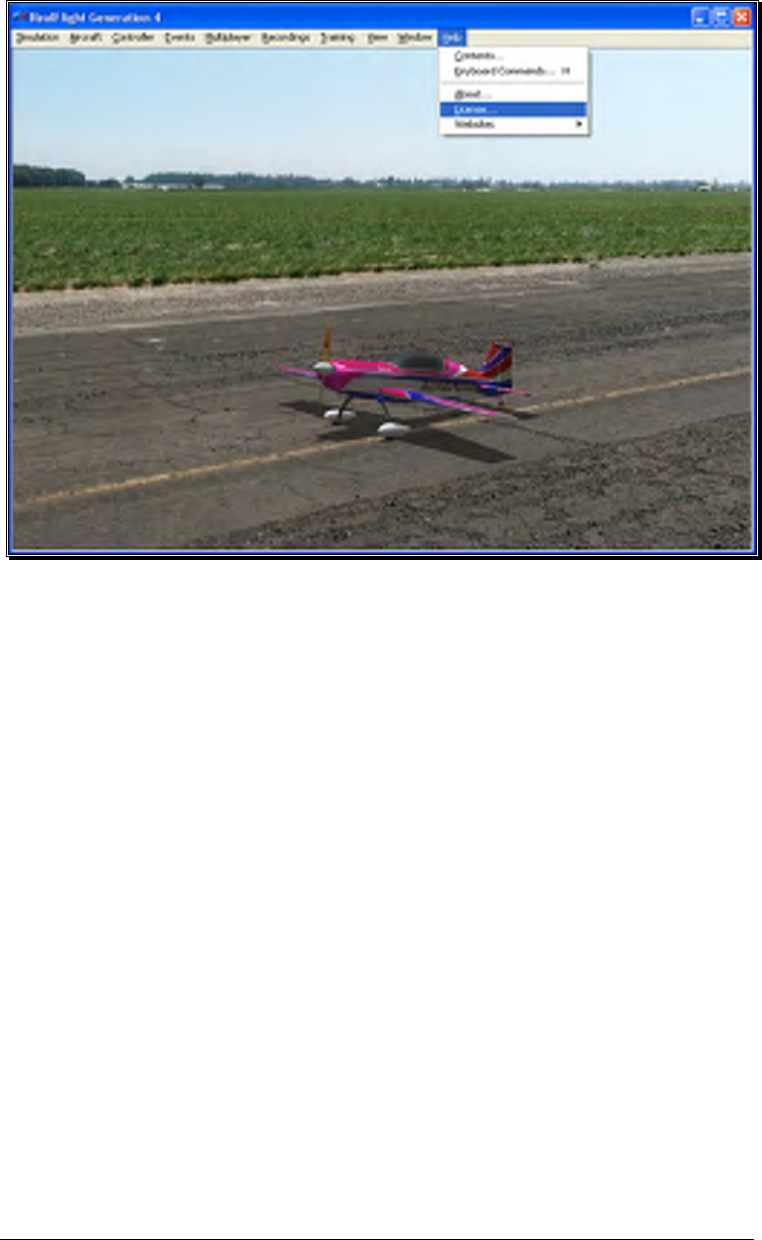
264
Clicking on the ‘X’ in the title tab of the frame will remove it from the screen.
Websites
This menu item contains links to the RealFlight related websites. The options include:
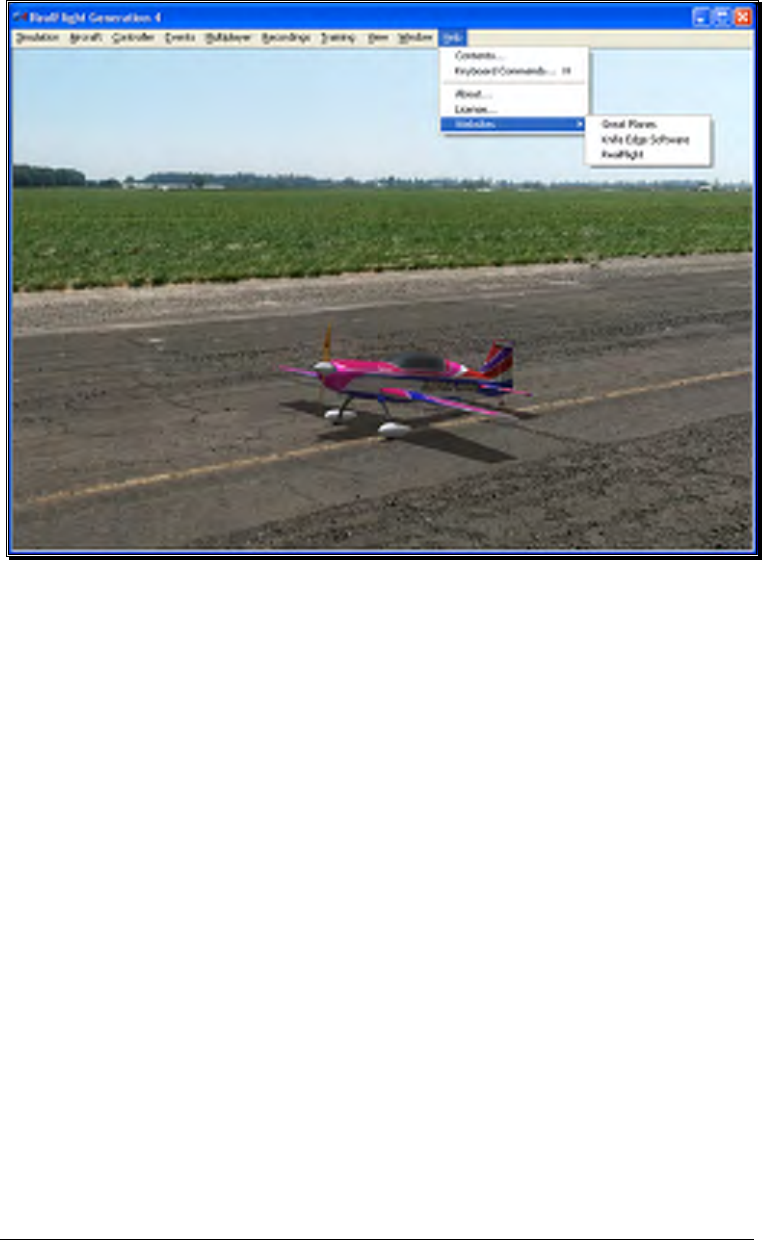
265
Great Planes-
Publishers of RealFlight G4. Visit this site for information pertaining to the many
other Great Planes products available.
Knife Edge Software-
Developers of RealFlight G4. Visit the Knife Edge forums to share experiences and
technical support with other RealFlight owners. The Knife Edge forums also play host
to a wide variety of free, downloadable aircraft, trim schemes, flying sites and more.
RealFlight-
Visit the RealFlight website for more information about the RealFlight family of
products, search the knowledge base for technical support, or for information on how
to contact our support staff if you have questions.

267
Basics of Flying
Understanding the fundamentals of radio control flying.
efore taking control of a transmitter, it helps to understand the basics of flight,
and the functionality of the gimbals, sticks and switches to properly control
the aircraft. This chapter reviews the basics of flying an airplane or a
helicopter to help get you started down the right path.
Airplane Basics
Before you fly the plane, make sure all switches are in their off or low rates, positions.
The switches may be assigned to different items depending on how you have
configured your controller and which aircraft you are flying. If you are using your own
transmitter to control RealFlight, please consult your transmitter owner’s manual for
more information.
The InterLink Elite features digital trim tabs which are more precise and offer trim
memory within the simulation. Trim tabs are the small slider controls on the controller
(two per controller stick). They “trim” the aircraft so that it flies straight and level. For
example, if an airplane has a tendency to veer slightly downward, you may need to add
a slight “up” nudge to the elevator. You can do this by sliding the elevator trim, a click
or two at a time, towards the bottom of the controller.
Crashing-
Takeoffs are optional, but landings are mandatory. For any type of aircraft or flying,
successfully landing an aircraft is a crucial skill to master.
The key to a perfect landing is undivided concentration. Pay close attention to the
altitude, orientation, and speed of the aircraft as it approaches the runway. Should you
happen to crash, use each crash as a learning experience to perfect your approach and
the landing.
Appendix
A
B

268
RealFlight has several tools to help you stay on top of things during approach and
landing. See the “Landings” section below for some ideas.
Out at the field a crash might result in one or more of the following:
• Bruise your ego
• End flying for the day
• Cost you money
• Cost you time to rebuild
• Cause injury to yourself or a bystander
• Even win you a nice “best crash trophy!”
Of course, when you crash on the simulator, there is really no harm done. None, that
is, except the bad habits you may acquire. We suggest that you take the crashes
seriously and learn from each one. By doing so, you will be a better pilot out at the
field.
Airplane Flight-
RealFlight G4 accurately simulates how R/C aircraft really fly. This allows you to
practice R/C flight without worrying about expensive crashes. Additionally, RealFlight
G4 is ideal for practicing new maneuvers and experimenting with various parameter
adjustments.
It is important to remember, however, that a simulator will only help you learn to fly if
you let it. Otherwise, it is just a game. Learning to fly R/C aircraft requires a
commitment. One does not just grab the sticks and start dazzling the crowds. A
methodical, patient approach will help you get the most out of this simulator.
This section is not designed to teach you how to fly. However, it will help you enhance
your experience with the simulator and obtain the most from your experiences.
Takeoffs-
When you are taking off, start with the throttle in low position and slowly
increase throttle by pushing the throttle stick away from you towards the top
of the transmitter until you are at about half speed. Stay in the middle of the
runway (you can steer the plane using the rudder). When you have built up
enough speed, gradually pull back on the elevator stick to climb off the runway.
If the plane is tracking well, apply the rest of the power more quickly, climb
out, and gain altitude.
Be careful not to veer off the runway. In a real plane, chances are that you
would crash (or get stopped on the grass). Usually this means bent landing

269
gear and a broken prop. If your plane has retracts, they could even be torn out
of the wing.
For the best practice, it’s recommended that you utilized the Takeoff Trainer
available with RealFlight G4. For more information, see the Takeoff Trainer
section on page 200.
Landings-
It is very important to land on the runway, rather than veering off, or touching
down before you reach the runway. Either of the latter usually produces a
moderately expensive crash. If you “cartwheel” (wing tip hits the ground first),
the wing can break, resulting in lengthy down time while you repair your
airplane.
Start by aligning your plane parallel with the runway. Fly the approach
normally, using your throttle to control the rate of descent. Try to land at the
slowest speed possible. If your plane has flaps, use them to kill speed (but be
careful; with flaps down your plane will try to pitch up and climb). If your
plane has retractable landing gear, lower them. As you touch down, remember
to keep your nose up!
RealFlight has several tools to help you practice landings.
• Before you try to land yourself, you may want to get a lesson from a pro.
To do so, click the Training menu followed by the Virtual Flight
Instruction… menu item. Choose Jason Shulman as the instructor.
From the list of options, select the Landing maneuver.
• Gain experience through the Landing Trainer. It offers guidance and
helps set you up for the perfect landing. See the Landing Trainer on page
205 for more information.
• During your approach, use the NavGuides to keep track of your speed,
altitude, and distance above ground.
Aerobatics-
When you practice aerobatics, the three important steps are:
• Start the plane straight and level, in a controlled situation
• Perform the maneuver
• Return to a straight, controlled situation

270
Anyone can give it full throttle, jam the sticks in all directions and watch the
plane tumble and roll. However, this is not what you will do out in the field.
Do this and you will not have control of the airplane!
The key to properly performing the maneuver is in the setup. Doing so will
allow you to cleanly finish and your experience will be more rewarding as well
as more realistic.
Concentrate on making the maneuvers “clean and crisp.” If you are doing a
roll, try to keep the plane on a straight line as you roll. If you are doing a loop,
try to make a perfectly round circle.
If you want to practice aerobatics using RealFlight G4, try the Virtual Flight
Instruction feature (accessible via the Training menu). The Virtual Flight
Instruction feature provides a series of personal lessons taught by pros.
Throttle Management-
Avoid the temptation of giving the plane full throttle and keeping it there for
hours at a time. This teaches you bad habits and makes even a good flier look
like a rookie out at the field.
Many of the maneuvers require proper throttle management in order to make
a maneuver look good. Loops, stalls, torque rolls, touch-and-goes are just a
few examples. Try doing various maneuvers at differing speeds. Try
performing a slow roll at medium throttle and keeping a perfectly straight line.
This difficult maneuver will earn you more praise at the field than doing a full
speed, full stick roll.
Rudder Management-
Most airplanes can (more or less) be effectively flown with just the elevator and
ailerons. Good pilots will tell you that the proper use of the rudder is just as
important, however. Many aerobatic maneuvers require excellent rudder usage.
Rudder control is especially important when landing in a crosswind. Pilots that
cannot use the rudder usually land in the tall grass (embarrassing!). Pilots that
do use the rudder can land on the numbers almost every time.
Helicopter Basics
A model helicopter is a very complicated machine, which operates on the same
aerodynamic principles as its full-scale counterpart. These principles are quite
complicated to explain and understand. However, it is not necessary to understand all
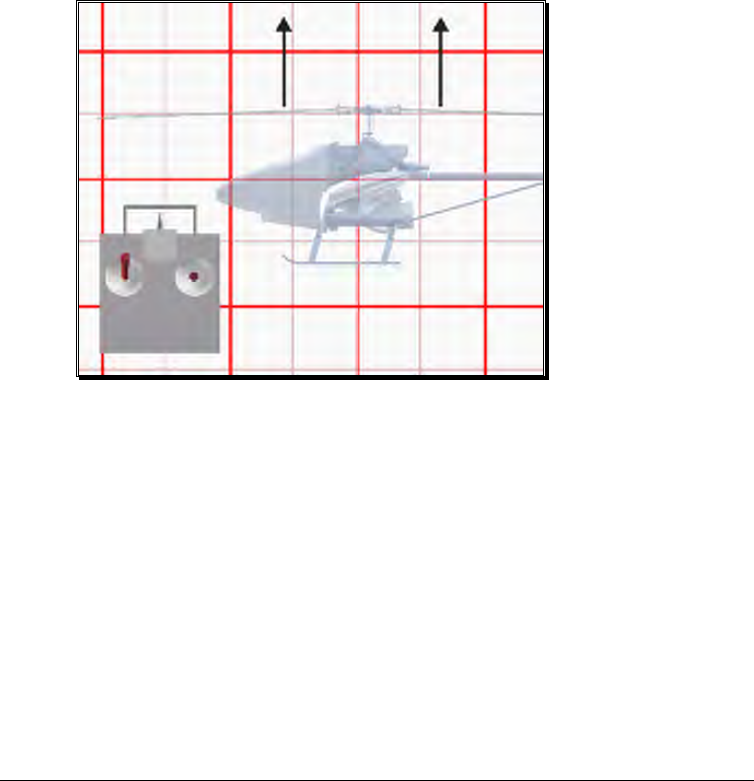
271
the underlying aerodynamics in order to successfully fly a model helicopter (or a
computer simulation).
The following will help you to better understand the basics of helicopter flight, and the
relationship between control stick movements and the actions of the machine. Refer to
these instructions often as you become more proficient.
Please note: the inputs below are shown using a Mode 2 transmitter.
Collective (Left Stick – Vertical Movement)-
The spinning main rotor blades, which act like rotating wings, lift the helicopter into
the air. Changing the pitch (angle of attack) and speed of the blades, using the
“collective” and throttle causes the helicopter to rise and descend vertically. Adjusting
“collective” increases and decreases the blade pitch. The “throttle” control increases
and decreases engine RPM. On a model helicopter, the collective and throttle controls
are mixed electronically, and controlled by the throttle stick on the transmitter or
controller.
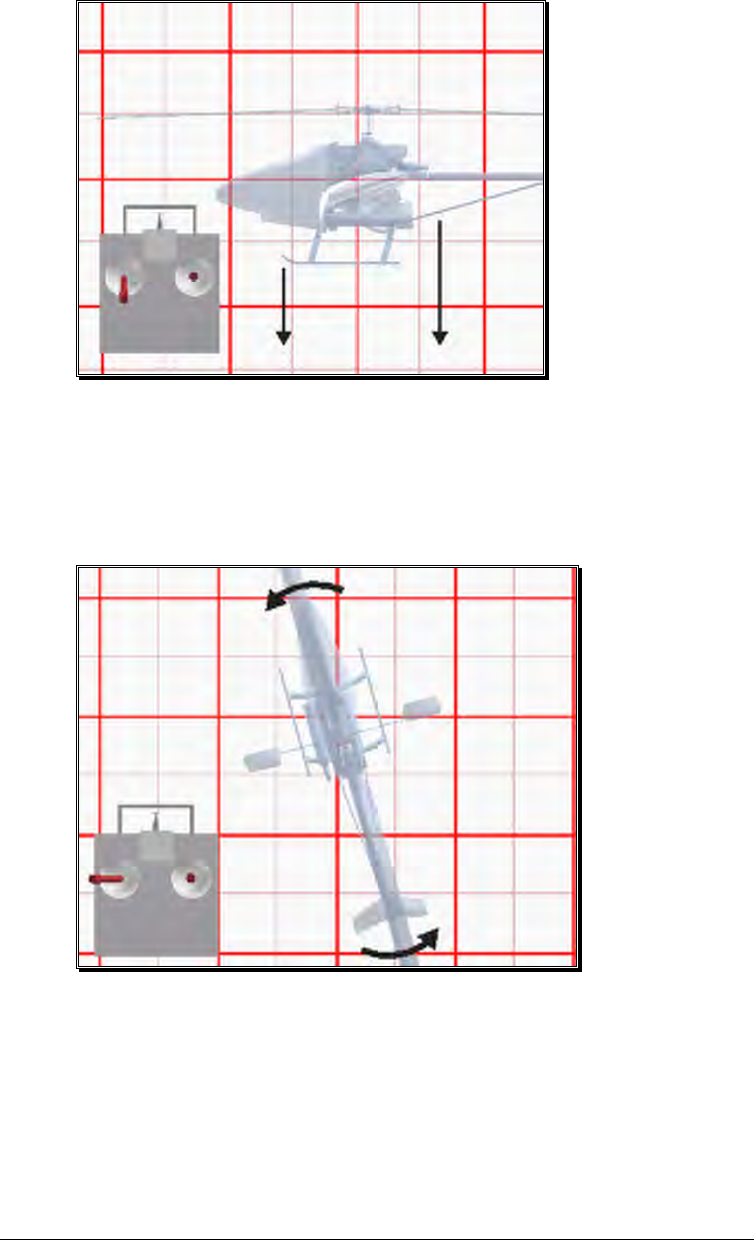
272
Rudder (Left Stick – Horizontal Movement)-
To turn the nose of the helicopter left or right, change the tail rotor pitch (by using the
“rudder” control). Changes in collective stick movement will require changes in the
amount of rudder input to maintain the desired heading.
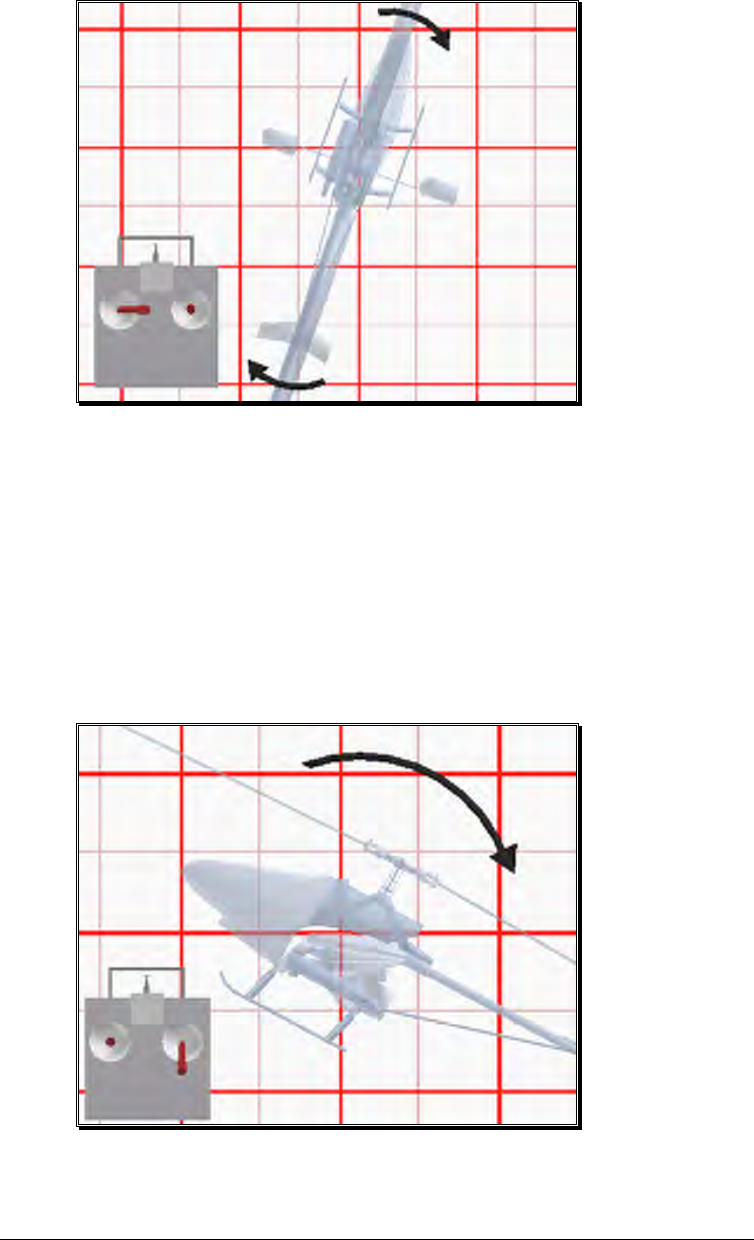
273
Cyclic Stick (Right Stick)-
The cyclic stick replaces the “aileron” and “elevator” controls found on a fixed-wing
aircraft. “Cyclic” is the term given to the control of the main rotor that allows the
helicopter to fly forward, backward, left and right. Forward cyclic stick movement
causes the helicopter to pitch forward, left cyclic causes the helicopter to tilt sideways
to the left, on so on. You move the helicopter forward or sideways using a coordinated
movement of both the cyclic and collective control sticks. Moving the cyclic stick to
the right, while simultaneously increasing collective, will cause the helicopter to move
sideways to the right. “Rudder” control is used to maintain the heading.
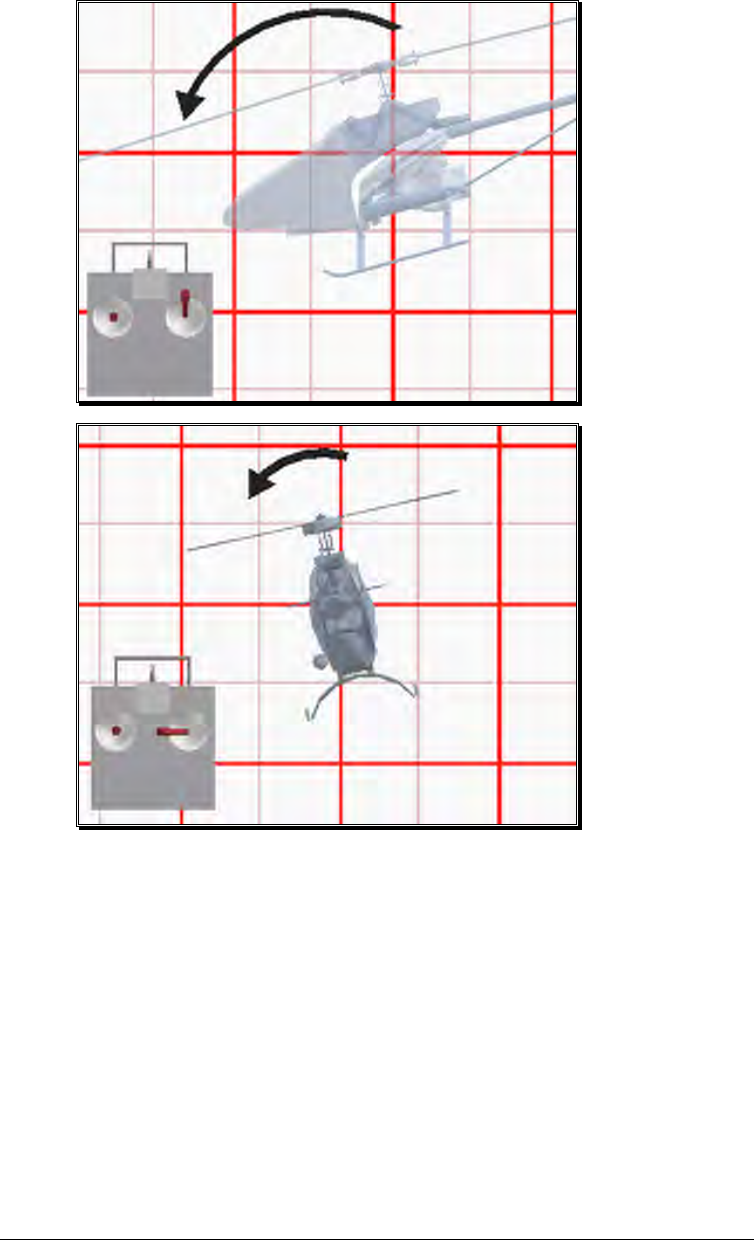
274
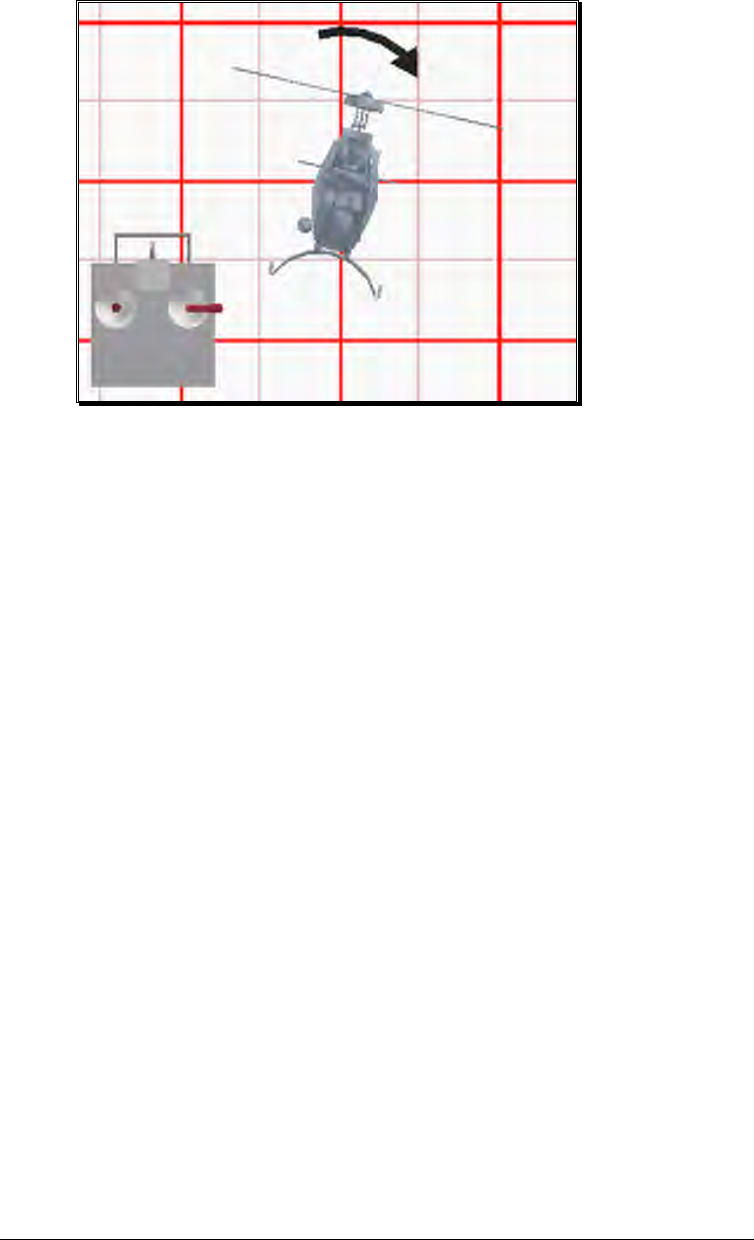
275
Idle-Up-
A switch on the controller actuates a special function, known as “idle-up.” Idle-up
offers an alternate throttle and pitch curve, different from the curves used for hovering.
Idle-up is usually used for aerobatics, when the pilot wants engine power added when
pitch is subtracted. For example, inverted hovering requires positive throttle and
negative pitch. As such, pulling the collective stick back provides positive throttle
AND increased pitch simultaneously.
Throttle Hold-
Another special function is known as the “throttle hold”. When activated, this switch
sets your throttle to idle but allows the collective to function normally. This allows you
to practice autorotations without shutting the engine off.
Gyro-
Any sudden change to the torque of the main rotor, such as a quick change in RPM or
a wind gust, can cause the helicopter to turn unintentionally to an unwanted direction.
An electronic device known as a gyroscope (gyro) is used to “monitor” and correct for
this by giving commands to the rudder control to help stabilize the machine.
Gyros come in a variety of types, each with different features. A normal gyro will not
return the helicopter to its former heading; it will simply dampen the unwanted sudden
movement. We recommend you start by using the heading hold gyro instead; it will
maintain course and keep the nose of the helicopter pointed in the desired direction
regardless of outside forces.

276
Helicopter Flight
Hovering-
The machine hovers by adjusting the collective/throttle control to maintain altitude,
the rudder to maintain heading, and minute adjustments to the cyclic controls to
maintain location. Hovering is the most important aspect of helicopter flight to master,
since every other movement of the machine begins and ends with a hover.
Forward Flight-
The helicopter moves forward by changing cyclic (moving the cyclic control forward).
This causes the rotor head, and thus the helicopter to tilt forward, resulting in a
forward thrust. As the cyclic increases, the collective must also be increased to maintain
the desired flight path. As forward speed increases, the collective can be reduced
slightly.
Backward Flight-
Backward flight is accomplished by moving the cyclic control aft, which causes the
rotor head, and thus the helicopter to tilt backward. As the cyclic is moved aft, the
collective must also be increased to maintain desired flight path. As backward speed
increases, the collective can be reduced slightly.
Sideways Flight-
Moving the cyclic control left will cause the rotor head, and thus the helicopter to tilt
left. Add collective and left rudder to cause the helicopter to “slide” sideways to the
left. As speed increases, it will require progressively more rudder to maintain heading.
To move right, simply follow the same procedure, but reverse the cyclic and rudder
movements (move cyclic right, apply right rudder).
Turning-
From forward flight-
Moving the cyclic control left, while applying a small amount of aft cyclic and
feeding in left “rudder”, will cause the helicopter to make a coordinated turn to
the left. Right movement of the cyclic and rudder sticks will cause the heli to
turn to the right.
From a hover-
Use the rudder to rotate the nose of the helicopter in the direction you want.
Learning to fly a model helicopter is more difficult and challenging than any
other genre of radio control modeling, but is also the most rewarding as you
master the techniques required for sustained hover and forward flight.
Computer simulation of model helicopter flight is an excellent tool for learning
the basics and dramatically reducing the learning curve when you move on to
the actual model itself.

277
RealFlight G4 Launcher
The RealFlight G4 Launcher is the gateway to simulator fun!
his item allows you to run the simulation, register and update the software, and
much, much more.
To run RealFlight or to access the additional options, click the RealFlight G4
Launcher located on your desktop.
Appendix
B
T
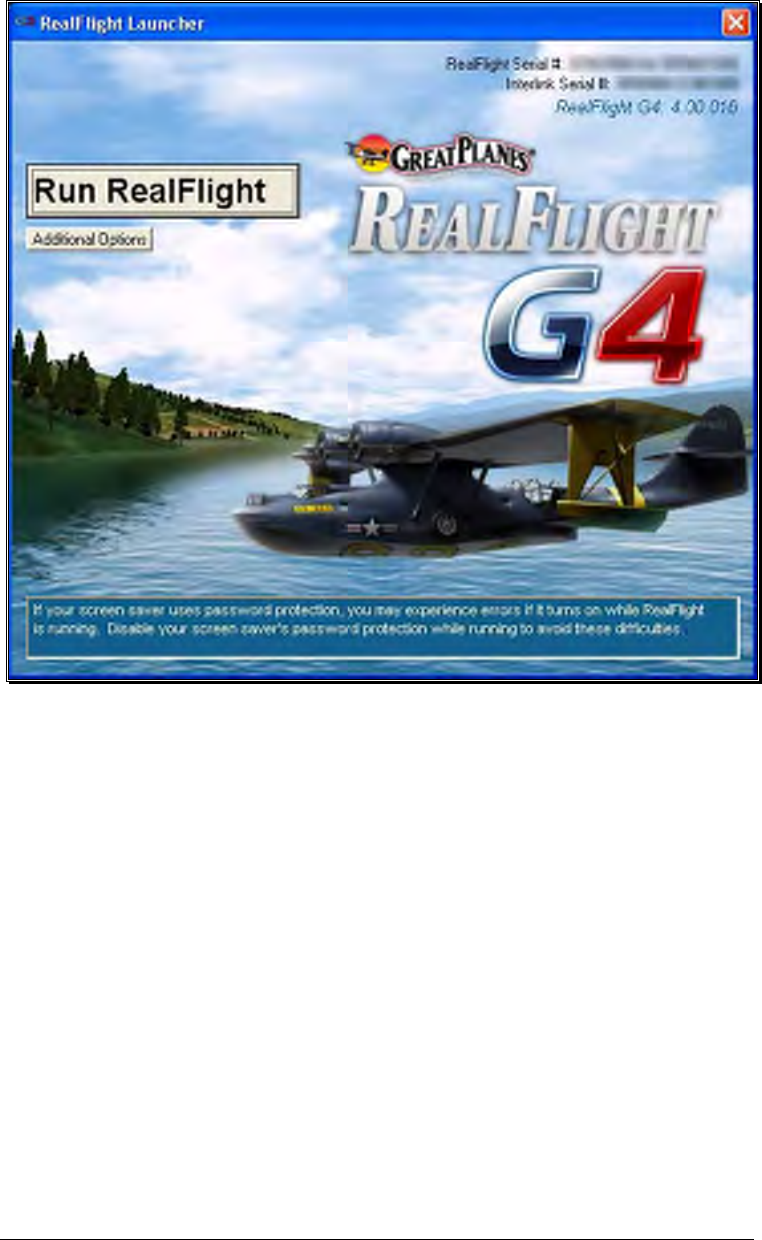
278
Run RealFlight
To start running RealFlight, press the RealFlight G4 Launcher located on your
desktop. Next, click the Run RealFlight button. The simulation will begin loading
the terrain, airport objects, textures, etc. Your simulation experience will begin as soon
as the loading process completes.
Additional Options
Click on the Additional Options button to access a variety of useful information
pertaining to RealFlight G4.
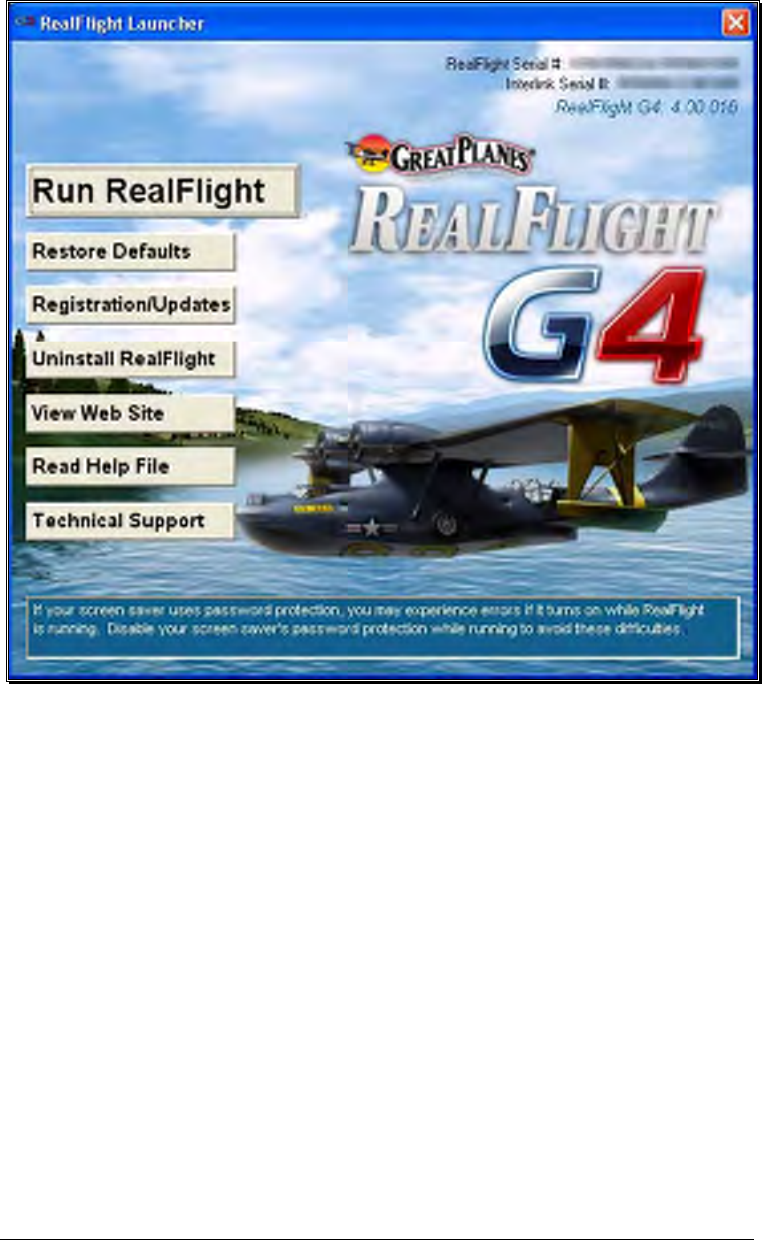
279
Restore Defaults-
Use this button to restore RealFlight G4’s default settings. Doing so will NOT remove
custom aircraft, flying sites, etc. Rather, it is designed to simply restore the factory
default values and settings for the simulation.
Registration/Updates-
Use this button to register and update the software.
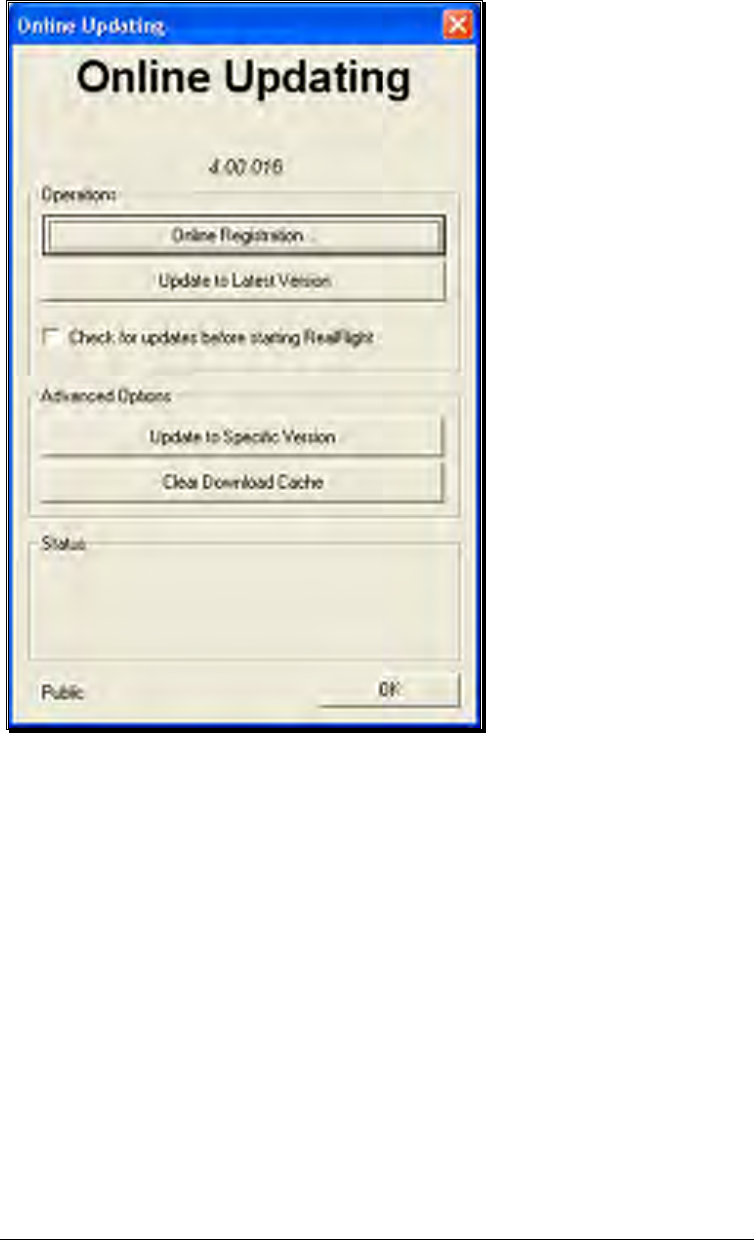
280
Online Registration-
This button allows you to register your copy of RealFlight G4. The
registration information entitles you to complimentary technical support and
free online updates.
Please enter in all of the required information to complete the registration. If
you forget your password, contact Great Planes Support. To do so, email
them at rfsupport@greatplanes.com or telephone them at 217-398-8970
(option #1). They will confirm your identity, and reset your password.
Hardware Information-
RealFlight G4 offers the option of automatically sending us
information pertaining to your system hardware and settings when you
register. If you leave the Send Hardware Information box checked
when you register, RealFlight G4 will send us this information.

281
This hardware information will assist us in diagnosing any problems
you may encounter later, should you need to contact Technical
Support Consequently, we suggest that you leave this box checked
when registering.
This feature is optional. If you uncheck the box, RealFlight G4 will
not send us any information about your system. Alternatively, you can
view exactly what information RealFlight will send us before you
decide. To view the information, click the Technical Support button.
When the Technical Support page appears, click Assemble System
Information.
Update to Latest Version-
After registering (you only need to register once), you may update to the latest
version of the software. This will download all necessary files and correctly
install the upgrade.
Click this button to Update to Latest Version.
Please note: your PC must be connected to the internet in order to check for
updates.
Check for Updates Before Starting RealFlight-
If you check this box, every time you run the RealFlight G4 software it will
check to determine whether or not there is a more recent version of RealFlight
G4 available to you. If a new version exists, RealFlight G4 will ask if you wish
to download and install the newer build.
Please note: your PC must be connected to the internet in order to check for
updates.
Update to Specific Version-
If you are experiencing difficulties with a version you have installed, this will
allow you to retrieve a previous version of the software. If the previous
version fixes your problem, please contact our technical support team at
rfsupport@greatplanes.com and let them know about the difficulty
encountered.
Clear Download Cache-
Occasionally, files may become corrupt during a download. If you are having
difficulties with the online updates, remove all cached files using this option.
Next, choose Update to Specific Version and then select the Completely
Refresh option.
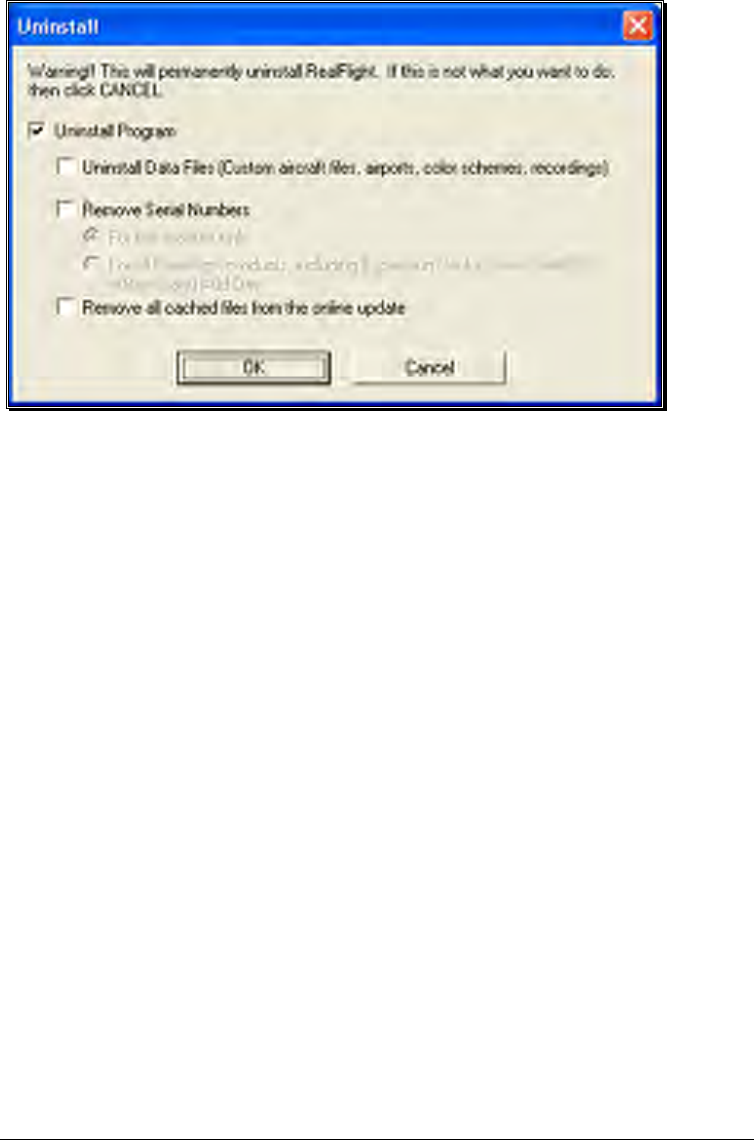
282
Uninstalling RealFlight-
Click the Uninstall RealFlight button to uninstall the software. The following dialog
will appear:
We suggest that you use this method, not the “Add/Remove Programs” feature in
Windows, to uninstall RealFlight G4. The RealFlight G4 launcher will remove all
necessary RealFlight G4 files.
Uninstall Program-
Choose this option to uninstall only the RealFlight G4 program itself.
Uninstall Data Files-
Choose this option to uninstall any user files such as customized airports,
customized aircraft, color schemes, songs etc. Be careful with this option! You
could lose a lot of your work by inadvertently uninstalling these files.
Remove Serial Numbers-
Choose this option to remove the serial numbers from your system. You have
two options available if you check this box.
• For this product only
• For all RealFlight products, including Expansion Packs, older RealFlight
editions, and Add-Ons
Remove All Cached Files From The Online Update-
Choose this to option to remove all cached download files from your system.
If you uninstall these files, future downloads may take a little longer.
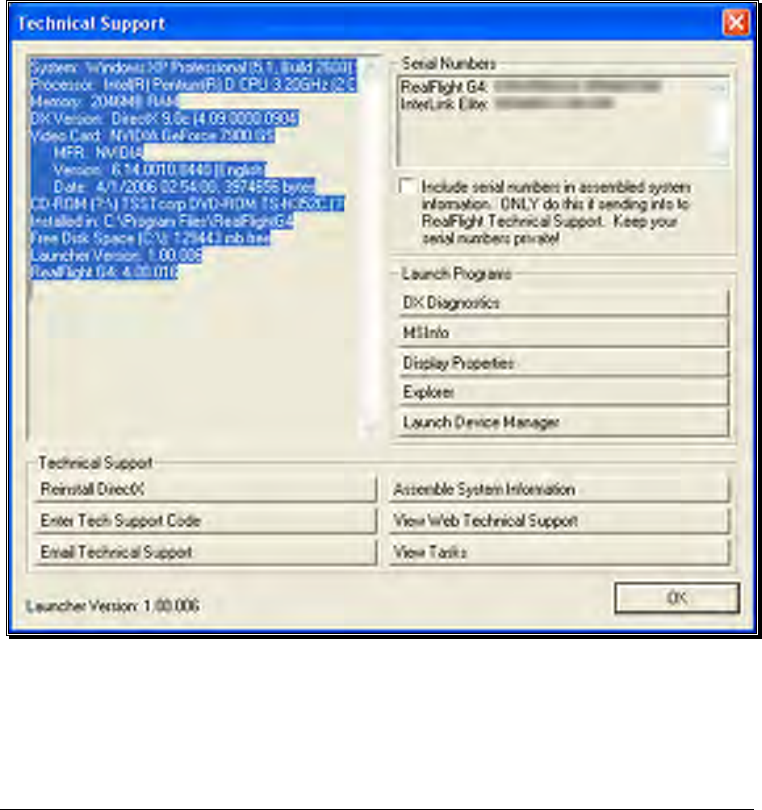
283
View Web Site-
Click the View Web Site to visit the RealFlight web site. A browser window will open
for you and you will be automatically directed to the site.
Please note: your PC must be connected to the internet in order to view the RealFlight
web site.
Read Help File
Press the Read Help File button to bring up the manual, this document that you are
reading now, file for RealFlight G4.
Technical Support-
Press the Technical Support button to bring up technical support information
pertaining your system. If you encounter any difficulties with RealFlight, this
information can help you to resolve the situation on your own, or may assist Great
Planes’ Support Staff to diagnose the problem.
System Information
This displays a list of the critical system information. Before you email
technical support, or report a bug with the software, please be sure to cut and
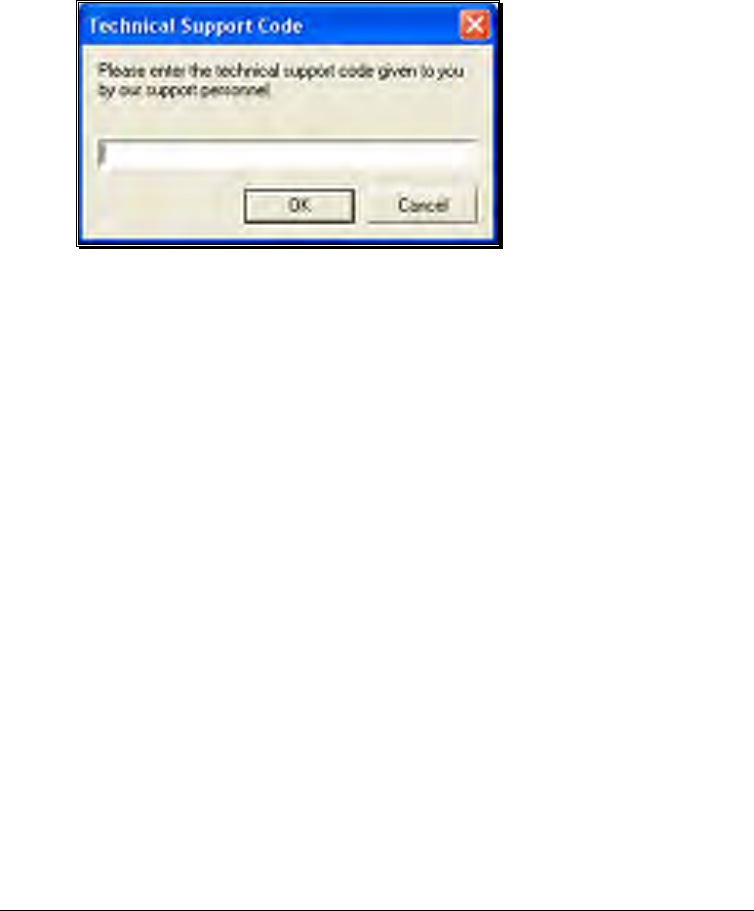
284
paste this information into your email. This will greatly assist them in
diagnosing the difficulty.
Reinstall DirectX
Choose this option to reinstall DirectX. Occasionally this will fix corrupted
installations.
Enter Technical Support Code
Choose this option to enter a technical support code. If you do encounter
problems running RealFlight, our Technical Support team may supply you
with a code to input here. Entering this code will help them diagnose or
resolve your difficulty.
Email Technical Support
This gives you the email address rfsupport@greatplanes.com to which you can
email your difficulties. If you do email us, please be sure to attach the
Assemble System Information output to your email.
You will receive an auto-reply message back confirming that Great Planes
Support Staff received your email. If you do not receive the auto-reply
message, please double-check that you sent your email to the correct email
address.
Assemble System Information
Choose this option to collect critical information about your system, and about
your RealFlight settings. You may find this information useful if you try to
troubleshoot problems on your own. Moreover, if needed you can cut and
paste this information into an email to Great Planes Support Staff.
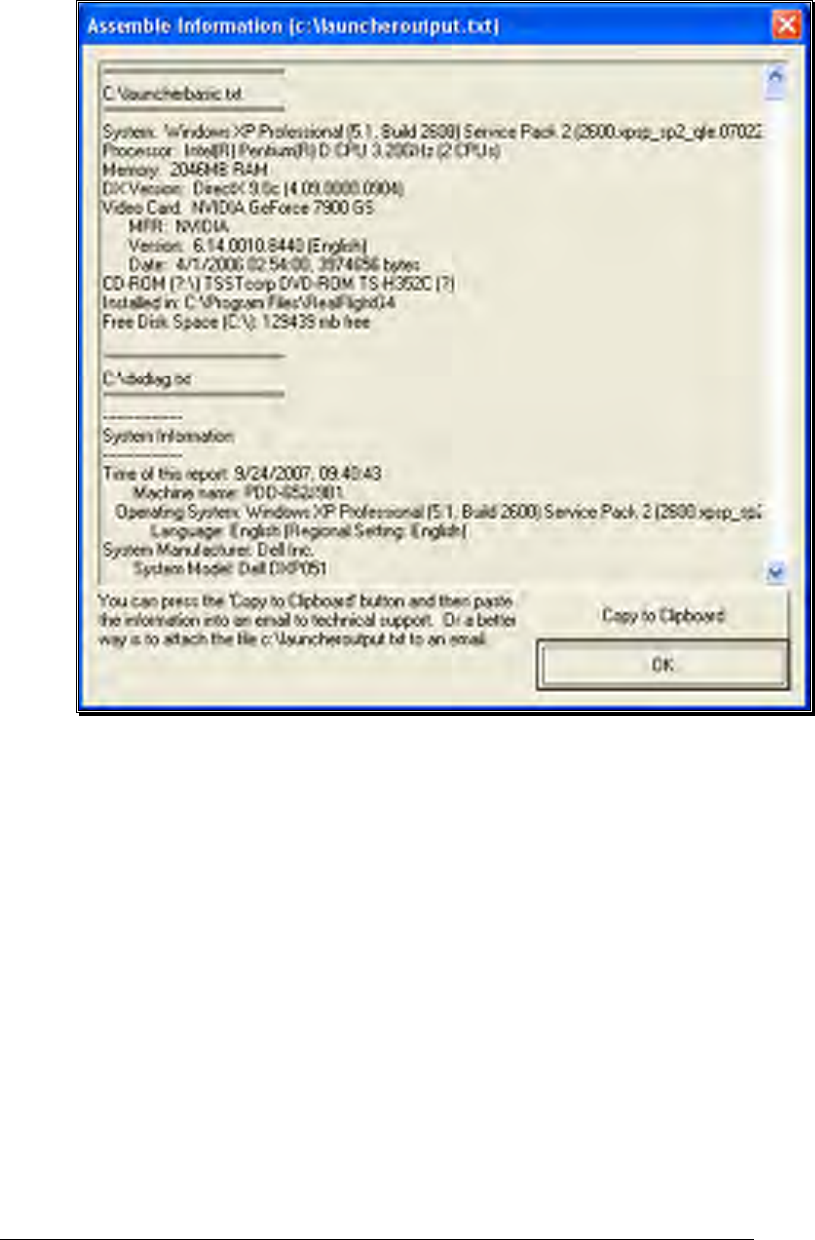
285
View Web Technical Support-
Choosing this option will open a browser window, and take you to a web site
that contains the most up-to-date technical support information for RealFlight
G4.
View Tasks-
This shows you a list of all tasks that are running on your computer. Some
tasks can interfere with RealFlight G4 and may need to be closed.
Include Serial Numbers-
Check this box if you plan to assemble all system information to send to Great
Planes Support Staff. If you are sending this information to anyone else, don’t
check this box. The serial numbers are unique to you, and should only be
shared with Great Planes Support Staff.

286
DX Diagnostics-
This brings up Microsoft’s DXDIAG utility. Using this utility can further help
diagnose your system.
Important: if you send us information about your system to help us diagnose a
problem, please do not use DXDIAG to generate that information. Instead,
please use the “Assemble System Information”. The “Assemble System
Information” output file contains more information than the DXDIAG
output.
MSInfo-
This option will run MSInfo. This will give you even more information about
your system. This program is not always installed a particular computer, but
normally comes with programs such as Microsoft Office®.
Display Properties-
This brings up the display properties for your monitor. You can use this page
to change the resolution of your desktop.
Explorer-
This button launches Windows Explorer. This Microsoft Windows utility can
help you locate, move and backup your files.
Launch Device Manager-
This button launches the Device Manager. This Microsoft Windows utility
will help you determine driver dates, as well as installing and updating video
and sound card drivers.

287
If You Experience
Difficulties
Tips and tricks for solving the more common problems.
he RealFlight G4 simulator is on the cutting edge of technology, and therefore
operates using advanced hardware. Consequently, there is always the remote
possibility you may experience a few slight difficulties. Should the need arise,
we provide extensive resources to help.
Besides providing the best R/C simulator, we sincerely feel that we provide the best,
most extensive product support for any R/C simulator. Since cards, drivers, and
operating systems are always changing, we work hard to keep our support team up-to-
date on the latest information available to ensure that you have the most enjoyable
experience possible.
This section begins with a summary of the various sources of RealFlight G4
information including support and problem solving assistance. Then, we will show
you some simple but powerful steps that can resolve or prevent most RealFlight G4
difficulties. Finally, if these steps fail to solve your difficulty, we will explain the most
effective ways to acquire additional assistance.
How to Get Help and Information
As a RealFlight G4 user, you have access to an incredible amount of information about
this product. Much of this information can help you resolve difficulties, or correctly
access and use program features. Here is where you can find it:
• The manual. Most common RealFlight difficulties can be resolved by following
the instructions in later sections of this chapter. However, there is also additional
information throughout other chapters that may be of assistance.
Appendix
C
T

288
• Visit our product Knowledge Base at http://www.gpsoftware.com. This is a great
resource and is an indexed, searchable collection of articles that describe solutions
to almost every known situation with RealFlight, RealRace, and all of our other
software products. In fact, this is the same information database used by our
product support technicians.
• Visit the Knife Edge Software Message Boards at
http://www.knifeedge.com/forums/. This is a place where owners of RealFlight,
RealRace, and other Knife Edge products post questions, comments and
responses. Sometimes our product support technicians and product developers
from Knife Edge post replies and announcements as well. You may find a thread
that discusses the same difficulties that you are experiencing.
• Contact our Technical Support department by email at:
rfsupport@greatplanes.com. Alternatively, our staff is also available via telephone
or postal mail at:
RealFlight Technical Support
3002 North Apollo Drive
Suite #1
Champaign, IL 61822
Voice phone: (217) 398-8970(Option 1)
FAX: (217) 398-7721
The product support teams are specially trained, and have many resources to help
you resolve problems with RealFlight G4.
Before You Do Anything Else
If you are experiencing difficulties with RealFlight G4, you should always try the steps
below first. These steps really do cure most problems our users experience. Even if
you are not having a problem, these same steps often assist in the operation of both
RealFlight and your computer.
Here are the steps you should take (instructions for each step follow):
• Update your video and sound card drivers (see instructions below).
• Update to the latest version of RealFlight G4.
• If the problem persists, run the DirectX test programs.
• If these steps do not work, proceed to the next section.

289
Update Your Drivers-
Before you do anything else, you should make sure you have updated your video and
sound drivers. A large number of difficulties encountered by RealFlight users can be
cured by updating drivers.
A driver is a software program that controls your video or sound card. Each card
manufacturer provides drivers for its own cards. To work correctly, RealFlight relies
on your video and sound card drivers.
It is very important to use the latest available driver for your card. Card manufacturers
frequently release updated drivers to fix problems that occur when the driver is used
with programs such as RealFlight G4. The driver that came with your new computer,
on your Windows CD-ROM, or on a CD-ROM included with the new card you
bought, may not be the latest version.
If you do not know how to update drivers, you can find instructions in our Knowledge
Base article Q01-1038, How to Update Drivers, at http://www.gpsoftware.com/kb/q01-
1038.htm. This page will take you through the process step-by-step, and has links to
driver download sites for most manufacturers.
Update to the Latest Version of RealFlight G4-
As we regularly release program updates, the difficulty that you are seeing may already
be fixed in an update. Even if you just bought RealFlight, you should update to the
latest version. It’s free and only requires a few minutes of your time.
Run the DirectX Test Programs-
If you have updated your drivers and RealFlight to the latest versions, and your
problem persists, you should try to run the DirectX samples that come with RealFlight.
The DirectX samples (DirectDraw, Direct3D, Sound, etc.) are test programs written by
Microsoft. These samples ship with DirectX, and are designed to check whether your
DirectX installation, video/sound cards and drivers, etc., are working correctly. They
should work on any DirectX 9 compliant driver.
These samples are found in the Technical Support area of the software. Click the
Technical Support button followed by the DX Diagnostics button. Next, click either
the Sound or the Music tabs, then the Test DirectX Music/Sound buttons. Once
these tests have been completed, press the Display tab to access the Test DirectDraw
and TestDirect3D buttons.
The most important tests are DirectDraw and Direct3D, both of which test your video
card and driver. If you are having any graphics difficulty in RealFlight G4 (including
RealFlight G4 “freezing” your system so that you have to reboot), look for the same
problem in these tests. If the problem occurs only after you have run RealFlight G4
for a long time, make sure to run the tests for a comparable length of time.

290
If your RealFlight G4 problem also occurs in Billboard, the problem lies with your
video driver, not RealFlight G4. To resolve the problem, try finding updated drivers
for your card (see above). If the problem still occurs with the latest drivers, you will
need to report this problem to the card manufacturer. Be sure to tell them that you
tested the card by using Billboard. Please note: in rare cases, a newer video driver may
have more problems than a previous version. After exhausting all other options, you
might try obtaining an older driver from the manufacturer to eliminate this possible
cause as well.
If You Need Additional Assistance
If you have updated drivers and updated RealFlight G4, your system successfully runs
the DirectX sample programs, and you are still having problems. What next?
As a first step, we suggest checking our Knowledge Base at
http://www.gpsoftware.com. This is an easy to use, searchable, browsable database of
known problems and solutions for RealFlight, RealRace, and our other software
products. This is the same database that our Product Support technicians use when
helping customers. We constantly update the knowledge base to address new
problems as we discover them. In many cases, you will be able to find an article that
gives clear, concise instructions for resolving your difficulty.
You may also want to check the Knife Edge Message Boards at
http://www.knifeedge.com/forums/. This is a place where owners of RealFlight,
RealRace, and other Knife Edge products post questions, comments and responses
about problems. You may find a discussion thread about the problem you are
experiencing.
You can also contact Technical Support at Great Planes via email at:
rfsupport@greatplanes.com.
IMPORTANT. If you do contact Technical Support, you can help us enormously by
providing detailed information about your computer system. Since your problem may
only occur on a particular video or sound card, particular driver version, etc., we may
need this information to help us diagnose your problem. To compile your system
information, use the RealFlight G4 Launcher. Click the Additional Options button.
Next, click the Technical Support button, followed by the Assemble System
Information button. This will create a file called “c:\launcheroutput.txt”, which
contains your system information. Attach this file to an email and send it to us at
rfsupport@greatplanes.com.

291
Examples of Common Problems and Solutions
If You Don’t See Your Problem in This Chapter-
This chapter contains a few examples of common difficulties and concerns that
RealFlight users have experienced.
Remember that we can never provide a complete list of difficulties and solutions in a
program manual. That’s because RealFlight--and the computers, cards and drivers it
uses--are constantly evolving. As such, we maintain a detailed Knowledge Base at
http://www.gpsoftware.com. By keeping our Knowledge Base online, we can provide
you with the latest information about resolving any difficulties that might arise. If you
don’t see your difficulty described in this chapter, please check the Knowledge Base.
In this chapter, we’ve simply tried to pick a very short list of the most asked about
issues.
My computer “freezes” when I run RealFlight-
Sometimes, you may also notice sound skipping or repeating, or a computer reboot
while flying. To resolve this type of problem, you must update the drivers for your
video and sound cards.
This is very important
. Card manufacturers regularly update
their drivers to fix this type of problem. Even the driver that came with your new
computer may not be the most recent.
Sometimes a card manufacturer will offer a choice between a “recommended” driver,
and another driver (variously called “special purpose”, “alternate”, or “beta” driver). If
RealFlight G4 “freezes” with the “recommended” driver, try using the alternate driver
instead.
If you are sure that you are using the latest drivers, and have followed all the other
steps in the previous section (update RealFlight G4, test DirectX) and are still having
difficulty with your computer locking up while running RealFlight, please contact Great
Planes Technical Support.
Improving RealFlight G4 Performance-
During installation, RealFlight G4 analyzes your computer’s hardware specifications.
RealFlight G4 then tries to optimize its configuration to best take advantage of that
hardware, and achieve the best possible performance.
However, if the performance is less than you desire, you can adjust some of RealFlight
G4’s settings to improve the simulation speed and frame rate:
• Ensure that the drivers for the video and sound cards are up-to-date.
• Turn off all other programs, especially virus checkers and network applications
(such as Instant Messengers) while running RealFlight G4. Use CTRL-ALT-

292
DELETE and check the Task Manager to verify that nothing else is running in
the background.
• Reduce the texture and water quality. This can have a profound effect on cards
that do not have a high texture memory. See the Settings section starting on page
75 for more information.
• Eliminate the items shown in the simulation. To do so, access the View menu title,
then access the Show menu item. Click an item type to remove it from the
simulation. It may be necessary to eliminate several items before performance
meets your expectations.
• Reduce the number of open Gadgets and Viewports. Click the ‘X’ on each Gadget
or Viewport that you wish to close.
• Reduce the number of recordings currently in use.
Other Common Problems-
Here are some other things you may want watch for.
• Check the CD-ROM for scratches or blemishes. Even minor scratches or
fingerprints can cause random problems that appear to be program bugs.
• Make sure your hard drive has at least 500 MB of space available. To check this:
1. Double click on the My Computer icon on your desktop
2. Right click on your main hard drive (usually drive “C:\”)
3. When the popup menu appears, select Properties
4. In the dialog that appears, view the amount of space available on the drive
If you need additional space, try emptying the Recycle Bin.
• Verify that all other programs are closed prior to starting RealFlight G4. RealFlight
works best when it is the only program running.
• If all else fails, try rebooting your computer. Occasionally, Windows (particularly
98 and ME) may become unstable after prolonged and continuous use. A simple
reboot may clear up any difficulties.

293
Glossary
180-Degree Turn
R/C Term This basic flight practice starts with a takeoff, and
then demonstrates 180 degree turns on a flight path
parallel to the runway.
360-Degree Turn
R/C Term In this practice, you will learn to fly the aircraft in a
complete circle (360-degree turn). This maneuver is
a great way to learn control inputs for turns while
keeping the same radius and altitude.
3D Acceleration
Computer Term 3D operations require a huge number of
calculations. Modern computers offload many of
these calculations to the video card, rather than
performing the calculations directly on your
computer's CPU. This speeds up the simulation
and allows for faster frame rates, thereby increasing
the realism of the simulation.
ATV
R/C Term Amount of servo travel. For instance, 50% ATV
would mean the servo's maximum travel is 50% of
its physical limit.
AccuModel
RealFlight Term RealFlight G4’s AccuModel aircraft editor offers the
most powerful, most flexible aircraft editor ever
released in an R/C simulator.
Active View
RealFlight Term The active view is the view that is affected by the
commands in the View menu. Only one view at a
time is active. You can make a view active by
clicking on it with the mouse. When you want to
control a view’s properties, you must first make it
the active view.
Advanced Flight Recorder
(AFR)
RealFlight Term
This feature allows the pilot to not only view
prerecorded maneuvers, but also allows them to
record their own. During the playback of
maneuvers, the pilot has the ability to select from a
number of different options such as fast forwarding,
rewinding, looping, speeding up and slowing down
the recordings. These recordings may also be sent
to others via the internet. The pilot can also activate
an on-screen transmitter to watch the stick inputs
for each pre-recorded maneuver.

294
Adverse Yaw
R/C Term The tendency of an airplane to yaw in the opposite
direction of the roll. For instance, when right aileron
is applied, the airplane yaws to the left, thus
opposing the turn. Adverse yaw is common in
trainer type airplanes having flat bottom wings. It is
most noticeable at slow speeds and high angles of
attack, such as during takeoffs and when stretching
a landing approach. Caused by the unequal drag of
the upward and downward deflection of the
ailerons, this undesirable trait can be minimized by
setting up the ailerons with Differential Throw or
by coordinating the turns, using the aileron and
rudder controls simultaneously.
Aileron
R/C Term Hinged control surfaces located on the trailing edge
of the wing, one on each side, used to provide
control of the airplane about the roll axis. The
control direction is often confusing to first time
modelers. For a right roll or turn, the right hand
aileron moves upward and the left hand aileron
moves downward. The movements are reversed
for a left roll or turn.
Airfoil
R/C Term A surface (such as a wing or propeller blade) with a
shape and orientation such that it provides or
controls stability, direction, lift, or propulsion.
Airframe
RealFlight Term A term used to describe the general components of
an aircraft when using RealFlight G4’s AccuModel
aircraft editor. For example, selecting the airframe
will call up the fuselage, wing(s) and tail of an
airplane.
Angle of Attack
R/C Term The angle that the wing penetrates the air. As the
angle of attack increases so does lift and drag, up to
a point.
Arm
R/C Term In this context, the arm is the distance from the
point of the application of a force to the axis of
rotation. If you press down on the tip of a wing, for
example, the arm is the distance from the point
where you are pressing to the root of the wing.
Auto-Play
Computer Term A Windows feature that automatically detects when
a CD-ROM is inserted and runs the specified
program on the CD-ROM.

295
Autorotation
R/C Term A maneuver in which the pilot attempts to bring the
helicopter in for a landing without power from the
engine. The momentum of the spinning rotor
blades is enough to slow the helicopter prior to
landing.
Autorotation Event
RealFlight Term An event where players attempt to autorotate onto a
target (similar to Spot Landing). Each player takes a
turn. Players collect different point amounts based
on landing location. The Autorotation Event works
for helicopters only. The Deadstick Event is for
airplanes.
Avalanche
R/C Term The Avalanche is a loop with a snap roll at the top
of the loop. This snap roll must be centered at the
top of the loop.
Bloom Effect
RealFlight Term The effect creates a feathering of light around
brighter objects, giving it a more realistic look. This
is more noticeable at brightly lit airports around
aircraft that are lighter in color.
Channel Mapping
RealFlight Term This term describes the ability of RealFlight G4 to
alter the mapping or input of the servos to
accurately reflect the actual controls from an R/C
controller.
Chat
RealFlight Term This is a real-time communication between two G4
users which is conducted via the PC. G4’s
multiplayer feature enables a public chat if so
desired.
Child/Children Item(s)
RealFlight Term In many of RealFlight G4’s selection windows,
items are displayed in a hierarchy format. An item
that belongs to a higher group, or parent, is
considered the child item.
Chord
R/C Term The chord of a wing or surface is the width of the
surface. A wider chord offers increased lift.
However, a wider chord also generates more drag
when the aircraft rolls.
CG
R/C Term CG is the abbreviation for the phrase Center Of
Gravity. This is the point at which the aircraft
balances fore to aft and side-to-side. The location
of this point is crucial to how the aircraft reacts in
the air. For airplanes, a tail-heavy plane will be very

296
snappy, but generally unstable and susceptible to
frequent stalls. Conversely, a nose-heavy plane will
tend to track better and be less sensitive to control
inputs, but will generally drop its nose when the
throttle is reduced to idle. This makes the plane
more difficult to land, since it takes more effort to
hold the nose up. A nose heavy airplane will have
to come in faster to land safely.
Collective
R/C Term A mechanism on a helicopter that changes the pitch
of the main blades, thereby allowing the helicopter
to ascend or descend accordingly. This is the
control that adjusts the pitch of the rotor blades.
Collision Detection
RealFlight Term RealFlight G4 sports the most advanced collision
detection modeling ever used in an R/C model
simulation. It blankets the entire aircraft, ensuring
accurate modeling of the aircraft when it collides
with objects and items within the simulation.
Coning
R/C Term When a helicopter hovers, the blades form a slight
"cone" when viewed from the side. The Coning
effect is caused by the balance between lift and
centrifugal forces on the blades.
Control Surface
R/C Term Generally defined as the portion of the airfoil that
moves. Examples include ailerons, elevators,
rudders, flaps, and spoilers.
Controller
RealFlight Term
A
device used to control an aircraft in RealFlight.
G4 ships with the Great Planes’ USB InterLink
Elite Controller by Futaba. This device can be used
as a standalone controller, or as an interface to use
your own R/C transmitter. Previous versions of
RealFlight shipped with either a Futaba game port
controller or a Transmitter Adapter Interface. For
information on the latter two controllers, please see
the manuals that came on the program CD with
those versions of RealFlight.
Cuban Eight
R/C Term This maneuver requires that the pilot perform a half
roll on each of the descending forty-five degree
down lines, allowing the pilot to fly a horizontal
figure eight without performing an outside loop.
Cyclic
R/C Term Refers to the changing of a main rotor blade's pitch
as the rotor head rotates. Pitch is added while the
blade is pointing in one direction (e.g. while the

297
blade is over the canopy), and removed while the
blade is pointing the the opposite direction (e.g.
while the blade is over the tail boom). This causes
the helicopter to pitch and roll.
Data Lever
RealFlight Term RealFlight G4’s InterLink Elite has the ability to
make on-screen selections, or quickly look at the
windsock or ground. This can be done with the
Data Lever, located at the bottom right-hand corner
of the InterLink Elite controller.
Deadstick
R/C Term A term used to describe unpowered flight (glide)
when the engine ceases operation.
Deadstick Landing Event
RealFlight Term See Autorotation Event. The Deadstick Landing
Event is specific to airplanes.
Dihedral
R/C Term The V-shaped bend in a wing. Increasing the
dihedral usually enhances the aerodynamic stability
of an airplane, and causes the rudder to control
both the roll and yaw axis. This is why some
trainers and sailplanes require only three channels of
radio control (i.e., they have no ailerons).
Direct Control Interface
RealFlight Term This is a method for using your own radio to
completely control the aircraft. This usually means
you have a separate radio program on your radio for
each aircraft that you want to fly in RealFlight G4
with this method. All mixing and radio functions
are performed on your radio and RealFlight simply
passes the values directly to the aircraft servos. This
is in contrast to the Joystick Emulation Interface.
Direct3D Technology
Computer Term A Microsoft DirectX technology used to render the
3D image when you have a graphics accelerator
card. It works best on faster computers.
DirectX
Computer Term A technology created by Microsoft that controls
graphics and sound operations.
Dithering
R/C Term A method of removing and/or simulating colors
that may not be available to the graphics processing
unit.
Down Thrust
R/C Term This is the downward angle of the engine in
relationship to the centerline of the airplane. Down
Thrust helps overcome the normal climbing

298
tendency of flat bottom wings.
Driver
Computer Term A software program that controls a card (e.g., video
or sound card) in your computer. Card
manufacturers usually provide drivers as well. Card
manufacturers frequently update their drivers to fix
bugs or to make their cards compatible with new
software and hardware. You can often find an
updated driver for your video or sound card by
visiting the card manufacturers web site and
following links to “Drivers,” “Support,”
“Downloads”, or “Upgrades.”
Edit NavGuides
RealFlight Term A NavGuide is a gadget that displays continuously
updated information about your aircraft. The Edit
NavGuides dialog is used to customize the
NavGuides gadgets.
Elevator (Maneuver)
R/C Term The Elevator is a maneuver in which the aircraft is
made to stall completely with a large amount of
elevator throw. The aircraft will descend almost
vertically much like an elevator. To perform the
Elevator, make sure that you have sufficient altitude,
dive the aircraft vertically towards the ground and
pull full up on the elevator stick.
Elevator (Control Surface)
R/C Term Hinged control surface located at the trailing edge
of the horizontal stabilizer, which provides control
of the airplane about the pitch axis and causes the
airplane to climb or dive. The correct direction of
control is to pull the transmitter Elevator control
stick back, toward the bottom of the transmitter, to
move the Elevator upward, which causes the
airplane to climb. Move the Elevator in the other
direction to dive.
Endpoint Adjustment
R/C Term This radio feature adjusts the length of servo travel
in one direction (a single channel will have
adjustments for two endpoints). If, for example,
your aircraft rolls faster one way than the other,
endpoint adjustments can correct the problem.
Event
RealFlight Term An organized flying contest with a set of rules.
RealFlight G4 currently supports five types of
Events: Limbo, Spot Landing, Pylon Racing,
Autorotation/Deadstick and Freestyle. You can
participate in Events by yourself or with other
RealFlight users over the internet. Use the Event

299
menu to start an Event.
Exponential
R/C Term A feature commonly found on computer radios that
desensitizes the servo when the sticks are close to
the neutral position. The further the stick position
from center, the faster the control response.
Figure 8
R/C Term This is an excellent maneuver to learn perspective
and orientation of the aircraft from all angles. Use
the ailerons and elevator to turn the aircraft left and
right. Use the elevator to ensure that the aircraft
maintains a constant altitude, forming an ‘8’ in the
sky.
Flap
R/C Term For Airplanes: hinged control surface located at the
trailing edge of the wing inboard of the ailerons.
The Flaps are lowered to produce more
aerodynamic lift from the wing, allowing a slower
takeoff and landing speed. Flaps are often found on
scale models, but usually not on basic trainers.
For Helicopters: Flapping is an up-and-down
motion of the main rotor blade's tip. With a "dual-
damped" head, (as used in the Kyosho Concept
helicopters, for example) both blades are able to
Flap independently. With "solid axle" heads (as
used in the Hirobo Shuttle helicopters, among
others), moving one blade up causes the other to
move down.
Flapping Head
R/C Term This describes a type of rotor head in which the two
blades are not connected directly. Each blade is
independent of the other, usually resulting in a
helicopter with smoother performance.
Flare
R/C Term The point during the landing approach in which the
pilot increases the amount of up elevator to smooth
the touchdown of the airplane.
FlexiField
RealFlight Term FlexiField is the most advanced flying site editor
ever unveiled. It presents the modeler with the
ability to adjust the flying site in virtually any
manner desired. The user can add trees, selecting
the type, size and color; add, move, size and orient
buildings, walls and other scenery objects; position
and orient the runway; even choose the amount and
type of lighting at the flying site.

300
Flight Failures
RealFlight Term RealFlight G4 authentically recreates common
difficulties that may be experienced at your local
flying site. Practicing with flight failures enabled is a
good way to practice for emergencies.
Flight Playback Gadget
RealFlight Term A gadget that lets you control playback of flight
recordings using mouse actions.
Float Fly
R/C Term The ability to takeoff and land a radio controlled
aircraft from water.
Flybar Paddles
R/C Term These are the short blades on the end of the flybar.
Available in a variety of weights and airfoils, these
paddles assist the main blades in producing lift, etc.
Four-Point Roll
R/C Term These maneuvers are very similar to a slow roll with
the exception of a hesitation at either ¼ of the roll
or at 1/8 of the roll. It is important to remember to
use rudder and elevator to keep the aircraft flying in
a straight line.
Frame Rate
Computer Term Frame Rate is the number of times per second that
RealFlight creates a different picture to display on
your monitor. Frame rate is determined by the
speed of your CPU and graphics card, and how
many RealFlight options you turn on. This is not
the same as refresh rate, which is the number of
times per second that your monitor retraces an
image on its screen.
Freestyle Event
RealFlight Term
A
n event where players decide on the rules.
RealFlight G4 sees that each player gets a turn; it is
the players’ responsibility to
j
udge the competition.
Use this event when you have devised a group
activity that requires every player to take a turn.
Fuselage
R/C Term Generally speaking, this is the main part of the
airplane that holds the wings and engine. The
fuselage is often thought of as the “body” of the
airplane. This term is also used to refer to a “body”
that might be used on helicopters.
Futaba
R/C Term Maker of high quality R/C products, including the
USB InterLink Elite controller shipped with
RealFlight G4.
Gadget
RealFlight Term An on-screen display that shows you continuously
updated information about your aircraft, or lets you

301
control RealFlight features using mouse clicks.
Global Wind
RealFlight Term This term describes the overall wind conditions in
the simulation.
Governor
R/C Term A device used to help maintain a constant RPM
(head speed). Generally used in helicopters rather
than airplanes.
Grouping
RealFlight Term A collection of scenery objects or foliage objects in
your airport. Every object in the airfield must
belong to one Group. You can place all of your
airport's scenery objects in a single Group, or create
multiple Groups to place objects in categories with
related objects. For example, you could have a
Group for Trees and another group for Buildings
within a particular airport.
Gyro
R/C Term A device, most commonly used in helicopters, that
aids in controlling the yawing action of the
helicopter by automatically adjusting the deflection
of the tail rotor blades.
HAL Device
Computer Term A hardware-accelerated 3D video card driver.
“HAL” is an abbreviation for the phrase “Hardware
Abstraction Layer” that uses software drivers to
communicate between RealFlight’s software and the
hardware of the PC.
Harrier
Computer Term A Harrier is a slow forward progression of the
aircraft with the nose held high. Use the elevator to
stall the forward progress of the aircraft. Add in
more up elevator until the nose approaches 45
degrees. The throttle should be used to control the
forward progress of the aircraft, without climbing.
Host
RealFlight Term In RealFlight G4, every multiplayer session requires
one player to serve as Host. The Host starts the
session, and then the other players join. Other
players can leave the session whenever they want,
but only the Host can terminate the entire session.
The Host must start any multiplayer event (Limbo,
Spot Landing, Pylon Racing, Autorotation,
Freestyle).

302
Hot Pluggable/Hot
Swappable
Computer Term
A device is said to be Hot Pluggable or Hot
Swappable when you can safely connect or
disconnect it without turning off your computer or
rebooting.
Hub
R/C Term The centralized mechanical device used to attach
the main rotor blades and paddles.
Humpty-Bump
R/C Term This aerobatic maneuver consists of two vertical
lines connected by a half circle flown across the top.
IP Address
Computer Term Whenever your computer is connected to the
internet, it has an IP address. This number is a
string of digits and periods, and looks something
like “123.45.6.78”. The IP address is like an internet
“zip code” that tells other computers where to look
for your computer. Depending on your internet
connection, your IP address may always be the
same, or may change each time you connect to the
internet. For other RealFlight G4 users to join your
Multiplayer session, they must obtain your IP
address. You can either provide it to them directly,
or post it through the RealFlight list server.
Immelman Turn
R/C Term The aircraft will enter a half loop from straight and
level flight followed immediately by a half roll to
straight and level flight.
Interface Mode
RealFlight Term With RealFlight G4 set to Interface Mode, you are
using the InterLink Elite Controller as an interface
to your own R/C radio. In Interface Mode, your
own radio controls RealFlight G4. Conversely, in
Joystick Mode the InterLink Elite Controller (used
as a mockup of a R/C transmitter) controls the
RealFlight G4 aircraft.
InterLink Elite Controller
RealFlight Term Great Planes’ USB InterLink Elite Controller by
Futaba is a USB device shipped with RealFlight G4.
The InterLink Elite Controller can be used as a
standalone “mockup” R/C controller, as an
interface for using your own R/C transmitter to
control RealFlight, or both simultaneously!
Joystick
Computer Term A device that connects to your computer to provide
control input for the simulated aircraft. The
InterLink Elite controller that comes with

303
RealFlight G4 is considered a Joystick.
Joystick Emulation Interface
RealFlight Term A term used to describe using your own radio to
emulate the Interlink Joystick. This allows you to
use your own radio to fly any of the stock aircraft in
RealFlight G4. Actual radio functions such as
mixing and ATVs are performed in the RealFlight
software, not on your radio. This is in contrast to
the Direct Control Interface.
Joystick Mode
RealFlight Term With RealFlight G4 set to this mode, RealFlight G4
is controlled by the InterLink Elite controller used
as a mockup of a R/C transmitter.
Launcher
RealFlight Term The RealFlight G4 Launcher is useful for many
aspects of the G4 program, including loading the
simulator, compiling system information for
technical support, or uninstalling RealFlight.
LAN
Computer Term Local Area Network. This is usually a network
where the computers are connected with high speed
network cards.
Lead Lag
R/C Term A helicopter term describing the hinge point where
the blade attaches to the hub. This allows the blade
to move forward and backward at certain times
during the blades rotation.
Leading Edge
R/C Term The very front edge of the wing or stabilizer. This is
the edge that hits the air first.
Limbo
R/C Term An event (flying competition) in which pilots take
turns flying their aircraft under a Limbo bar. The
pilot that clears the lowest bar height wins.
List Server
RealFlight Term RealFlight G4’s Multiplayer function lets you
publicly “post” your session, so that any RealFlight
G4 user, anywhere in the world, can find out about
your session and join you (assuming you have not
reached the enrollment limit of your session). The
place where you post your session is called a List
Server. Use of the List Server is optional. You can
preserve privacy by not posting your session, and
privately communicating your IP address to your
selected multiplayer partners.
Please note that the free, public list server for use by
RealFlight owners may be modified or discontinued

304
without notice at any time.
Low Rates
R/C Term A switch on the radio that reduces the servo
movement to much smaller extremes, thus making
the model respond more slowly to a given control
input.
Mode
R/C Term Also known as Flight Mode or Stick Mode, this
refers to the transmitter's gimbal stick assignments
(locations) which determine the flight mode of your
controller. There are two main modes of control,
Mode 1- mostly used in Europe and Mode 2 which
is the predominant method of controlling aircraft
commonly used in the United States.
Most Recently Used (MRU)
Computer Term MRU refers to the list of documents which were
last accessed. For RealFlight G4, MRU’s appear for
airports, aircraft and recordings.
MultiMode
RealFlight Term A G4 feature that allows two users to fly
simultaneously on the same PC.
Multiplayer
Computer Term A RealFlight G4 feature that uses Microsoft's
DirectX technology to connect with other
RealFlight G4 users over a network.
Multiplayer Session
RealFlight Term A network connection between RealFlight G4 users
that allows each user to fly in the same "virtual
world," and allows all participants to see and interact
with each other's aircraft.
NavGuides
RealFlight Term A gadget that displays continuously updated
information about your aircraft and the virtual
world.
Parent Item
RealFlight Term In many of RealFlight G4’s selection windows,
items are displayed in a hierarchy format. An item
that has additional item within it is considered the
parent item.
PhotoField
RealFlight Term A technology that creates a flying field by using a
panoramic photograph as a background for a flat
terrain.
Pirouette
R/C Term The yawing action of a helicopter that looks much
like an ice skater spinning in a circle. One Pirouette
is equal to one 360-degree rotation.

305
Pitch Axis
R/C Term The airplane axis is controlled by the elevator. Pitch
is illustrated by holding the airplane at each wingtip.
Raising or lowering the nose is the pitch movement.
This is how the climb or dive is controlled.
Plumb String
R/C Term When you measure your aircraft for RealFlight,
some measurements require that you have a
reference line running straight up and down. To
make such a line, we tie a weight to the free end of a
string, and let the weight dangle. Because the string
is then “plumb” (oriented straight up and down), it
is called a Plumb String. A Plumb String is
particularly useful in measuring an aircraft’s center
of gravity.
Point Rolls
R/C Term These maneuvers are very similar to a roll with the
exception of a hesitation at either 1/4 or 1/8 of the
roll.
Private Session
RealFlight Term A multiplayer session that is not published on our
list server. For a private session, the host must
distribute his/her IP address to each participant,
who must manually enter this information to join.
Propeller
R/C Term Props are generally designated by two numbers (for
instance, “10 – 6”). The first number is the length
(10" in the example) of the prop. The second
number is the pitch or angle of the blades. In this
example, the “6” represents the distance the
propeller will move forward in one revolution.
Public Session
RealFlight Term A multiplayer session that is published on a list
server.
Pylon Racing
R/C Term An event (flying competition) in which pilots take
turns flying their aircraft around a closed course.
Pylons mark the course perimeter. The pilot that
finishes the course first wins.
QuickSelect
RealFlight Term RealFlight G4 InterLink Elite allows you to make
changes to the simulator with the controller using
the buttons at the bottom. Manipulating these
buttons through the on-screen QuickSelect tabs
offer the ability to change aircraft, flying sites, and
more.

306
RAM
Computer Term Random Access Memory.
ReadySelect
RealFlight Term This is the name given to RealFlight G4’s rotating
preview box. This allows a rapid view of the aircraft
from all angles.
RealPhysics 3D
RealFlight Term This is RealFlight’s exclusive physics modeling
technology. RealPhysics 3D authentically replicates
the actual physics of model aircraft by performing
hundreds of thousands of floating point calculations
each second while delivering sizzling real time
performance.
Refresh Rate
Computer Term The number of times per second that your monitor
retraces an image on its screen. This is different
from the Frame Rate.
Resolution
Computer Term When used in the context of screen Resolution, this
term describes the picture quality of the screen.
Lower Resolutions will produce an image that is not
as sharp as higher Resolutions.
Roll Axis
R/C Term The airplane axis controlled by the ailerons. Roll is
illustrated by holding the airplane by the nose and
tail. Dropping either wingtip is the roll movement.
Roll is used to bank or turn the airplane. In most
airplanes, the ailerons control roll. However, when
the main wing has dihedral, the plane can be banked
using the rudder only. Consequently, many planes
with wing dihedral do not have ailerons, and the
rudder controls both roll and yaw. This is one
reason why most trainer aircraft have a large
amount of dihedral -- a plane with large dihedral can
be controlled using fewer input channels.
Rolloff Factor
RealFlight Term This phrase describes how rapidly the volume of a
sound increases or decreases as the source draws
closer or moves farther away.
Root
RealFlight Term In many of RealFlight G4’s selection windows,
items are displayed in a hierarchy format. The
upper most item in this hierarchy is considered the
Root item.
Rudder
R/C Term Hinged control surface located at the trailing edge
of the vertical stabilizer, which provides control of
the airplane about the Yaw axis (causing the airplane

307
to Yaw left or right). Left Rudder movement
causes the airplane to Yaw left, and right Rudder
movement causes it to Yaw right.
Servo
R/C Term An electromechanical device that moves the control
surfaces or throttle of an airplane according to
commands from a receiver. This device does the
physical work of moving parts around inside the
aircraft.
Session
RealFlight Term See "Multiplayer Session."
Software Radio
RealFlight Term This term describes RealFlight G4’s ability to
accurately mimic a computer transmitter (complete
with mixing, etc.) in the simulation.
Sound Card
Computer Term A card inside your computer that controls audio
(what you hear over your computer speakers).
Most sound cards plug into your computer’s
motherboard. You can upgrade your sound card
(or the software driver that controls it) without
getting a new computer.
Specular Highlights
Computer Term A graphics rendering technique that makes surfaces
(e.g., MonoKote™) appear reflective, or “shiny”, in
direct light (e.g., sunlight).
Split S
R/C Term The Split S is another step in learning to combine
loops and rolls and is a great maneuver to decrease
your altitude. A half roll precedes a half loop,
making the maneuver a mirror image of the
Immelman. The Split S provides course reversal
and an easy increase in speed.
Spot Landing
R/C Term An event (flying competition) in which pilots take
turns trying to touch their aircraft down within a
small marked landing area. Each pilot receives a
score based on touch down location. The pilot with
the highest score wins the event.
Stall
R/C Term When an airplane’s angle of attack is too great to
generate lift (regardless of airspeed), the plane will
dive and rapidly lose altitude. This is known as a
stall. Every airfoil has an angle of attack at which it
generates maximum lift. The airfoil will stall beyond
this angle.

308
Swash Plate
R/C Term The mechanism in a helicopter rotor that turns non-
rotating control movements into rotating control
movements.
Thermal System
R/C Term This phrase describes the wind flow and effects for
the thermals in RealFlight G4.
Throttle Hold
R/C Term This is used to keep the throttle at a set position, yet
allows input to the collective of the helicopter.
Generally this function is used to practice
autorotation.
Tip Stall
R/C Term This is when the airplane reaches its stall speed and
one wing drops.
Torque Roll
R/C Term The Torque Roll occurs when the nose of the
airplane is pointed vertically and the airplane hovers
in place. The aircraft will rotate left around its roll
axis.
Touch and Go
R/C Term Landing and taking off without a pause. Often
confused with a good bounce.
Trailing Edge
R/C Term The rearmost edge of the wing or stabilizer.
Trainer
R/C Term A model designed to be inherently stable and fly at
low speeds, to give first-time modelers time to think
and react as they learn to fly.
Training Aids
RealFlight Term RealFlight G4 offers a variety of features to learn
new maneuvers. These consist of training aids that
take you through, step-by-step, basic flight lessons,
such as Takeoffs and Landings for airplanes, and
Hovering practice for helicopters. Pre-recorded
lessons are also available from professional pilots.
TruFlo Wind Dynamics
RealFlight Term RealFlight G4’s TruFlo Wind Dynamics is the most
accurate wind model ever released in an R/C
simulator. It combines five different wind models
to recreate the ever-changing wind fields found at a
real flying site.
Turbulence System
RealFlight Term This is the ability of RealFlight to induce turbulent,
rough air, as would be experienced at the flying site.
USB
Computer Term USB, or Universal Serial Bus, is a connection
protocol for computer peripheral devices (like Great
Planes’ USB InterLink Elite Controller by Futaba).

309
USB technology allows you to connect multiple
devices to your computer, and supports high data
transfer rates and is hot swappable. USB devices
have a special connector that only fits into a USB
port. Most modern personal computers have USB
ports, which are usually clearly labeled. Some
computers have one or more USB ports on the
front of the computer housing, although the USB
ports are usually on the back of the computer.
Variometer
R/C Term An instrument designed to indicate the rate of climb
or descent of an aircraft.
Video Card
Computer Term A card inside your computer that produces the
images on your video monitor. Most modern 3D
video cards have accelerated 3D operations—that
is, they perform numerical calculations for rendering
a 3D scene, to free up your computer’s CPU to
perform other tasks. The video card plugs into your
computer’s motherboard. You can upgrade your
video card (or the software driver that controls it)
without replacing your computer.
Viewport
RealFlight Term A picture-in-picture display set within the RealFlight
G4 main display. The Viewport is independently
adjustable and serves as its own unique “window on
the world”.
Virtual Flight Instruction
RealFlight Term This RealFlight G4 feature lets you choose from a
v
ariety of prerecorded maneuver training lessons.
The maneuver is then demonstrated on screen,
along with the instructor’s voice and control stick
movements. You can index, pause and even loop
the maneuver playback for training purposes.
VirtualRevolution
RealFlight Term This is the exclusive sound technology used by
RealFlight G4. As with the original RealFlight
programs, the sounds are Doppler-correct. If the
user’s sound card supports it, surround sound is
also available.
Washout
R/C Term An intentional twist in the wing, which causes the
wing tips to have a lower angle of attack than the
wing root. In other words, the trailing edge is
higher than the leading edge at the wing tips.
Washout helps to prevent tip stalls.

310
Waterfall
R/C Term The Waterfall is a maneuver where the plane pivots
360 degrees in the pitch axis with as little forward
motion and altitude deviation as possible. As the
name suggests, this maneuver resembles a waterfall
during flight.
Wing Loading
R/C Term The amount of weight per square foot that has to
be overcome to provide lift. It is normally
expressed in ounces per square foot. This
specification can be easily calculated as follows: first
determine the area of the wing in square inches.
T
hen simply divide by 144 to obtain square feet.
Divide the total weight (in ounces) of the airplane
by the wing area (in square feet).
This information is valuable when deciding on
which airplane to build next. Planes with high wing
loading must fly faster to stay in the air. These are
generally "performance" airplanes. Conversely, a
plane with lower wing loading does not need as
much air flowing around the wing to keep it flying.
Gliders and trainer airplanes fall into this category
because in this case, slow, efficient flight is highly
desirable.
Yaw Axis
R/C Term The airplane axis controlled by the rudder. Yaw is
illustrated by hanging the airplane level by a wire
located at the center of gravity. Left or right
movement of the nose is the Yaw movement.

311
Index
A
About, 262
AccuModel, 3, 293
Advanced Flight Recorder, 4, 293
Aerobatics, 269
AFR. See Advanced Flight Recorder
Aircraft Editor, 111
Add Component, 123
Aircraft Parts Tree, 119
Delete Component, 123
Parameter Window, 122
Preview Screen, 122
Show Wireframe, 119
Aircraft Menu, 107
Aircraft MRU, 20, 130
Aircraft Selection, 19, 108, 109
Description, 110
Specifications, 110
Aircraft Variant, 72
Airframe, 294
Airplane Basics, 267
Airplane Flight, 268
Airplane Hover Trainer, 216
Airplane Physics. See Physics
Airport Editing, 30
Airport MRU, 22, 106
Airport Selection, 21, 38
Airspeed, 245
Altitude, 245, 252
Arrange, 255
Attempts Per Turn, 161
Audio, 76
Auto-Play, 294
Autorotation, 149, 152, 295
Autozoom, 236
B
Base, 209
Battery, 252
Binocular, 246
Bloom, 94, 295
Boot Player, 185
Boundary, 204, 208, 212, 218
Brightness, 96
C
Camera, 79
Camera Position, 232
Camera Type, 231
Capture Screenshot, 58
Channel, 138
Channel Mapping, 137, 143, 295
Channel Modification, 141
Chase View, 232
Chat, 86, 179, 250, 295
Child, 45, 120, 295
Clear Aircraft Position, 128
Close All, 255
Clouds, 92
Cockpit View, 232
Collective, 271
Collisions, 100
Color Scheme, 71, 110
ColorSchemes, 126
Alpha Channels, 127
PowerReflectiveOff, 126
PowerReflectiveOn, 126
PowerSpecularOff, 126
PowerSpecularOn, 126
Reflectivity, 126
Specular, 126
Commands, 88
Commit Line, 160
Console, 80, 250
Contrast, 96
Controller. See InterLink Elite
Controller Calibration, 135, 141
Controller Menu, 133
Crash Eliminates Player, 151, 156, 161, 171
Crashing, 267
Crosswind, 204, 208
Cut Penalty, 165
Cuts Allowed, 165
Cyclic Stick, 273
D
Data Lever, 297
Deadstick, 149, 152, 297
Direction, 204, 209
DirectX, 13, 289, 297
Disconnect, 184
Display Advanced Properties, 116
Display Properties, 286

312
Distance Between Poles, 161
Distance between pylons, 166
Distance to Drop Bar, 160
Downwind, 209
Drivers, 12, 289, 298
E
Edit Airport, 31, 40
End Current Event, 174
Environment, 60
Errors, 86
Events Menu, 147
Events Viewport, 154, 158, 163, 168, 173
Export, 70, 74
F
Final, 209
Fixed Position, 232
FlexiField, 4, 30, 299
Flight Failures, 5, 65, 89, 300
Float Fly, 3
Folder Listing Window, 51, 52
Foliage Density, 94
Forfeit Turn, 175
Forward Flight, 276
Freestyle, 154, 157, 300
Futaba, 300
G
G Force, 252
G3X. See RealFlight Archive
Gadgets, 26, 194, 243, 300
Global Wind, 301
Graphics, 92, 245
Graphics Frame Rate, 253
Great Planes, 265
Ground Speed, 252
Grouping, 39, 49, 110, 301
Gyro, 275
H
Head Tracking, 239
Heading, 245, 252
Height, 253
Heli Hover Trainer, 209
Heli Orientation Trainer, 222
Helicopter Basics, 270
Helicopter Physics. See Physics
Help Contents, 260
Help Menu, 259
Host, 179, 183, 184
Hovering, 276
Hovering Training Aids, 3
I
Idle-Up, 275
Import, 68
Instructions, 81
Interface Mode, 302
InterLink Elite, 2, 4, 12, 13, 33, 134, 140,
145, 302
IP Address, 178, 183, 302
J
Join, 182
Joystick Emulation, 142, 143, 303
Joystick Mode, 140, 142, 303
K
Keep Ground in View, 236
KEX, 69
Keyboard Commands, 261
Kill Engine, 129
Knife Edge Software, 265
Knowledge Base, 288, 290
L
LAN, 177, 303
Landing Trainer, 3, 205
Landings, 269
Laps to complete, 165
Latency, 184
Launcher, 5, 277, 303
License, 263
Limbo, 158, 162
List Server, 181, 303
Look At, 118, 233
Look From, 119
M
Manage User Files, 73
Manual View, 236
Map To, 139
Max Players, 181
Maximum Bar Height, 160
Message Boards, 288, 290
Metric Units, 51, 101, 117
Microphone, 196
Minimum Bar Height, 160
Mode 1, 141
Mode 2, 141
Mode 3, 141

313
Mode 4, 141
Movement Modes, 40
MRU, 304
MultiMode, 99, 187, 304
Multiplayer, 99, 147, 177, 304
Multiplayer Menu, 177
Multiplayer Session, 179
Mute Audio, 59
N
NaturalPoint, 239
NavGuides, 5, 244, 251, 298, 304
Night Flying, 3, 94
Normal Camera, 47
Notifications, 84
O
Object Palette Window, 52, 55
Options, 173
Orientation, 213, 219
P
Pan Camera, 46
Parent, 45, 120, 304
Particles, 93, 95
Pass Through Interface, 142, 144
Performance, 291
PhotoField, 3, 304
Physics, 100, 101
Physics Frame Rate, 253
Pilot Name, 99, 150, 155, 164
Pilot Preview, 52, 56
Pivot Camera, 46
Play Engine Sounds, 116
Playback Gadget, 194
Player Kills Engine, 151
Players, 184
Port Number, 181, 184
Preview Screen, 39
Private, 305
Probability, 90
Properties, 52
Properties Window, 54
Public, 305
Publish Hosting Information, 186
Pylon Racing, 163, 166, 305
Q
Quick Look, 234
QuickSelect, 3, 23, 24, 34, 35, 40, 109, 235,
244, 246, 247, 248, 249, 305
R
Radio Gadget, 226, 245
Radio Mode, 254
Raw Panoramic Image, 69
ReadySelect, 306
RealFlight Archive, 70
RealPhysics, 2, 306
Recordings, 191
Recordings Menu, 191
Recordings MRU, 197
Refresh Rate, 98
Registration, 279
Reload Color Scheme, 117
Remember Aircraft Position, 127
Reset, 129
Resolution, 98
Restore Defaults, 279
Reverse Channel, 139
RFX. See RealFlight Archive
RotoSonics, 4
RPM, 245, 252, 253
Rudder, 272
S
Save Color Scheme, 124
Scenery, 93
Select Color Scheme, 123
Select Controller, 134
Select Level, 224
Session Name, 181, 184
Settings, 75
Shadow, 93, 94, 95
Show Title Bar, 242
Simulation Menu, 37
Software Radio, 307
Sound Card, 8
Specific Version, 281
Speed, 252
Split Screen. See MultiMode
Spot Landing, 168, 171, 307
Stick Mapping, 141
Streamers, 5, 95
Sun, 61
Sun Azimuth, 62
Sun Inclination, 62
System Information, 283
System Requirements, 7
T
Takeoff Trainer, 3, 200

314
Takeoffs, 268
Targa (.tga) File Format, 125
Target Scale, 151, 170
Technical Support, 281, 283, 284, 288, 290
Terrain Detail, 93
Texture, 95
Three Pylons on Course, 166
Threshold Rules, 166
Throttle cut altitude, 151
Throttle Hold, 275
Time to Complete Turn, 151, 156, 161, 170
TrackIR, 239
Training Aids, 28, 199, 308
Training Menu, 199
Transmitter, 15, 141
Transmitter Mode, 140, 141, 143, 144
Trees, 93
TruFlo Wind Dynamics, 3, 308
Turbulence, 104
Layer Height, 104
Micro-Turbulence Strength Proportion,
105
Strength Proportion, 104
Turns Per Event, 150, 156, 161, 171
U
U.S. Patent, 33
Uninstalling, 282
Unlimited Fuel, 101
Updates, 279, 289
USB, 2, 308
V
Variable Pitch Prop, 3
Variometer, 249, 309
Vertical Sync, 98
VFI. See Virtual Flight Instruction
Video Card, 8
View Menu, 229
Viewport, 5, 25, 248, 309
Viewport List, 256
Virtual Flight Instruction, 4, 26, 224, 309
VirtualRevolution, 4, 309
Voltage, 252
W
Warnings, 85
Water, 94
Weather, 102
Websites, 264
Wind, 63, 102, 204, 208, 245, 253
Global Wind, 102
Wind Direction, 102
Wind Gust, 103
Wind Variation, 103
Wind Velocity, 103
Wind Direction, 64
Wind Field Indicators, 94
Wind Speed, 64
Window Menu, 241
Z
Zone Point Values, 150, 170
Zoom, 253
Zoom In, 48, 237
Zoom Out, 48, 237
Zoom Reset, 48, 238
Zoom Type, 235

315

317
License
REGISTERED VERSION: RealFlight(r) R/C Simulator
LIMITED USE SOFTWARE LICENSE AGREEMENT
This Limited Use Software License Agreement (the "Agreement") is a legal agreement
between you, the end-user, and Knife Edge Software ("KES"). By continuing the installation of
this game program, by loading or running the game, or by placing or copying the game program
onto your computer hard drive, you are agreeing to be bound by the terms of this Agreement. If
you do not agree to the terms of this Agreement, promptly return the game program and the
accompanying items (including all written materials), along with your receipt to the place from
where you obtained them for a full refund.
KES SOFTWARE LICENSE
1. Grant of License. KES grants to you the limited right to use one (1) copy of the
enclosed or foregoing game program (the "Software") on a single computer. You have no
ownership or proprietary rights in or to the Software or the written materials accompanying the
Software. For purposes of this section, "use" means loading the Software into RAM, as well as
installation on a hard disk or other storage device. The Software shall be either returned to KES
or destroyed when no longer used in accordance with this Agreement, or when the right to use
the Software is terminated. You agree that the Software will not be shipped, transferred or
exported into any country in violation of the U.S. Export Administration Act (or any other law
governing such matters) and that you will not utilize, in any other manner, the Software in
violation of any applicable law.
2. Commercial Use is Prohibited. Except as provided in paragraph 5. Herein below in
regard to the Software, under no circumstances shall you, the end-user, be permitted, allowed or
authorized to commercially exploit the Software, any data comprising the Software. Neither you
nor anyone at your direction shall do any of the following acts (any such acts shall be deemed void
and a breach of this Agreement) with regard to the Software, or any portion thereof, such as a
screen display or a screenshot:
a. Rent the Software;
b. Sell the Software;
c. Lease or lend the Software;
d. Offer the Software on a pay-per-play basis;
e. Distribute, by electronic means or otherwise, the Software for money or any other
consideration; or
f. In any other manner and through any medium whatsoever commercially exploit the Software or
use the Software for any commercial purpose.

318
3. Additional Prohibited Uses. Neither you nor anyone at your direction shall take the
following action in regard to the Software, or any portion thereof, such as a screen display or a
screenshot:
a. Modify, disassemble, reverse engineer or decompile Software;
b. Translate the Software;
c. Reproduce the Software;
d. Publicly display the Software;
e. Prepare derivative works based upon the Software except Permitted Derivative Works); or
f. Distribute, by electronic means or otherwise, the Software.
4. Use of Other Material is Prohibited. Use, in any manner, of the trademarks, such as
RealFlight R/C Simulator (tm) logo, or symbols, art work, images, screen displays or screenshots,
sound effects, music, and other such material contained within, generated by or relating to the
Software is prohibited.
5. To Receive Permission to Commercially Exploit. If you desire to commercially exploit
the Software, you may request a copy of and execute the Commercial Exploitation License
Agreement for RealFlight R/C Simulator (the "License") and forward the original License to
KES Software at the address noted therein. Please note that KES may refuse your request and
not sign the License in KES's sole discretion.
6. Restrictions Apply to Third Parties. The prohibitions and restrictions described herein
apply to anyone in possession of the Software and/or Permitted Derivative Works.
7. Copyright. The Software and all copyrights related thereto (including all characters and
other images generated by the Software or depicted in the Software) is owned by KES and is
protected by United States copyright laws and international treaty provisions. You must treat the
Software like any other copyrighted material. You may not otherwise reproduce, copy or disclose
to others, in whole or in any part, the Software. You may not copy the written materials
accompanying the Software. The same restrictions and prohibitions regarding your use of the
Software as provided in this Agreement apply to your use of the written materials accompanying
the Software. The written materials are owned by KES and are protected by United States
copyright laws and international treaties. You agree to use your best efforts to see that any user of
the Software licensed hereunder complies with this Agreement.
8. Limited Warranty. KES warrants that if properly installed and operated on a computer
for which it is designed, the Software will perform substantially in accordance with the
accompanying written materials for a period of ninety (90) days from the date of purchase of the
Software. KES's entire liability and your exclusive remedy shall be, at KES's option, either (a)
return of the price paid or (b) repair or replacement of the Software that does not meet KES's
Limited Warranty. To make a warranty claim, return the Software to Hobby Services at 3002

319
North Apollo Drive, Suite #1, Champaign, IL 61822 accompanied by proof of purchase, your
name, your address, and a statement of defect, or return the Software with the above information
to KES. This Limited Warranty is void if failure of the Software has resulted in whole or in part
from accident, abuse, misapplication or violation of this Agreement. Any replacement Software
will be warranted for the remainder of the original warranty period or thirty (30) days from your
receipt of the replacement software, whichever is longer. This warranty allocates risks of product
failure between Licensee and KES. KES's product pricing reflects this allocation of risk and the
limitations of liability contained in this warranty.
9. NO OTHER WARRANTIES. KES DISCLAIMS ALL OTHER WARRANTIES,
BOTH EXPRESS IMPLIED, INCLUDING BUT NOT LIMITED TO, IMPLIED
WARRANTIES OF MERCHANTABILITY OR FITNESS FOR A PARTICULAR
PURPOSE WITH RESPECT TO THE SOFTWARE AND THE ACCOMPANYING
WRITTEN MATERIALS. THIS LIMITED WARRANTY GIVES YOU SPECIFIC LEGAL
RIGHTS. YOU MAY HAVE OTHER RIGHTS WHICH VARY FROM JURISDICTION
TO JURISDICTION. KES DOES NOT WARRANT THAT THE OPERATION OF THE
SOFTWARE WILL BE UNINTERRUPTED, ERROR FREE OR MEET LICENSEE'S
SPECIFIC REQUIREMENTS. THE WARRANTY SET FORTH ABOVE IS IN LIEU OF
ALL OTHER EXPRESS WARRANTIES WHETHER ORAL OR WRITTEN. THE
AGENTS, EMPLOYEES, DISTRIBUTORS, AND DEALERS OF KES ARE NOT
AUTHORIZED TO MAKE MODIFICATIONS TO THIS WARRANTY, OR
ADDITIONAL WARRANTIES ON BEHALF OF KES. ADDITIONAL STATEMENTS
SUCH AS DEALER ADVERTISING OR PRESENTATIONS, WHETHER ORAL OR
WRITTEN, DO NOT CONSTITUTE WARRANTIES BY KES AND SHOULD NOT BE
RELIED UPON.
10. Exclusive Remedies. You agree that your exclusive remedy against KES, its affiliates,
contractors, suppliers, and agents for loss or damage caused by any defect or failure in the
Software regardless of the form of action, whether in contract, tort, including negligence, strict
liability or otherwise, shall be the return of the purchase price paid or replacement of the Software.
This Agreement shall be construed in accordance with and governed by the laws of the State of
Oregon. Copyright and other proprietary matters will be governed by United States laws and
international treaties. IN ANY CASE, KES SHALL NOT BE LIABLE FOR LOSS OF DATA,
LOSS OF PROFITS, LOST SAVINGS, SPECIAL, INCIDENTAL, CONSEQUENTIAL,
INDIRECT OR OTHER SIMILAR DAMAGES ARISING FROM BREACH OF
WARRANTY, BREACH OF CONTRACT, NEGLIGENCE, OR OTHER LEGAL
THEORY EVEN IF KES OR ITS AGENT HAS BEEN ADVISED OF THE POSSIBILITY
OF SUCH DAMAGES, OR FOR ANY CLAIM BY ANY OTHER PARTY. Some
jurisdictions do not allow the exclusion or limitation of incidental or consequential damages, so
the above limitation or exclusion may not apply to you.
11. General Provisions. Neither this Agreement nor any part or portion hereof shall be
assigned, sublicensed or otherwise transferred by you. Should any provision of this Agreement be
held to be void, invalid, unenforceable or illegal by a court, the validity and enforceability of the
other provisions shall not be affected thereby. If any provision is determined to be unenforceable,
you agree to a modification of such provision to provide for enforcement of the provision's intent,
to the extent permitted by applicable law. Failure of a party to enforce any provision of this
Agreement shall not constitute or be construed as a waiver of such provision or of the right to

320
enforce such provision. If you fail to comply with any terms of this Agreement, YOUR
LICENSE IS AUTOMATICALLY TERMINATED.
YOU ACKNOWLEDGE THAT YOU HAVE READ THIS AGREEMENT, THAT
YOU UNDERSTAND THIS AGREEMENT, AND UNDERSTAND THAT BY
CONTINUING THE INSTALLATION OF THE SOFTWARE, BY LOADING OR
RUNNING THE SOFTWARE, OR BY PLACING OR COPYING THE SOFTWARE
ONTO YOUR COMPUTER HARD DRIVE, YOU AGREE TO BE BOUND BY THIS
AGREEMENT'S TERMS AND CONDITIONS. YOU FURTHER AGREE THAT,
EXCEPT FOR WRITTEN SEPARATE AGREEMENTS BETWEEN KES AND YOU,
THIS AGREEMENT IS A COMPLETE AND EXCLUSIVE STATEMENT OF THE
RIGHTS AND LIABILITIES OF THE PARTIES. THIS AGREEMENT SUPERSEDES
ALL PRIOR ORAL AGREEMENTS, PROPOSALS OR UNDERSTANDINGS, AND ANY
OTHER COMMUNICATIONS BETWEEN KES AND YOU RELATING TO THE
SUBJECT MATTER OF THIS AGREEMENT.

321
Credits
Produced By
Great Planes
PO Box 9021 Champaign, IL 61826
www.greatplanes.com
Developed by
Knife Edge Software
Corvallis, OR
www.knifeedge.com
Original Concept
Scott Kemp
Art
Lance Bass
Hays Clark
Tony Elms
Angela Kemp
Dave Lauck
Dana "Airworks" Loncto
Ted McClung
Aaron Moore
Kevin Nagatani
Mike Nagatani
Paul Naton
Lyaksandr Prelle-Tworek
DJ Vegh
Development
Scott Booth
Zach Brockway
Jim Coleman
Ryan Douglas
Dusty Eveland-DeWan
Mark Finch
Ed Koffeman
Aaron Moore
Japhet Stevens
Adam Taylor
Joe Teibel
Travis Vitek
Ted Zuvich

322
InterLink Elite
Futaba Corporation
Knife Edge Software
Flight Testing
Ryan Archer
Augusto Arevalo
Darrell Bell
Todd Bennett
Matthew Botos
Brian Bremer
Charles Dawson
Greg Duitsman
Mark Fadely
Jeff Fassbinder
Miguel Frontera
Kelly Gerber
John Glezellis
David A. Hourston
Dan Landis
Larry Markey
Sean McMurtry
Paul Naton
Pete Niotis
Frank Noll, Jr.
Jason Noll
Adam Ranck
Jason Shulman
Dino Spadaccini
Jeff Swartz
Jon Zaretsky
Malorie Zastrow
Marketing
Gordy Cockburn
Doug Outlaw
Product Artwork
Wally Armstrong
Mike Bowers
Rick Burtis
Seth Frederick
Howard Golub
Mike Johnson
Denitra Luster

323
Jeremy Motley
Jack Quigg
Project Management
Jim Bourke
Rick Piester
Bryan Schlueter
Mark Williams
Production
Rodney Clinton
Dan Lane
Dick Sumner
Bill Vowels
Technical Consultants
Michael Giger
Kevin Hisel
Testing
Corey Bruff
John Cox
Montana Harkin
Terry McBride
Mike McWethy
Lennie Morgan
Art Pesch
Kevin Phillips
George Rodriguez
Alex Sanabrais
Lisa Stirnemann
Chris Sydor
Aleks Weber
T.J. Weber
Christian Williams
David Wright
Dave Wolf
Special Thanks
Jill Brinkoetter
Neal Cloud
Teresa Fredericks
Ben Godwin
Bounchanh Grant
Bryan Heaton
Martin Hepperle
Daniel Kemphues
Neal Kuechler

324
Danielle LeFaivre
Dan Mason
P.B. Mink
Ang Overholt
Ryan Reeder
Jürgen Schrader
Eric Smith
Lisa "Weesa" Stirnemann
Bill Wiegand
Stefan Vorkoetter
A Big Thanks Also To
The families of those who put many
late nights into the production of
this product.
And To Knife Edge Mascots
The All-Seeing Gnome
LuLu the Hula Girl
Aircraft and Other Textures
Avant - Carbon Xtreme
F-86 - Michael Chan Su
Huey - Steve Stuart-Doig and Larry Jolly (www.ljmp.com)
Ion-X, Fury - Miniature Aircraft
Simple Flier - Alexandre Kolyvanov, Donald Miller
Legal
Program © 2007, Knife Edge Software, LLC
Helicopter Paint Schemes © 1999-2007, Knife Edge Software
Title Page, Box, CD Art, © 2007, Hobbico, Inc.
FMOD sound and music system,
© Firelight Technologies, Pty Ltd. 1994-2007
Airfoil data courtesy
UIUC Airfoil Coordinates Database
Prof Michael Selig, Department of Aero Engineering,
University of Illinois at Urbana-Champaign,
http://www.ae.uiuc.edu/
included under the terms of the GNU GENERAL PUBLIC LICENSE
An ASCII readable version of this data can be found on
your RealFlight G4 installation CD.
Seawind is a licensed trademark of Seawind/S.N.A., Inc.
Seawind logo is used with permission of Seawind/S.N.A., Inc

325
Portions of this software utilize SpeedTree technology.
©2002 Interactive Data Visualization, Inc. All rights reserved.
Electric power system database courtesy of
Capable Computing Inc., creators of MotoCalc.
This software is based in part on the work of
the Independent JPEG Group
All trademarks and registered trademarks are the property
of their respective owners.